-Метки
360 Germany NYC Thailand argentina australia austria barcelona belgium berlin boston brazil budapest bulgaria canada capital chicago china city copenhagen country czech republic dallas denmark detroit england france hamburg hong kong houston hungary italy japan kuala lumpur lisbon london los angeles madrid malaysia marseille melbourne miami moscow munich nethderlands netherlands new york new york nice nyc - manhattan paris philadelphia photo collection poland portugal prague rome rotterdam russia san francisco seattle shanghai singapore spain st. petersburg stockholm sweden switzerland sydney taiwan turkey uk usa vancouver video vienna washington world zurich справка
-Музыка
- ~Мантра любви~
- Слушали: 38112 Комментарии: 3
-Я - фотограф
The Festival of San Fermin, 2010
-Поиск по дневнику
-Подписка по e-mail
-Статистика
MADRID – capital of Spain |
Terminal 4, arrivals:
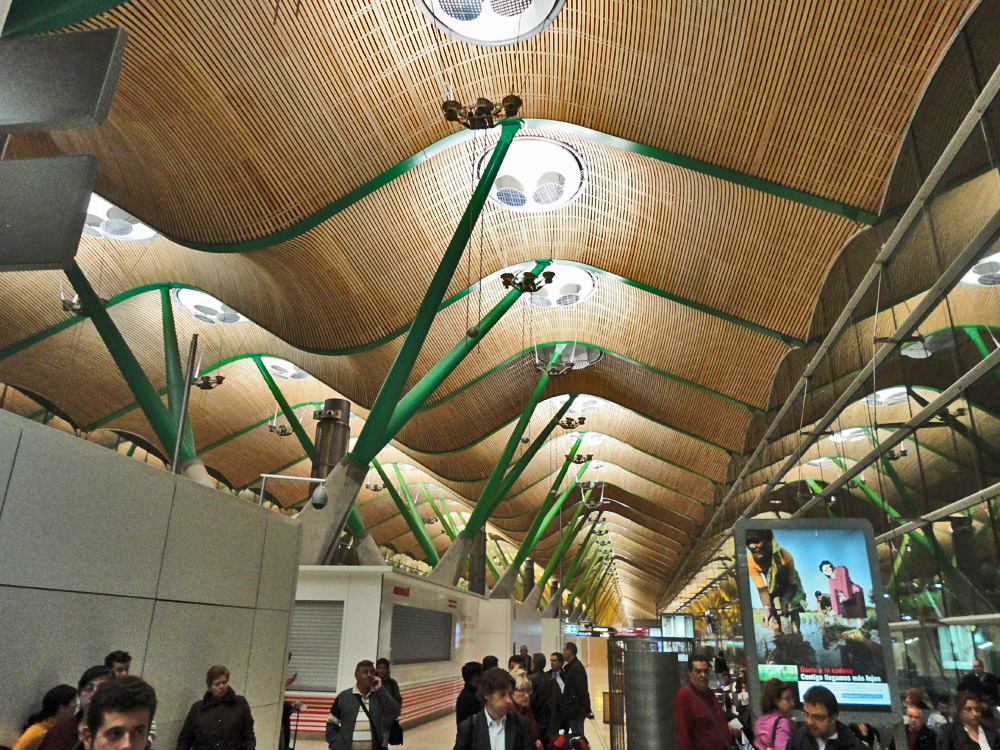
Barajas Terminal 4, were we arrived, were designed by the famous architects Richard Rogers and Antonio Lamela (but for a long time I thought Calatrava was the architect).
It opened in 2006.
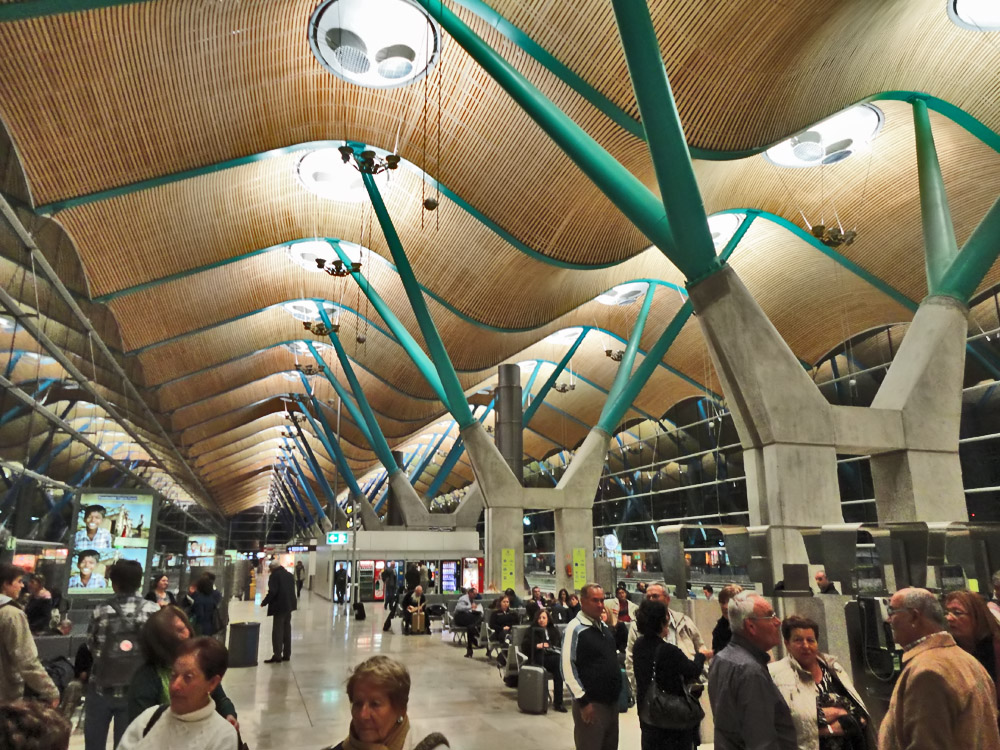
Terminal 4 has glass walls that makes light slip in to create a stressful atmosphere. The structure has elements featuring a colour scheme including all the shades of the rainbow.

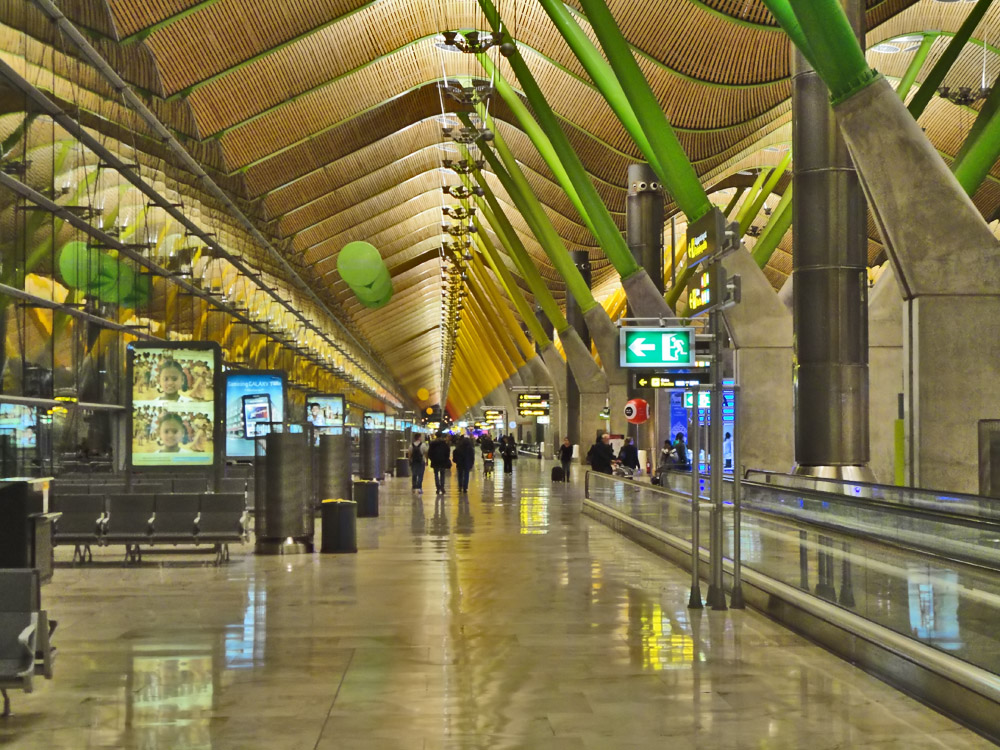
The rainbow colour scheme changing from green to yellow.
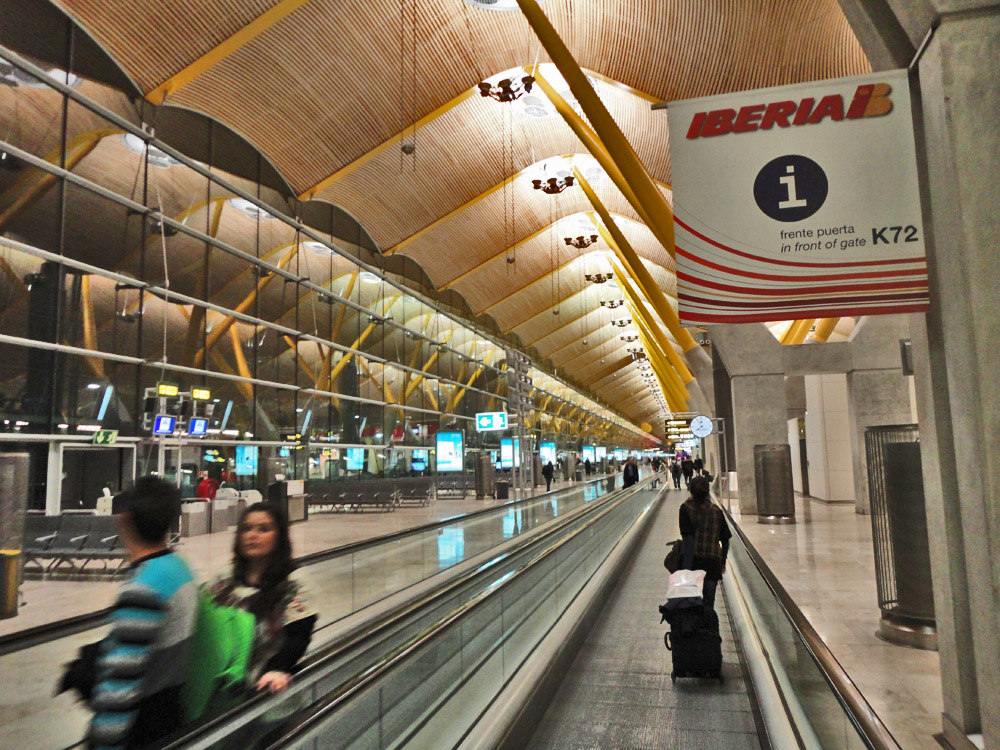
Terminal 4 from the plane:
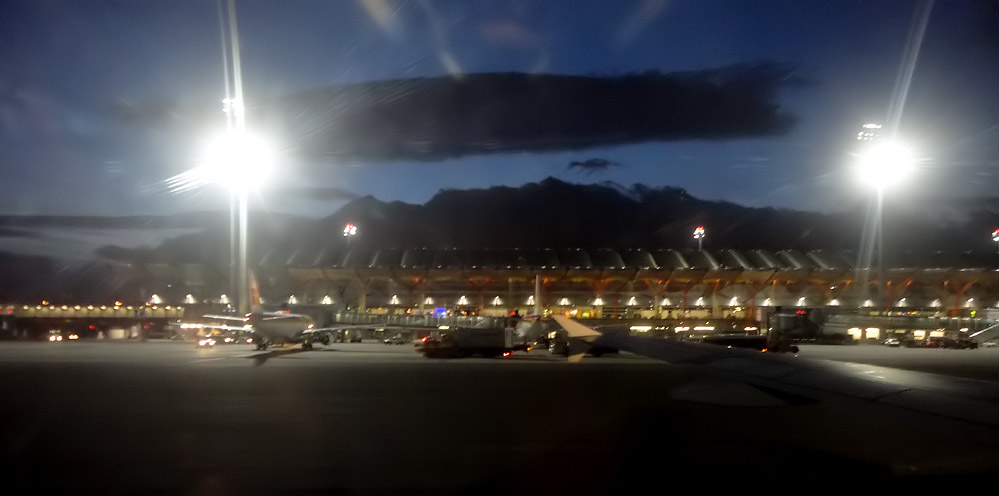

The luggage hall:
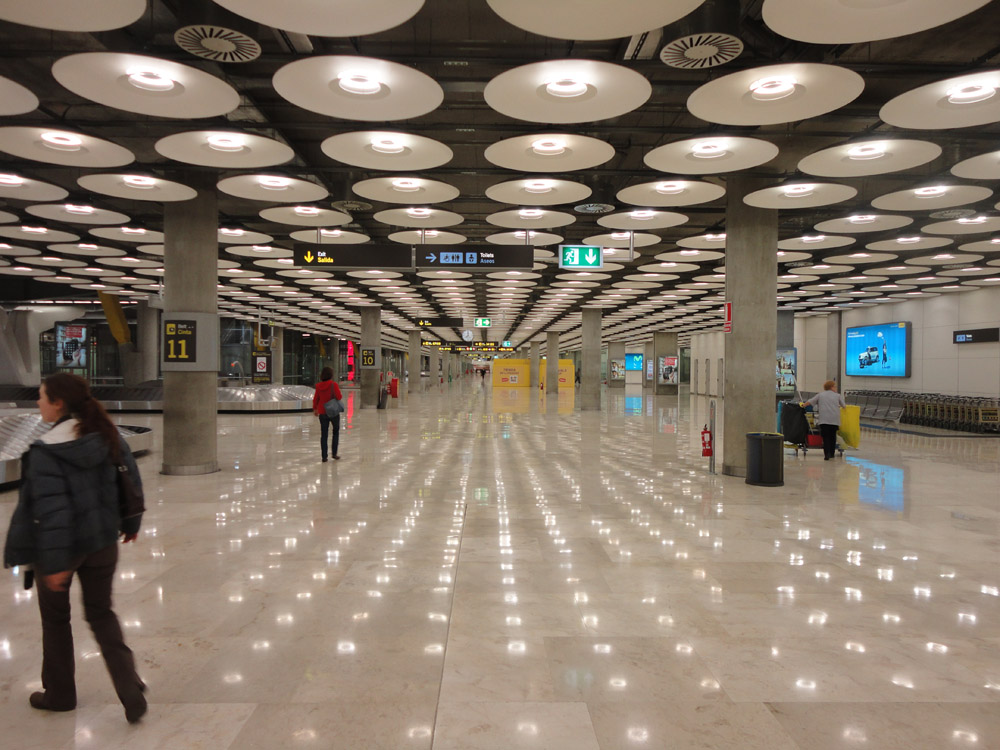
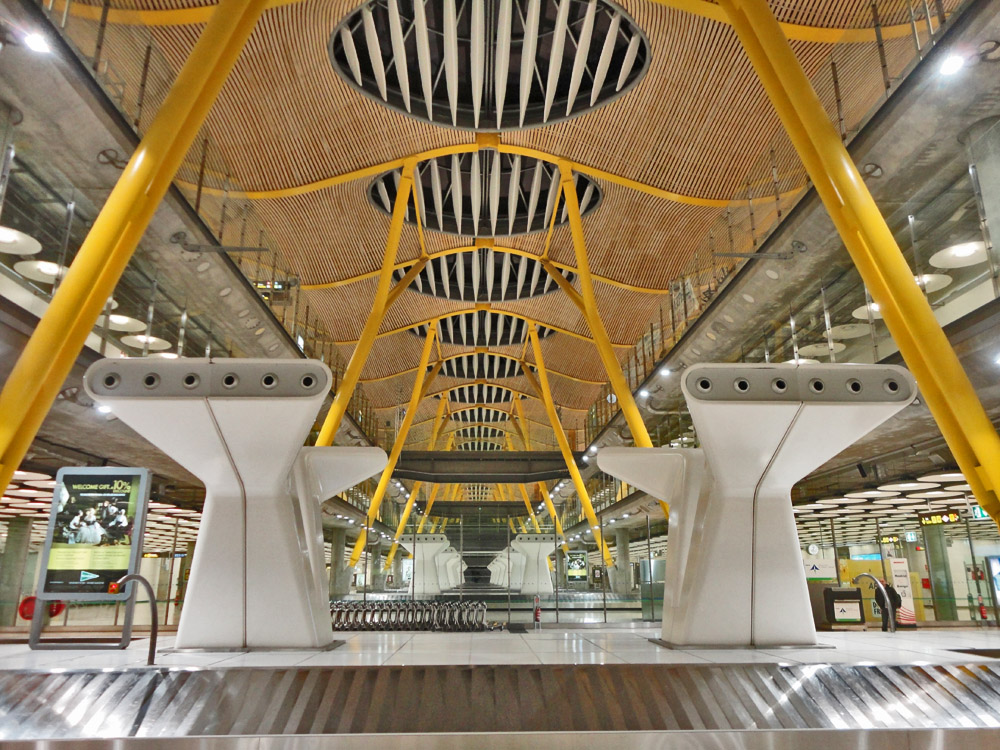
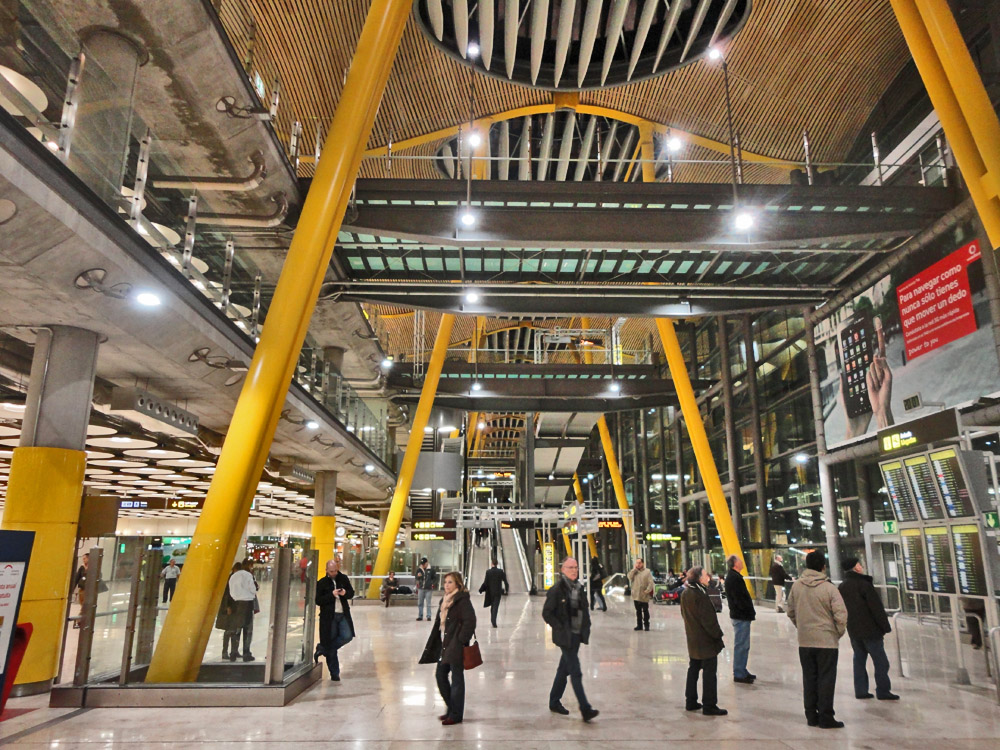
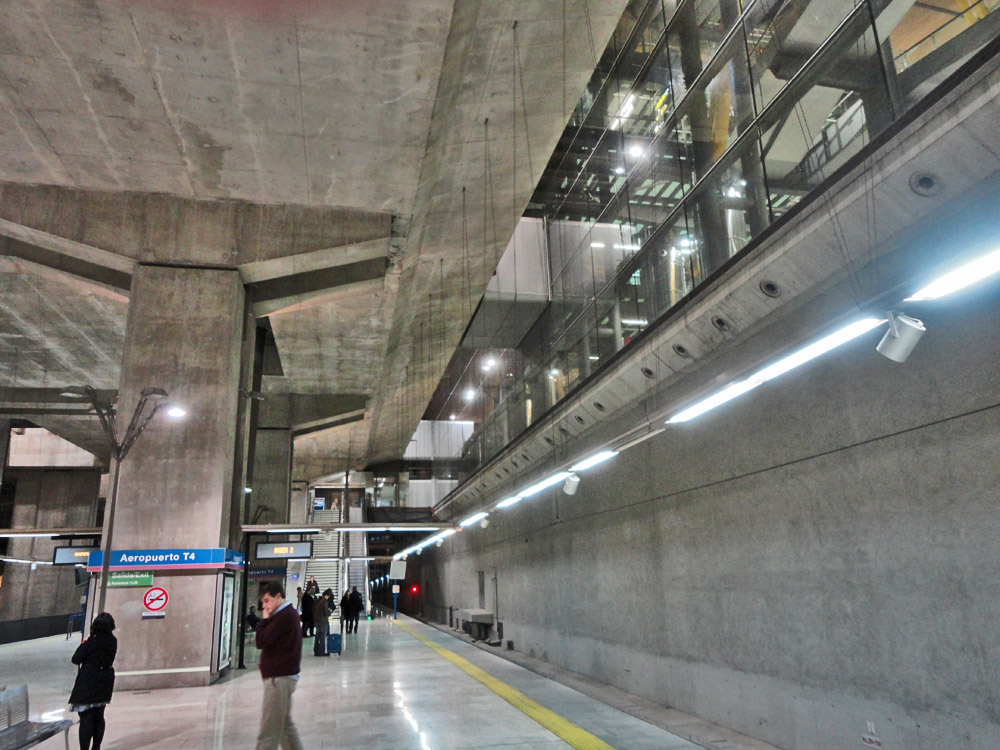
Waiting for the metro to the city center.
Plaza de España
Our hotel, Mercure, was located close to Plaza de España, the northernmost of Madrid's famous and historic large squares, and my favourite of them. It borders Parque del Oeste and is the west end of Gran Via. At Plaza de Espana you can find Madrid's 2 oldest skyscrapers (that are the tallest in the city center), trees, fountains, sculptures and a famous monument to Cervantes, the author of Don Quijote. As our hotel was close to Plaza de Espana, we visited and passed by the square a lot of times. In the evenings, especially Fridays, young people start to party and picnic on the square already in the early evening. Palacio Real is only a short walk from Plaza de España. Busy roads and a highway tunnel is next to the plaza, but it is still a relaxing place.
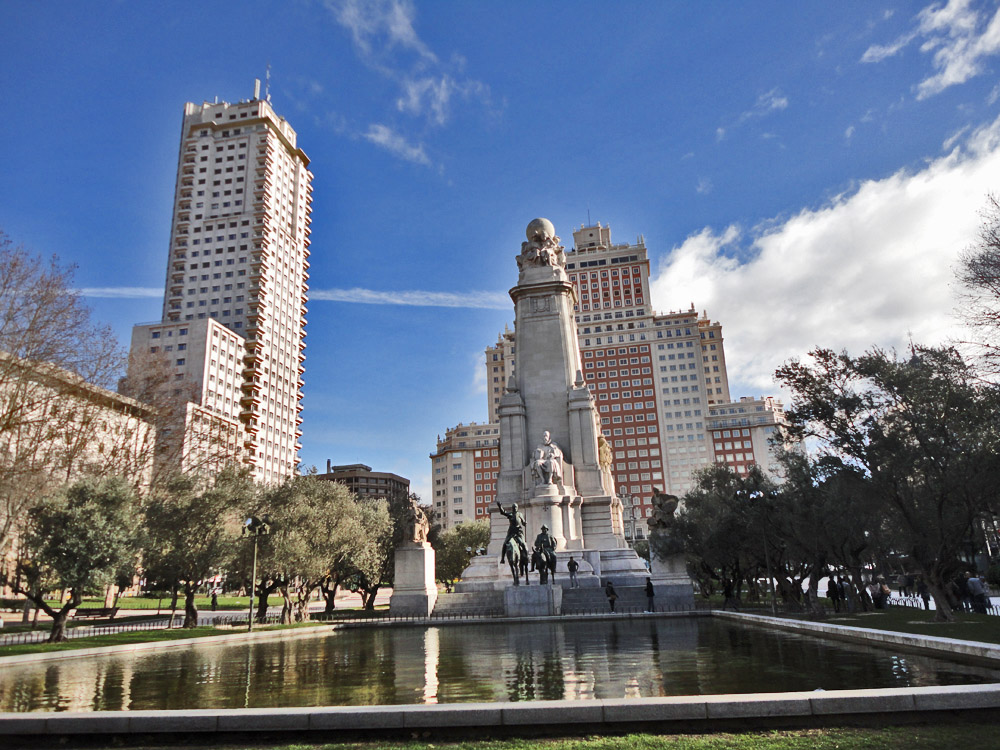
Torre de Madrid, the Cervantes monument and Edificio España.
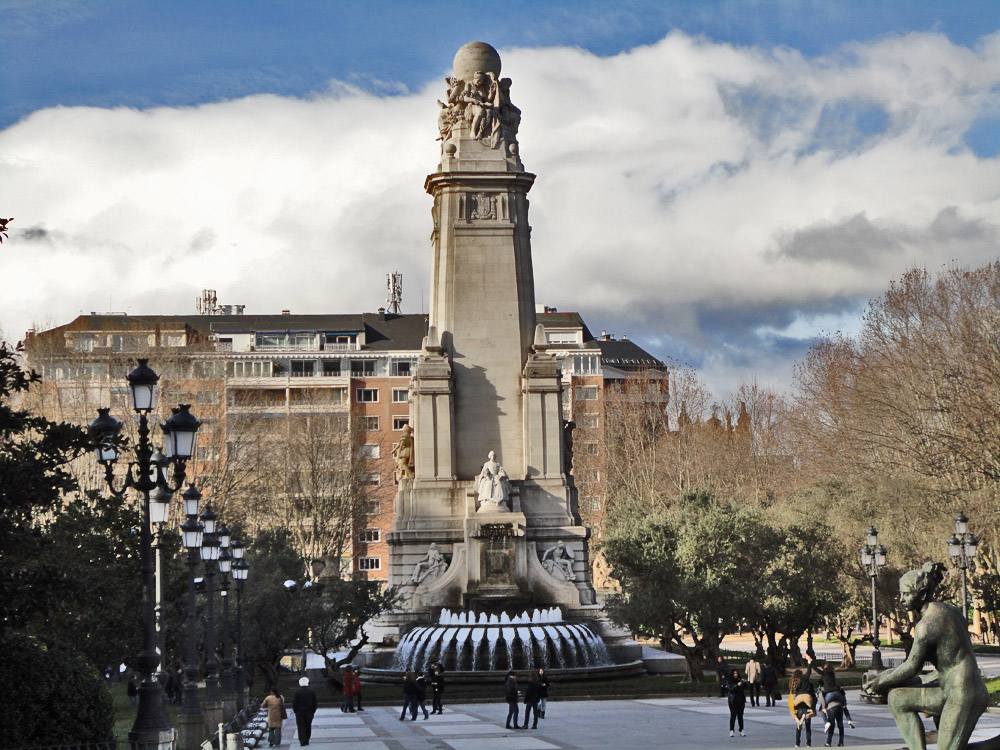
The monument to Miguel de Cervantes Saavedra, the author of Don Quijote.
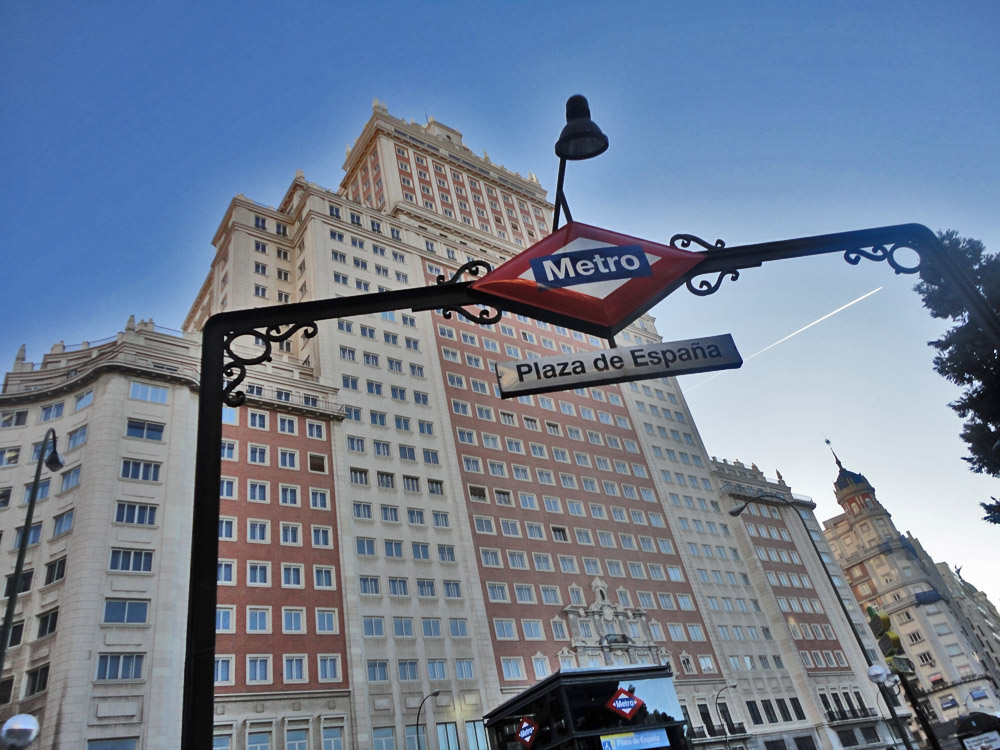

Fuente del Nacimiento del Agua, the fountain right in front of Calle de Princesa, the northern extension of Gran Via.

Torre de Madrid and Edificio España, 2 of Madrid's oldest but most prominent skyscrapers. Very few of Madrid's skyscrapers are in the city center. The 2 buildings were constructed by the project developer Metropolitana and the Otamendi brothers designed them. After their completion in the 1950s, the plaza became a popular
meeting place.
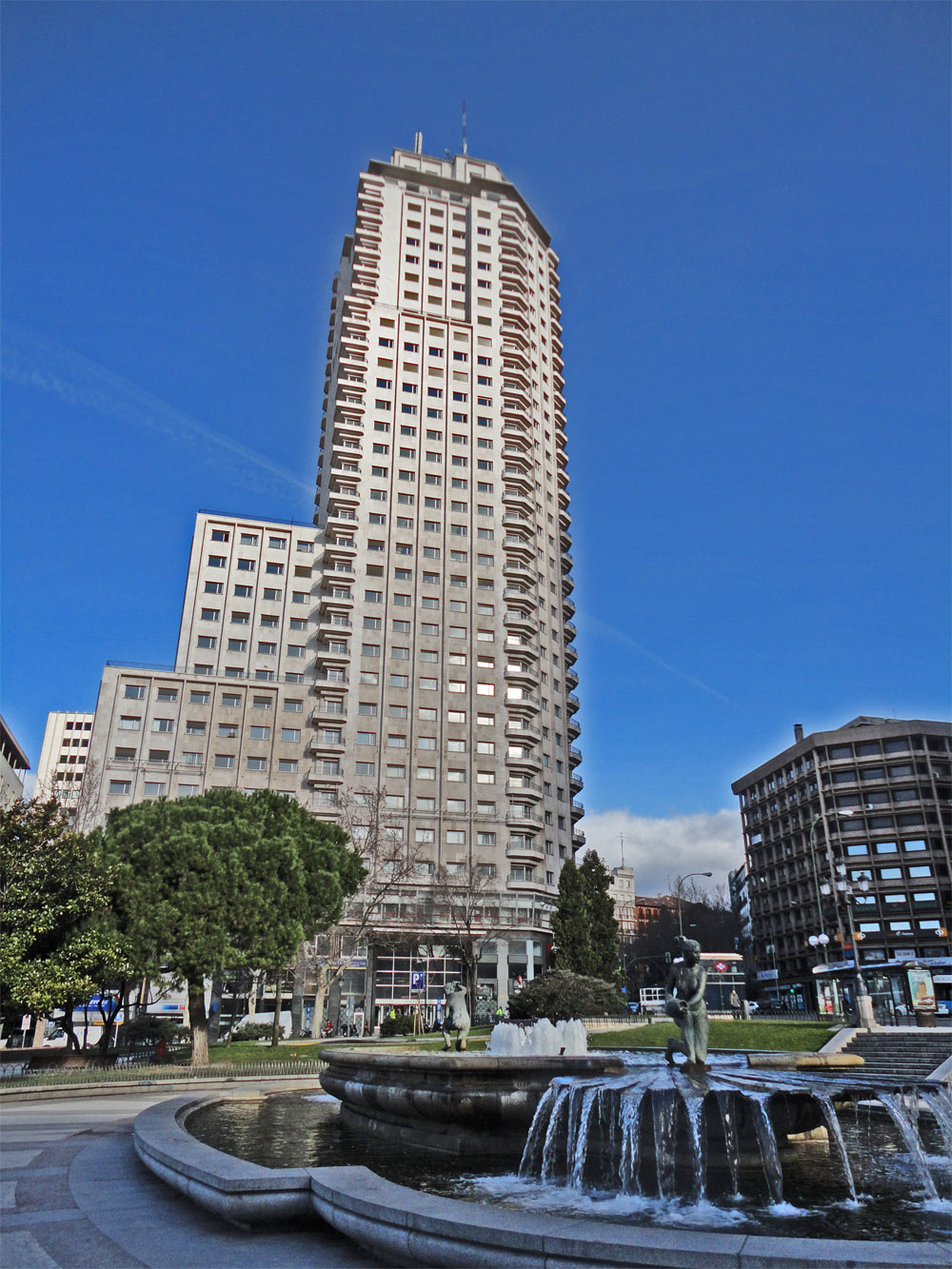
Torre de Madrid. Built in 1957 and 142 m tall it is the tallest building in the city center. Tallest building in Madrid when completed. Still the tallest in the city center.
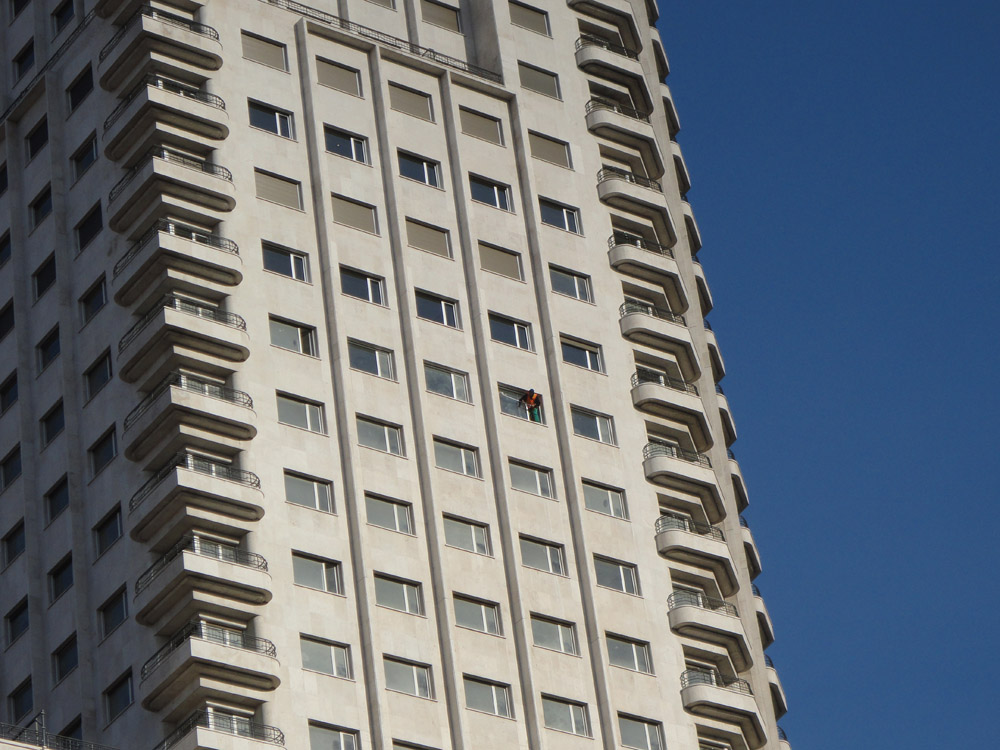
Cleaning the windows of this early modernist skyscraper!
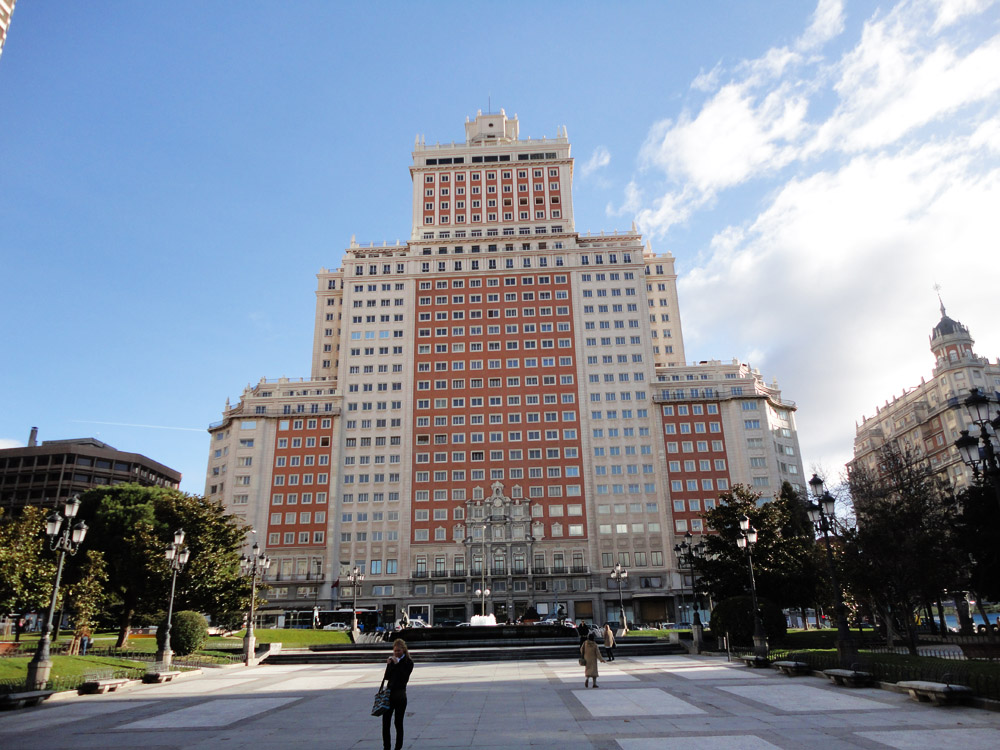
Edificio España. A 117m tall hotel from 1925. It was completed in 1953. It was Madrid's tallest building until 1957 when it was surpassed by Torre de Madrid (see above).
Edificio España is designed in a Spanish Revival style with classical elements. The hotel is Crowne Plaza.
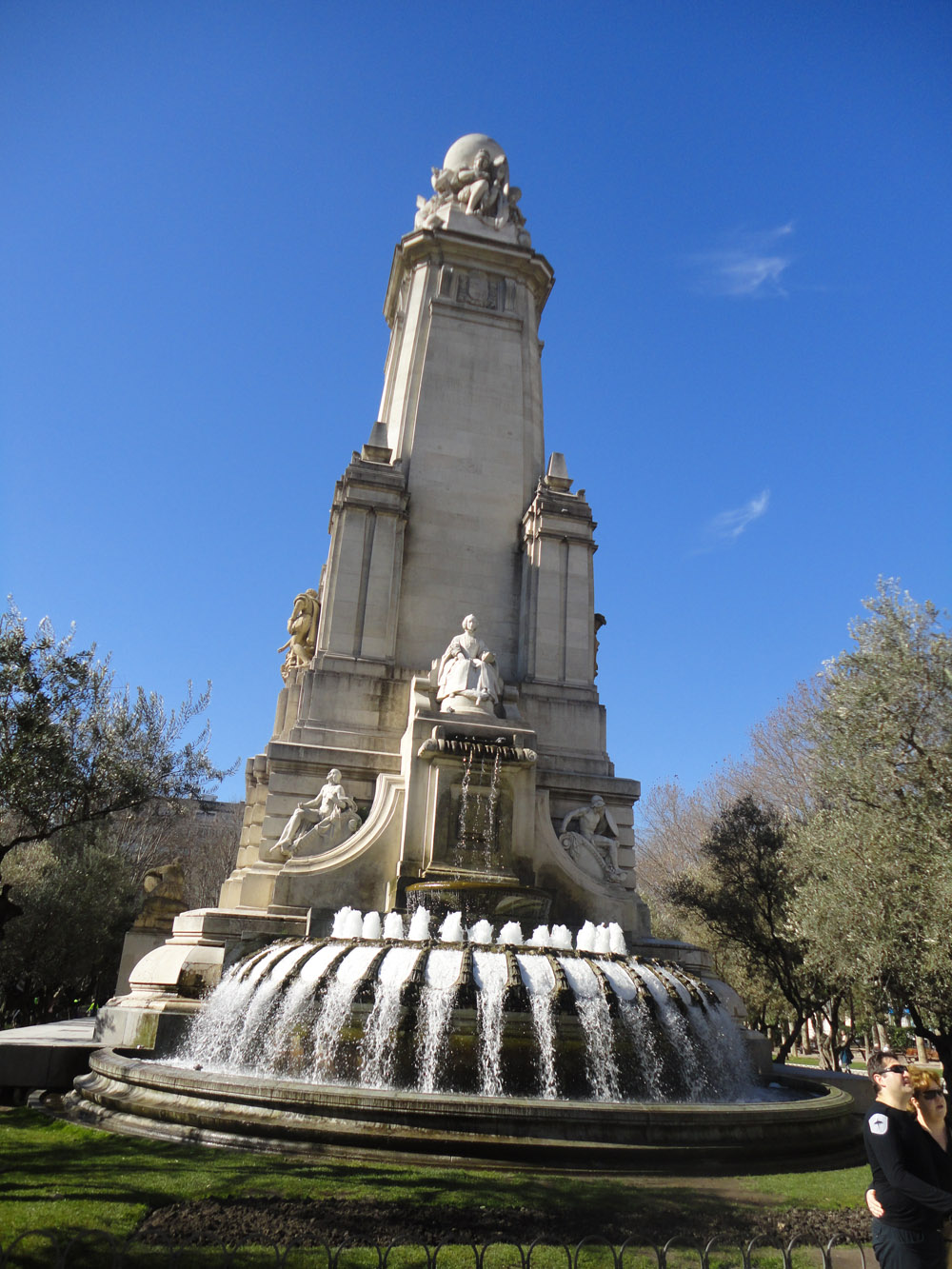
The statue of Cervantes. It was built in 1925, but was not completed until 1957.

Cervantes on his horse. Hordes of tourists want to be photographed there.

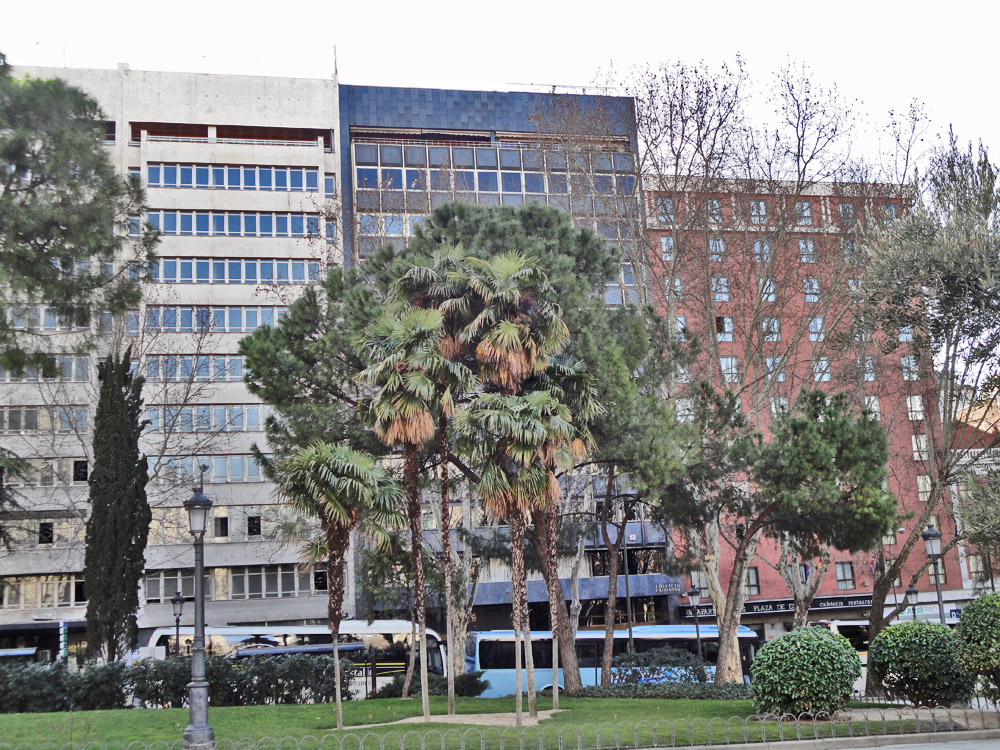

Palacio Real seen from Plaza de Espana. More of that later.
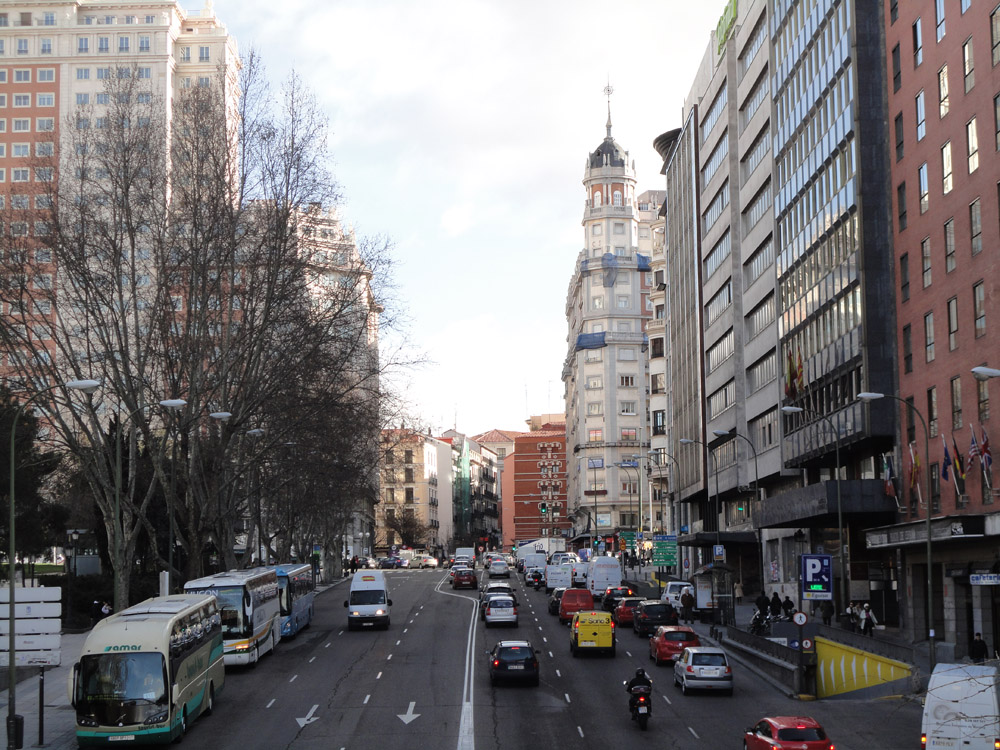
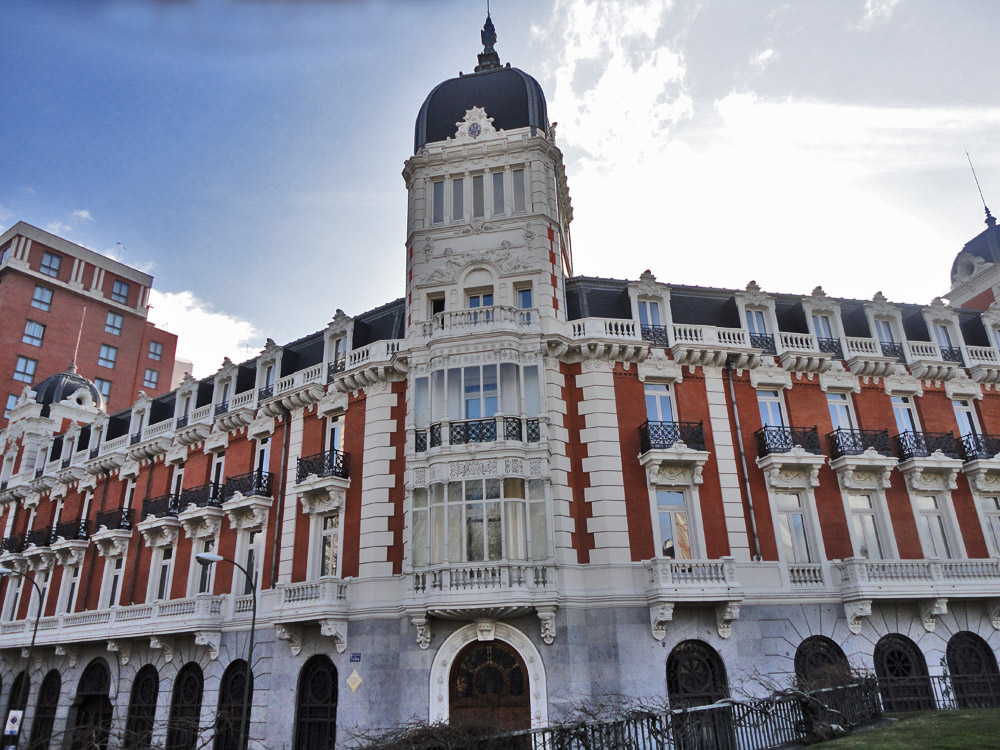
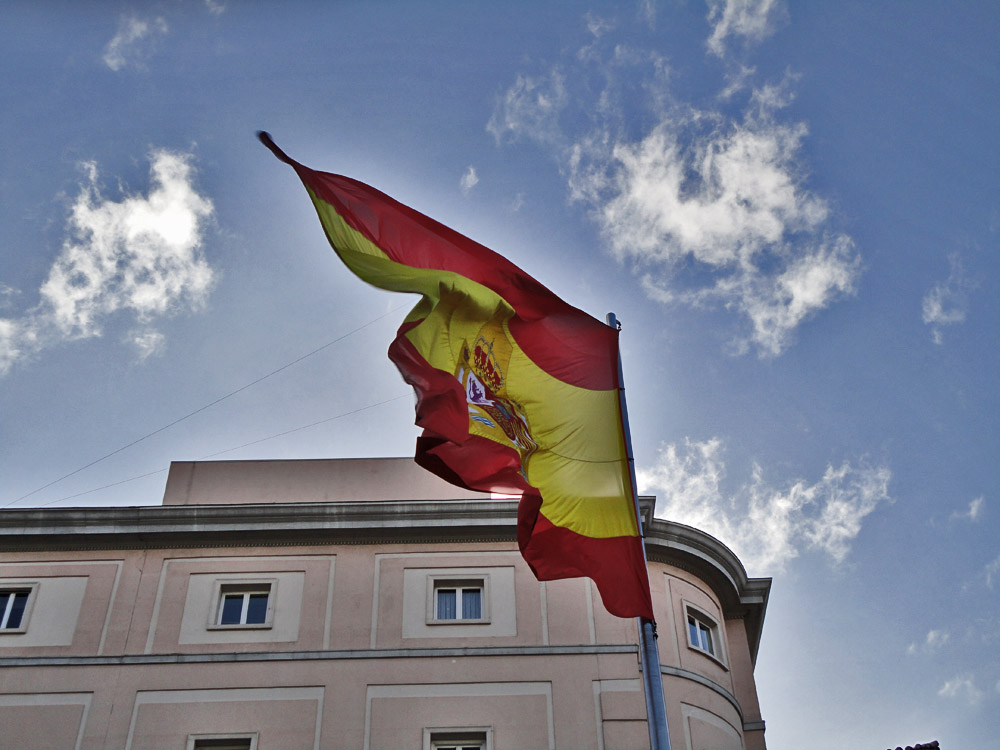

A church with an unusual architecture. Anyone knows the name?
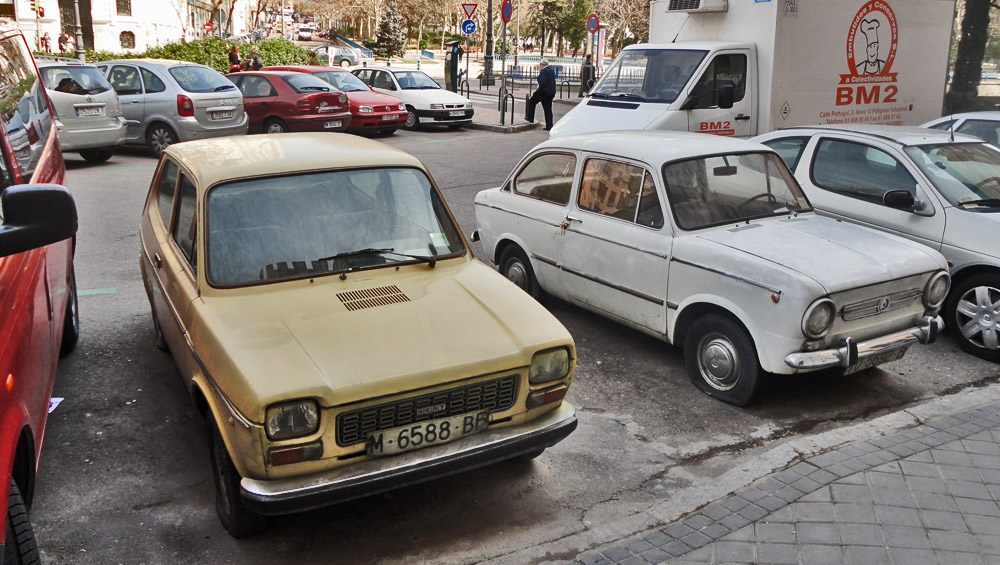
2 old timer Seat, a very rare sight in Madrid, that is mostly trafficated by new cars. Note that both have punctures!
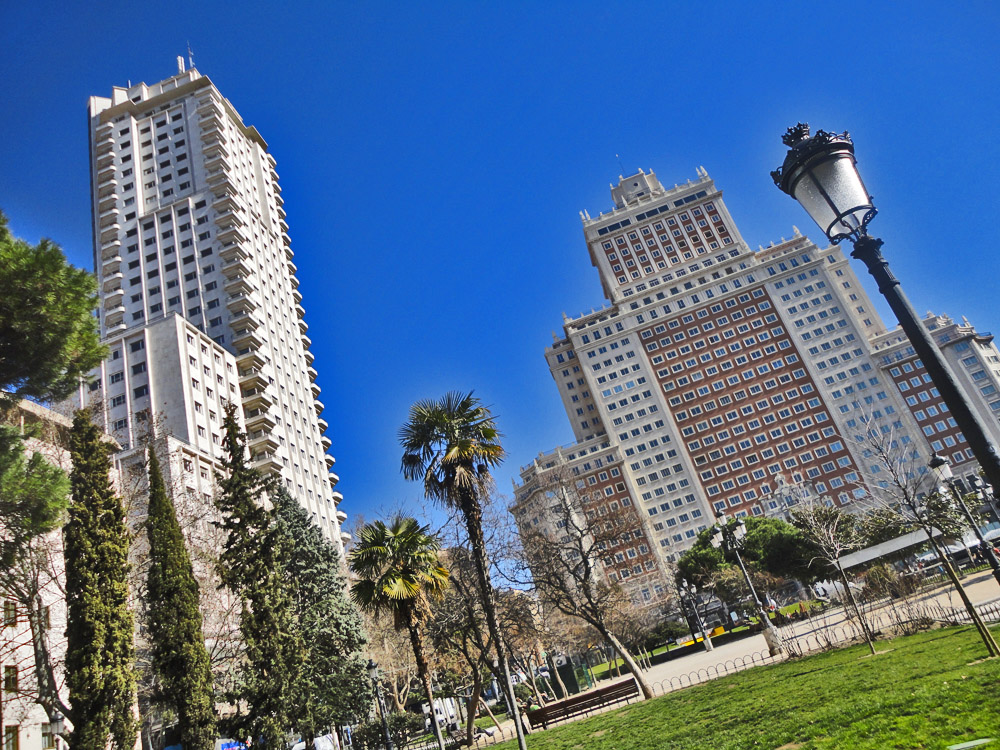
And some of our hotel, Mercure at Plaza de Espana:
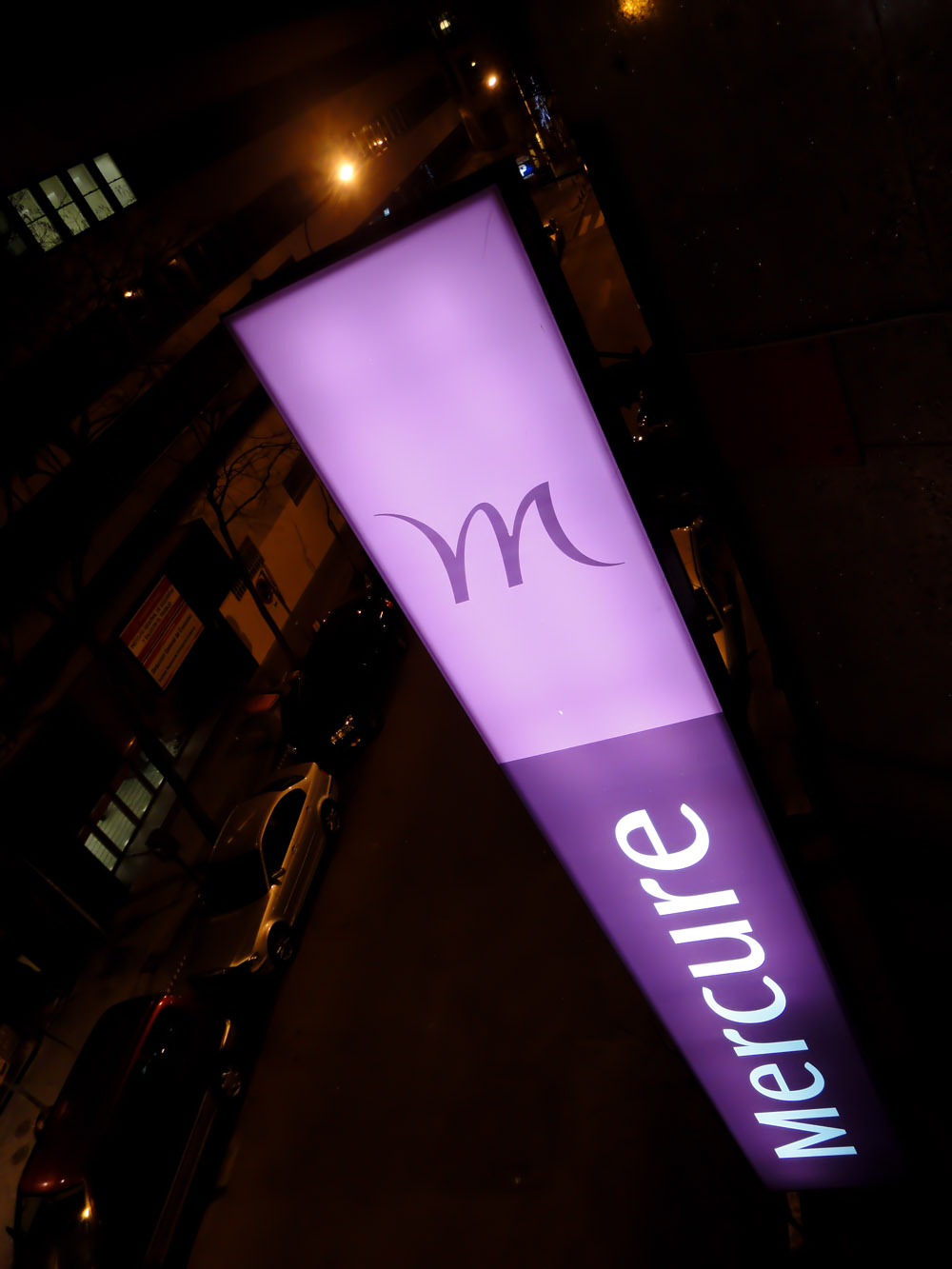
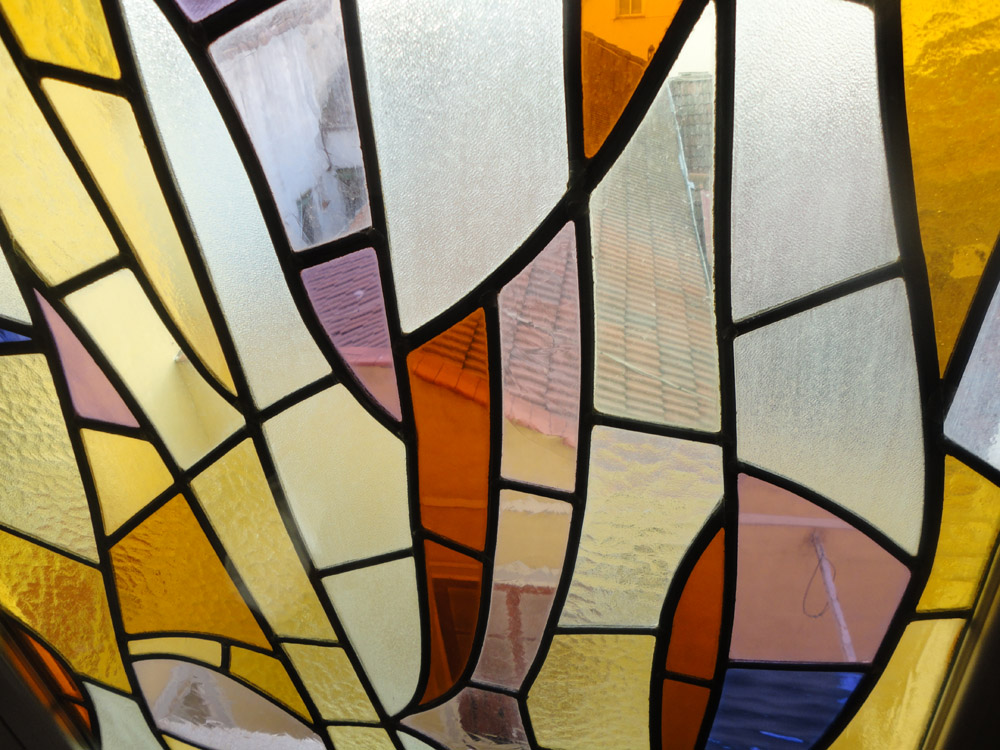
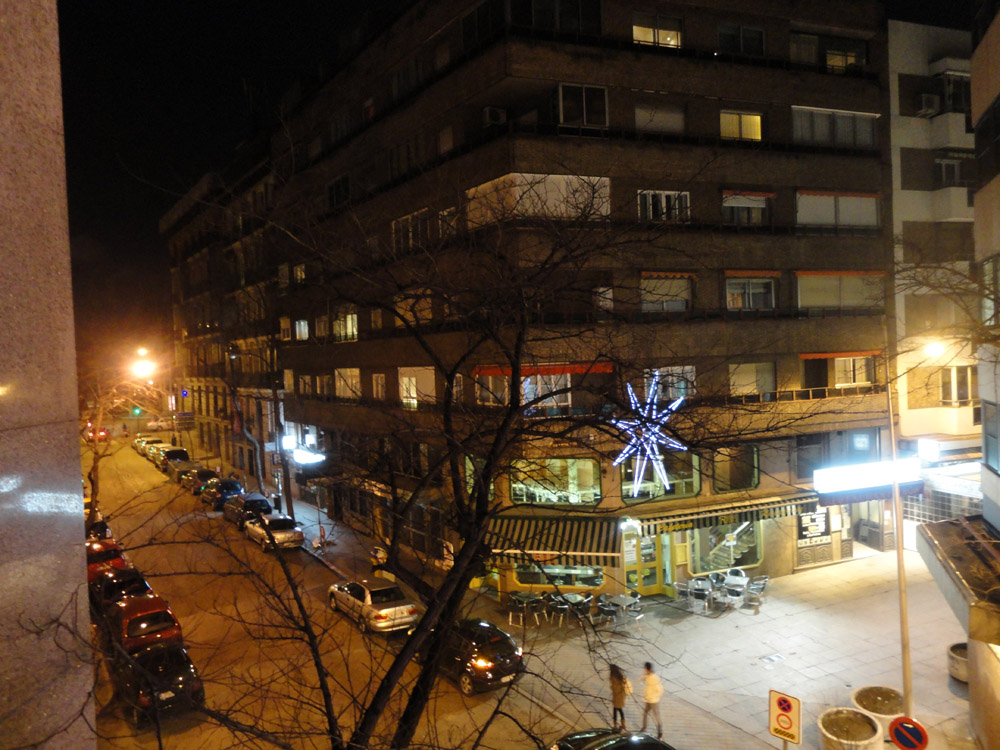
The view from the room.
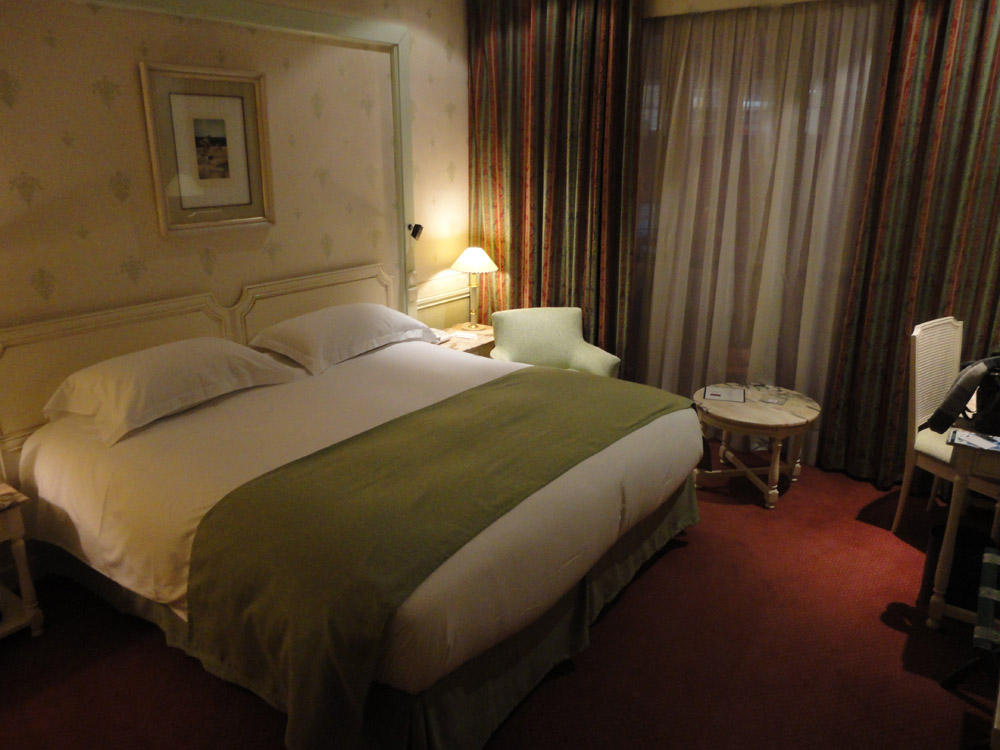
Mercure Hotel Madrid Plaza de Espana is the full name of the 4 star hotel where me and my girlfriend stayed. It has nice interior and friendly staff, but is a bit worn.
It has only 97 rooms, so it is not very big, but it has about 5 floors.
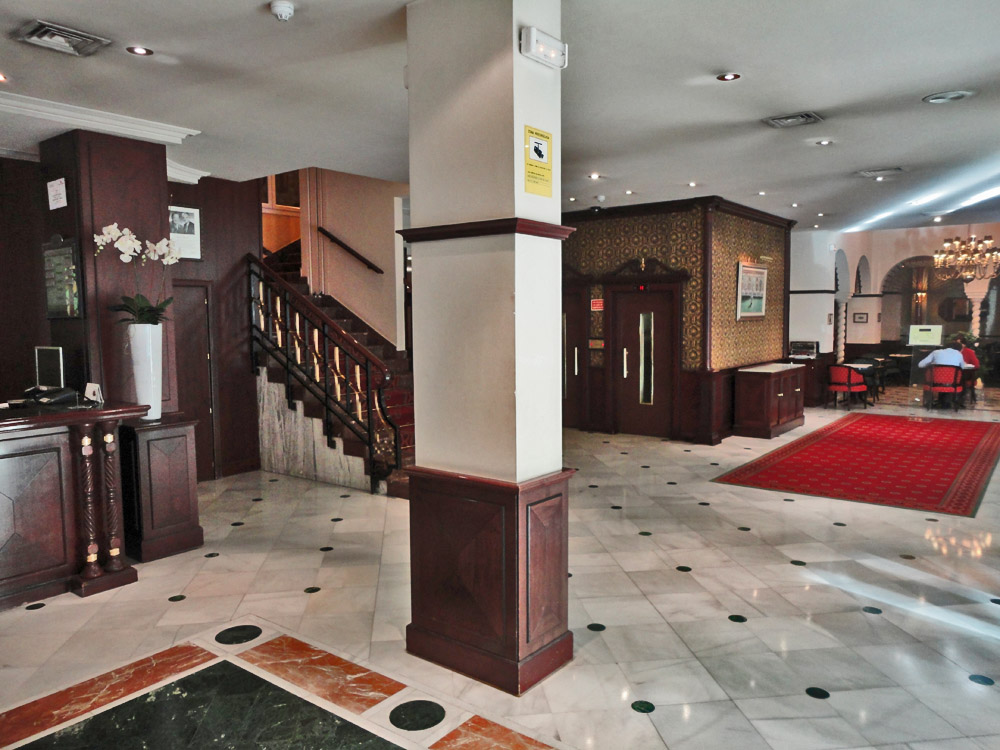
Gran Via
Gran Via is the most famous street in Madrid and passes from the west to the east end of the city center. It begins at Plaza de Espana, passes Plaza del Callao and ends where it meets Calle de Alcala, where the famous Metropolis building is, close to Plaza de Cibeles. Puerta del Sol and Plaza Mayor are just a couple of blocks south of Gran Via. A lot of hotels, exclusive stores, department stores and restaurants are located along the street. Some of the most impressive exteriors in Spain can be found here, as well as expensive stores, but it has some kind of worn charm with all the beggars and poor people along the streets, so be careful at night! But the architecture is fascinating, it is a true pleasure to study all the palace like highrises from the early 20th century with all the decorations. Gran Via resembles New York's Broadway, as well as London's Oxford Street, but has an identity of its own..
History: In the middle of the 1800s, it was decided that a new thoroughfare had to be created to connect Calle de Alcalá with Plaza de España. Many old buildings were demolished, but construction of the new buildings didn't start in decades and the media cynically called it "Gran Via", the Great Road. In 1904 it was finally approved and construction could start some years later. The design of the new buildings were for the time very modern, many architectws were inspired by the Chicago school. The whole street was completed in 1929.
A WALK FROM THE EAST TO THE WEST END OF GRAN VIA:

Edificio Metropolis. The crossing Gran Via/Calle Alcalá is the most photographed place in Madrid. The Metropolis building, originally constructed for the insurance company Unión y el Fenix Espa, was built between 1907 and 1911. It was designed by Jules and Raymond Février in a French Beaux-Arts style. Today
Metrópolis Seguros, another insurance company has their headquarters here, hence the name.
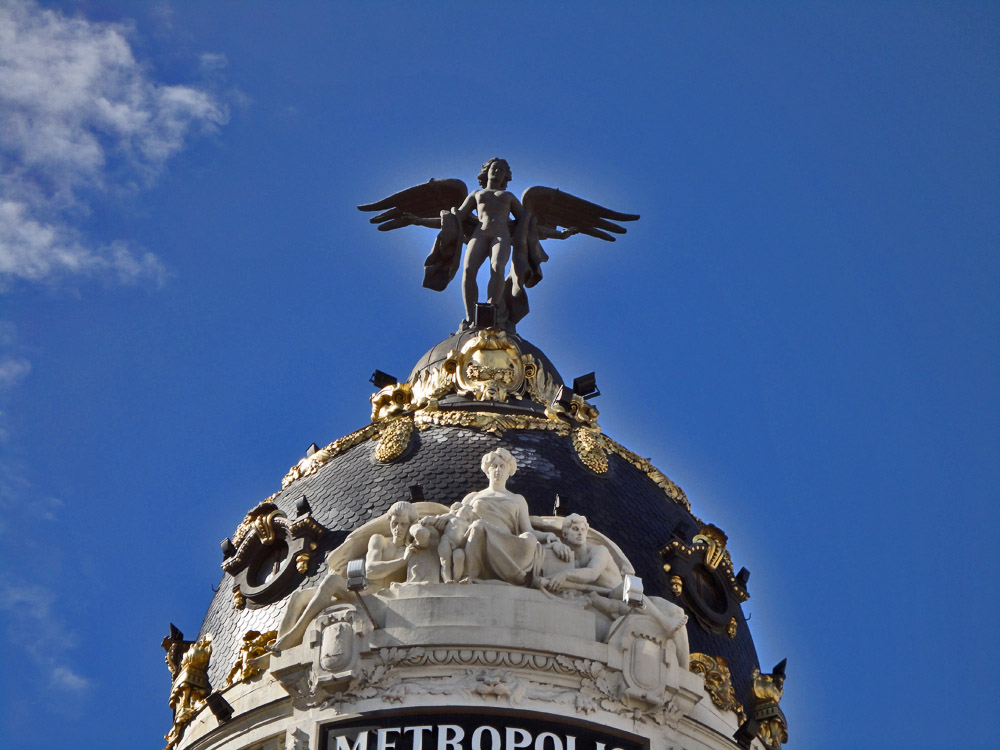
The black dome of Metropolis. The original statue was replaced in 1975 by a statue of the winged Godess Victoria, because the original insurance company removed it when Metrópolis took over the building in 1972. The golden garlands shine in the sun.
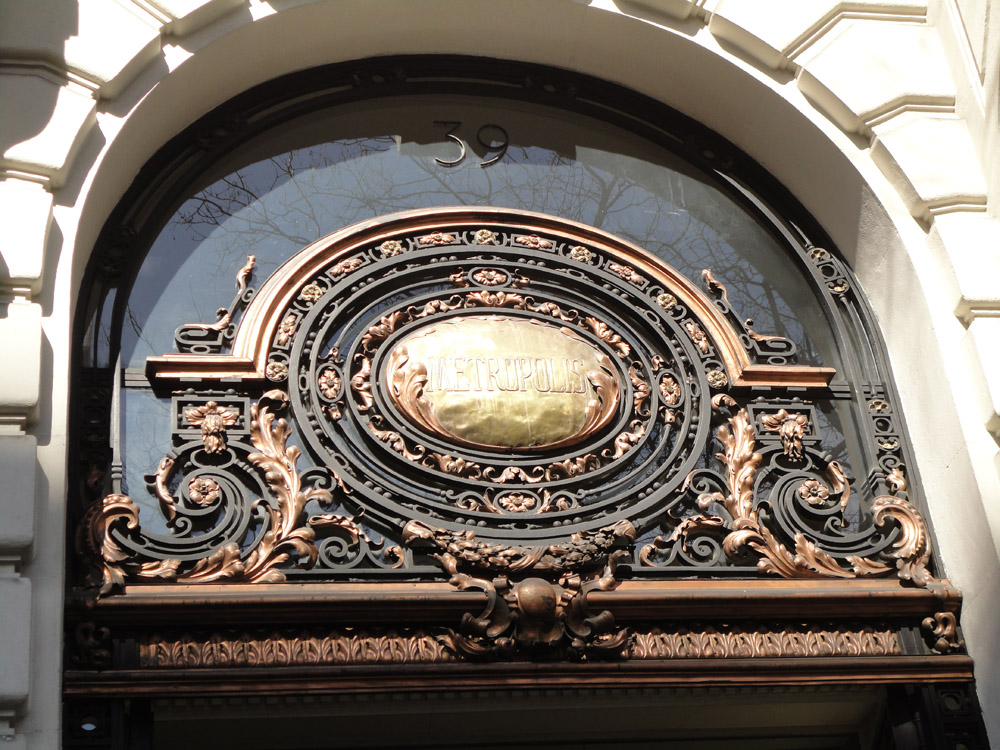
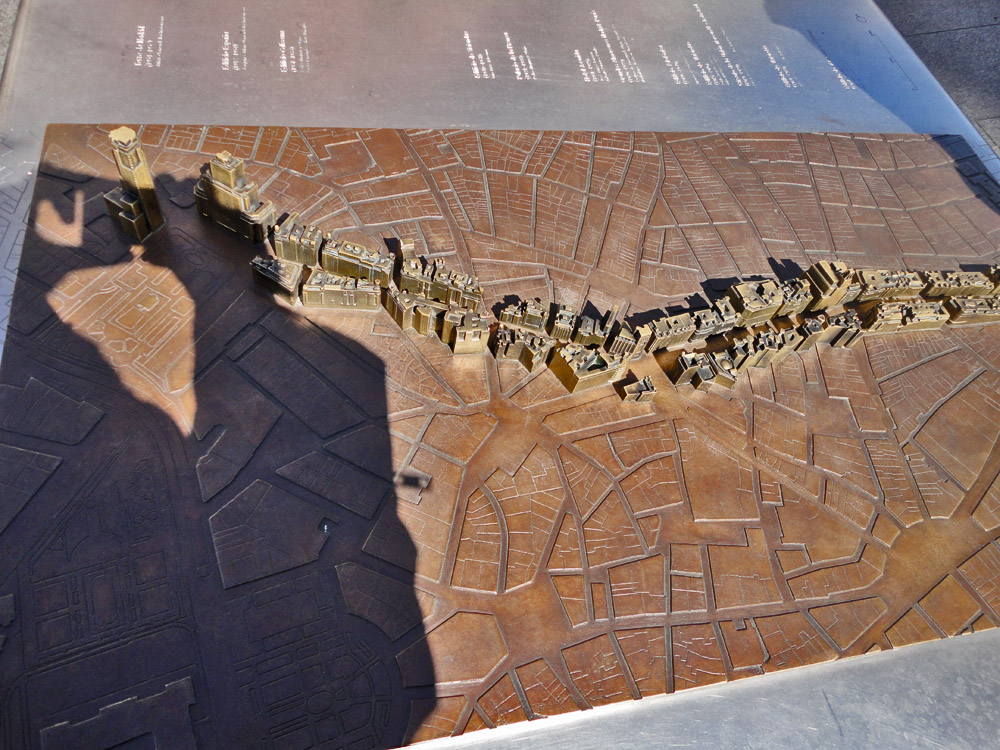
A bronze miniature of Gran Via just outside Metropolis.
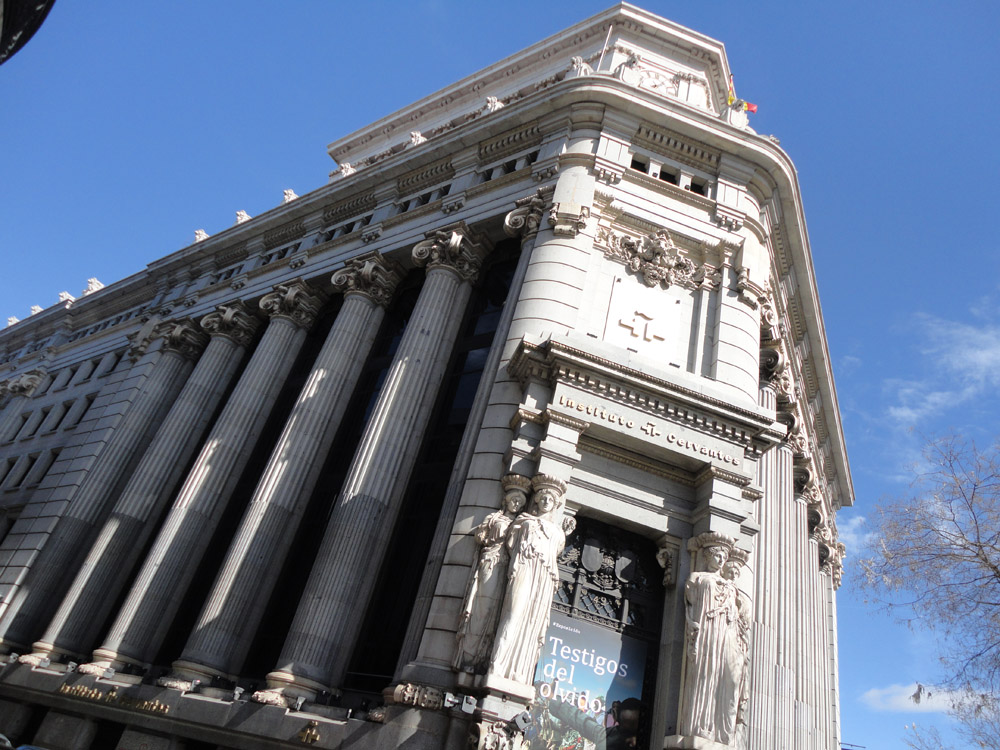

Instituto Cervantes by the architect Antonio Palacios.
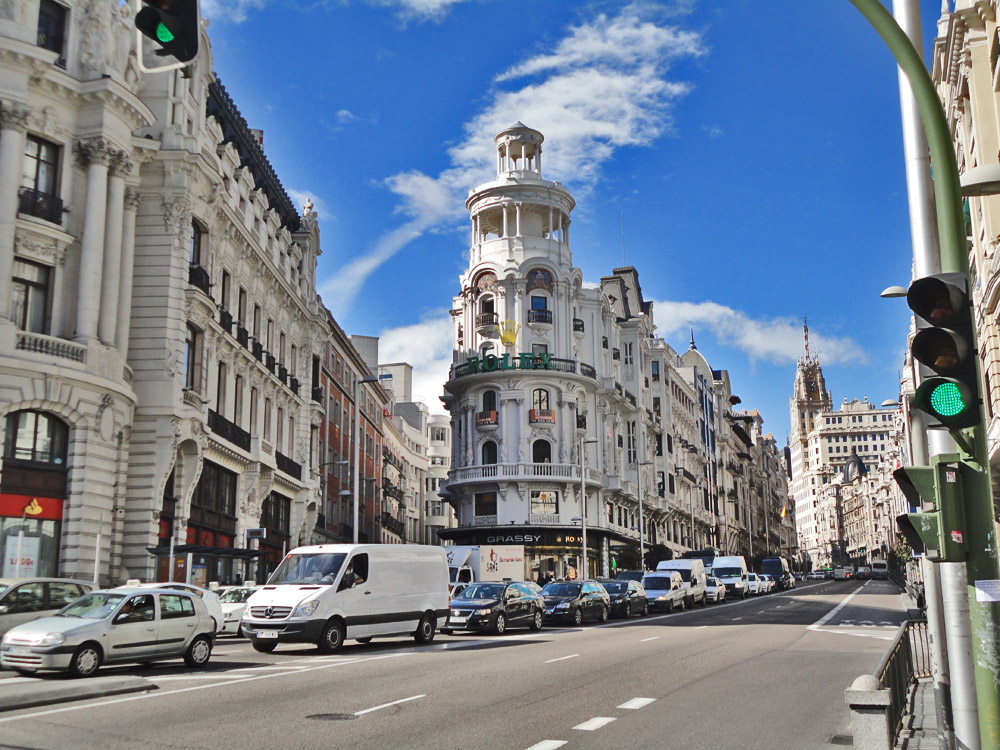
Edificio Grassy is the corner building from 1907 in the middle, Edificio Telefonica is to the far right.
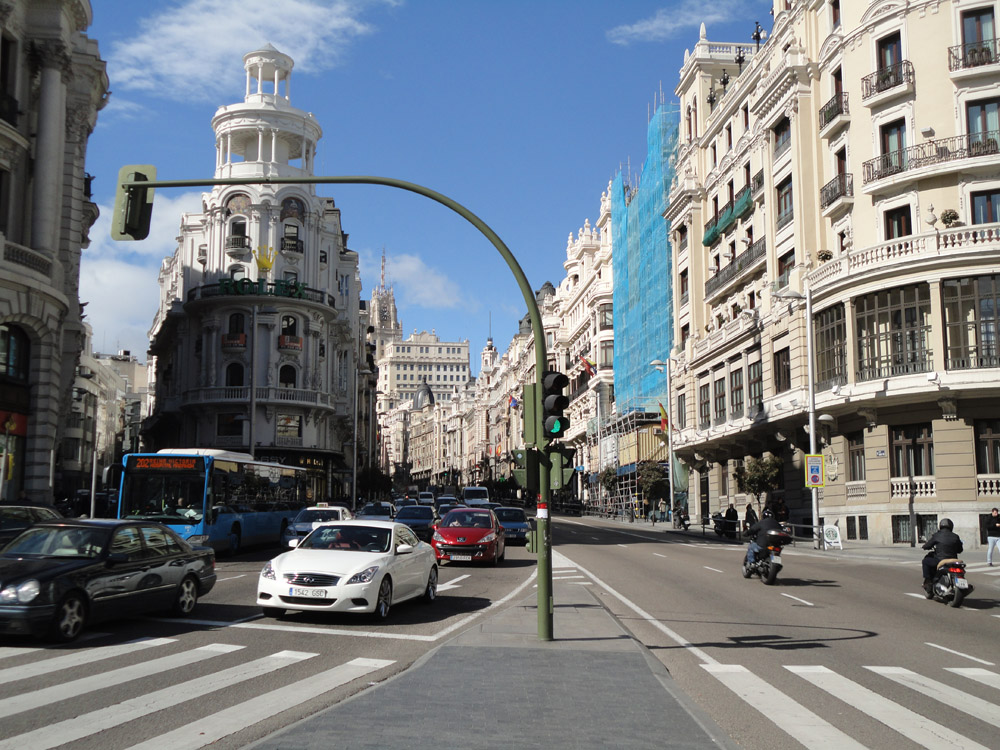
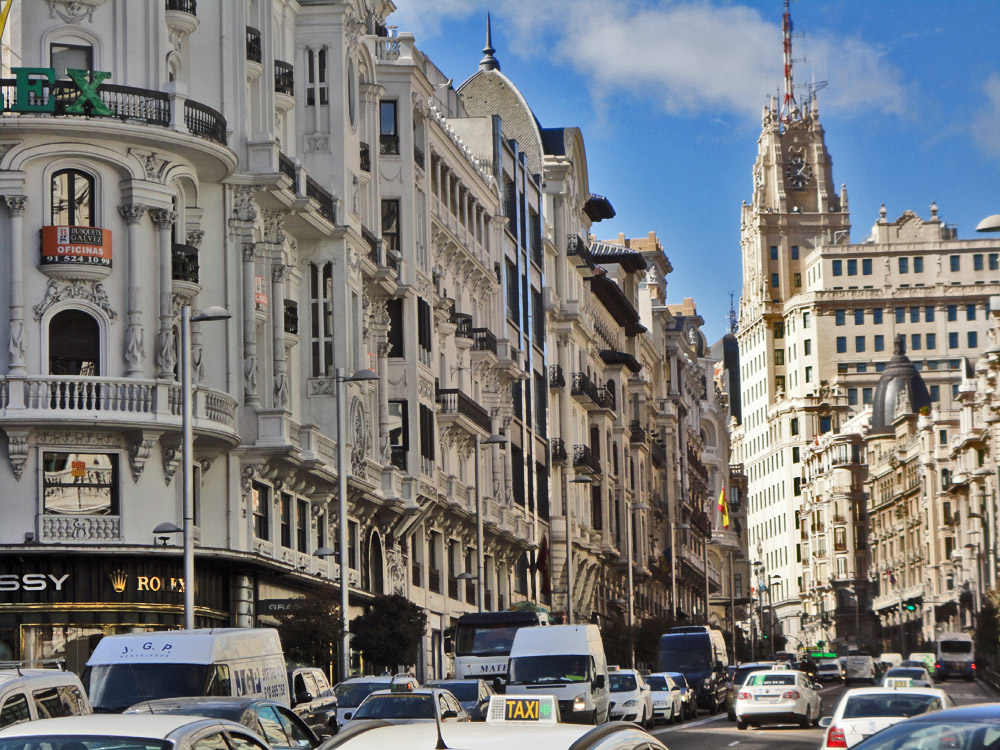
Gran Via towards Edificio Telefónica, with Ed. Grassy to the left.
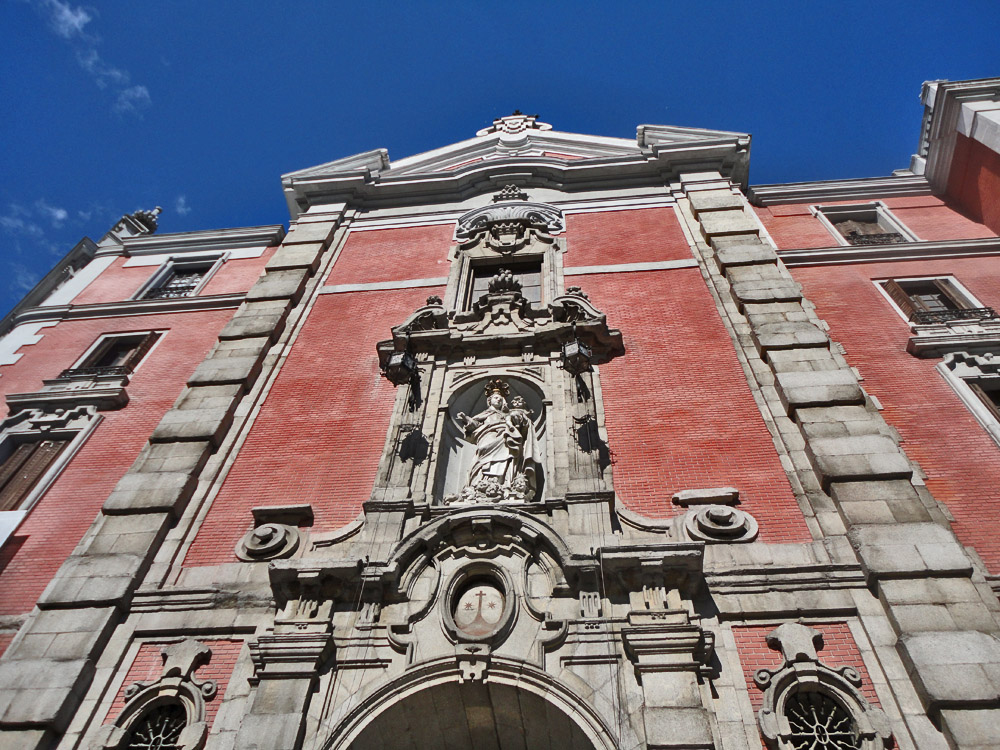
Iglesia de San José.
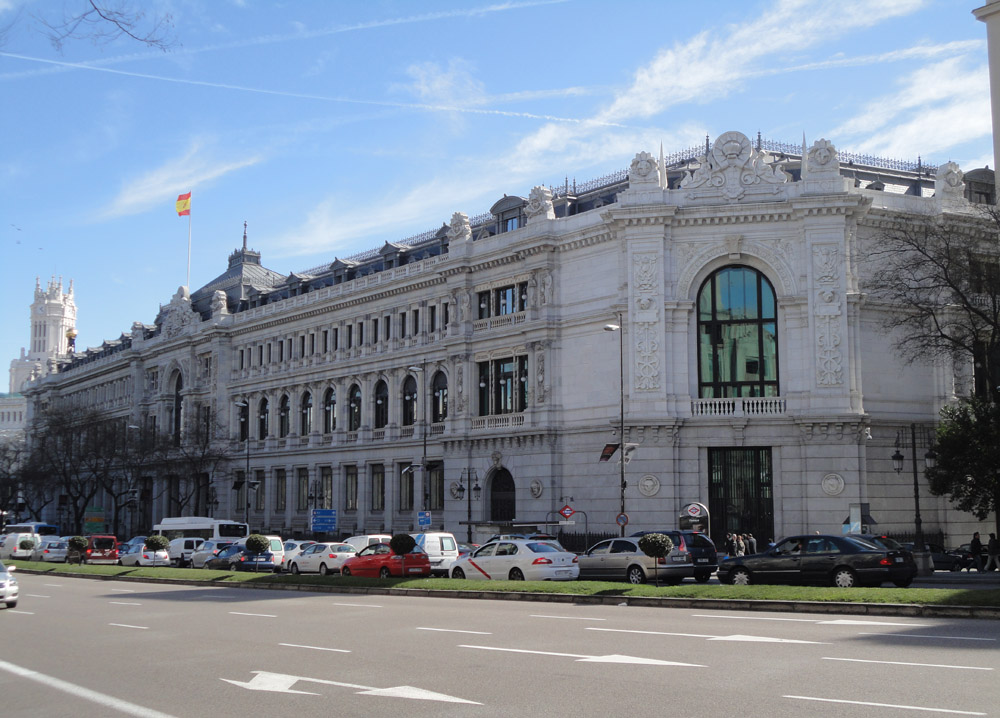
Banco de España, The National Bank of Spain. Spain's golden reserves are preserved underneath Plaza de Cibeles (to the left). An art collection with famous paintings by Goya and other artists is also inside the building, but to be able to see it you must write a personal letter to the bank first.

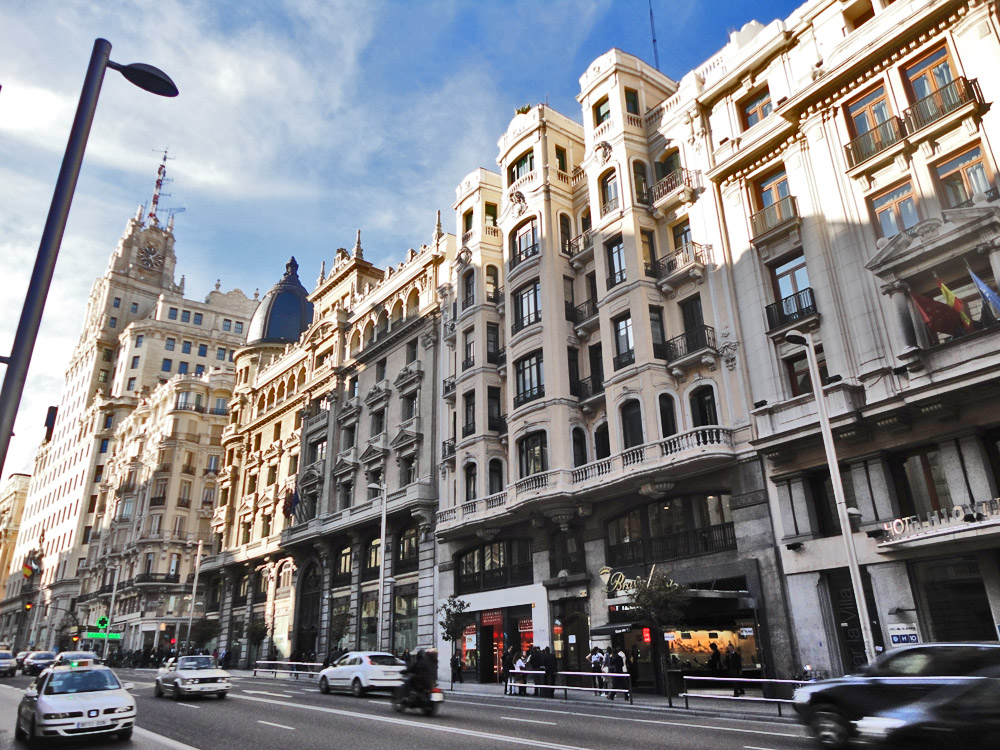
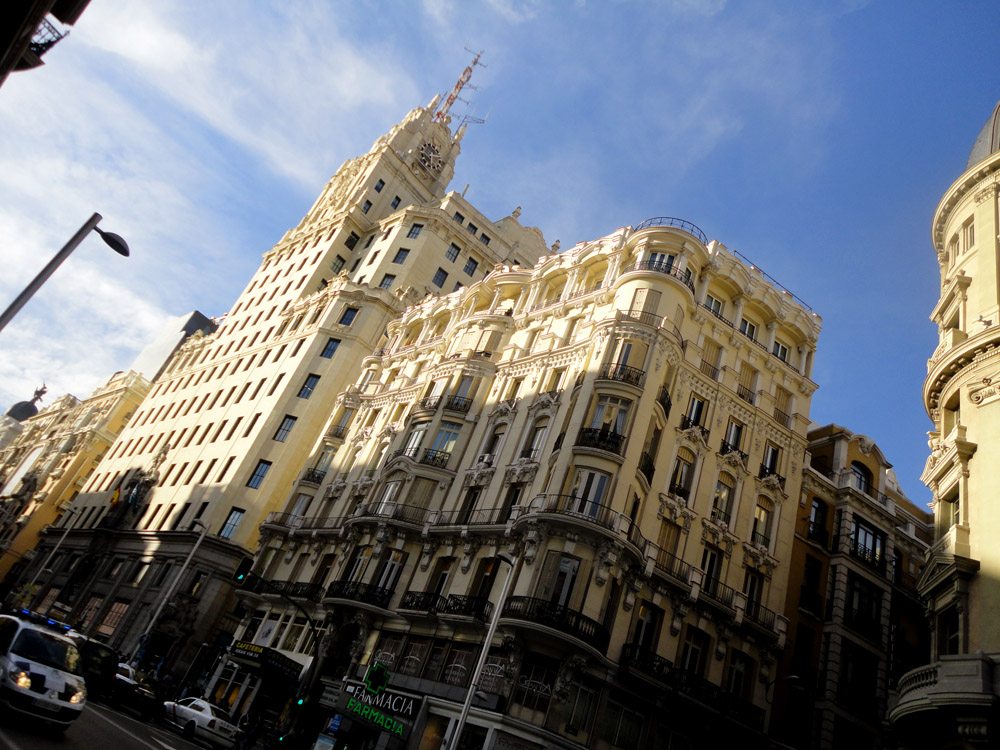
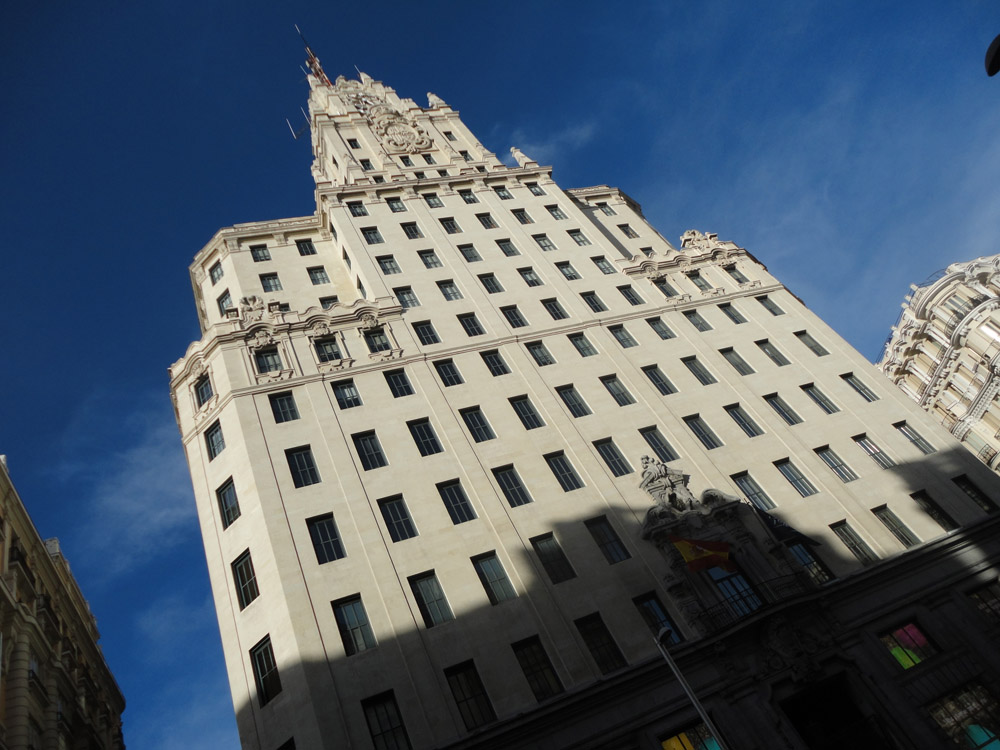
Edificio Telefónica was Madrid's first highrise and is today the HQ for Spain's largest phone company. It was drawn in 1929 by the American architect Lewis Weeks and was inspired by the Chicago school.
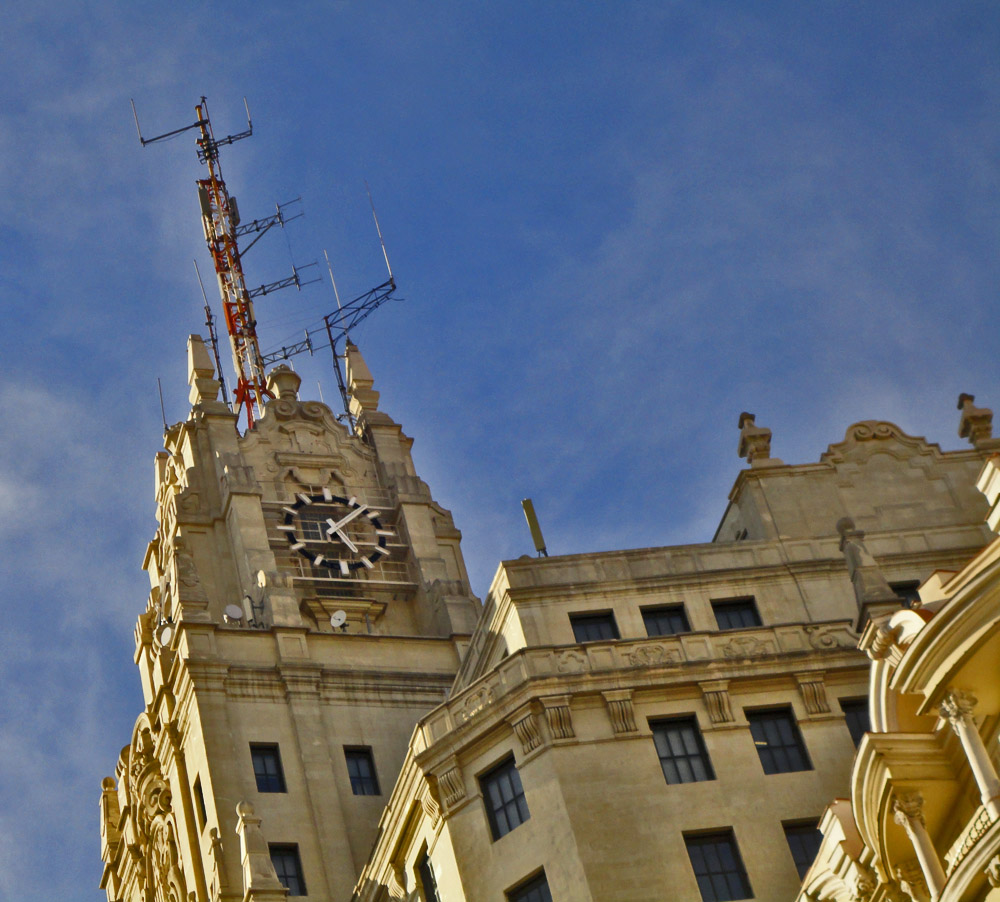
Ed. Telefónica played a key role during the civil war as an observation tower for the soldiers. Inside is a fine art exhibition including famous painters. Today the clock tower is famous.
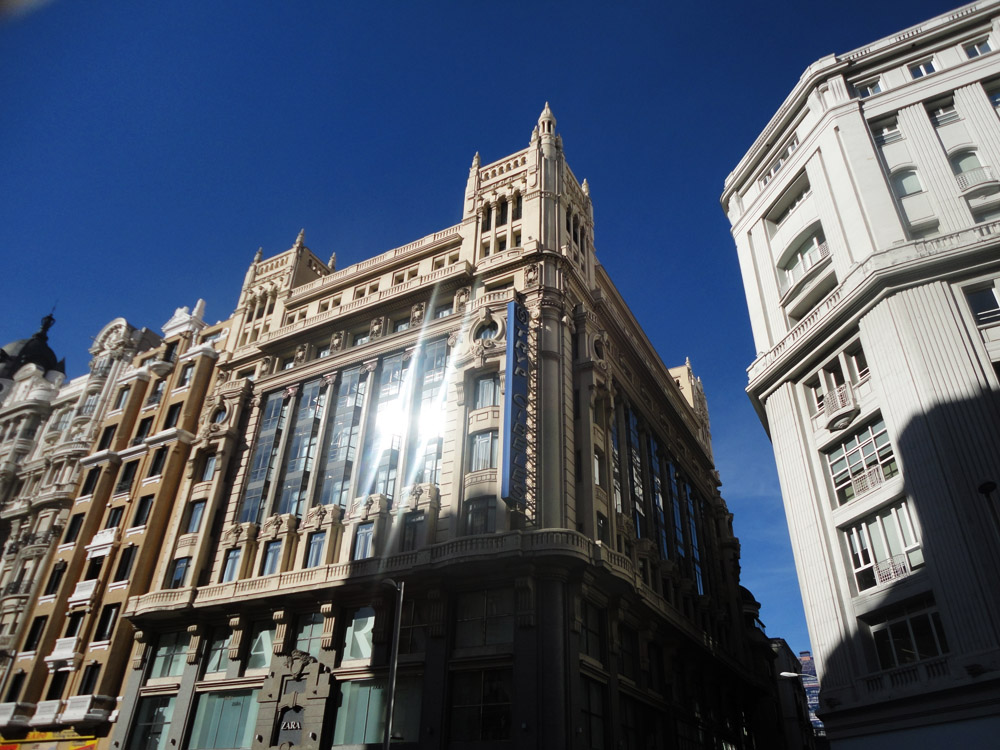
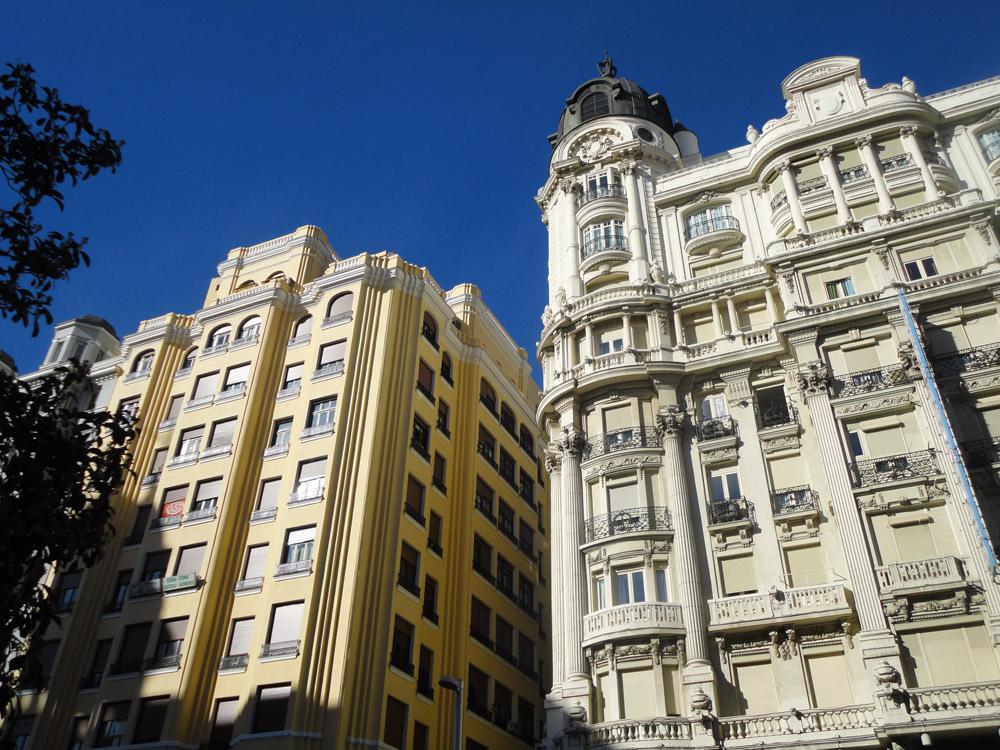
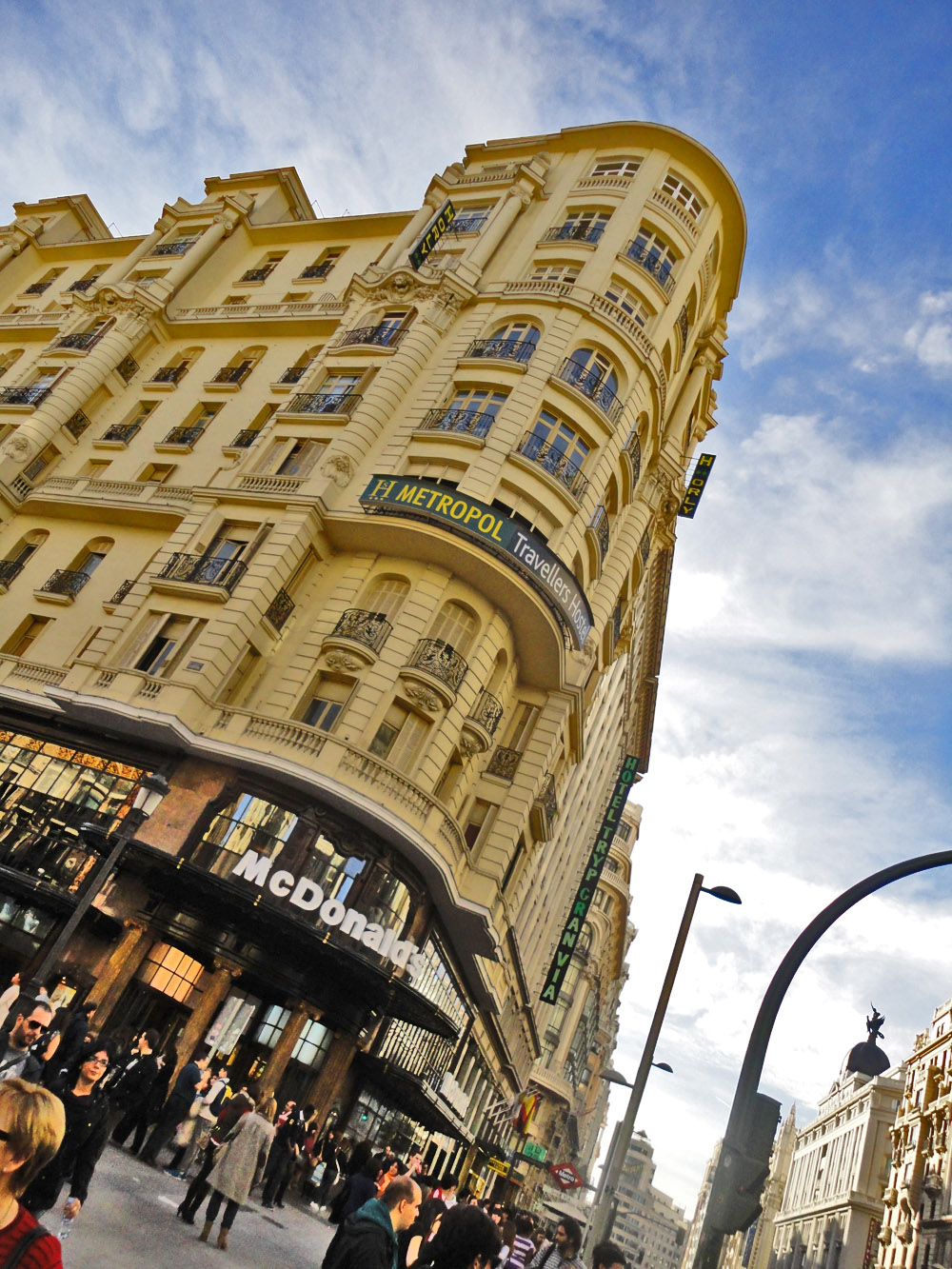

Calle de la Montera. This pedestrian street leads towards Puerta del Sol.
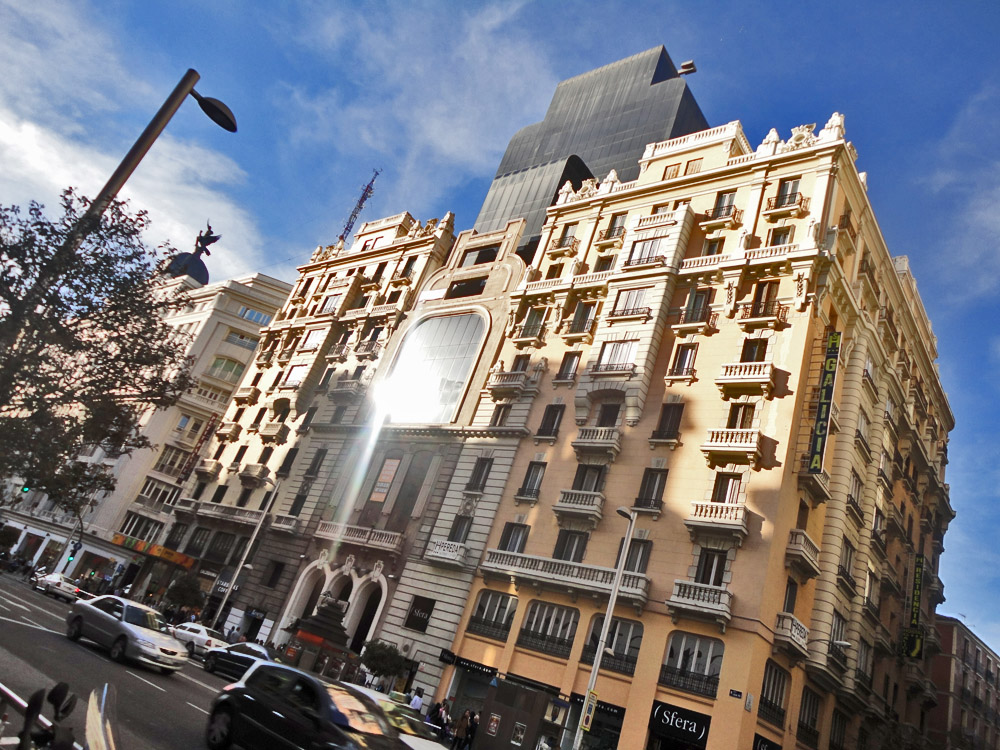
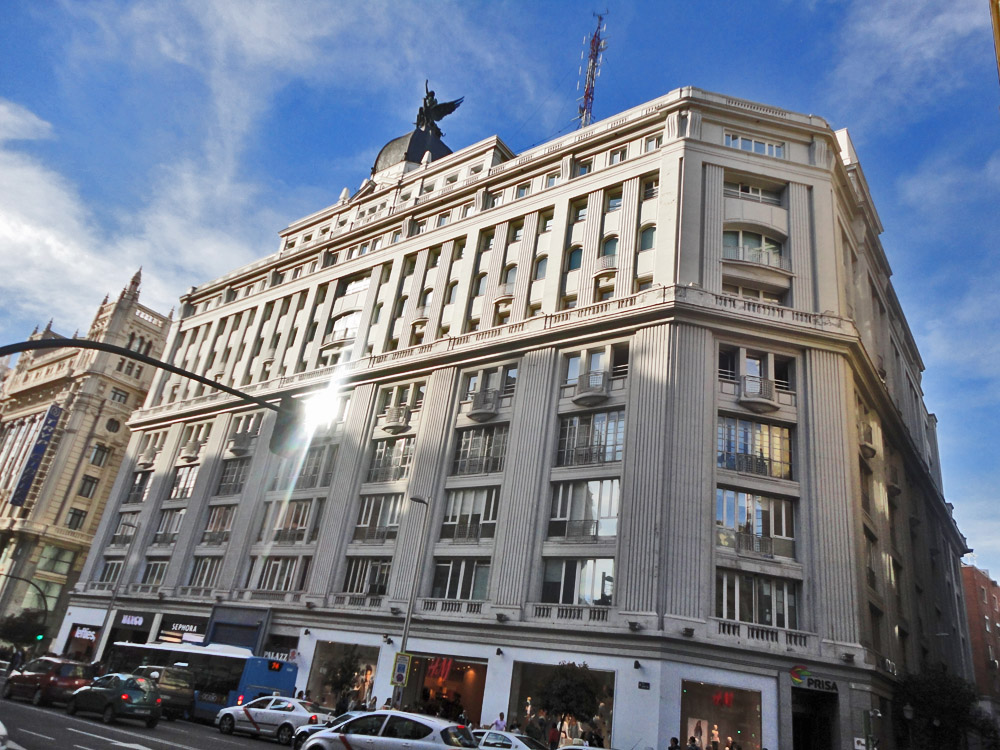
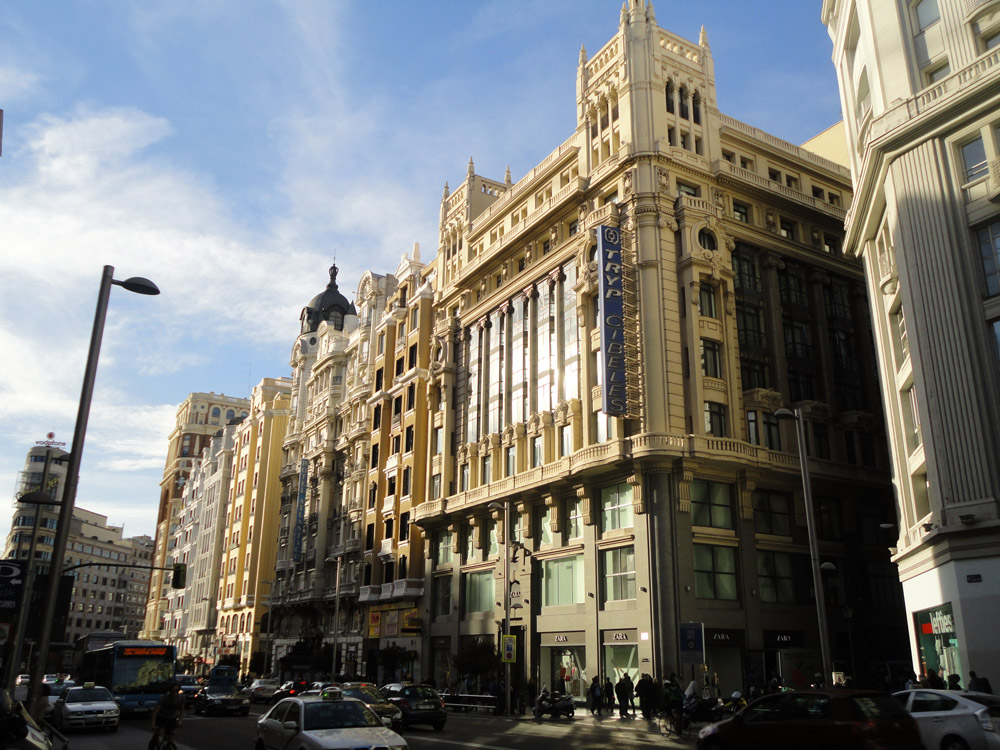
Plaza del Callao at Gran Via:
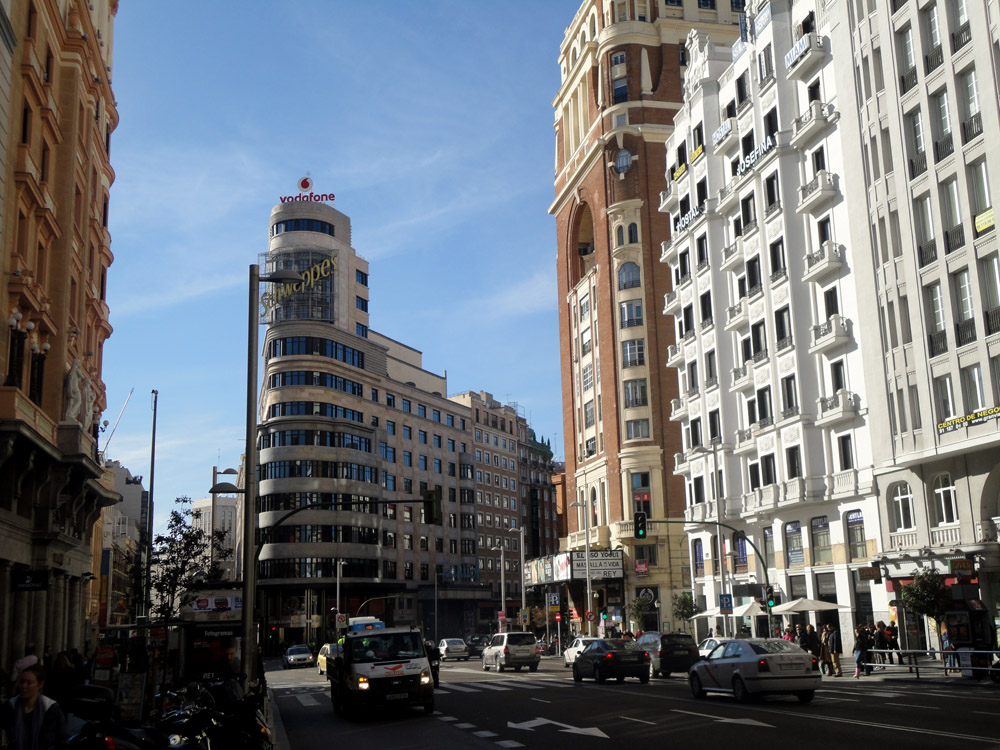
Plaza del Callao with Torre Carrion. This square is the movie center of Madrid, home to 6 cinemas. Callao is a bit like Madrid's answer to New York's Times Square. It also has 2 large department stores.
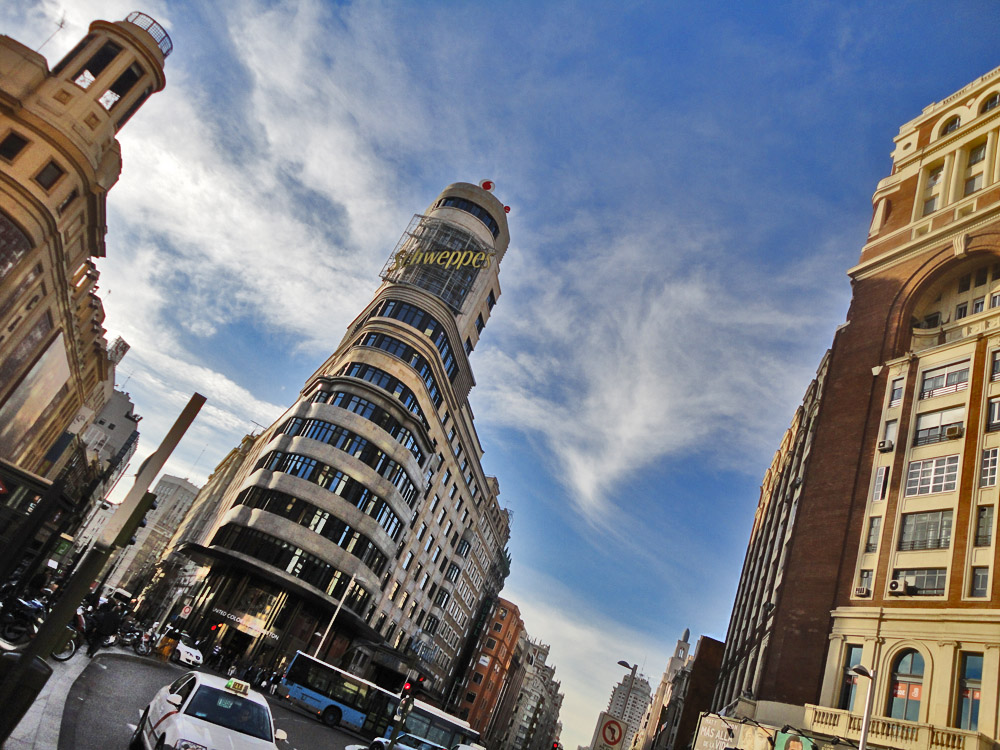
Torre Carrión (middle), or Edificio Capitol, is the 14-storey art deco landmark of Plaza del Callao. It hosts the Capitol Cinema, a Benetton store and a lot more.
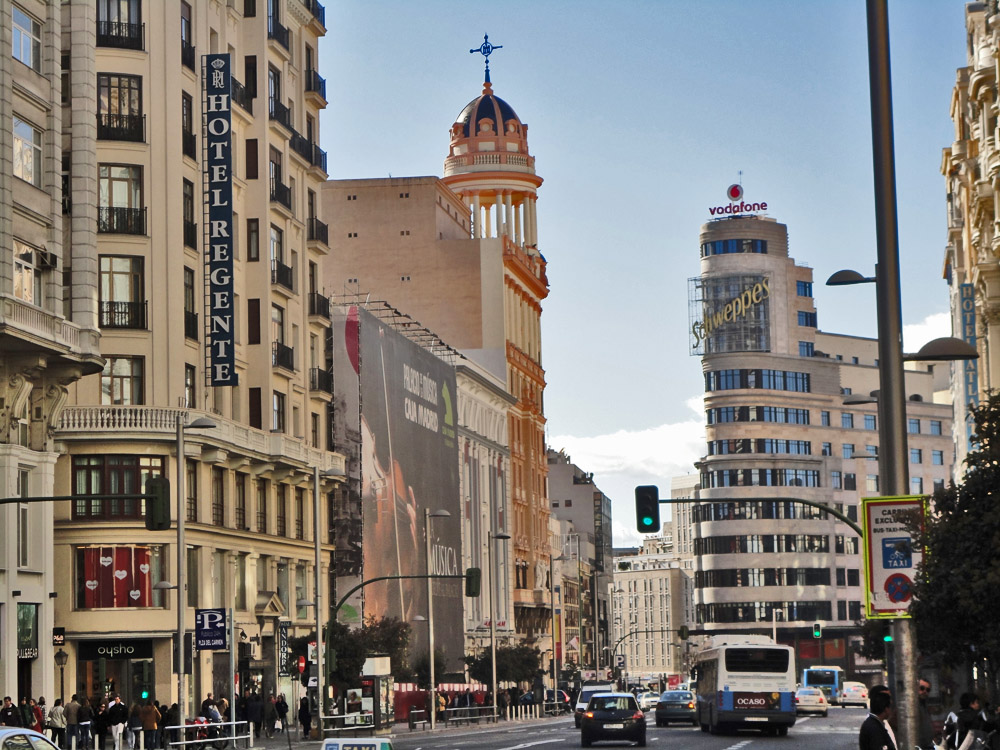
Edificio Allianz is the building with the domed pavilion.
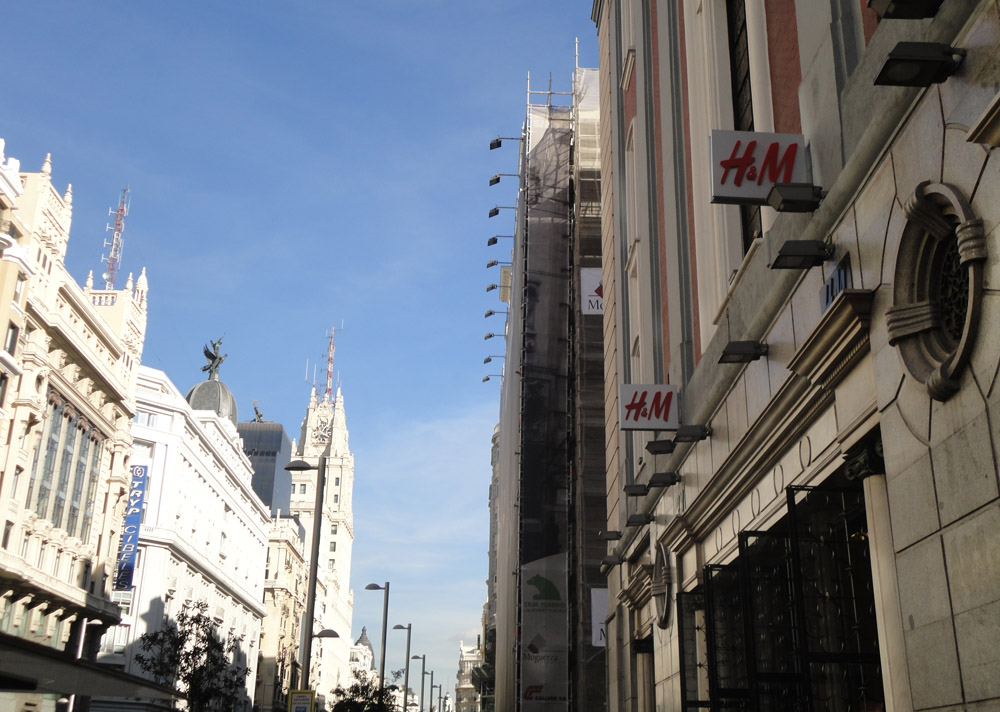
Callao, looking towards H&M and Torre Carrion.
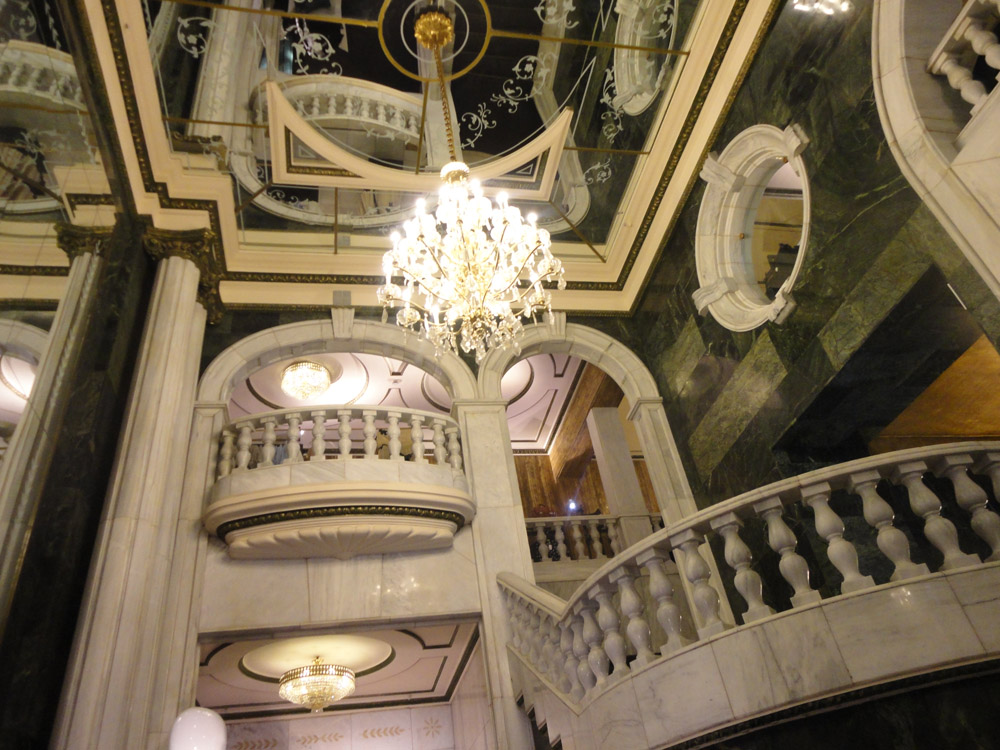
Inside H&M at Gran Via. A lot more upmarket then in Sweden, were it has its originas. This branch's interior looks like a palace.
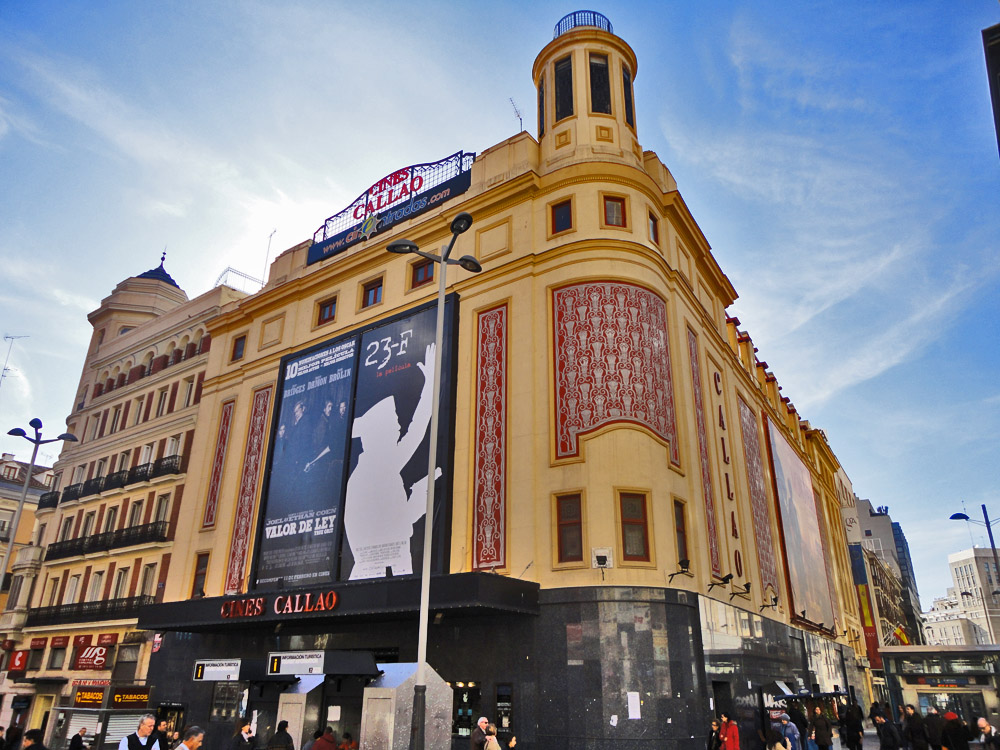
Cines Callao, a large cinema in an outstanding buildng at Callao.
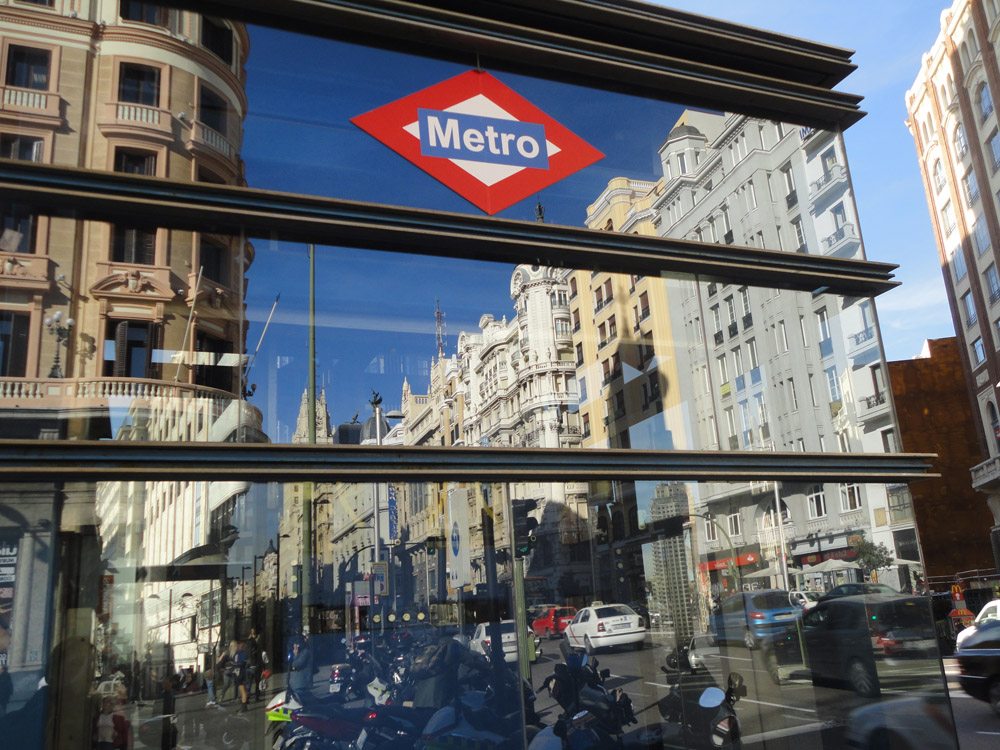
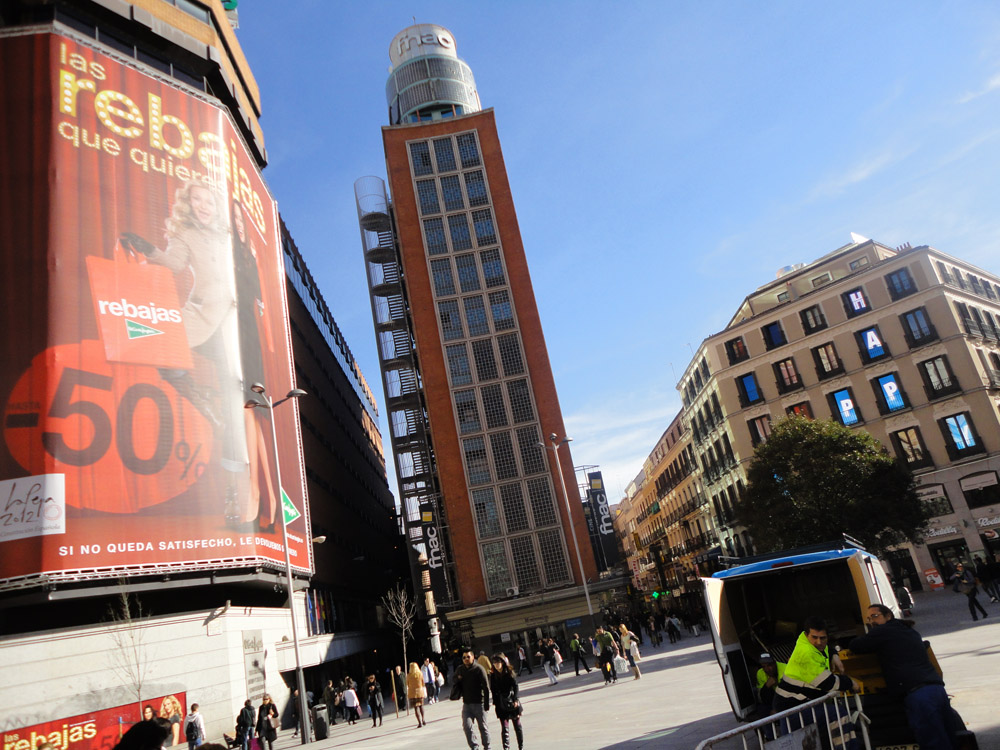
FNAC, a French department store chain specializing in entertainment (records, book etc) occupies a 12-storey narrow highrise at Plaza del Callao. To the left is one of the largest branches of the department store chain El Corte Ingels.
From Callao, Puerta del Sol is only a few blocks away if you walk on Preciados (right).
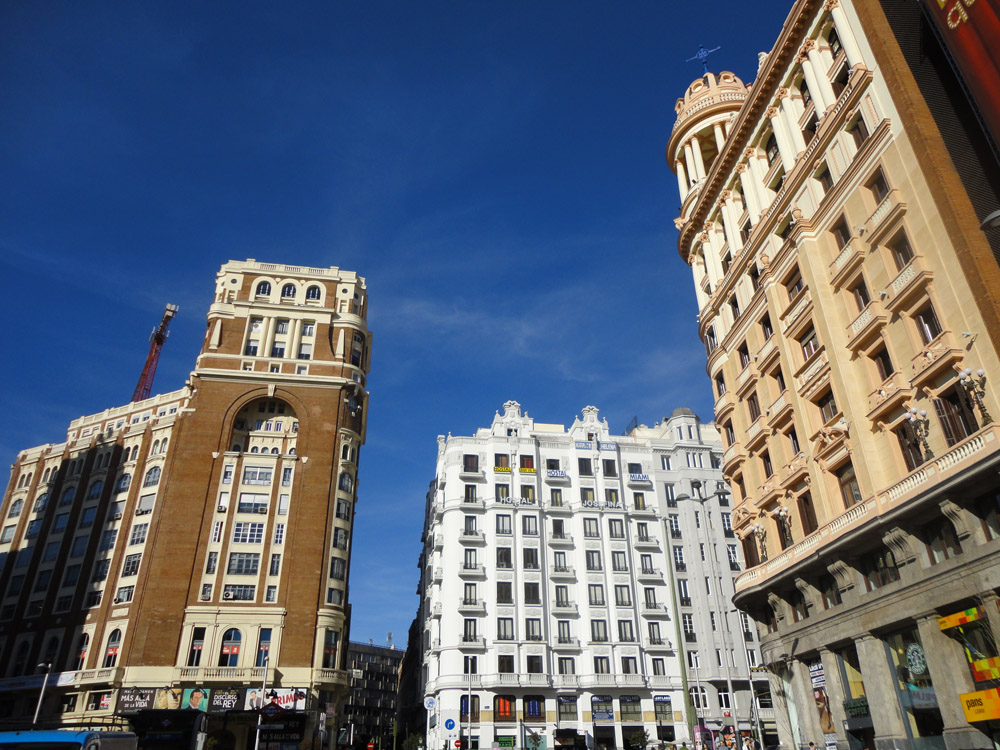
Palacio de la Prensa, is the impressive cinema/residential building to the left.
View from El Corte Inglés, Plaza del Callao:
These photos were taken from the café on the top floor of the department store El Corte Inglés branch at Plaza del Callao.
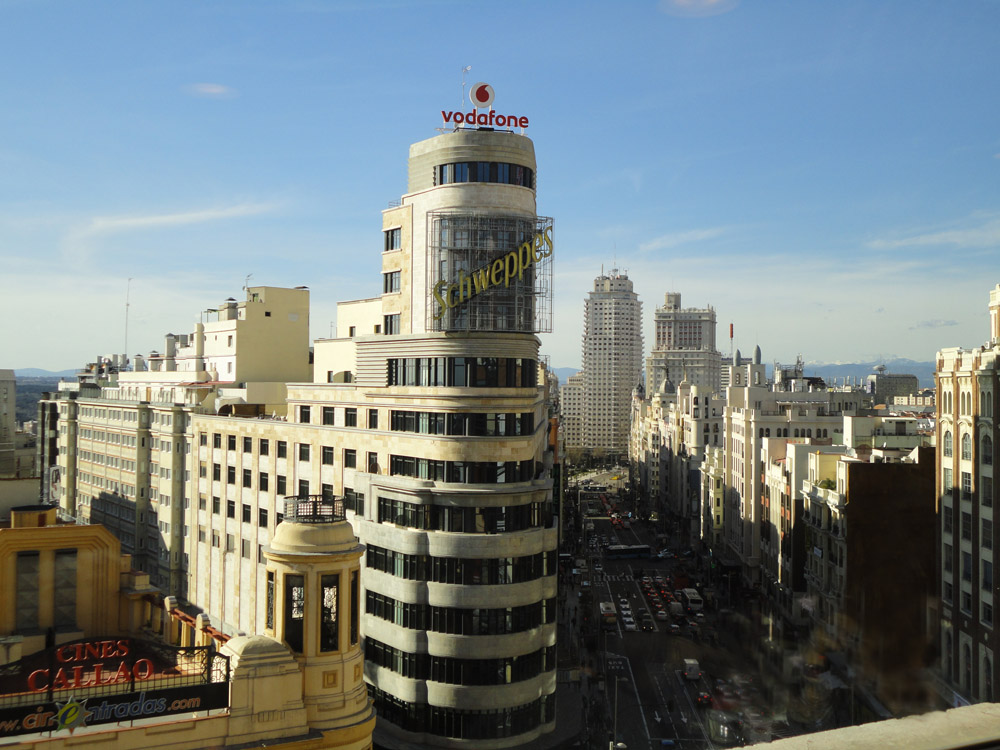
Plaza del Callao with Torre Carrión (left) and Gran Via leading towards Torre de Madrid at Plaza de España. Mountains in the background.
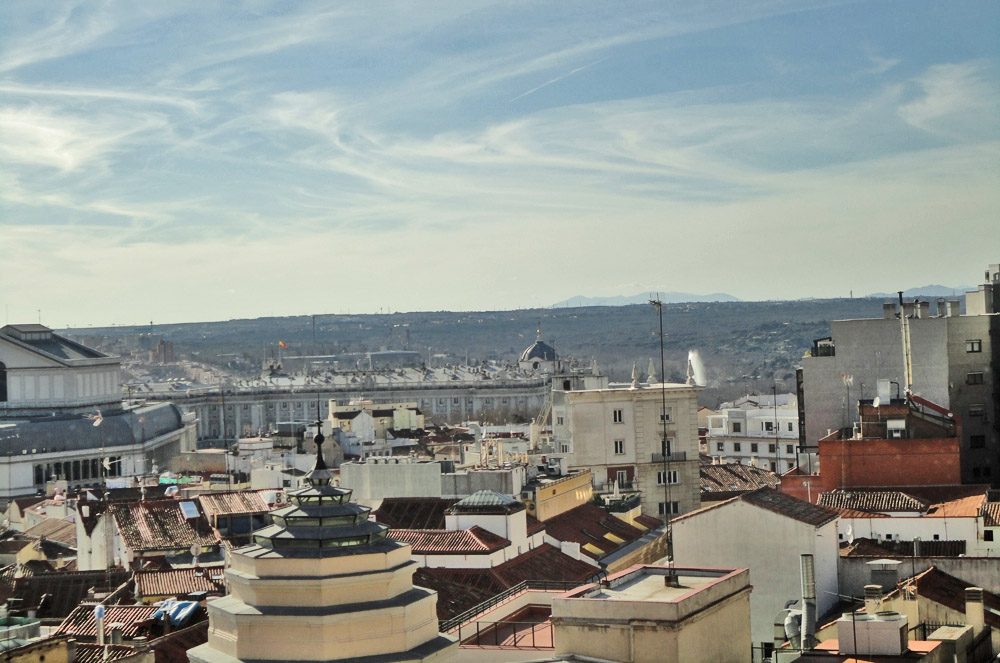
Towards Palacio Real and the mountains of Sierra de Guadarrama.
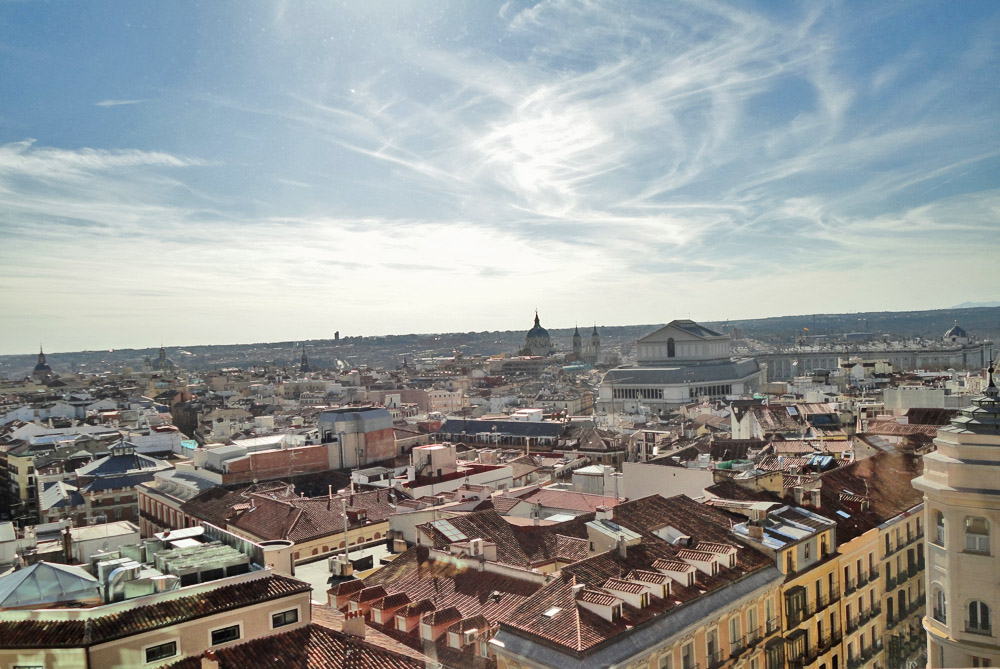
Looking to the southwest: Almudena Cathedral (right), the national theater and some other churches.
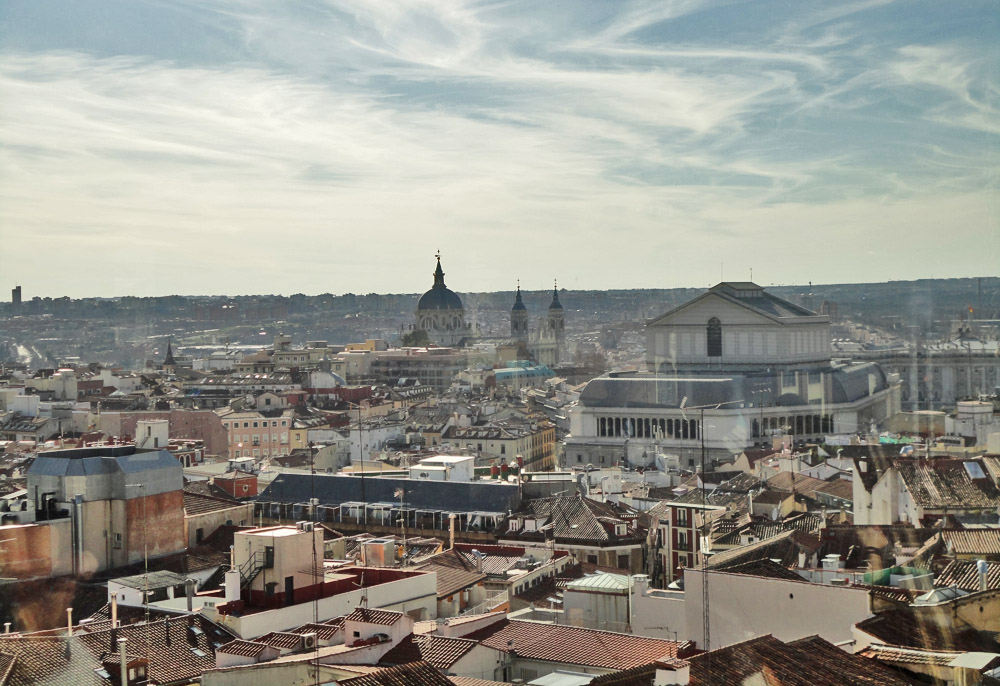
Almudena Cathedral and the National Theater. Commie blocks in the distance.
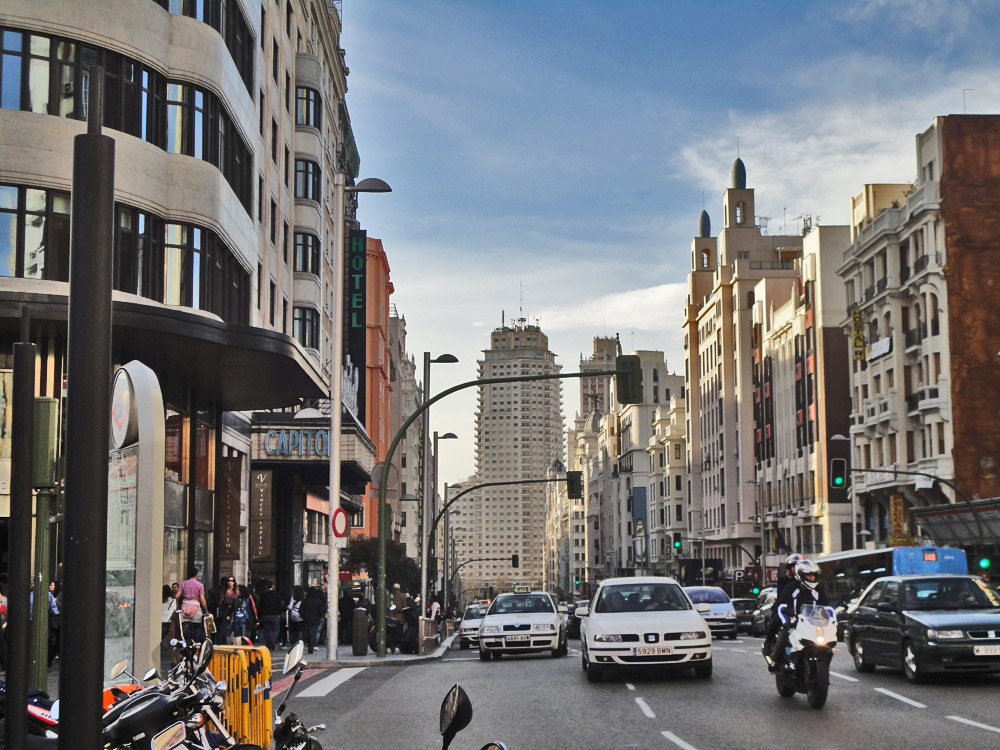
Looking West towards Plaza de España with its landmark Torre de Madrid...
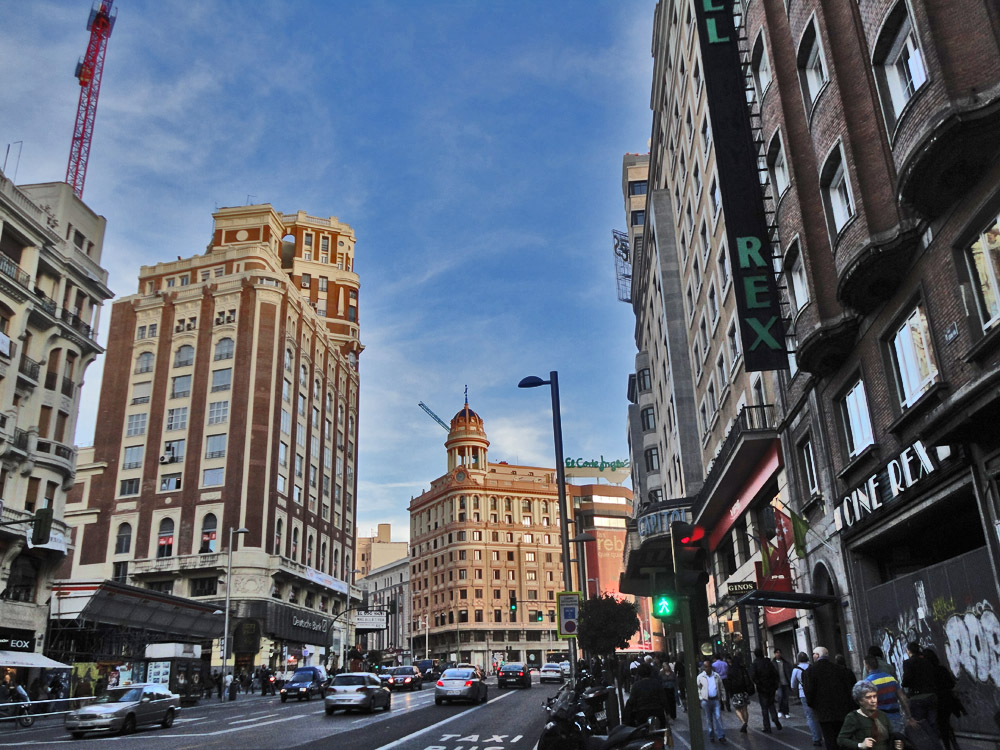
...and East towards Plaza del Callao.
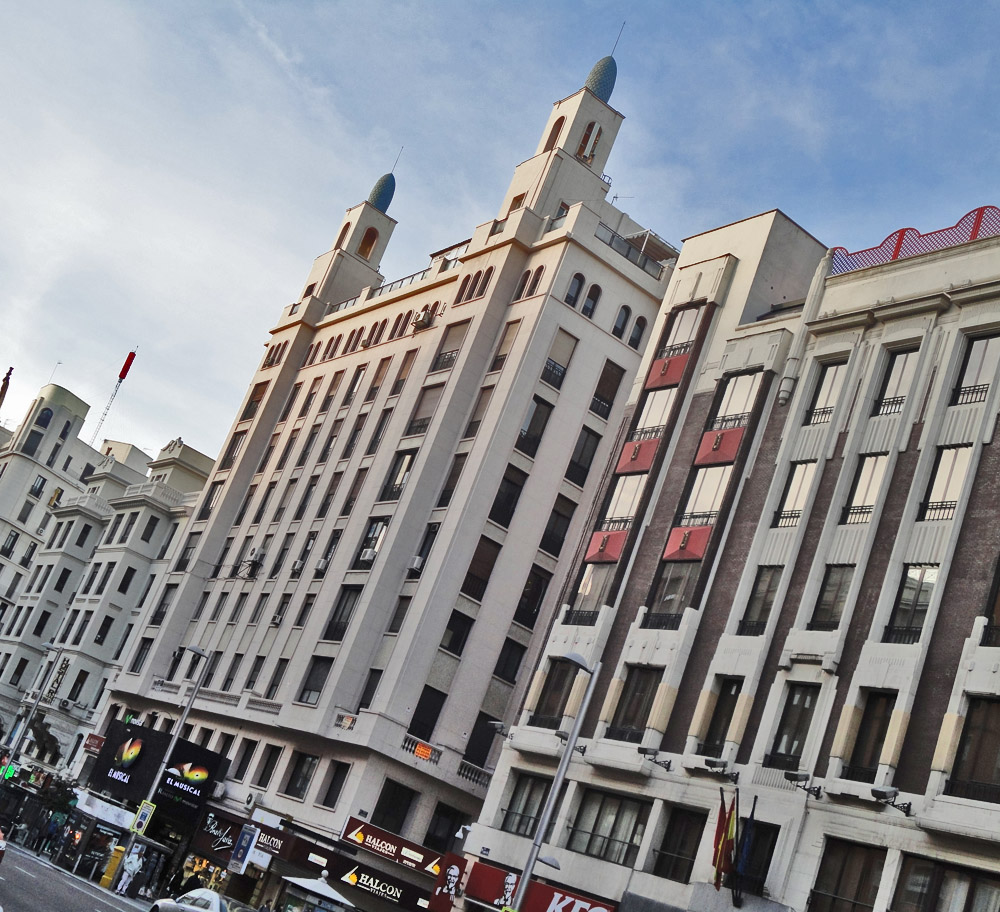
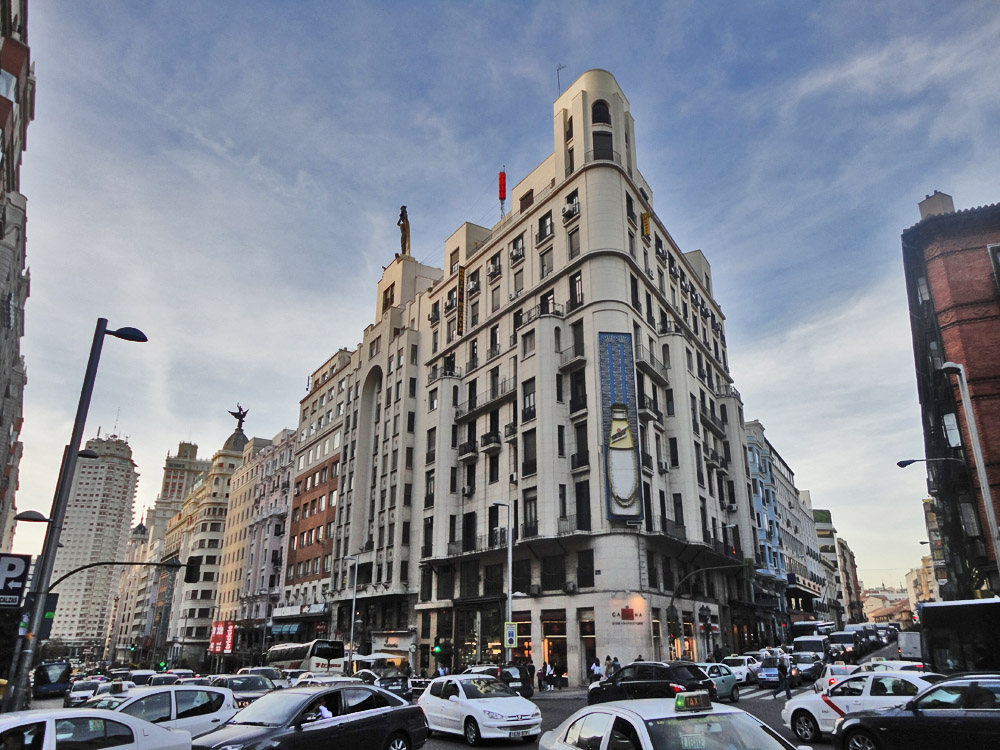
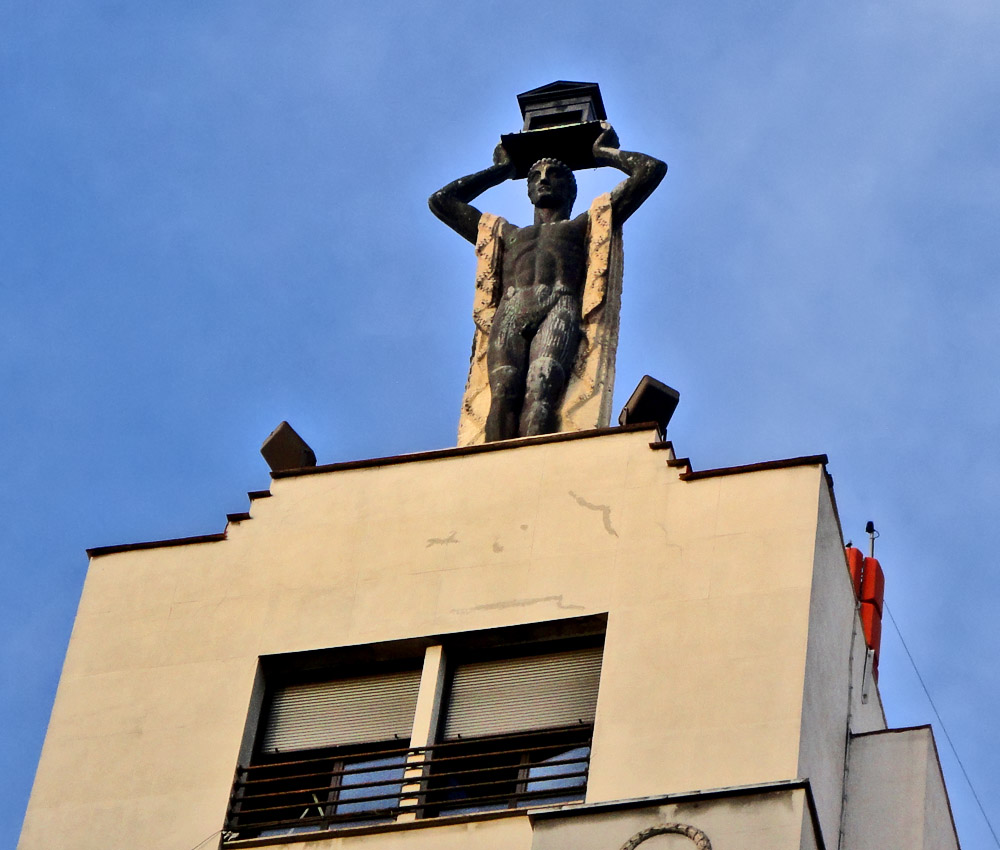
A statue throughing a building on the street?!
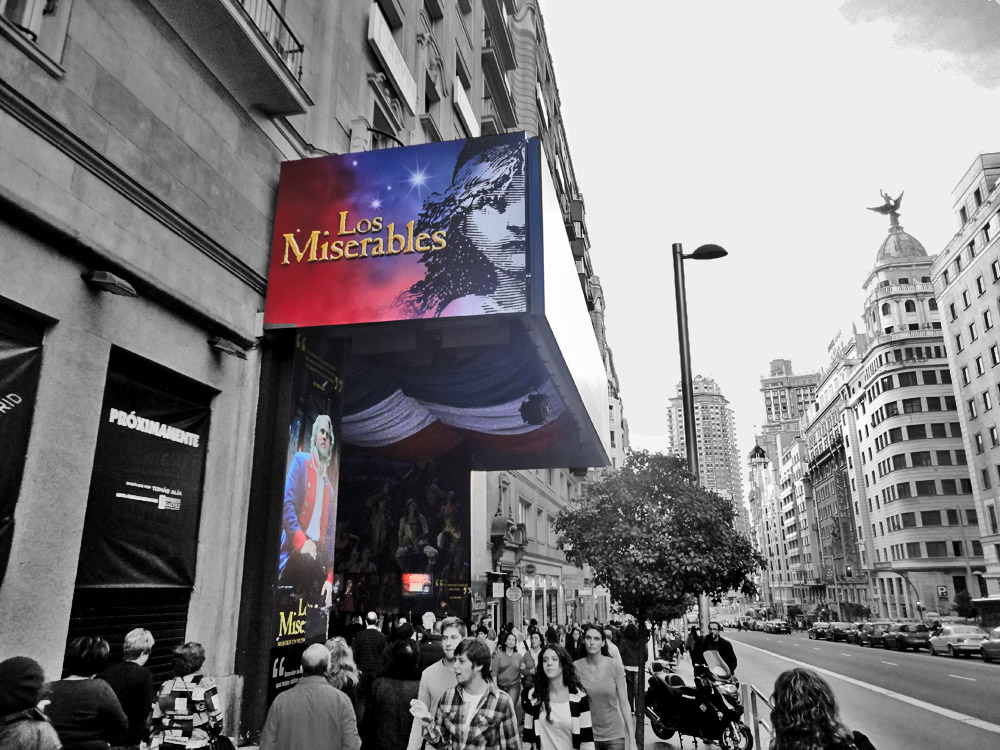
World famous musicals can be seen in the world metropolis Madrid.
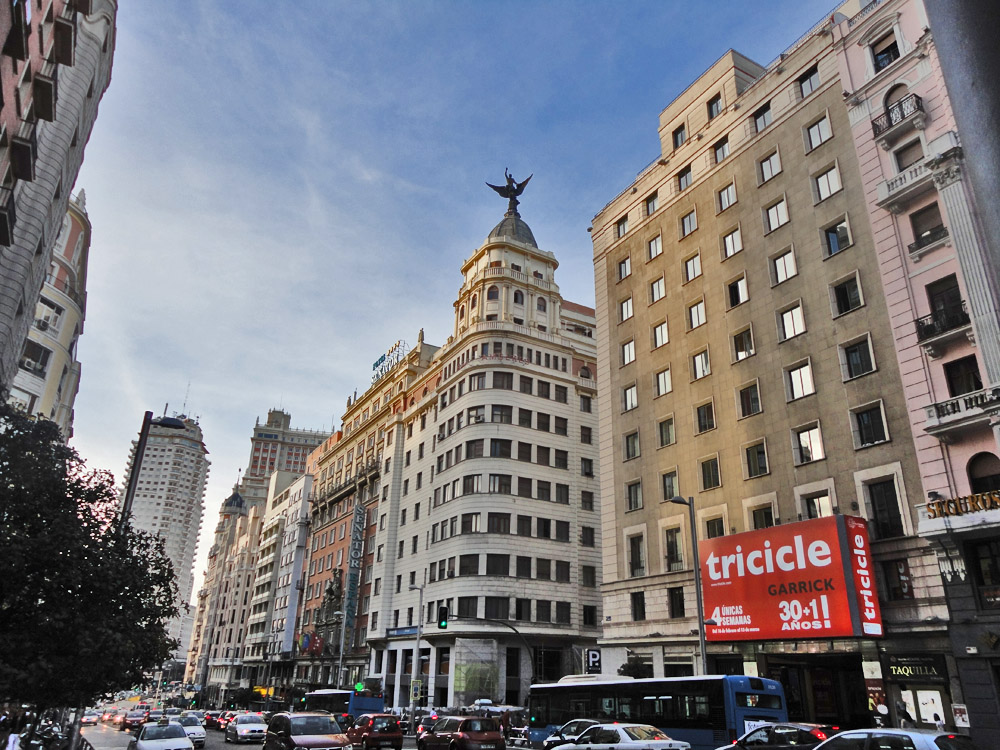
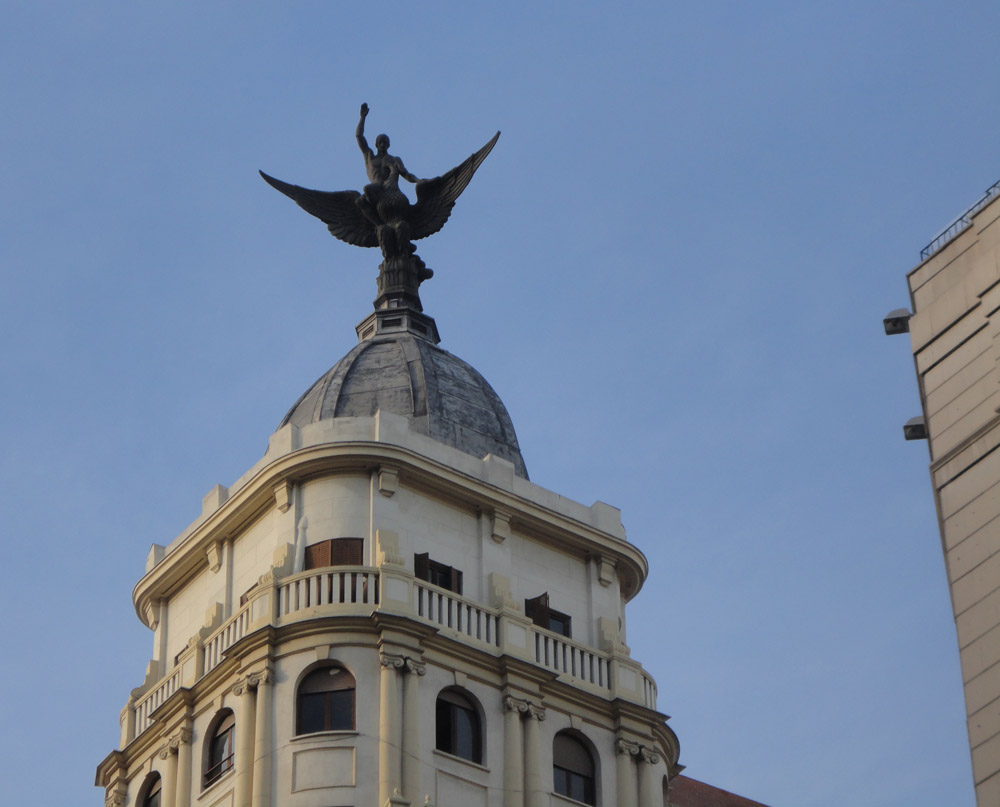
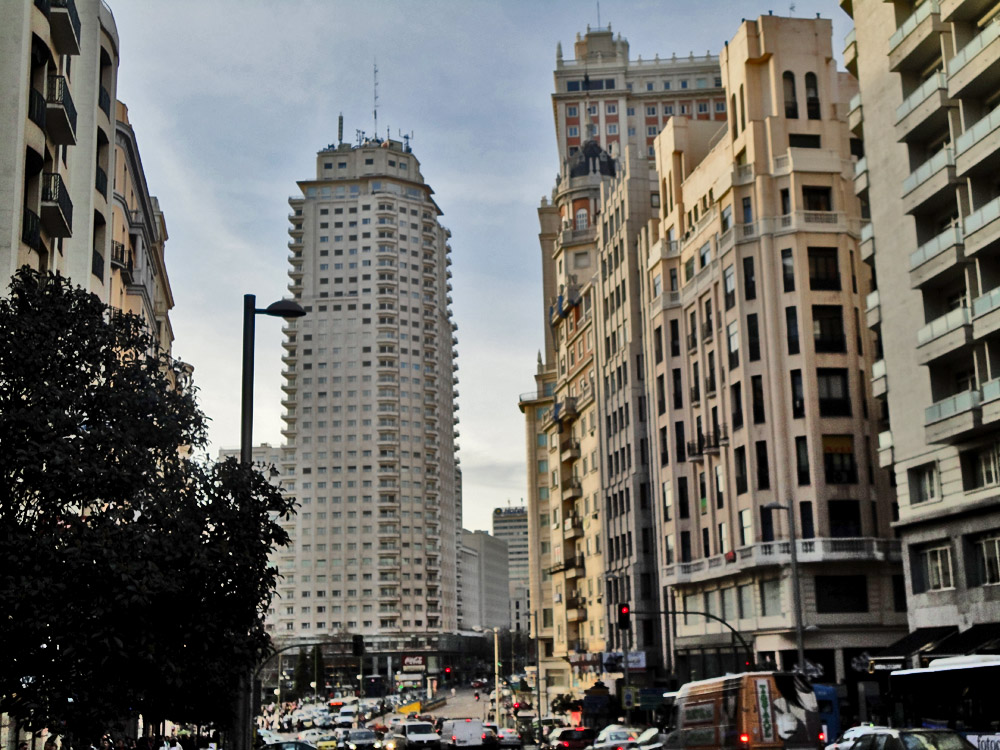
Plaza de España. The west end of Gran Via.
Along Paseo del Prado
- Plaza de Cibeles, Plaza de Canovas del Castillo, Plaza Lealtad, Plaza Independencia, Puerta de Alcalá and Museo del Prado
The green boulevard Paseo del Prado borders the East part of Madrid's city center from Parque del Retiro, in a North-South direction. Along the avenue some of the most magnificent, and also most trafficated, plazas of Madrid are located. The most important of them is Plaza de Cibeles were the beautiful City Hall is. And Museo del Prado, one of the world's most famous art museums, is of course located along Museo del Prado, as well as the Botanical Garden. Paseo del Prado begins at Plaza del Emperador Carlos V, where Atocha, Madrid's largest station is, and ends at Plaza de Cibeles, where it changes name to Paseo de Recoletos, and then changes name again to Paseo de la Castellana, and continues to the skyscraper districts in the North. Despite it is very trafficated, Paseo del Prado is a nice place to stroll.
Plaza de Cibeles
Plaza de Cibeles is where both Gran Via and Calle Alcalá ends. It is also the North end of Paseo del Prado, so it is a really busy, but also very beautiful plaza, despite all the traffic. In the middle of the square there is an imposing sculpture with a fountain. The impressive City Hall, or Palacio de Communicationes is also here, just like Banco de Espana, the great national bank, Palacio Linares and Palacio de Buenavista. Edifico Metropolis is just a few blocks from, and is visible from, the plaza. The Alcalá Gate can also be seen.
At one occasion there were a lot of emergency vehicles and police cars. I looked and saw they found the body of a dead person! Fortunately wrapped in some kind of golden material.
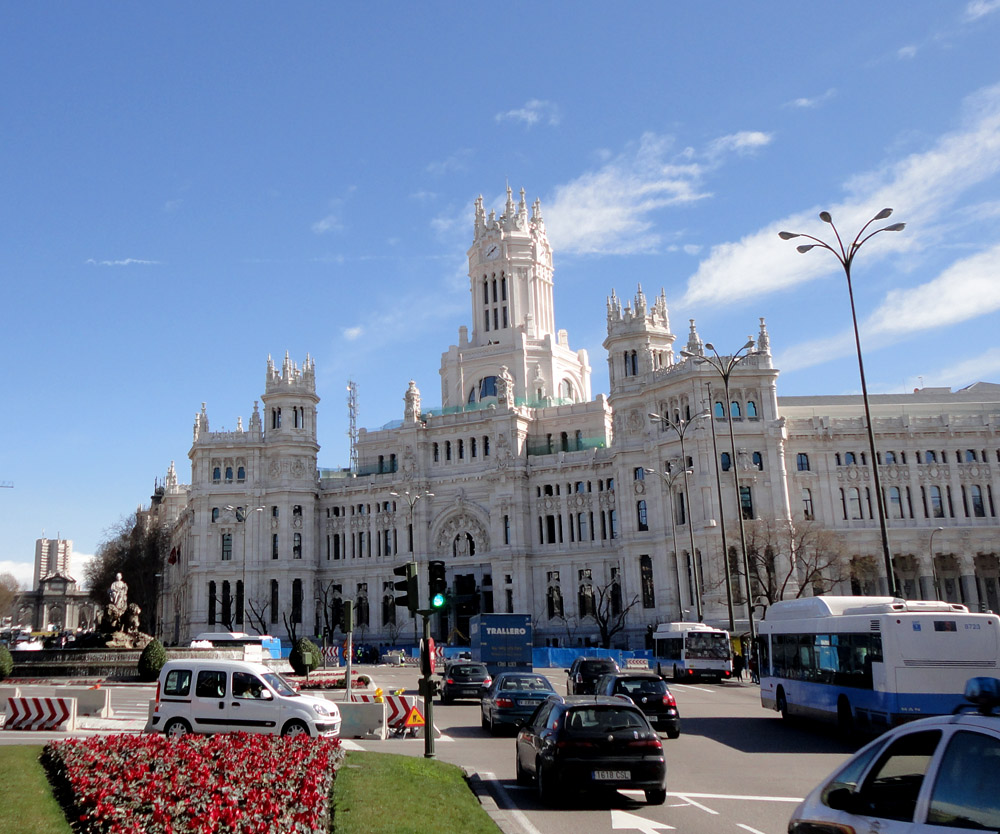
Palacio de Communicaciones, the current City Hall of Madrid. This impressive neo Gothic building draws attention like a magnet. Palacio de Communicaciones was built in 1909 and drawn by Antonio Palacios as the main post office of Madrid. It is also called Correos. Note Alcalá Gate to the left.
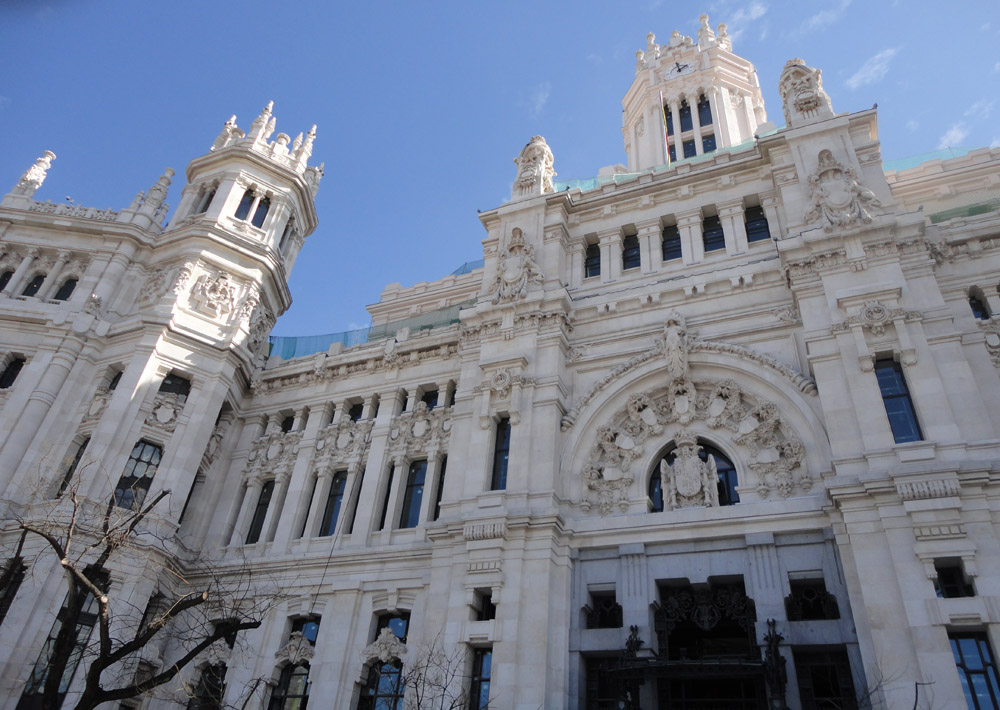
The interior is also very impressive, ufortunately we missed to go inside. It was a postal museum until 2007, when it became the City Hall, Ayuntamiento de Madrid.
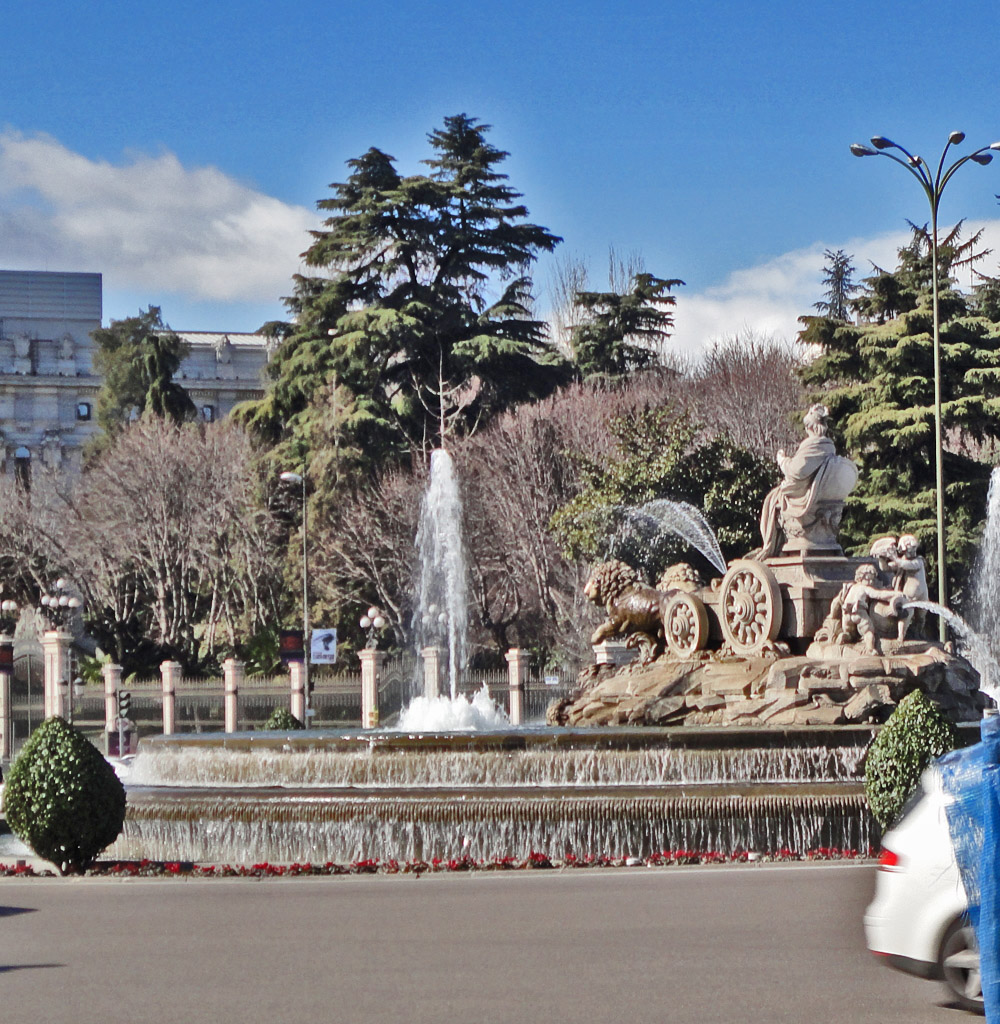
The fountain of Cibeles is drawn by Ventura Rodríguez and is the most famous sculpture. It represents Cibeles, the roman godess of nature in a carriage driven by horses.
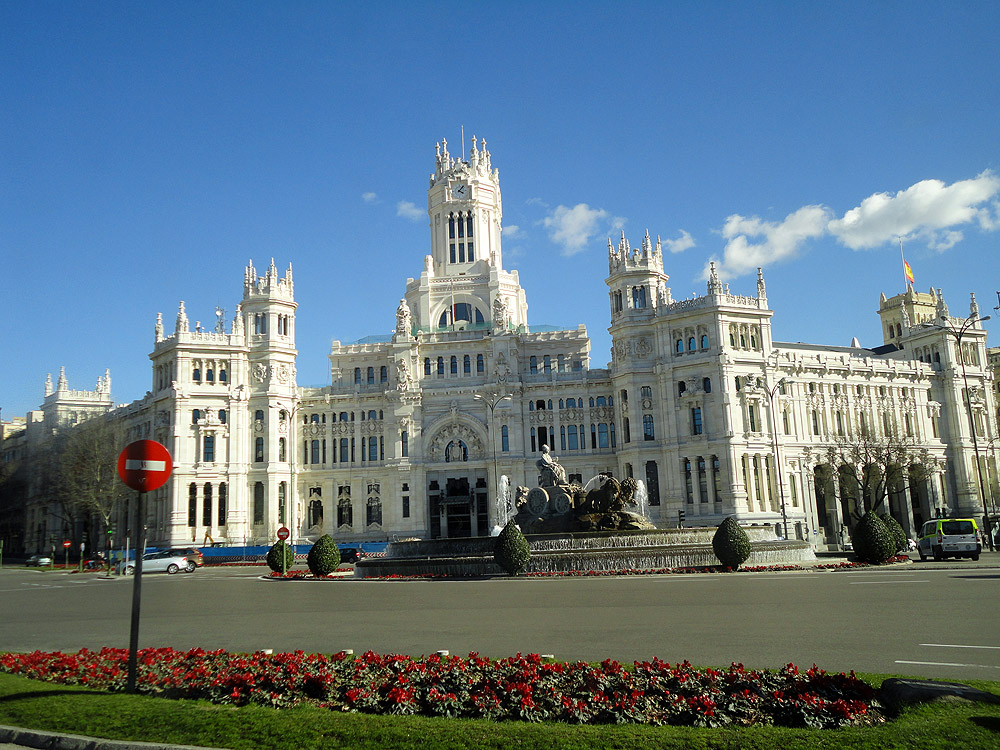

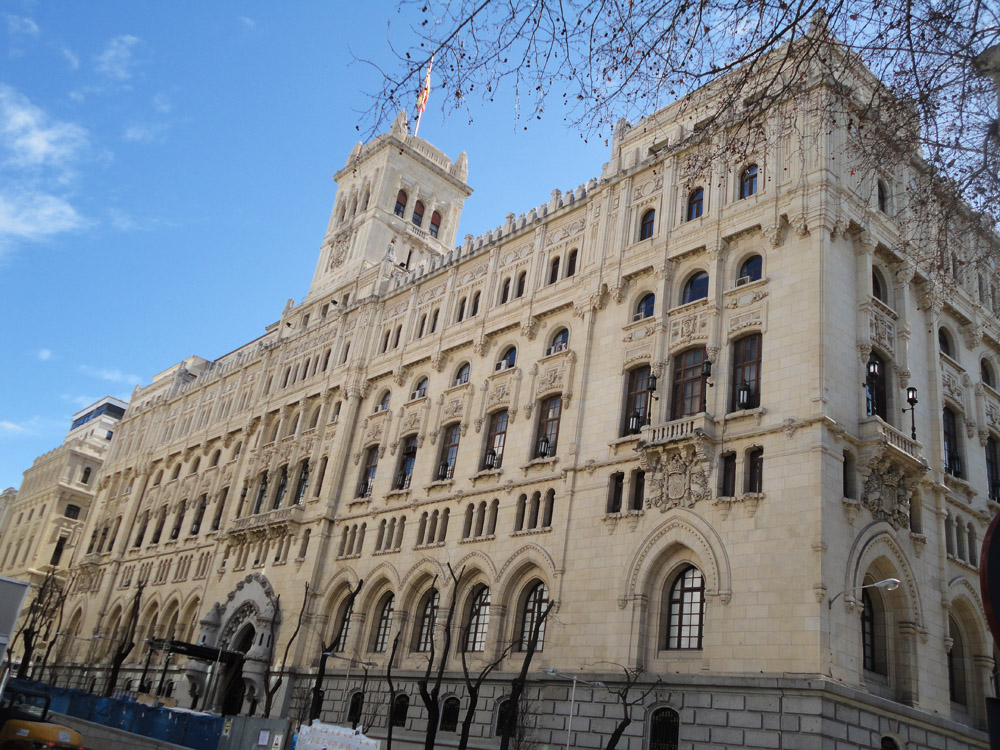
Anyone knows the name of this building next to the city hall?
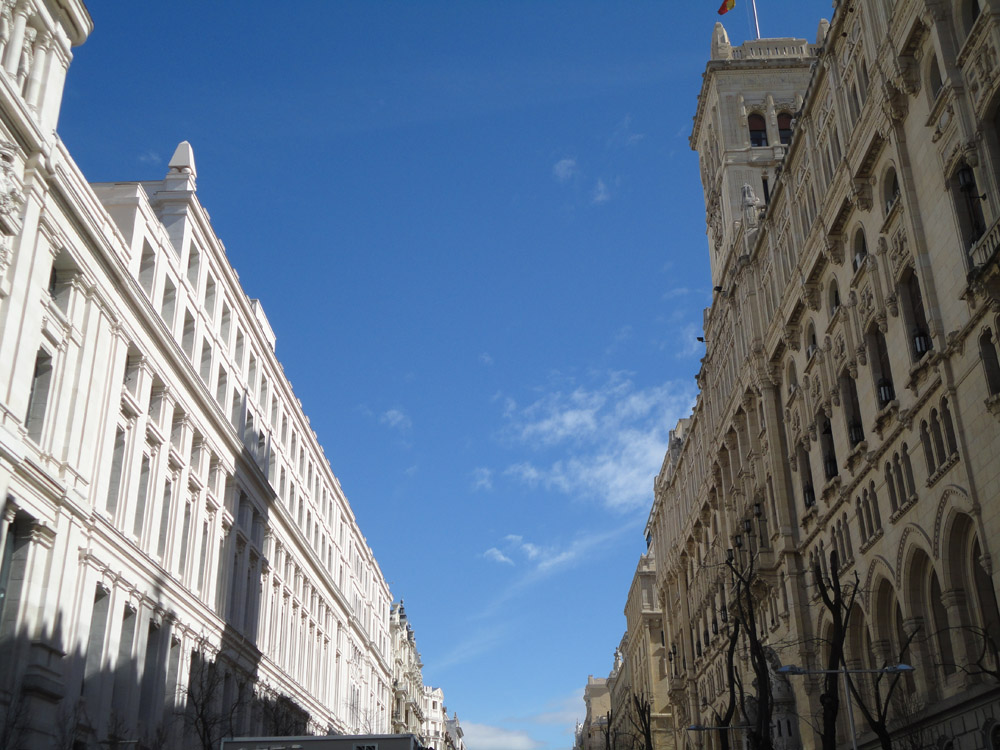
Palacio de Communicaciones (left) and another majestic building, along Calle de Montalbán.
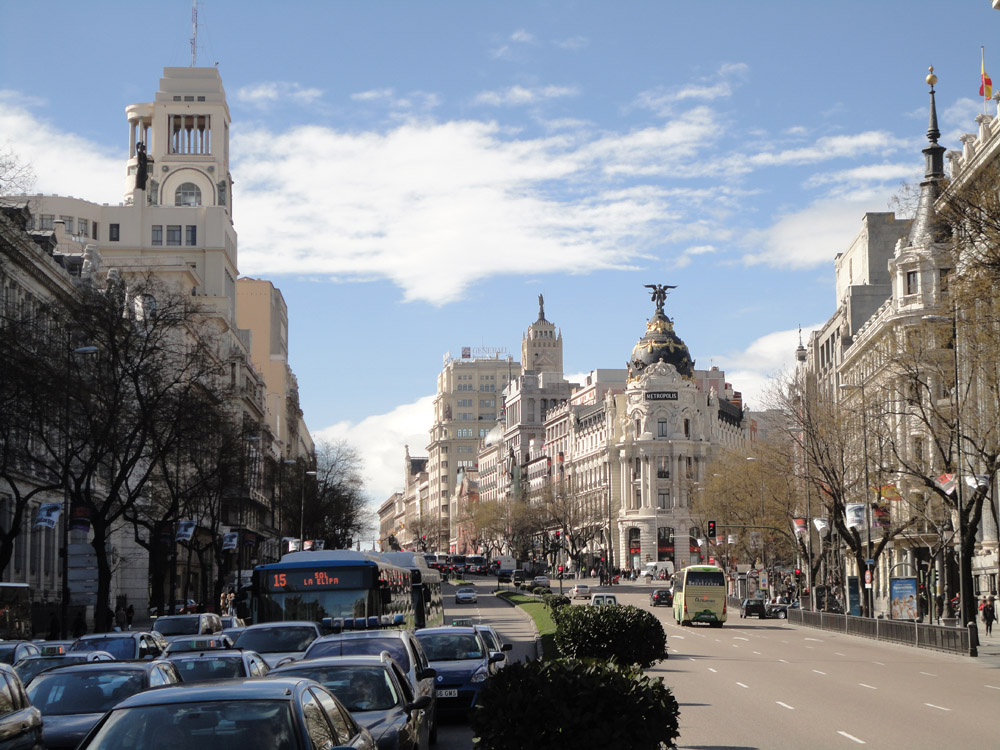
The Metropolis Building and some other landmarks seen from Plaza Cibeles. To the left is Calle Alcalá and to the right is Gran Via.

Banco de Espana, Metropolis and Palacio de Buenavista are some of the famous buildings in this picture. Palacio de Buenavista (righ), is a palace built for the Alba family, but now occupied by the army. The Duches of Alba, rumoured to be one of Goya's lovers, lived here.
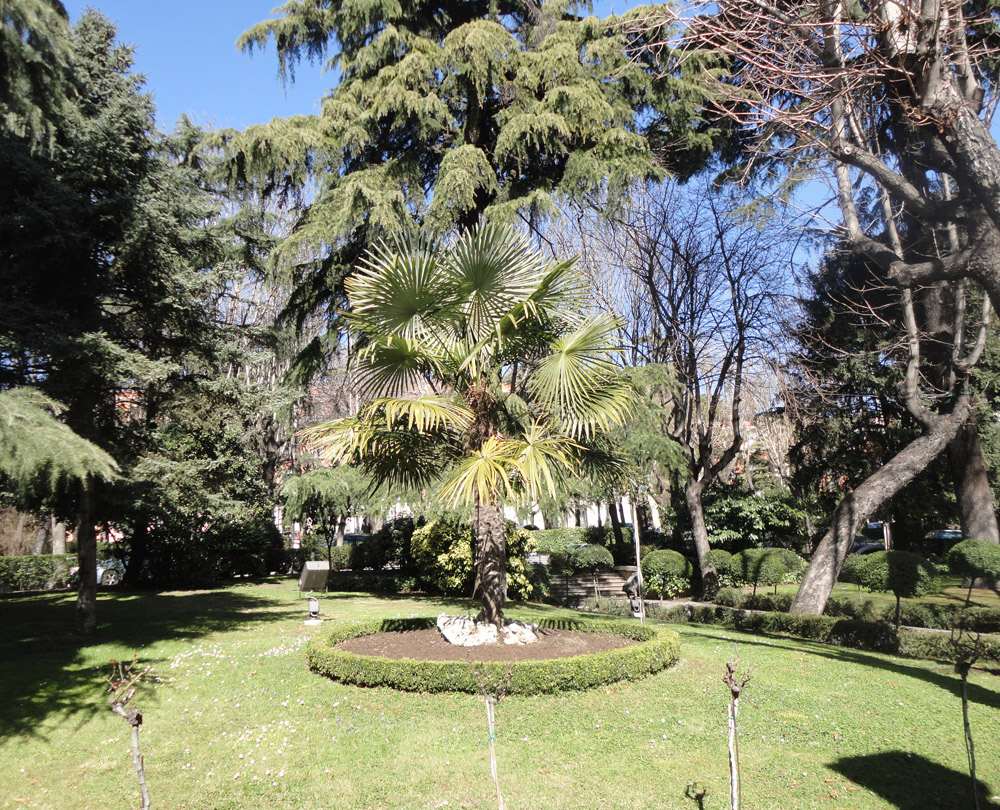
The gardens of the Palacio Buenavista.
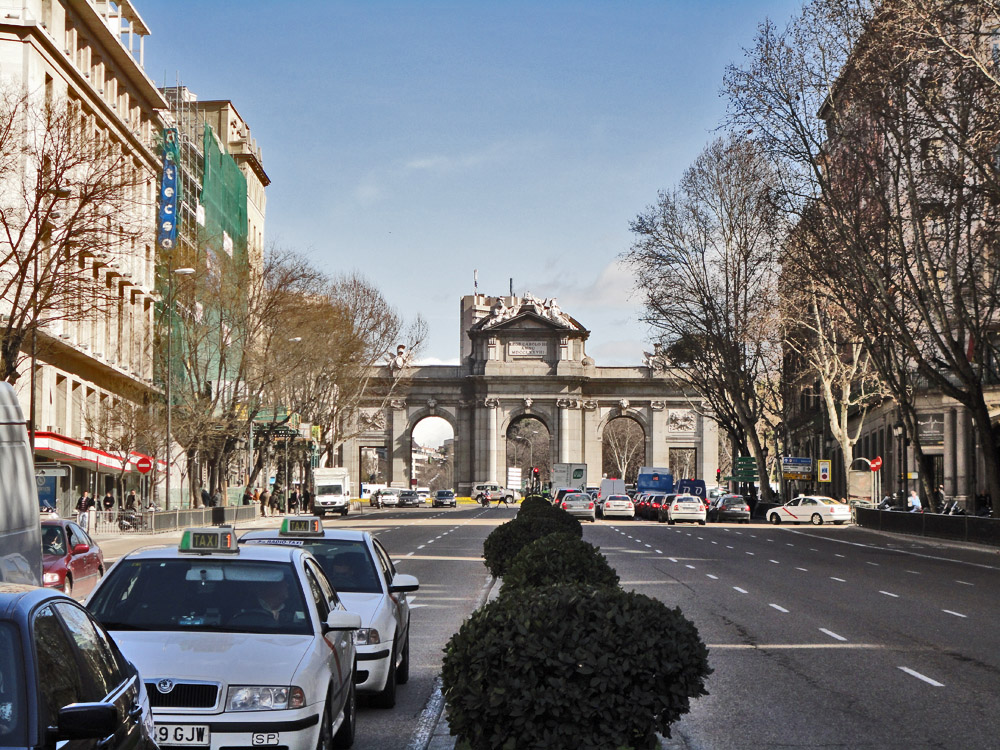
Alcalá Gate seen from Plaza Cibeles.
Plaza Independencia
Plaza Independencia is a heavy trafficated circlular plaza next to the main gate to Parque del Retiro, close to Plaza Cibeles. It is mostly famous for that the Alcalá Gate is situated in the middle, before all the traffic.
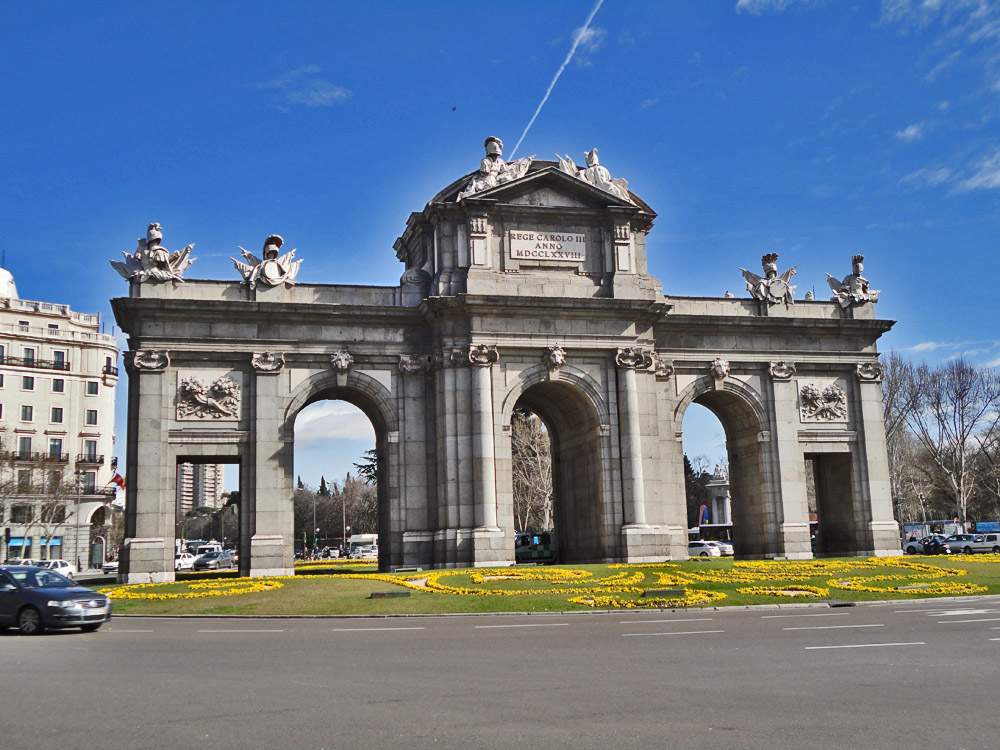
Puerta de Alcalá, or Alcala Gate, is a gate on Plaza Independencia. This neoclassical gate, now a national monument, was designed by the Italian architect Sabatini and completed in 1778.
Plaza de Cánovas del Castillo
This square is very similar to Plaza Cibeles; a plaza with a sculpture fountain (Neptuno) surrounded by trafficated roads and magnificent buildings. 4 of Madrid's most exclusive hotels, Hotel Ritz, Hotel Palace, Hotel del Prado and Villa Real, are situated here. It is just next to the Prado Museum, Museo Thyssen Bornemisza and Plaza Lealtad. The buildings and sculptures at Cánovas del Castillo are illuminated after dark.
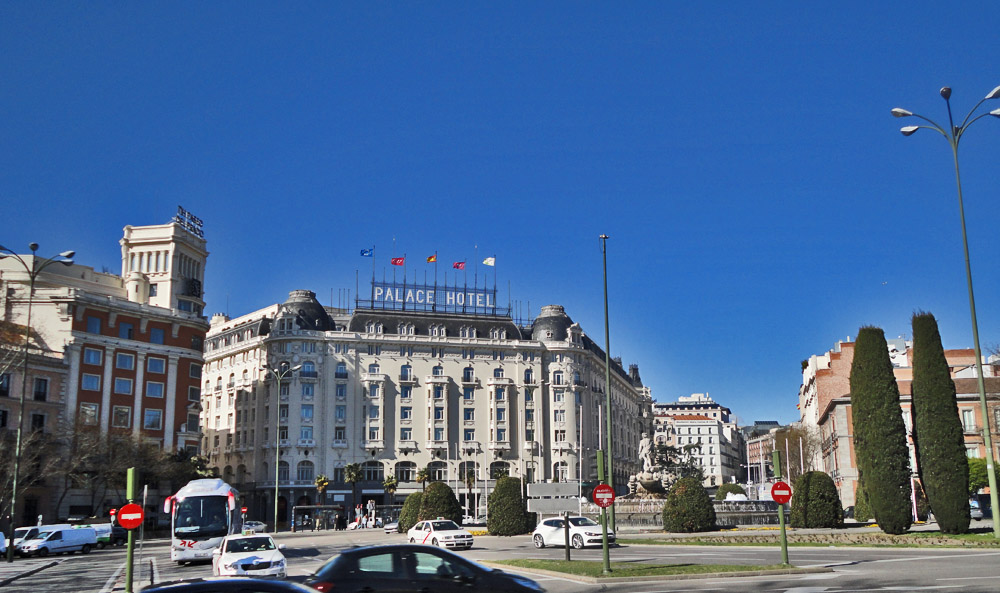
Plaza de Cánovas del Castillo is sometimes called just Plaza Neptuno. Here you can see the Palace Hotel from 1913 and the Neptune fountain. Looking West.
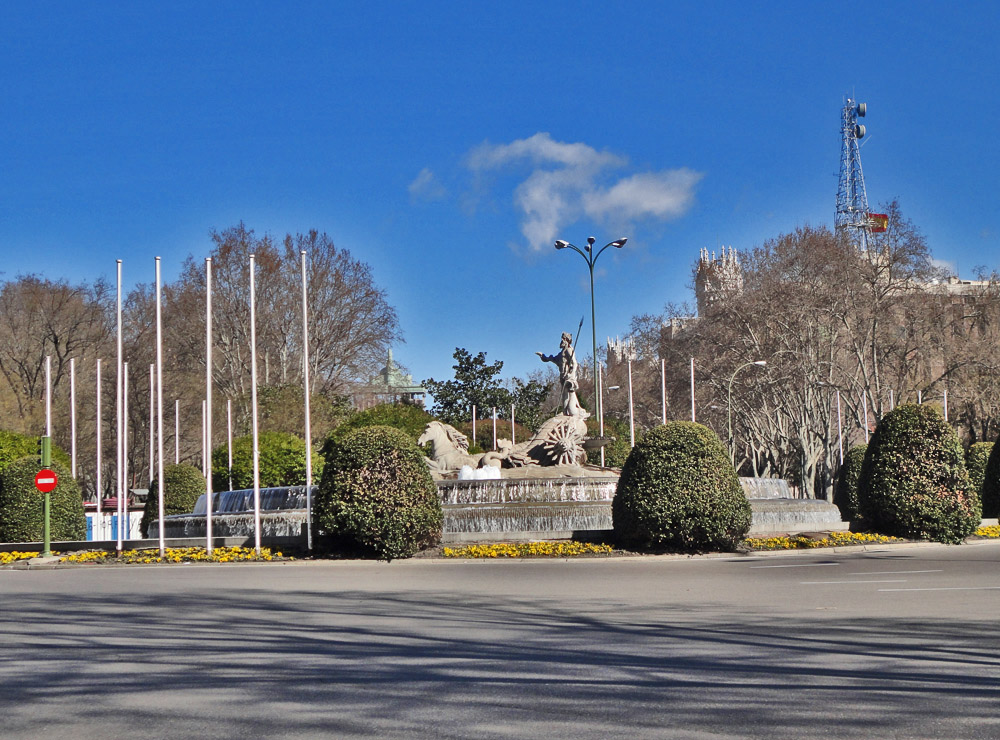
Fuente de Neptuno, The Neptune fountain, is in the middle of the square. Looking to the East.

Hotel Ritz, Madrid's oldest luxury hotel.
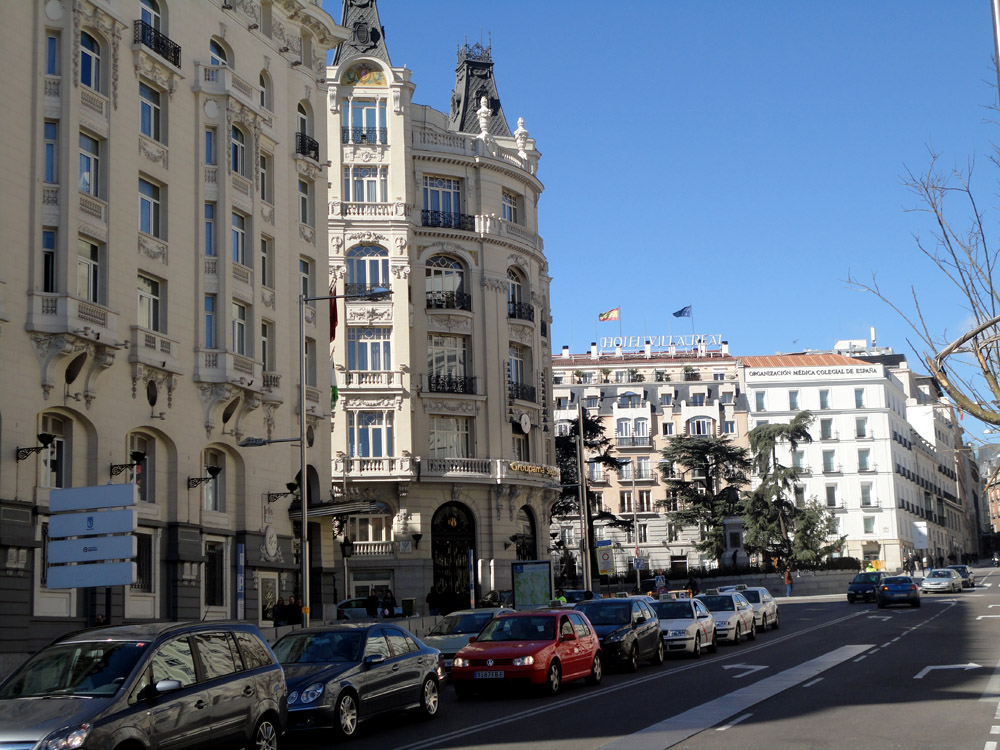

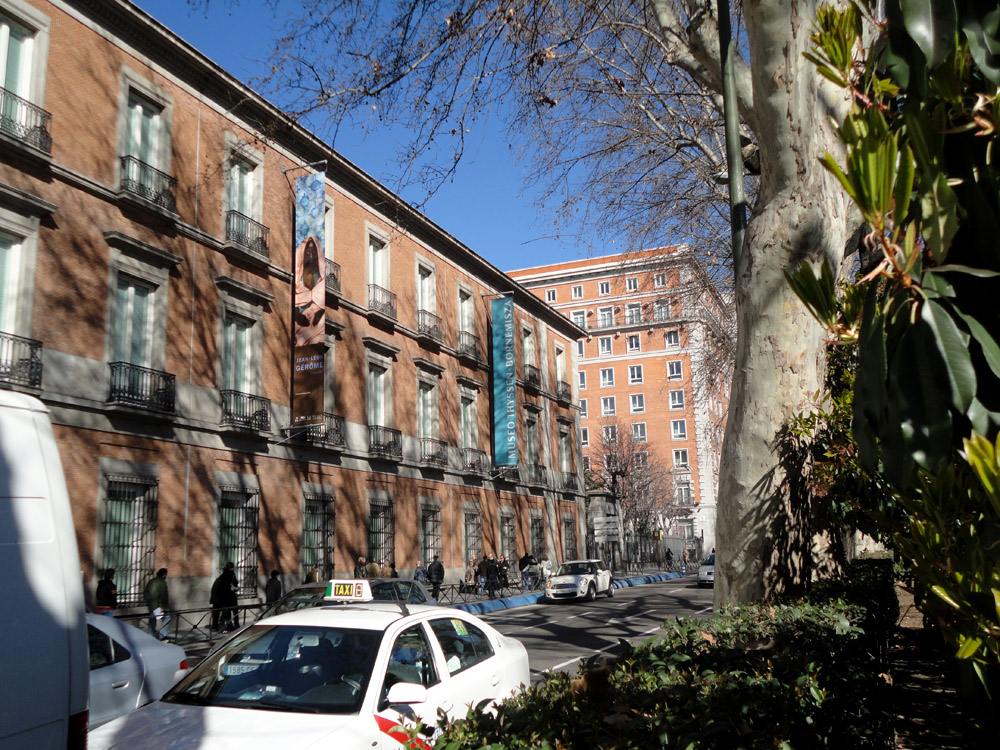
Museo Thyssen-Bornemisza, Madrid's 3rd largest art museum. Housed in Palacio de Villahermosa.

Congreso de los Diputados, a legislavitve government, has both an old classical (right) and a curvy modern part (left).


Caixa Forum. A modern art museum famous for its rare architecture.

Iglesias de San Jerónimo el Real. This is were the current king, Juan Carlos, were coroned. The royal church is just next to Prado. It was originally built in the 16th
century, but has been changed many times.
Plaza de la Lealtad
Plaza Lealtad is a small square just next to Plaza Cánovas del Castillo, along Paseo del Prado. It is mostly famous for the 2nd of May monument and is also were Madrid's stock exchange and Hotel Ritz is. The plaza has palms greenery.
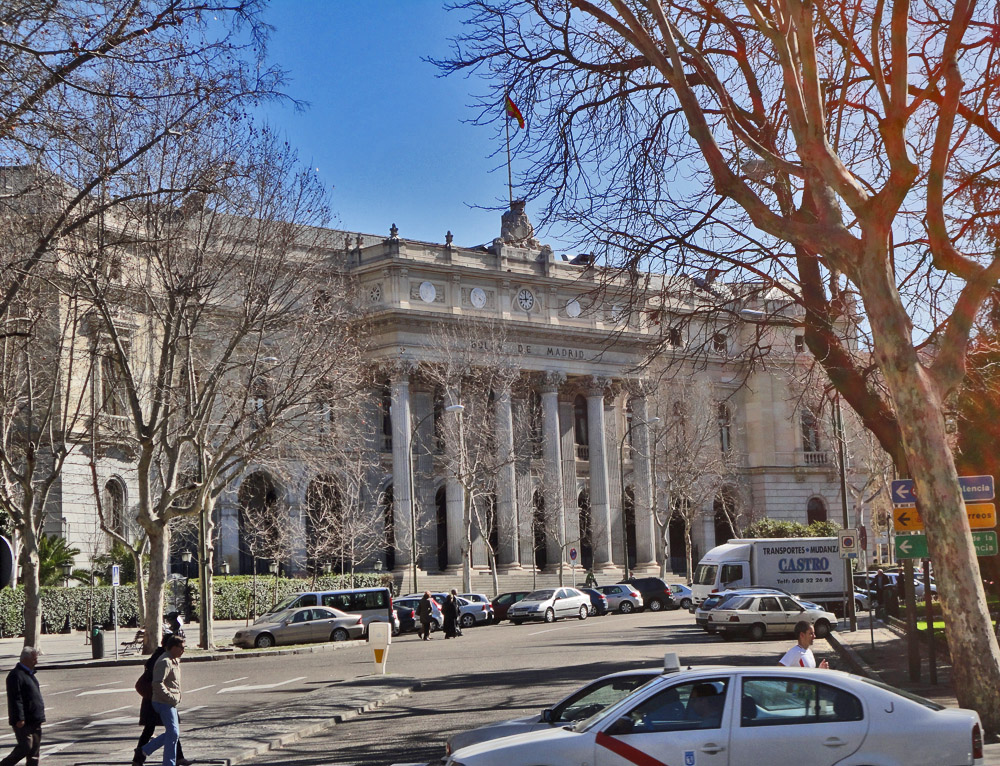
Bolsa de Madrid, Madrid Stock Exchange, at Plaza Lealtad. This classicist building is the largest and most international of Spain's 4 stock exchanges. It was founded in 1831.
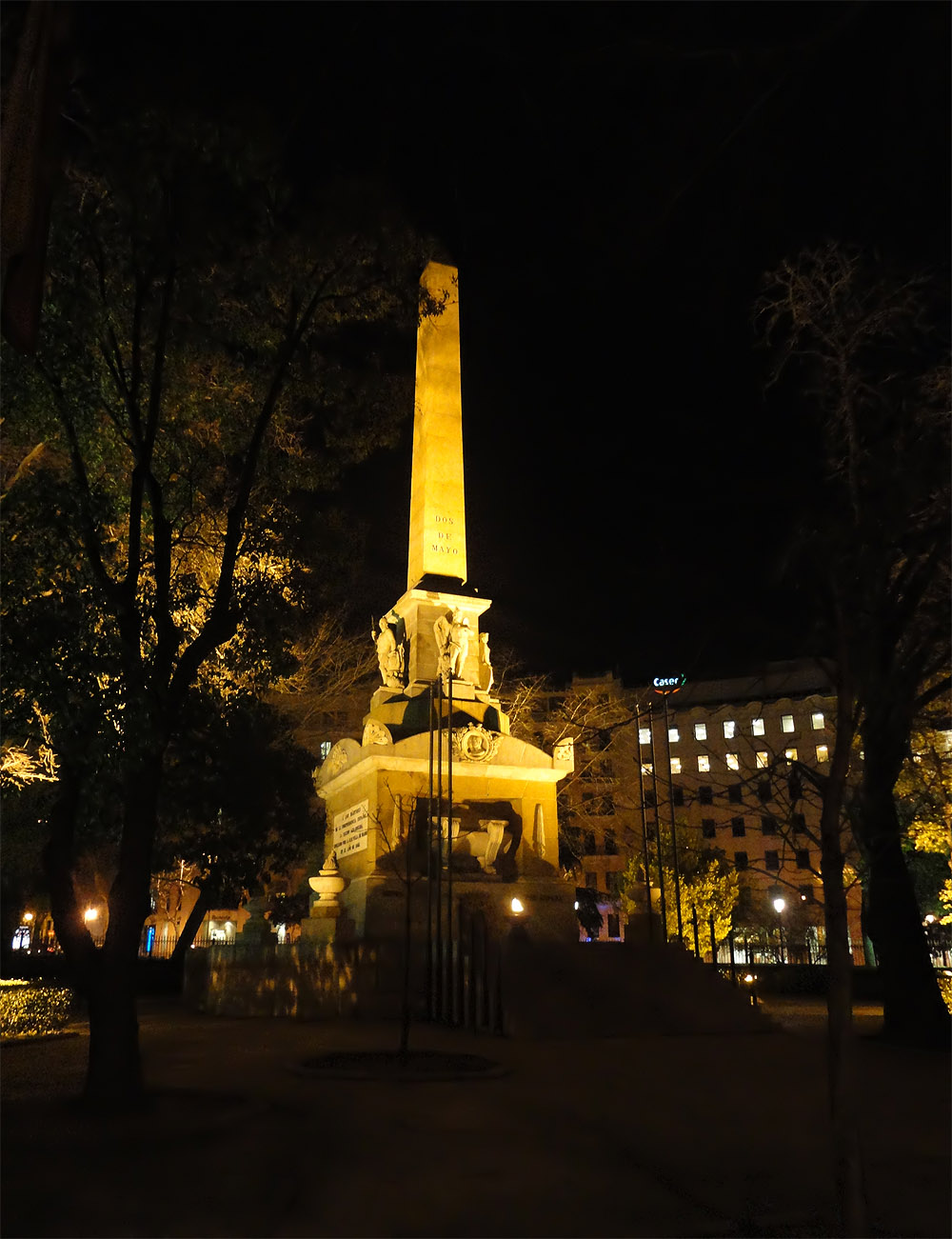
Mto. Dos De Mayo (Monument to the 2nd of May) honors the heroes that died in the revolt towards France in 1808. The remnants of the heroes are buried beneath the obelisque.
Paseo de Recoletos:
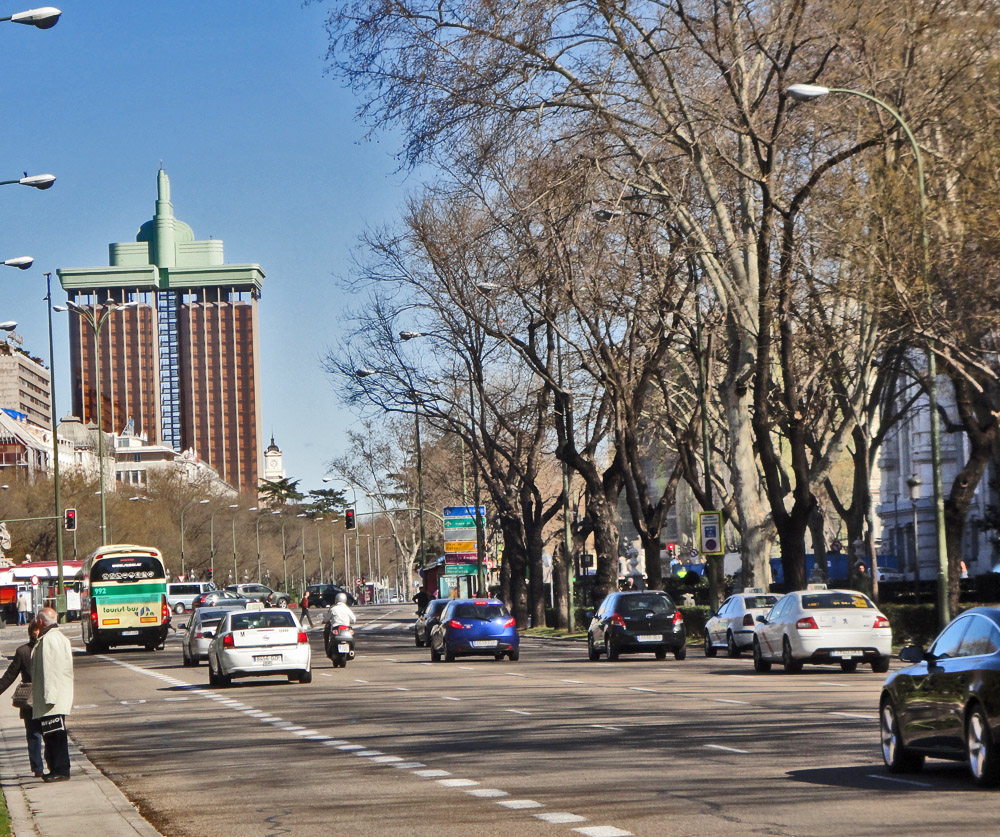
Here Paseo de Prado changes name to Paseo de Recoletos and goes North towards Plaza de Colón, seen in the distance.

Museo Thyssen-Bornemisza has art from the 1200s-1900s.

The Juan Valera monument.
[b]Museo del Prado
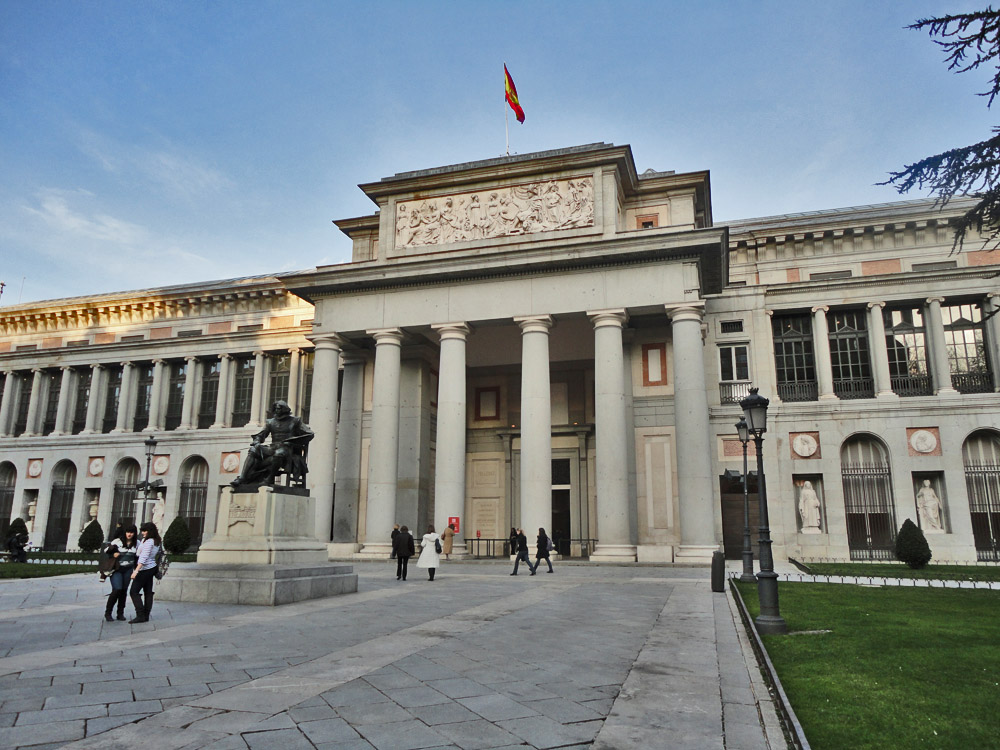
Prado is one of the world's most famous art museums and Madrid's most visited art museum. It is mostly famous for the royal collections and the many famous paintings by Goya, Velázquez and Rubens. Photographs are not allowed inside, so I don't have a single picture of the interior or any of the famous paintings. Really a shame and very disappointing!

The Velazquez statue in front of Museo del Prado. The earliest collections were added in the 16th -17th centuries.
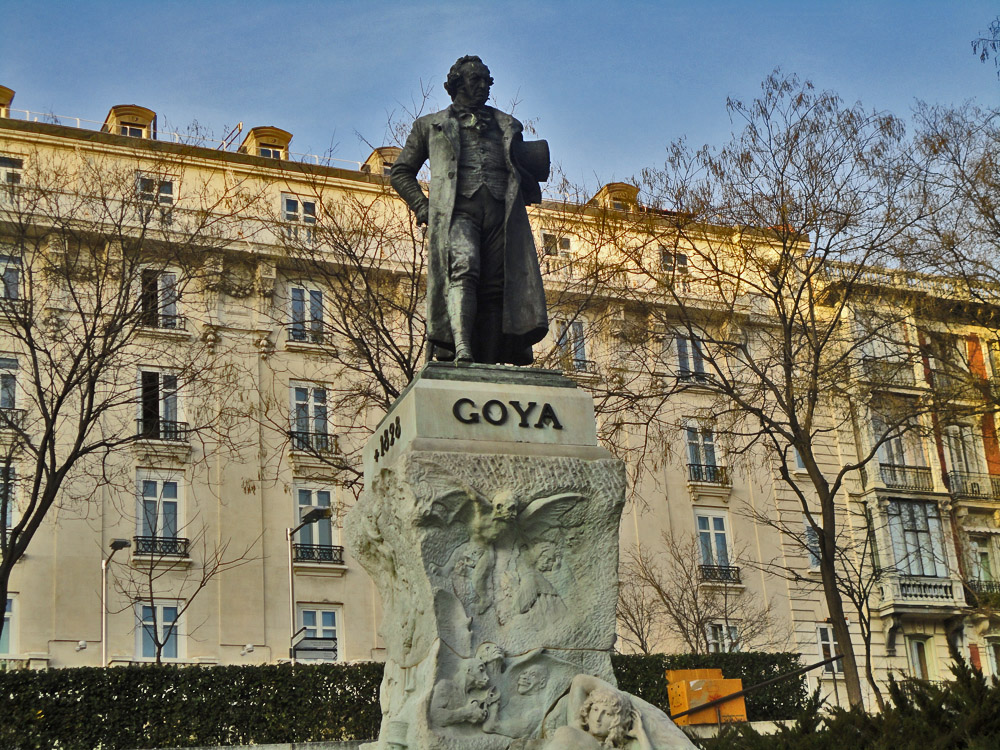
The Goya statue next to Prado. Goya is somewhat of a national symbol of Spain, and many of his most famous paintings are located inside Prado.
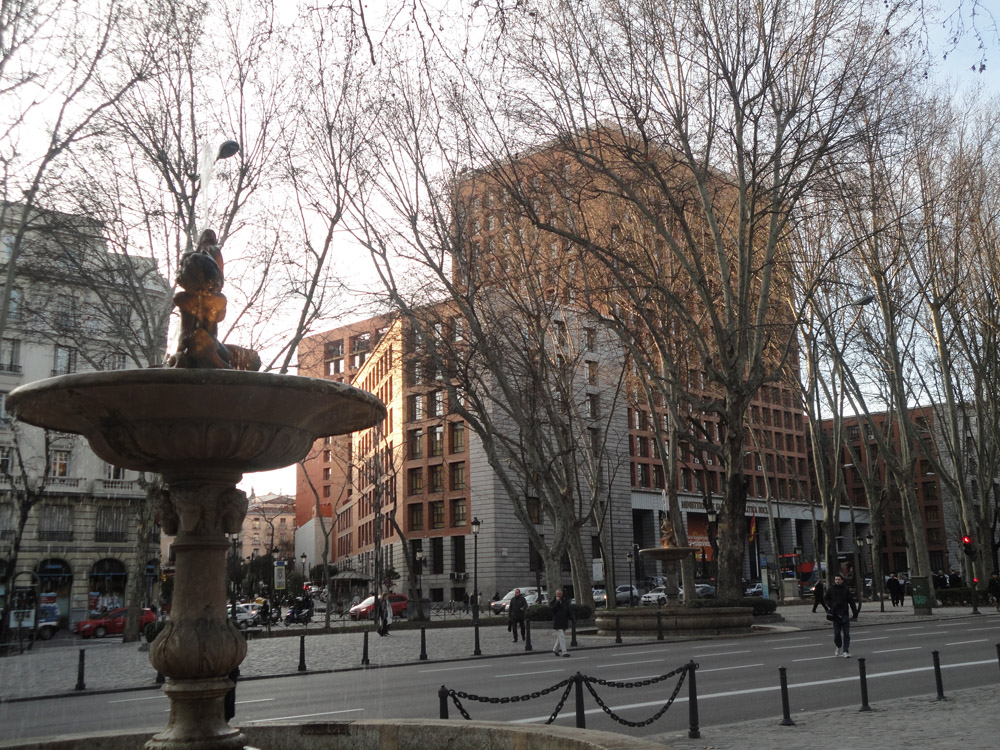
Paseo del Prado opposite the museum.
Night photos from these places will be posted in the end.
These pictures of Madrid will soon be added to my website, World Travel Images:
http://www.worldtravelimages.net/Madrid.html
Plaza de Castilla with Puerta de Europa
Plaza de Castilla is a modern square in Madrid's north outskirts. Puerta de Europa, or Torres Kio, are 2 iconic leaning twin towers, standing on each side of the plaza. They have a height of 114m and 26 floors. They were constructed from 1989 to 1996. The famous architects Philip Johnson and John Burgee designed them.
On the plaza you can also find Calatrava's brand new golden, moving, Obelisco de la Caja, erected in 2010, the José Calvo Sotelo marble monument from 1960 and Cuatro Torres, Madrid's 4 tallest skyscrapers can be see further away to the North. The road that goes right through the towers, towards Cuatro Torres, is the busy and long road Paseo de la Castellana.
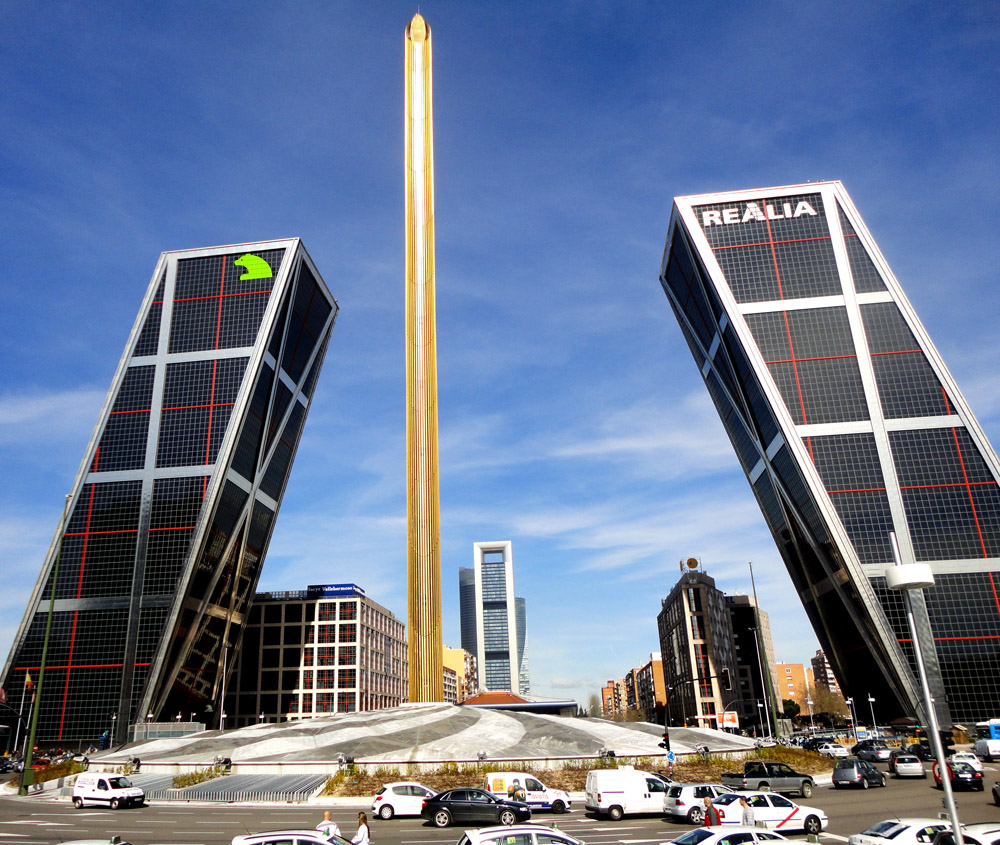
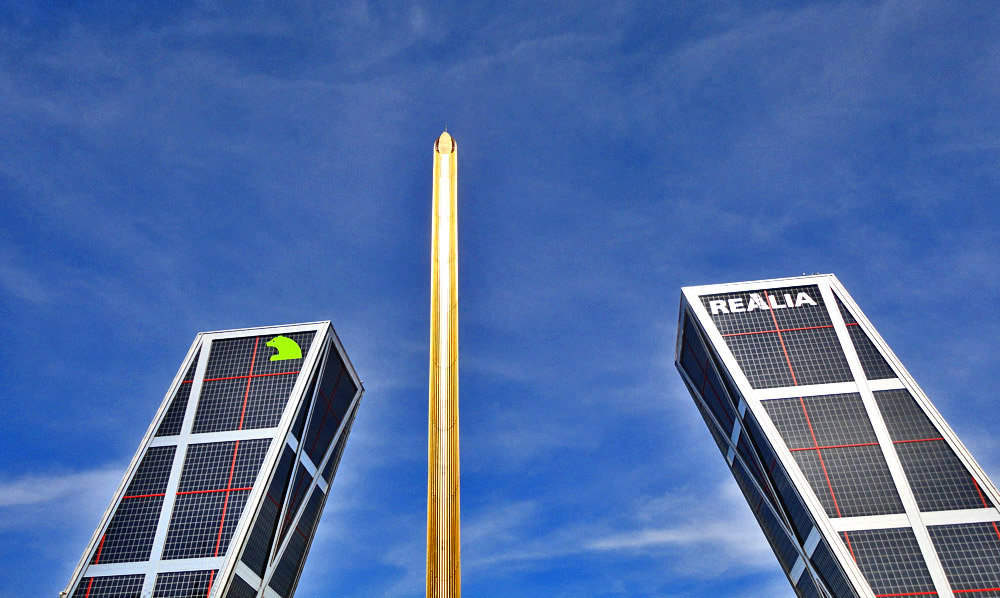
The 114m tall Torres Kio and Calatrava's Caja Madrid Obelisk, erected to mark the 300th anniversary of Madrid.
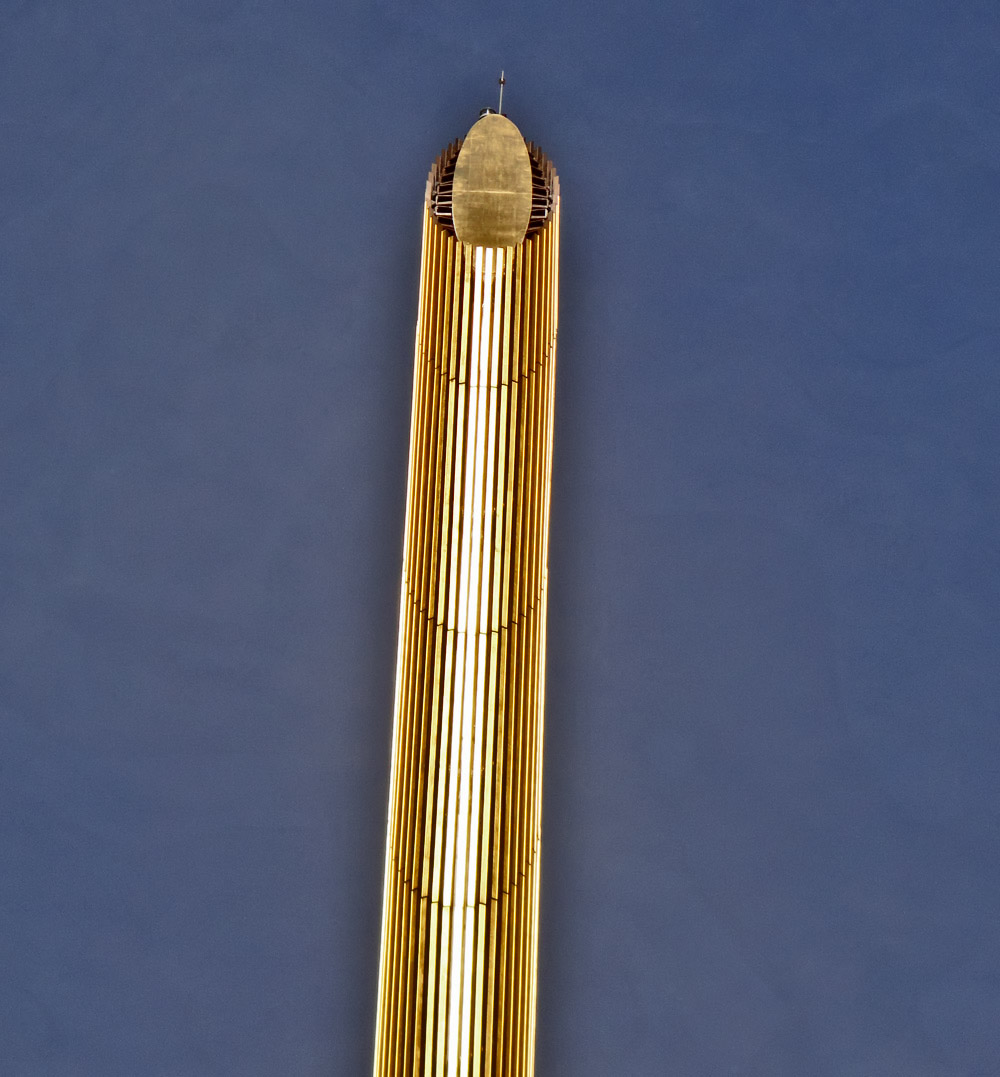
Obelisco de Caja by Santiago Calatrava is sometimes changing shape, something it didn't do during our visit, unfortunately. It was erected as late as in late 2010, so it
was really brand new when this picture was taken. It is 97 m high, originally planned to be 120m, but that was rejected because of underground tunnels.
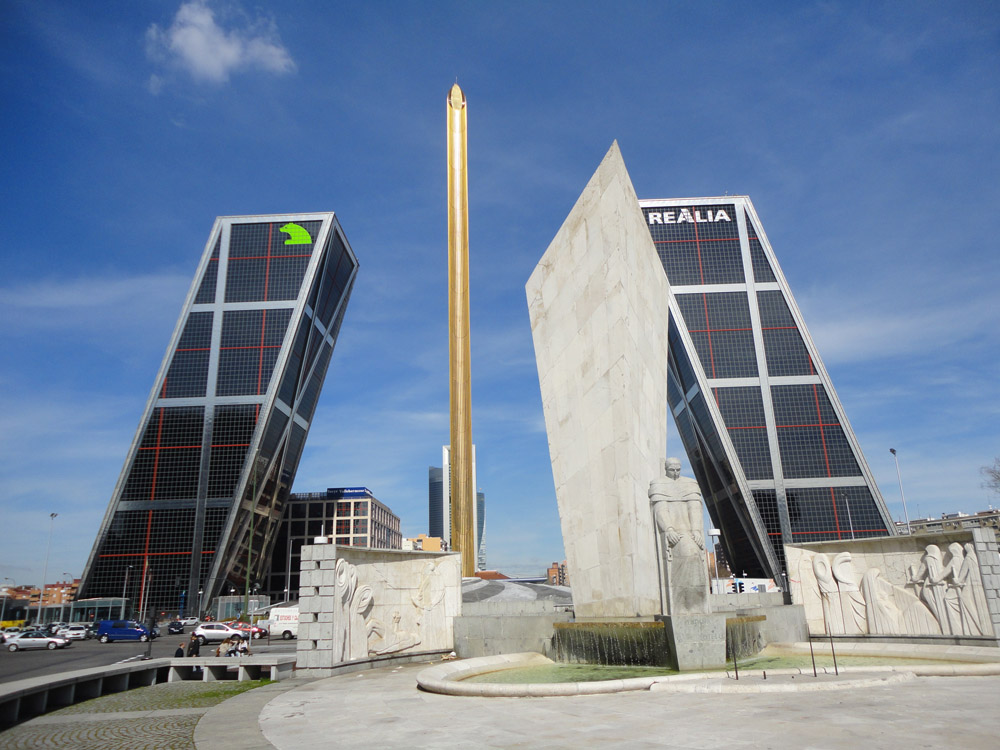
Torres Kio (Puerta de Europa), the new Obelisco de Caja and the José Calvo Sotelo Monument.
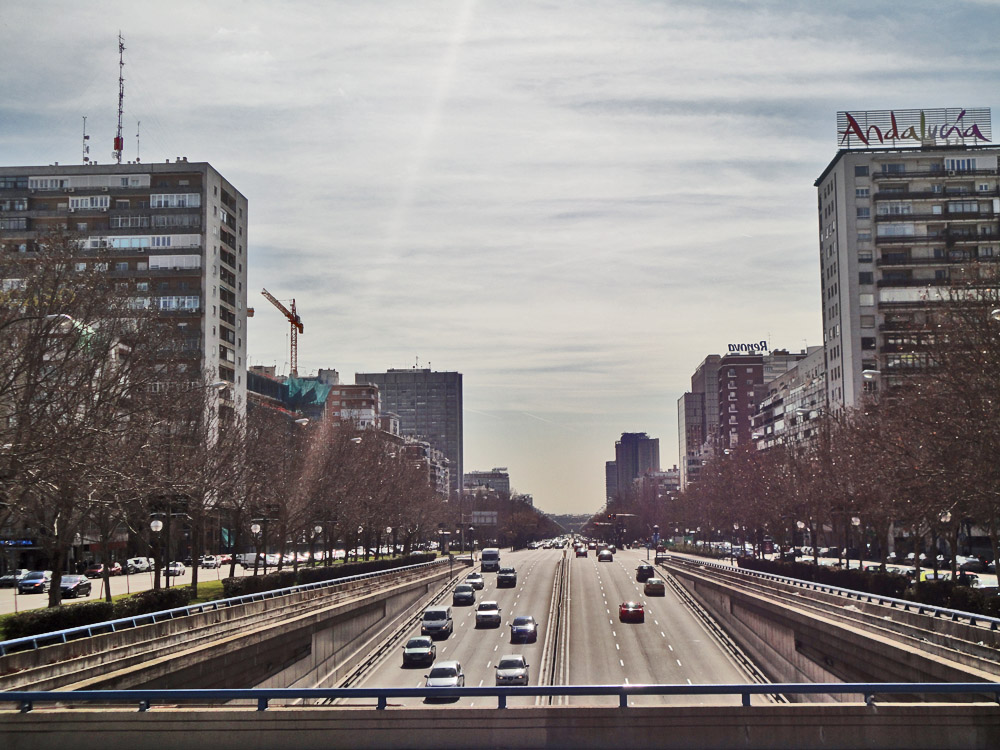

Paseo de la Castellano passing under Plaza de Castilla. You can see Torre Europa and other skyscrapers of the AZCA district to the right.
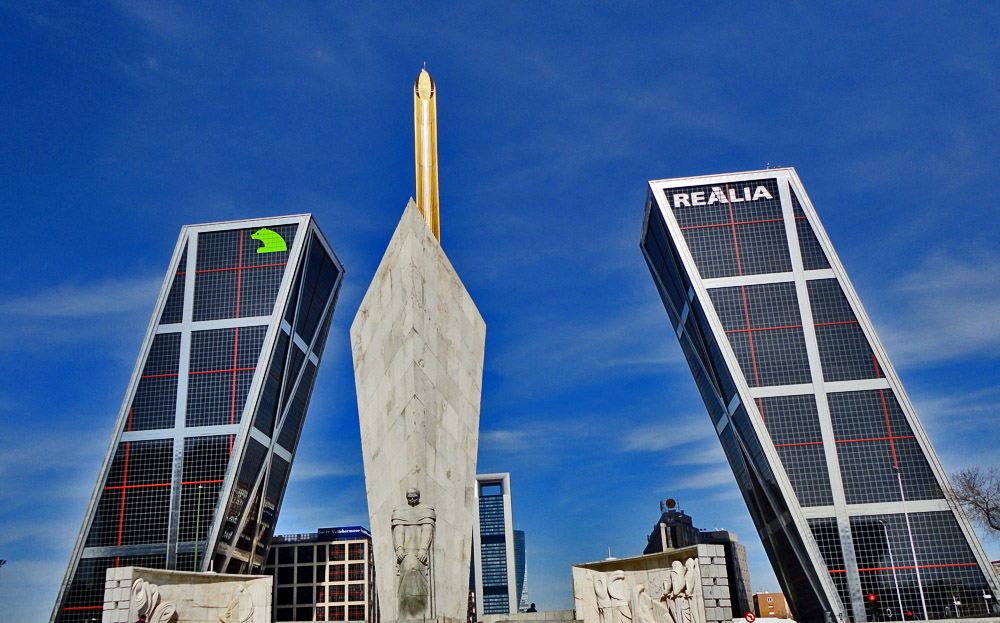
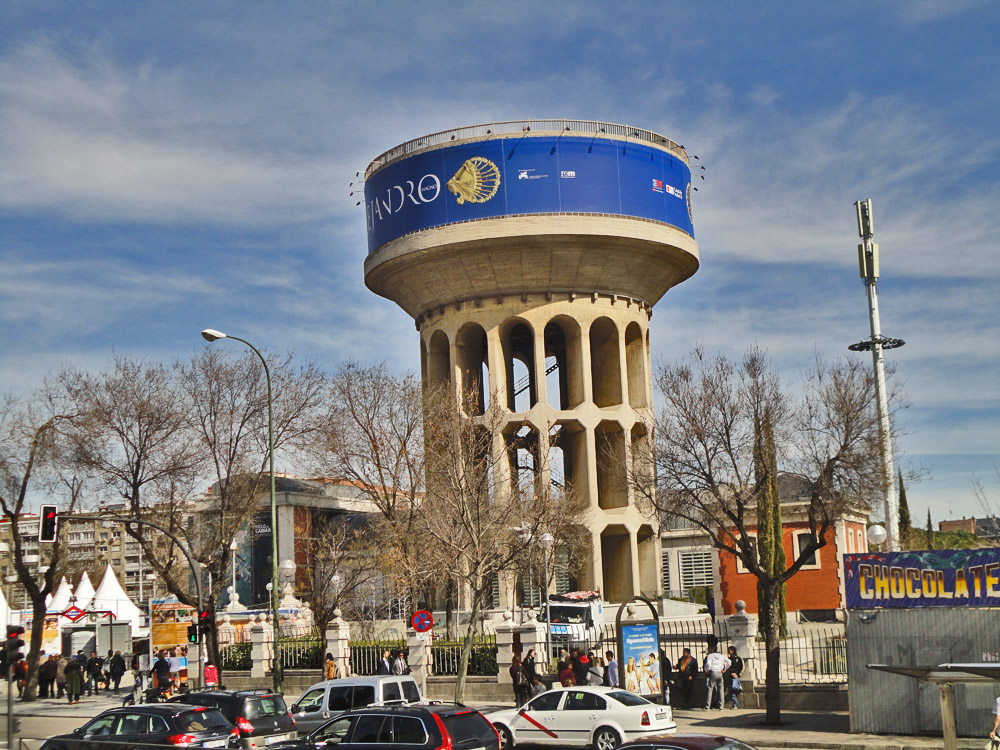
A water tower (anyone know the name?). There are several kiosks and taxi stands around the square. The area around the plaza is a bit dull.
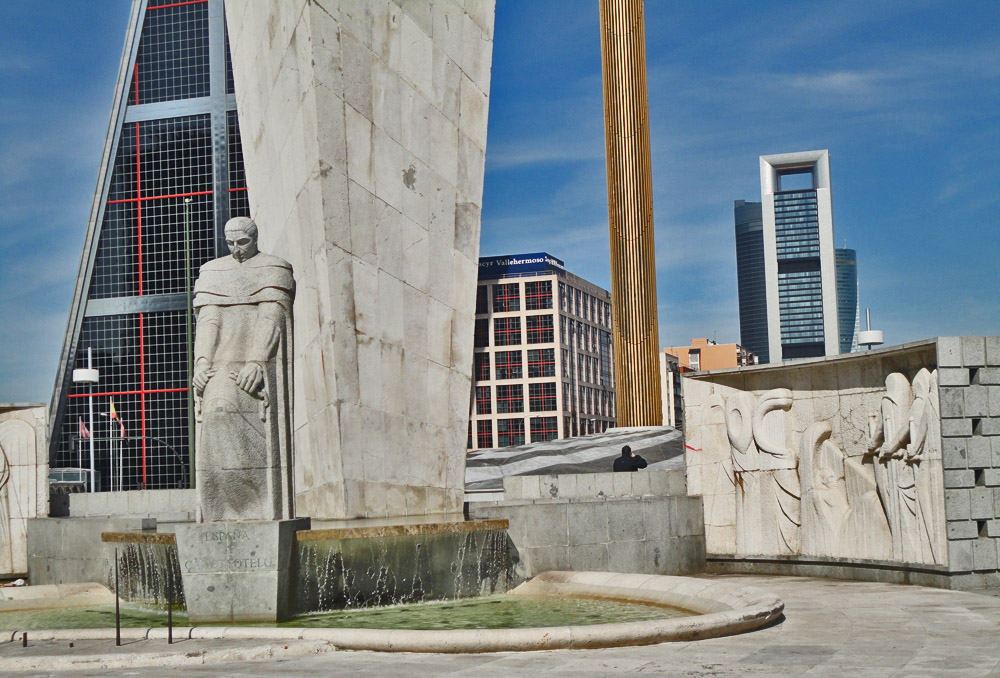
José Calvo Sotelo was a president that was murdered in 1936.
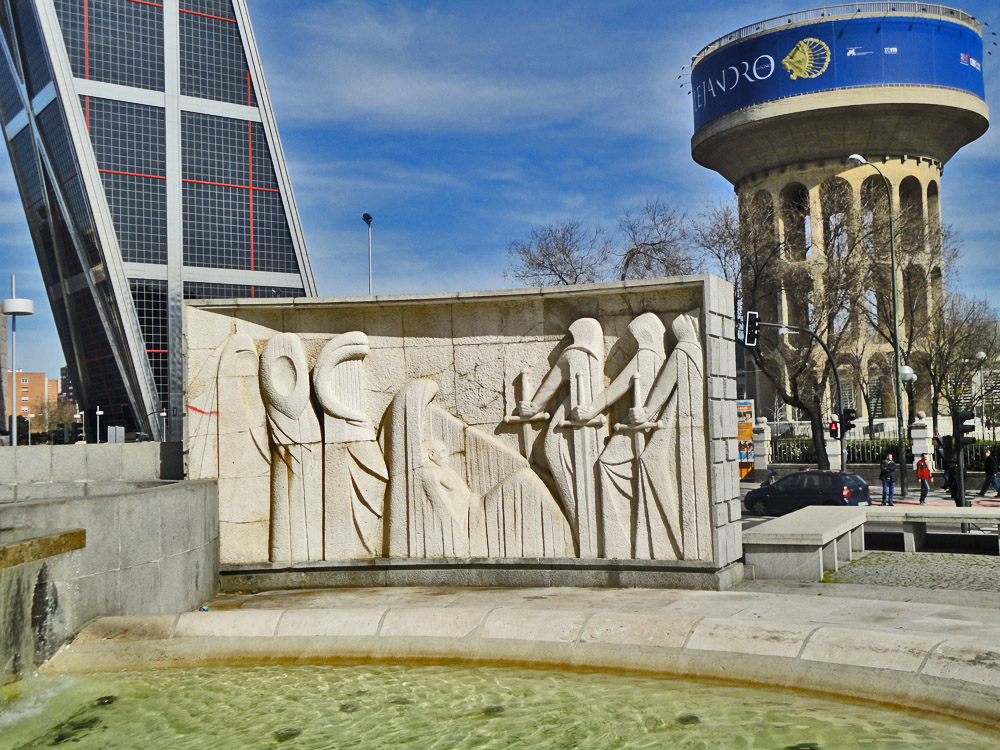
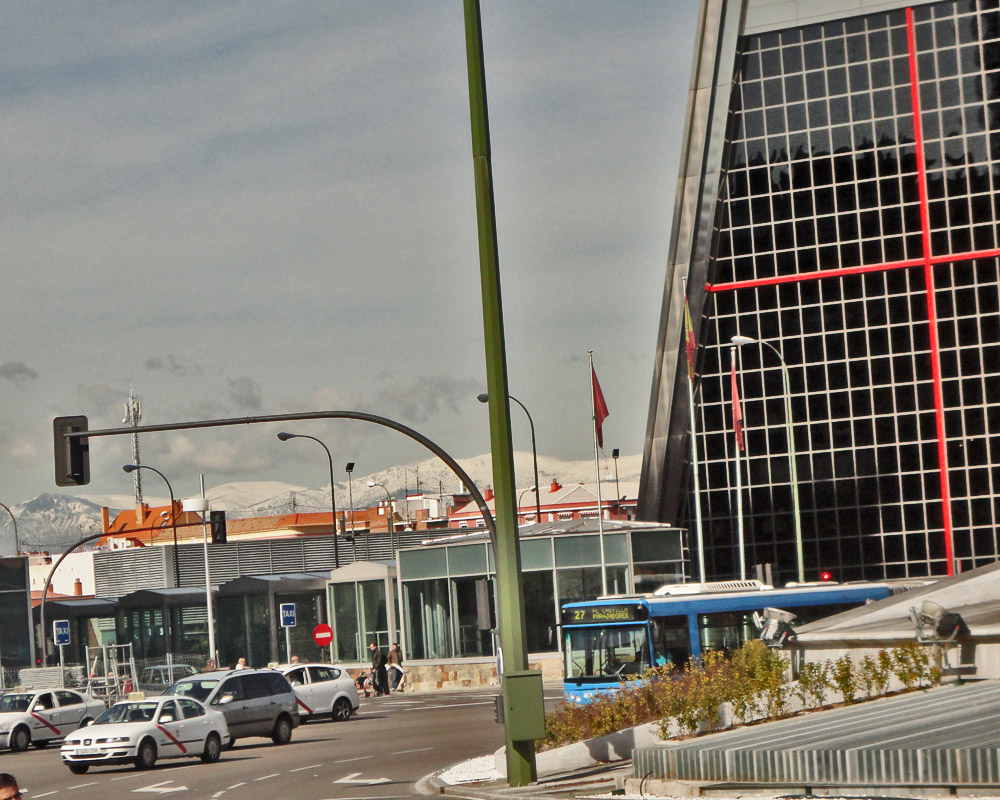
There are snow on the mountains d, but about 20 degree and sunny in Madrid.
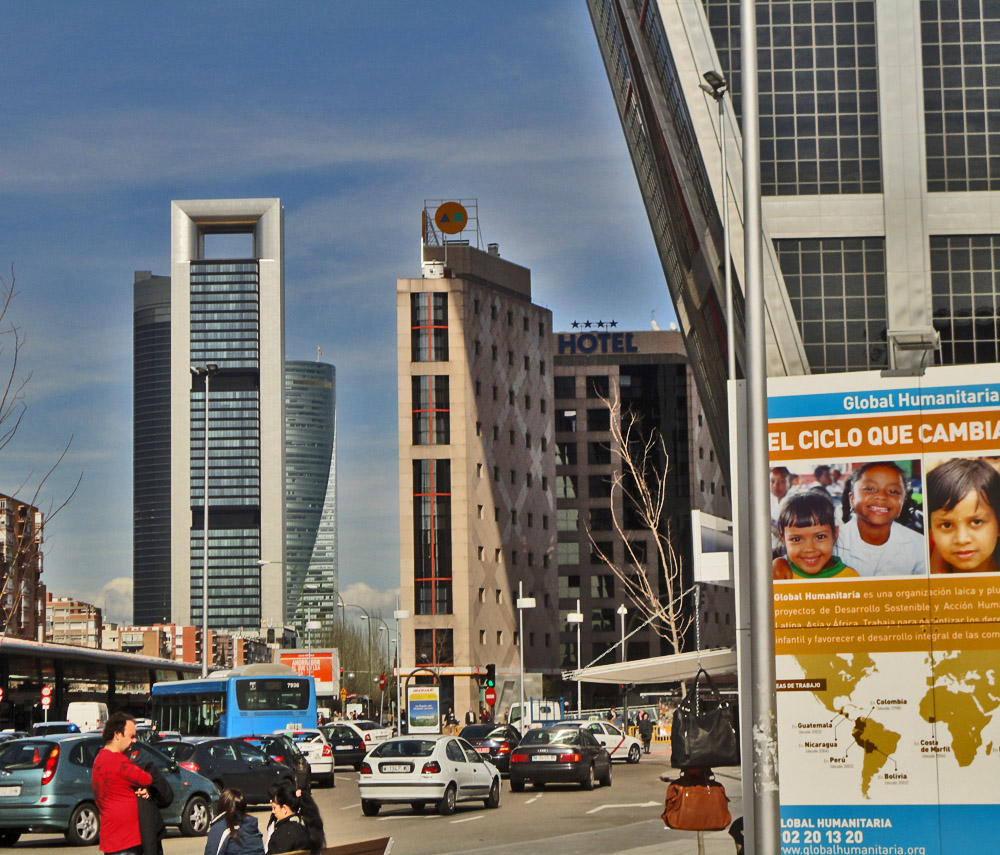
Hotel Castilla Plaza (in the middle) has an exterior that resembles Torres Kio. To the left: Cuatro Torres, the 4 tallest skyscrapers of Madrid.
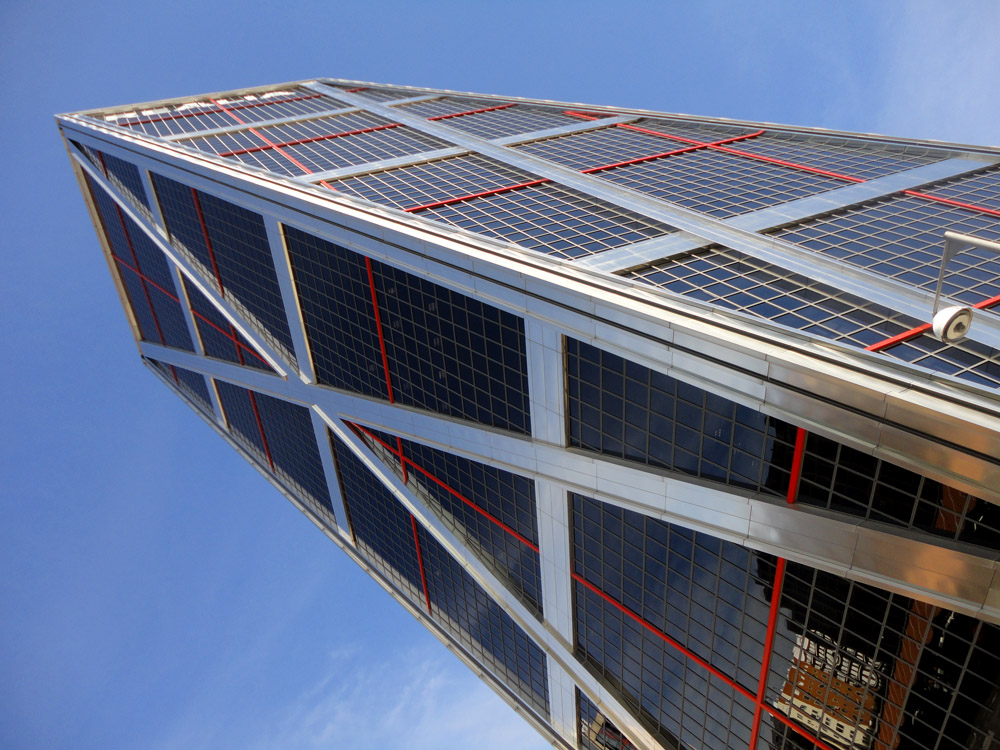
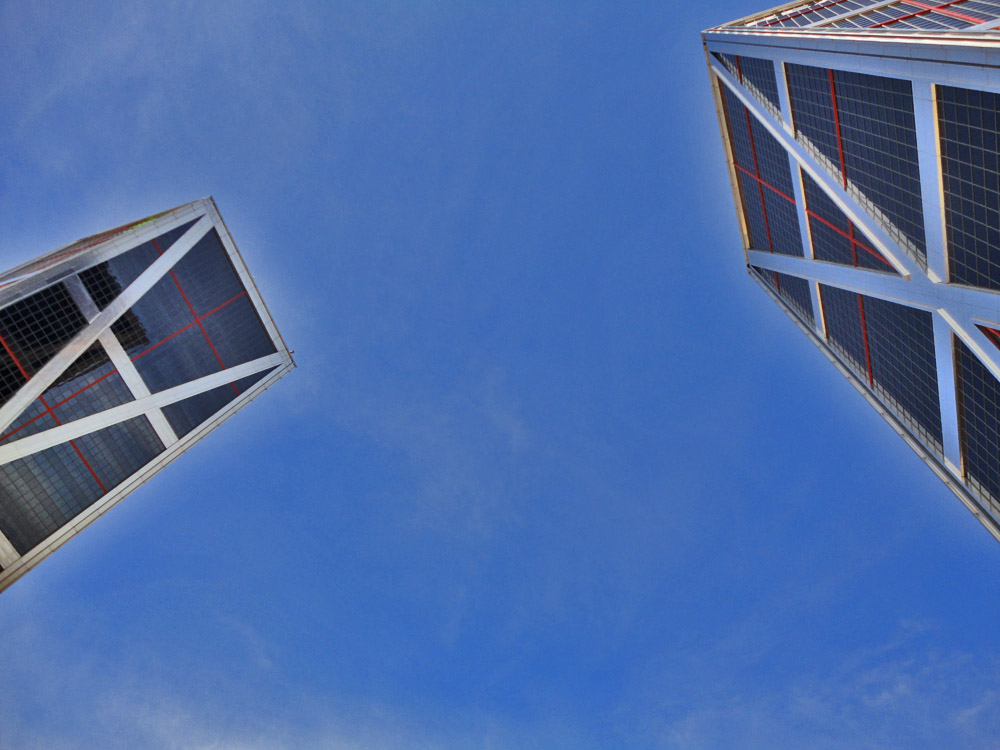
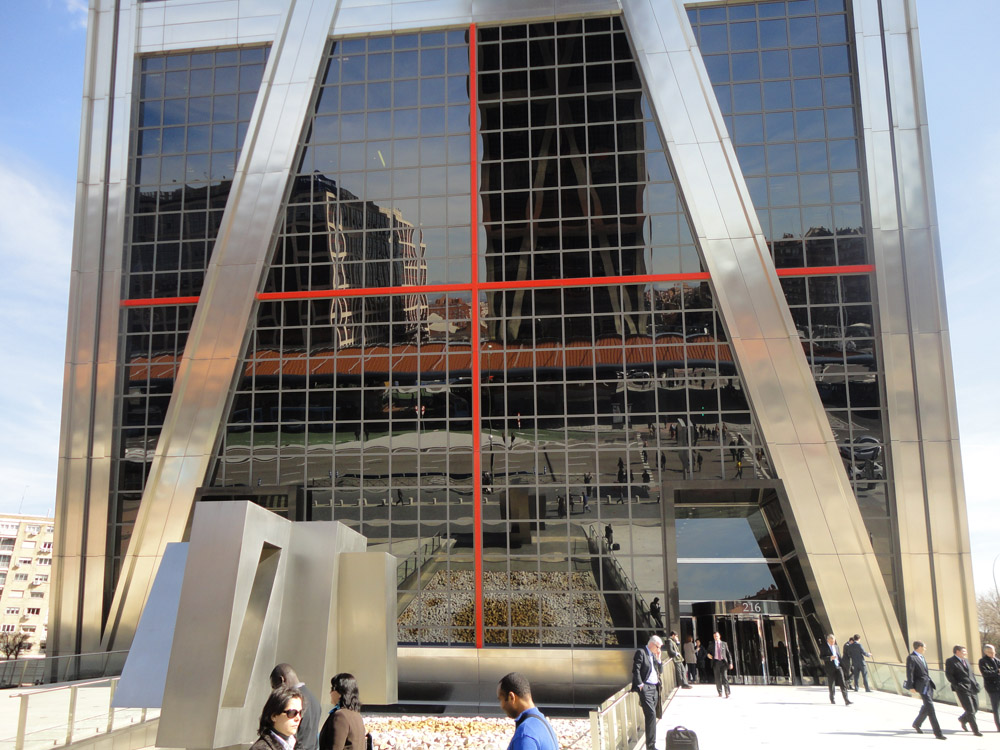
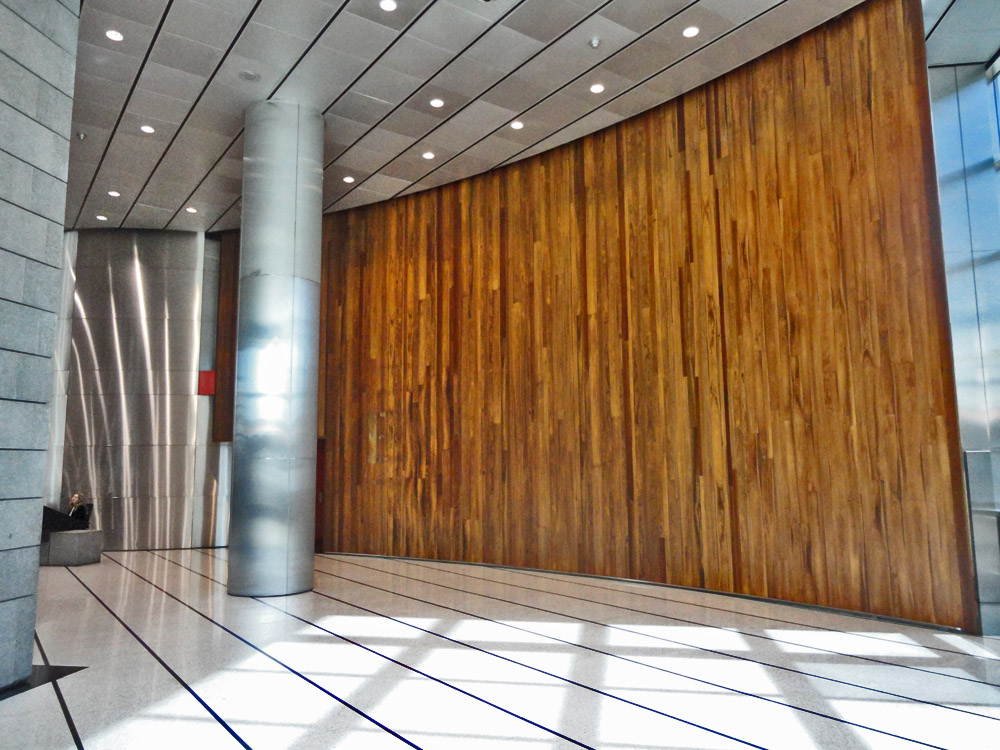
The lobby of one of the Kio Torres. We asked the lady in the reception if it was possible to get up and see some views, but it wasn't possible.
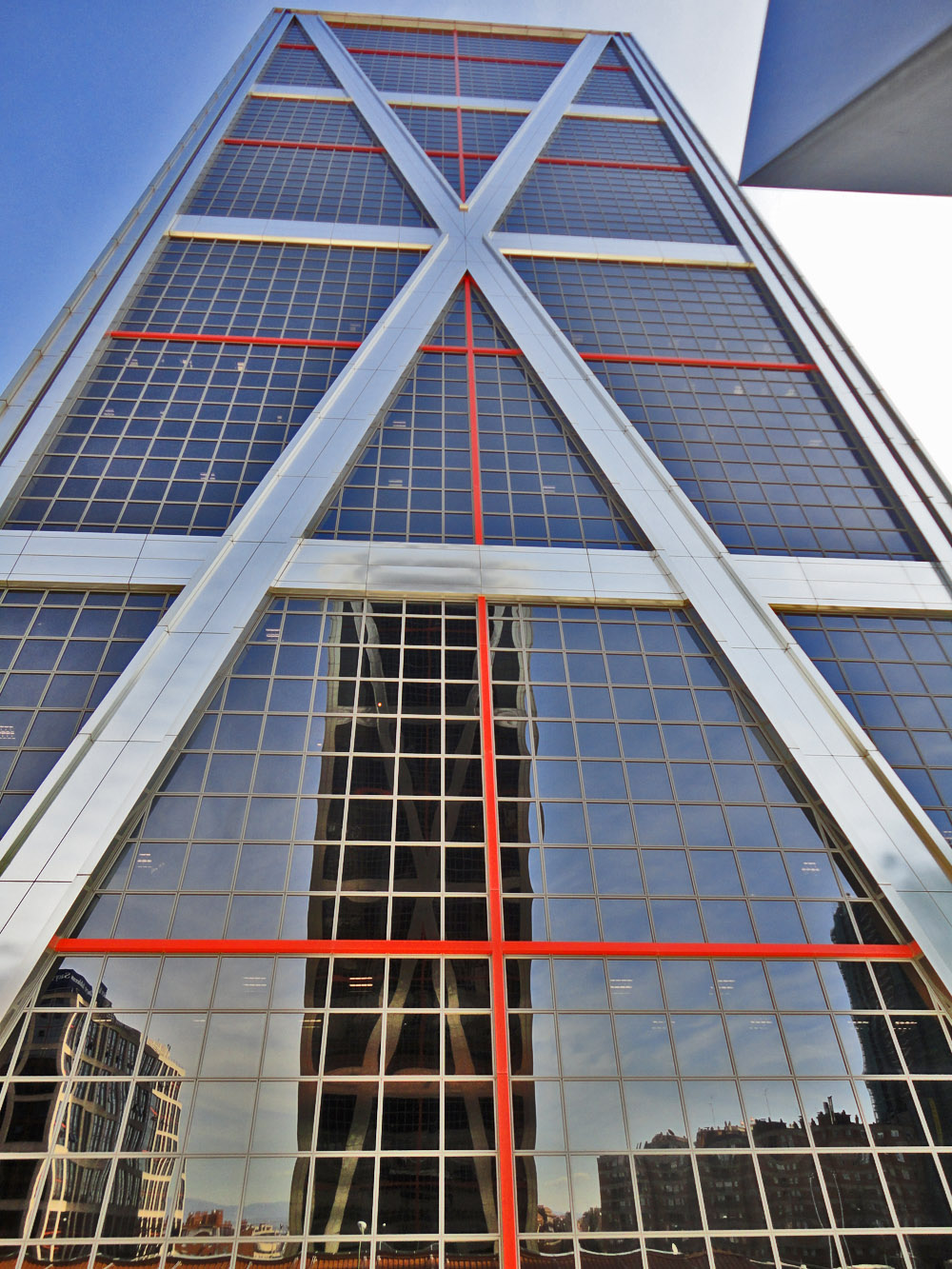
Kio Towers could be dubbed "The Leaning Towers of Madrid".
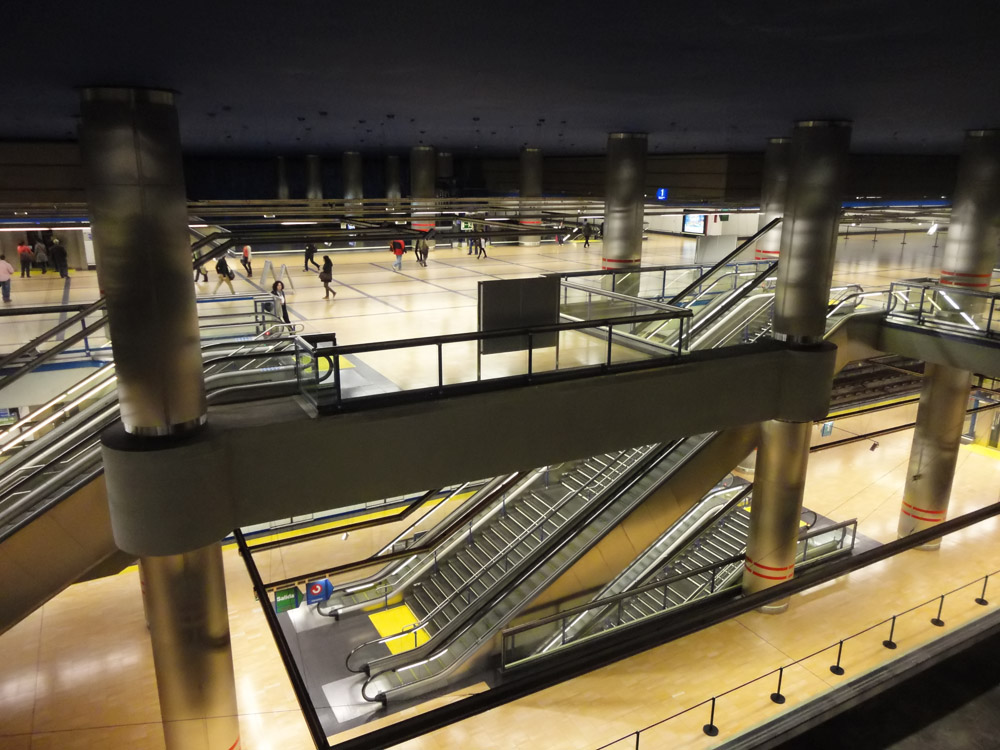
Chamartín is a train station close to Plaza de Castilla and Cuatro Torres. The metro of Chamartín is very futuristic.
Cuatro Torres Business Area
Cuatro Torres, 4 Towers, is a new business area that consist of the the 4 tallest, newest and most striking skyscrapers in Spain. The skyscrapers were completed in 2008. The tallest one, Torre Caja Madrid, is 250m tall and the tallest building in Spain. Eurostars Madrid Tower is the tallest hotel in Europe. The district is located in the North end of the city, just next to Paseo de la Castellana, a road that passes by all of Madrid's modern skyscrapers.
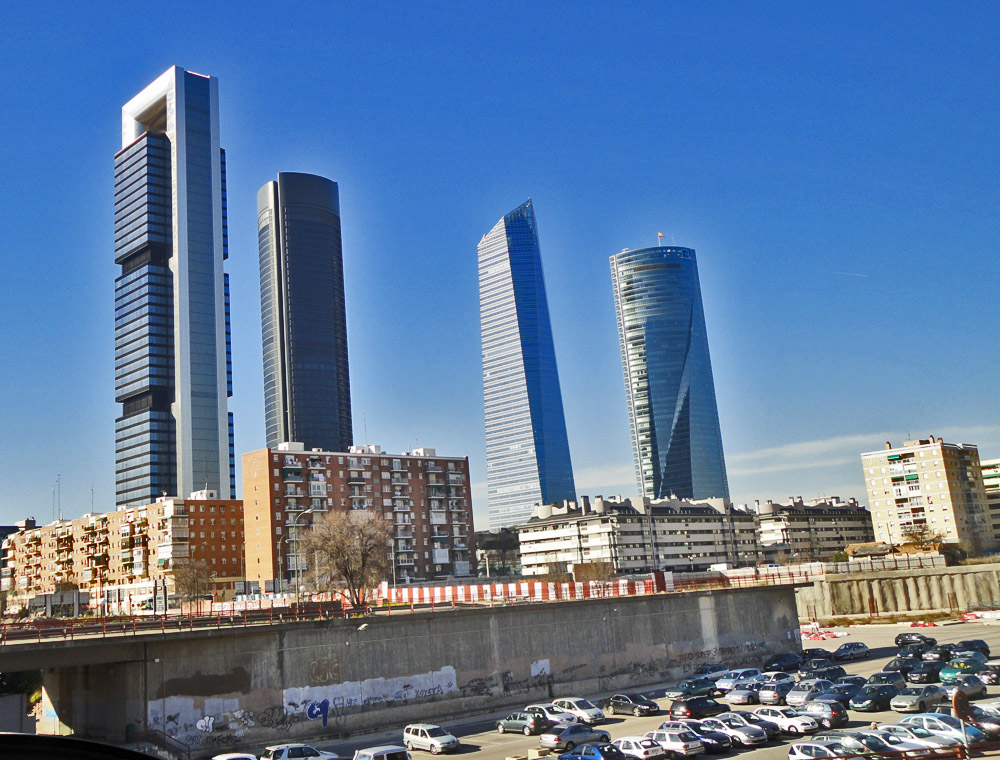
Cuatro Torres from the left: Torre Caja Madrid, Eurostars Madrid Tower, Torre Cristal and Torre Espacio. This photo is taken from just outside Chamartín Station.
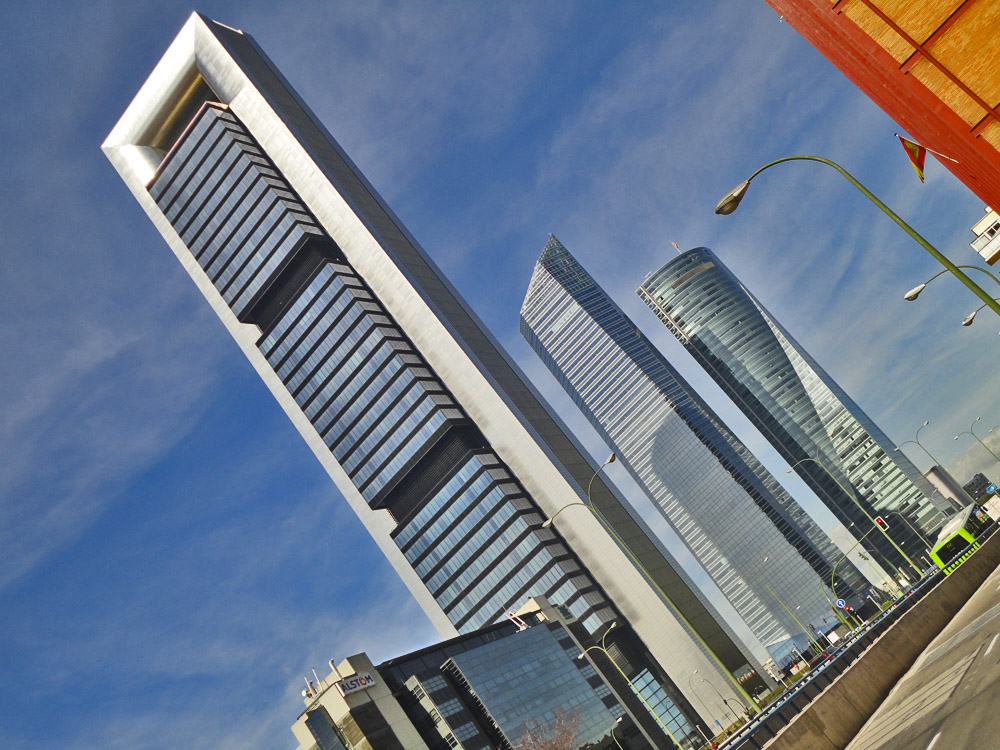
Torre Caja Madrid, originally Torre Repsol, is the tallest building in Spain since 2008.
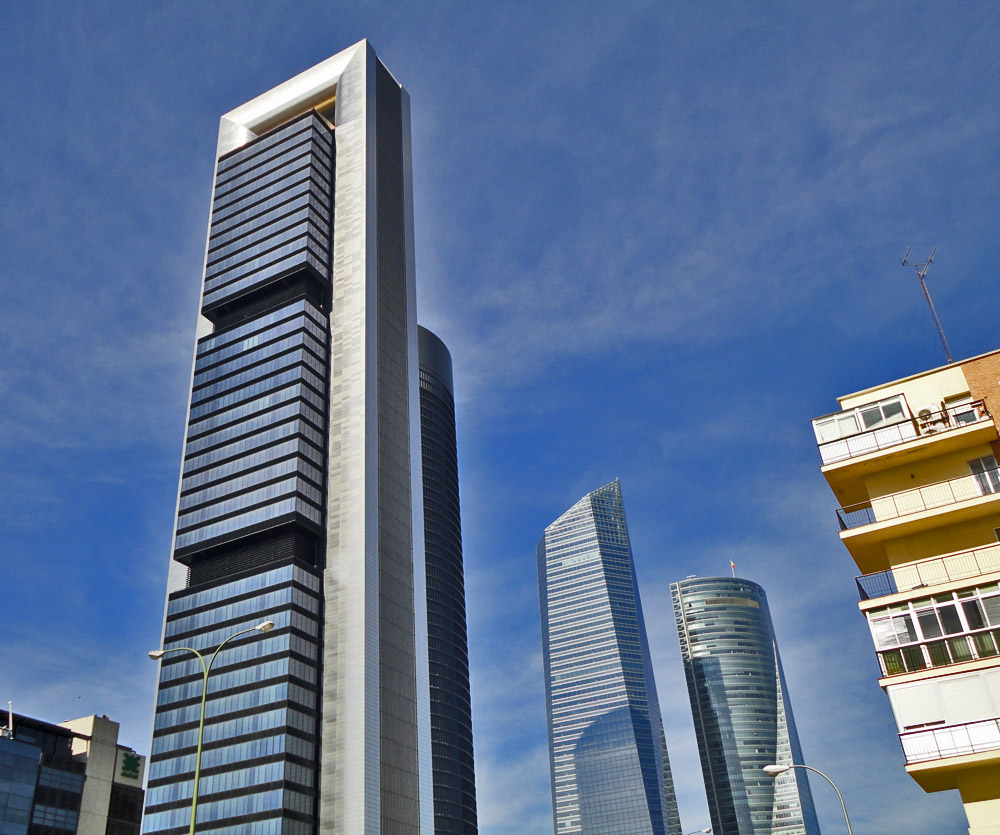
Torre Caja Madrid is 250m tall and have 45 floors filled with offices. It was designed by Norman Foster. It is the headquarters of Caja Madrid, the largest bank in Madrid.

The top of Torre Caja Madrid, Spain's tallest building. With a height of 250m it is just 89 cm taller then Torre de Cristal.
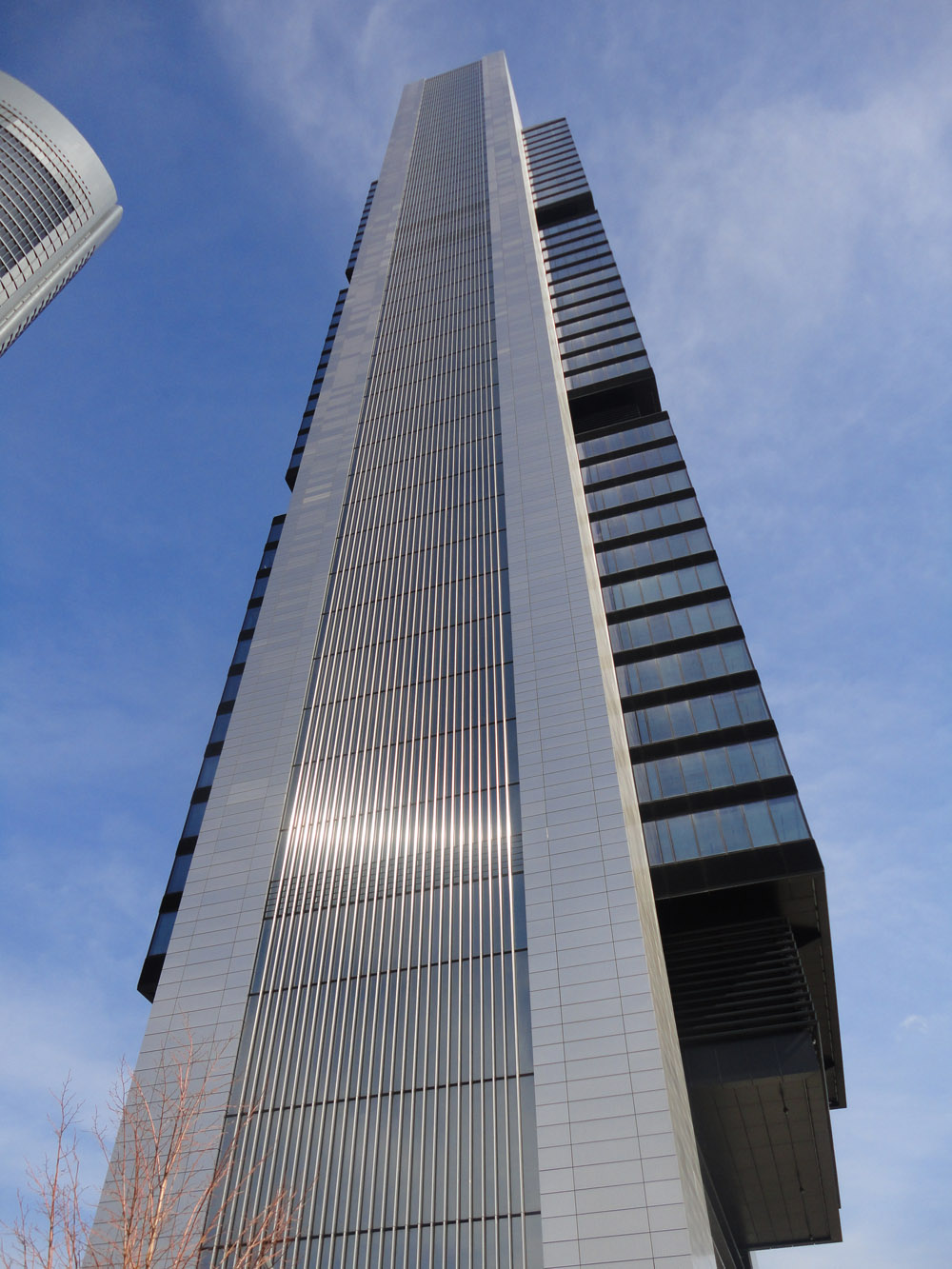
The side of Torre Caja Madrid.
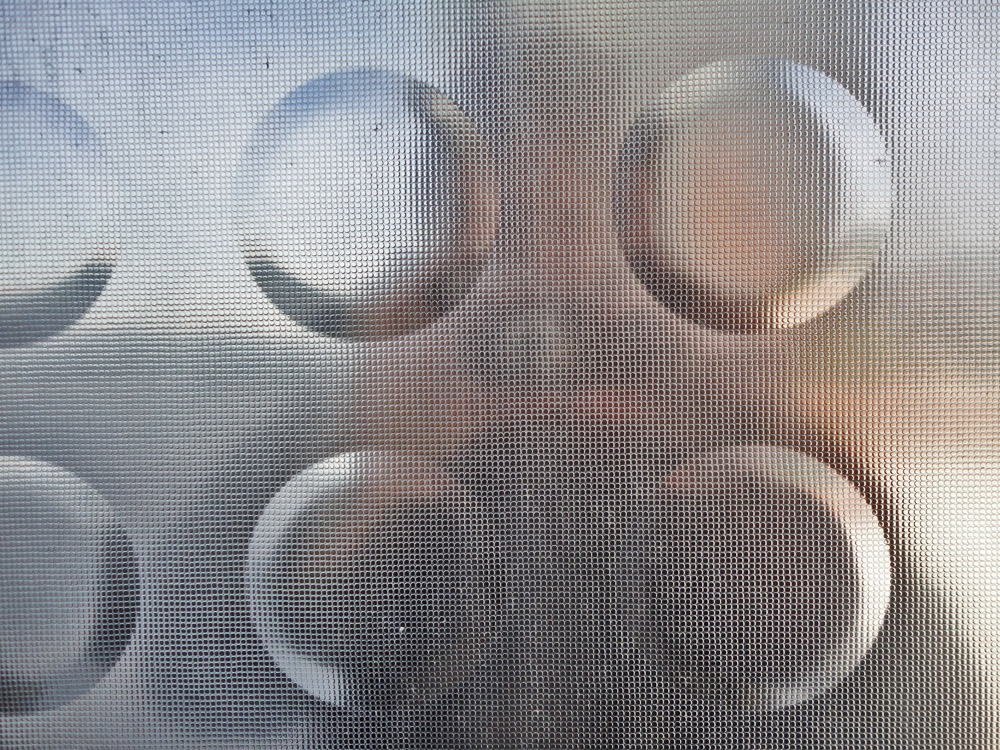
Details of Torre Caja Madrid's aluminium facade.
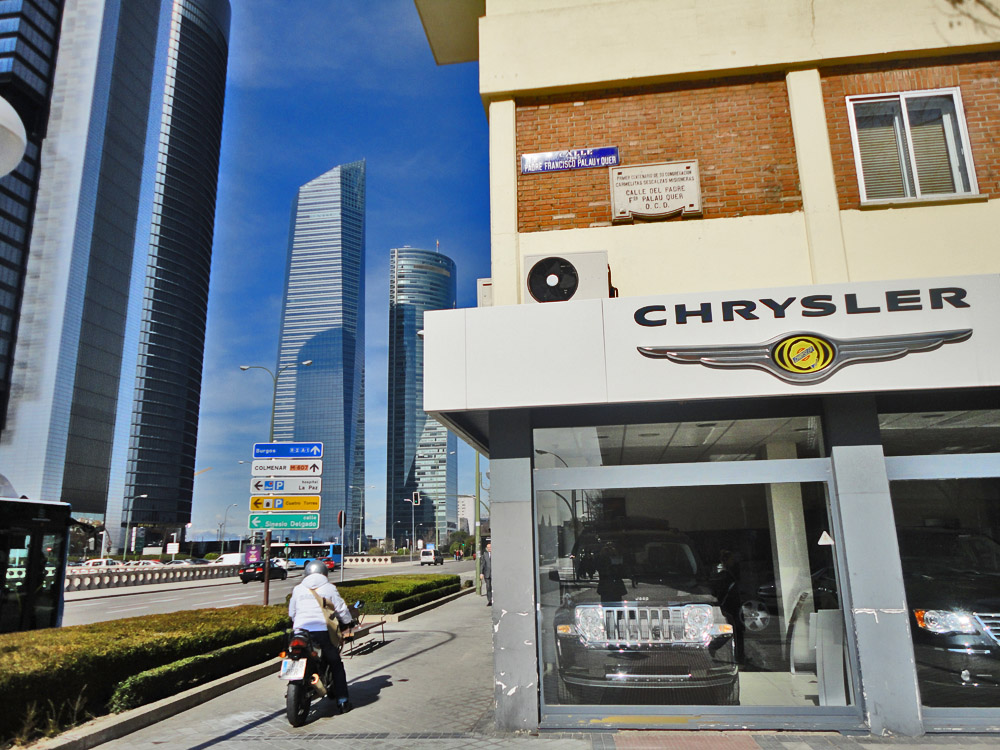
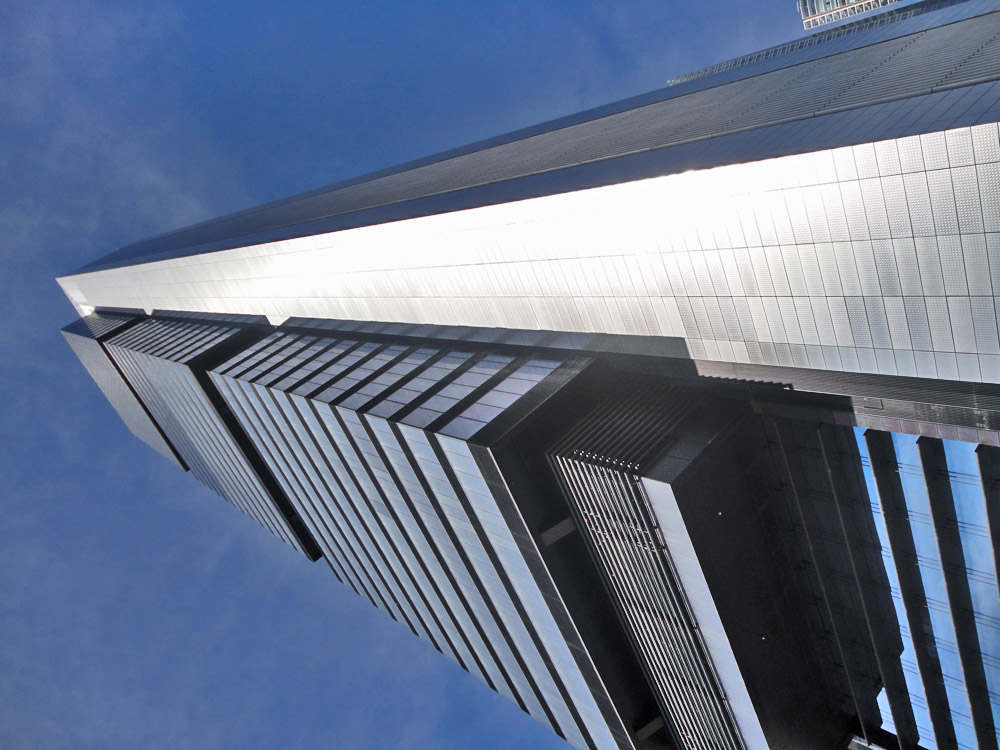
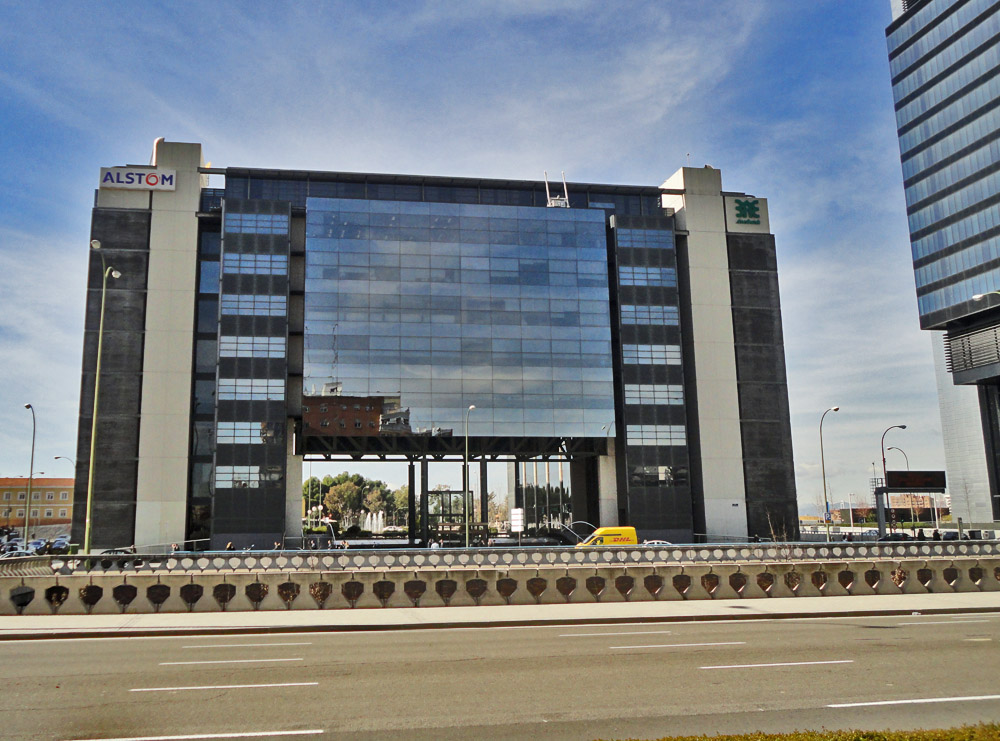
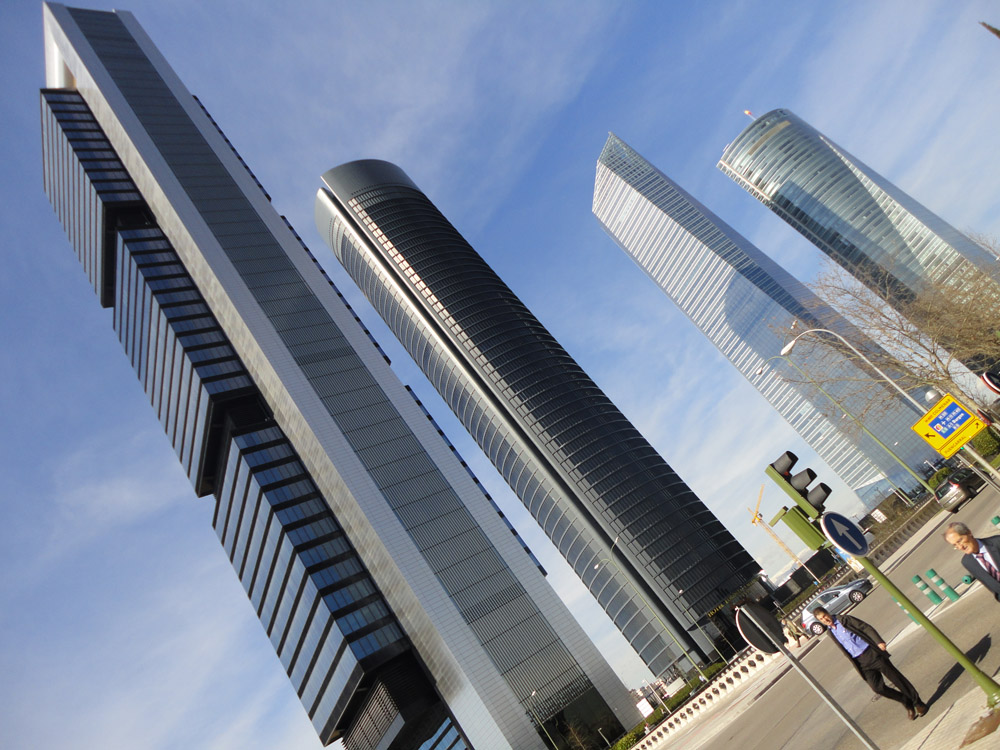

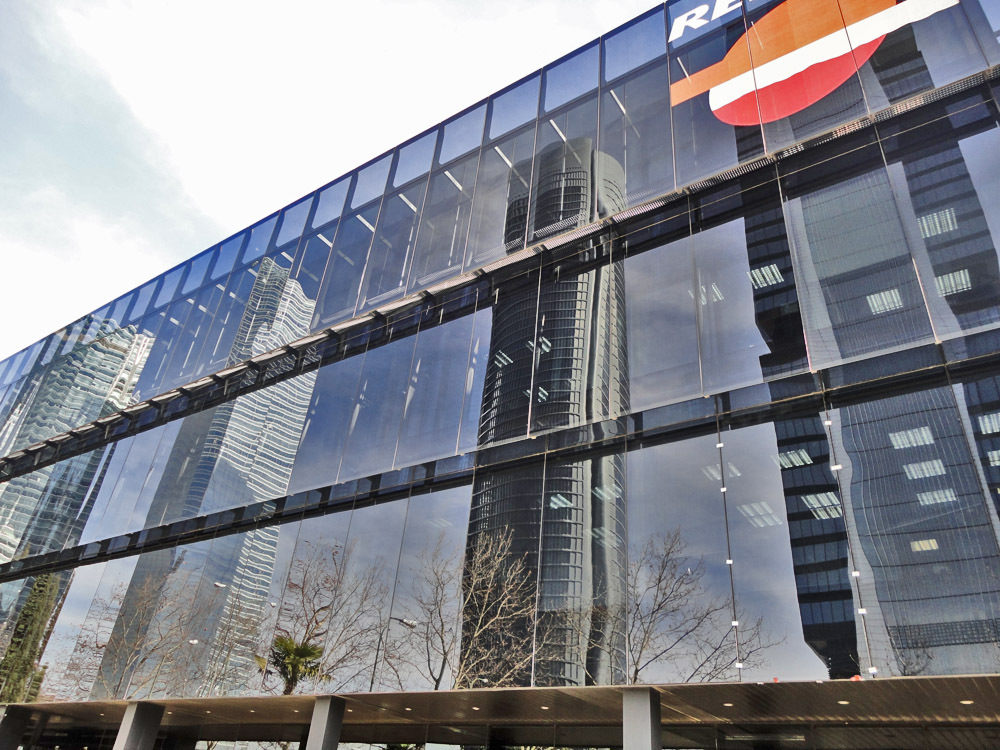

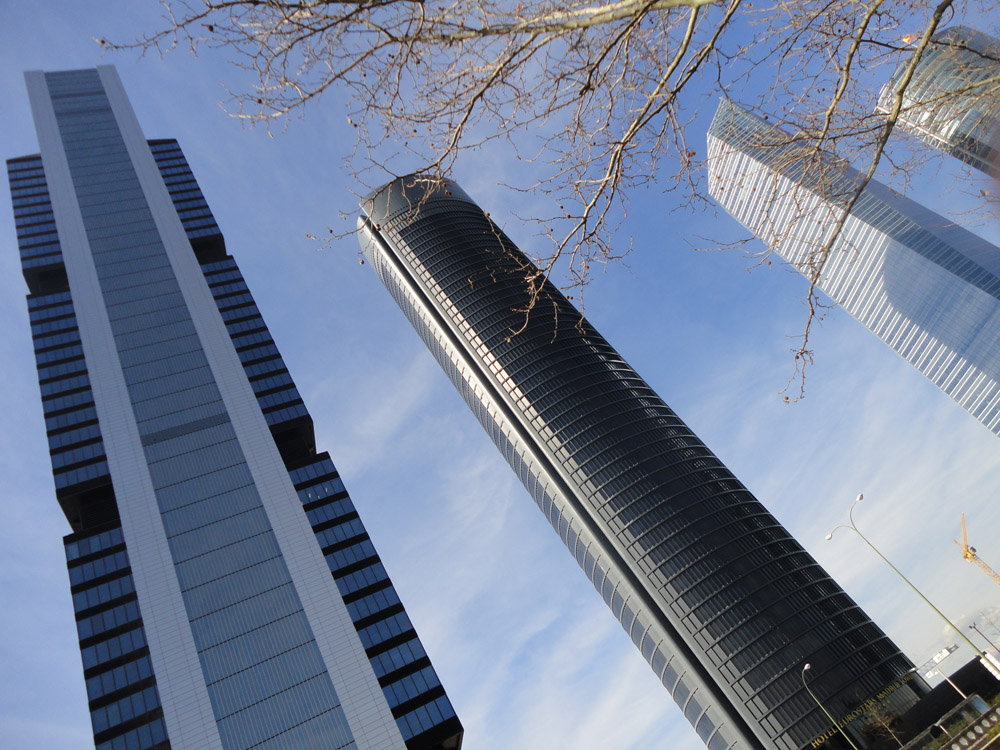
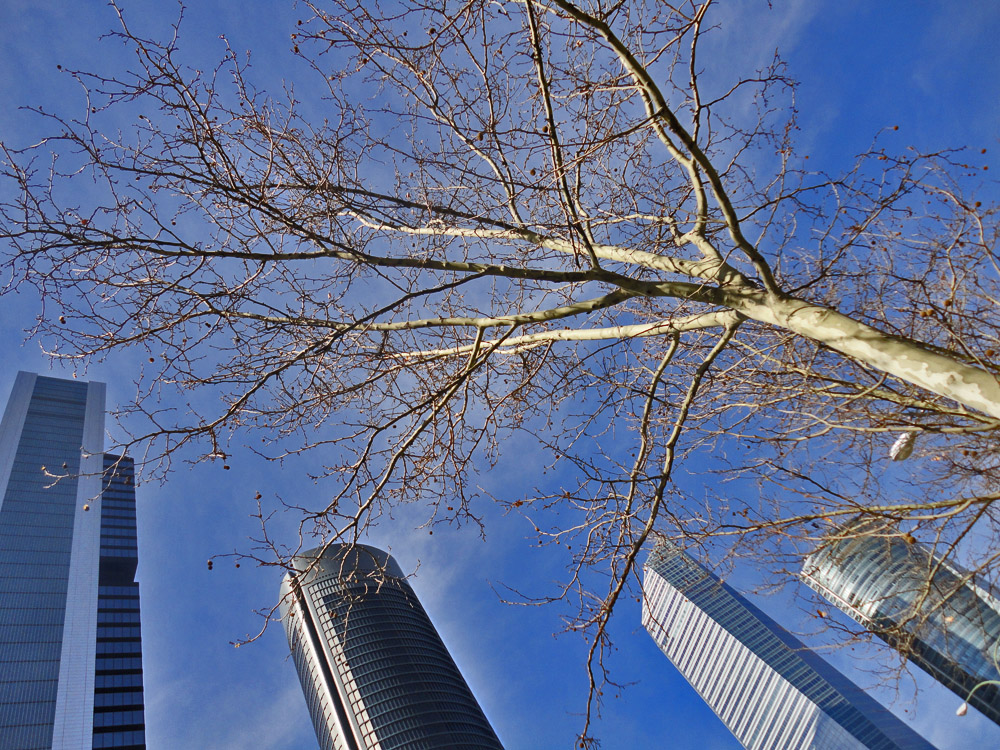

Paseo de la Castellana towards Puerta de Europa and Caja Madrid Obelisc at Plaza de Castilla, and Torre Picasso in AZCA district further beyond, seen from Cuatro Torres.
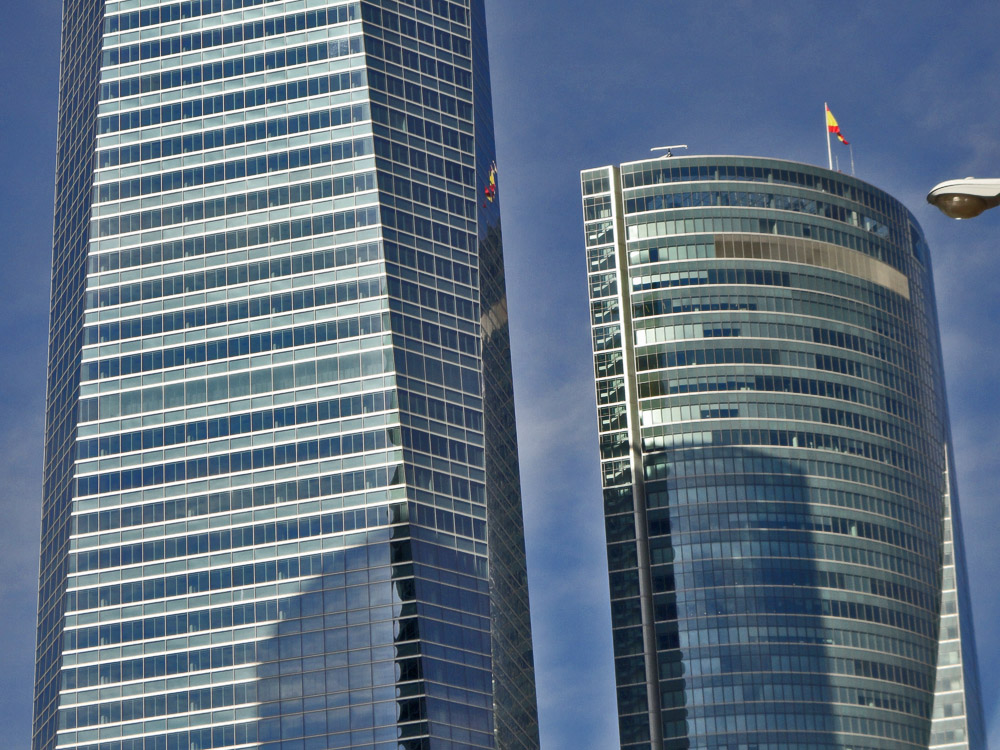
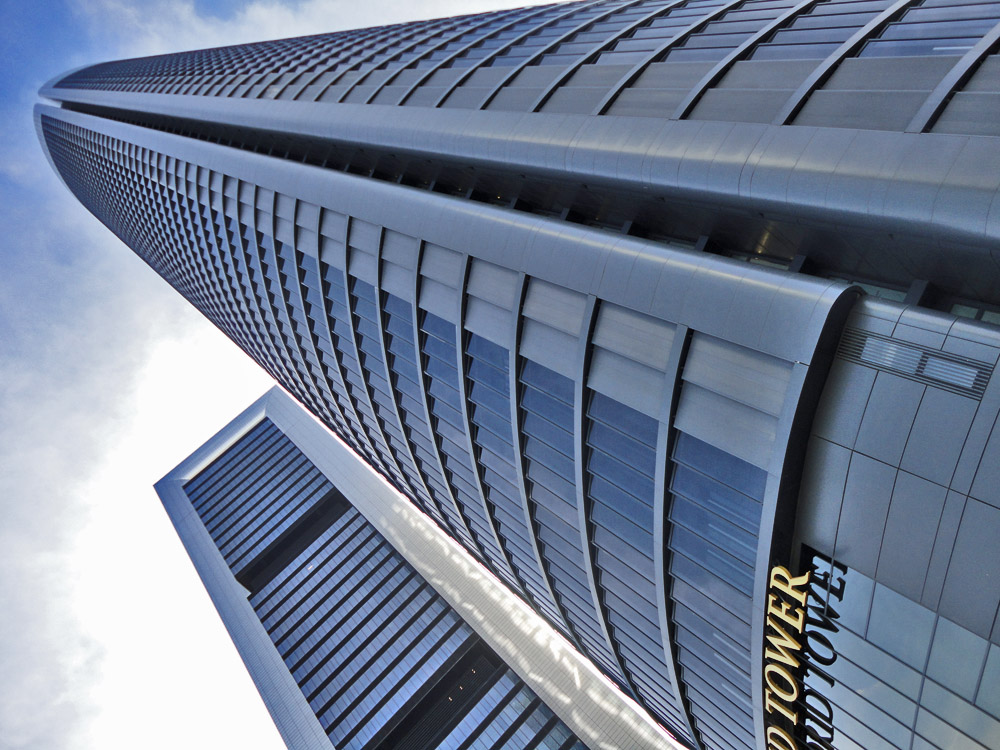
Hotel Eurostars Madrid Tower, also called Torre Sacyr Vallehermoso, is the tallest hotel in Europe. It is 236m tall, has 52 floors and is the 3rd tallest building in Spain.
Drawn by Rubio and Alvarez Sala.
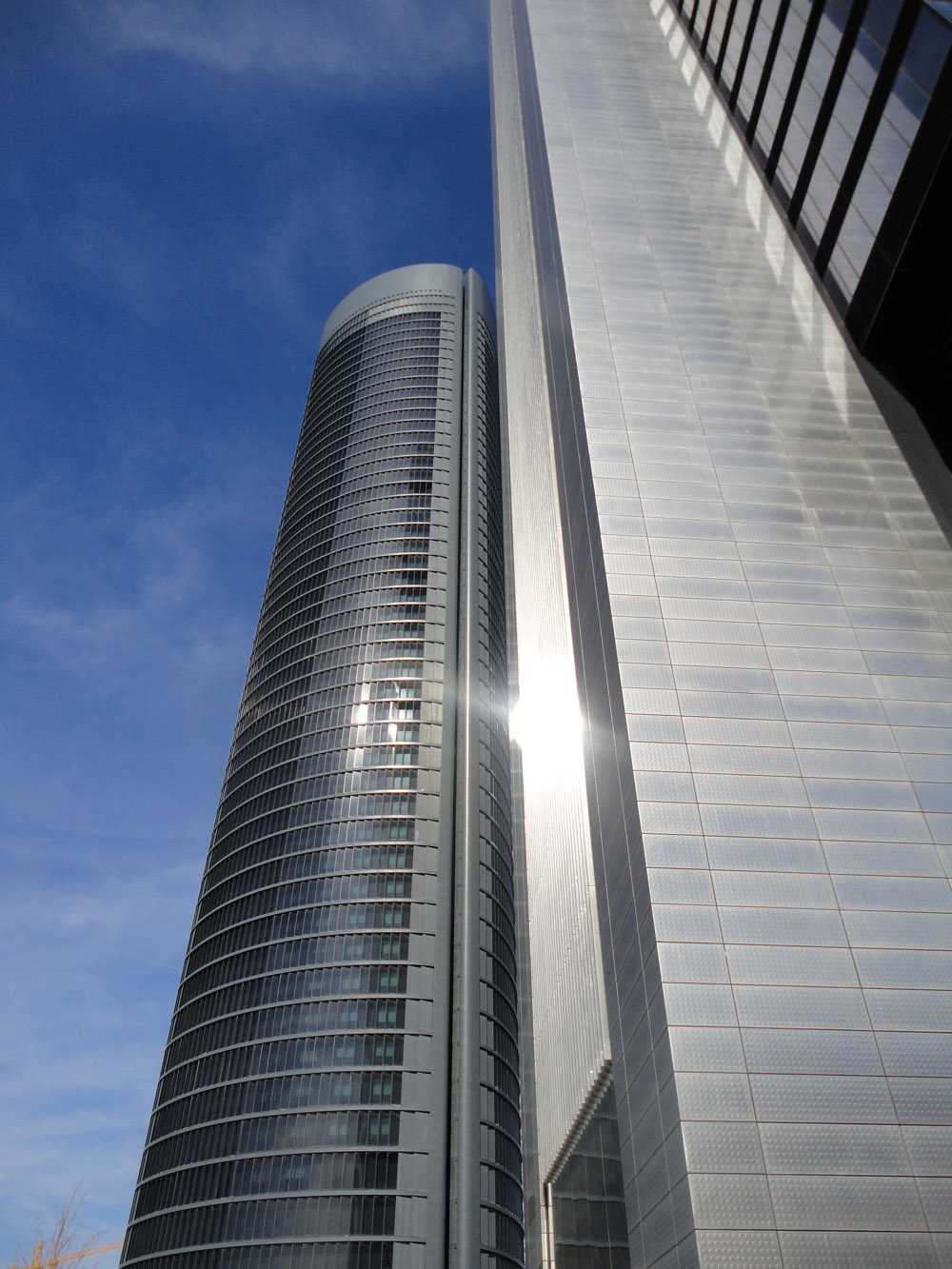
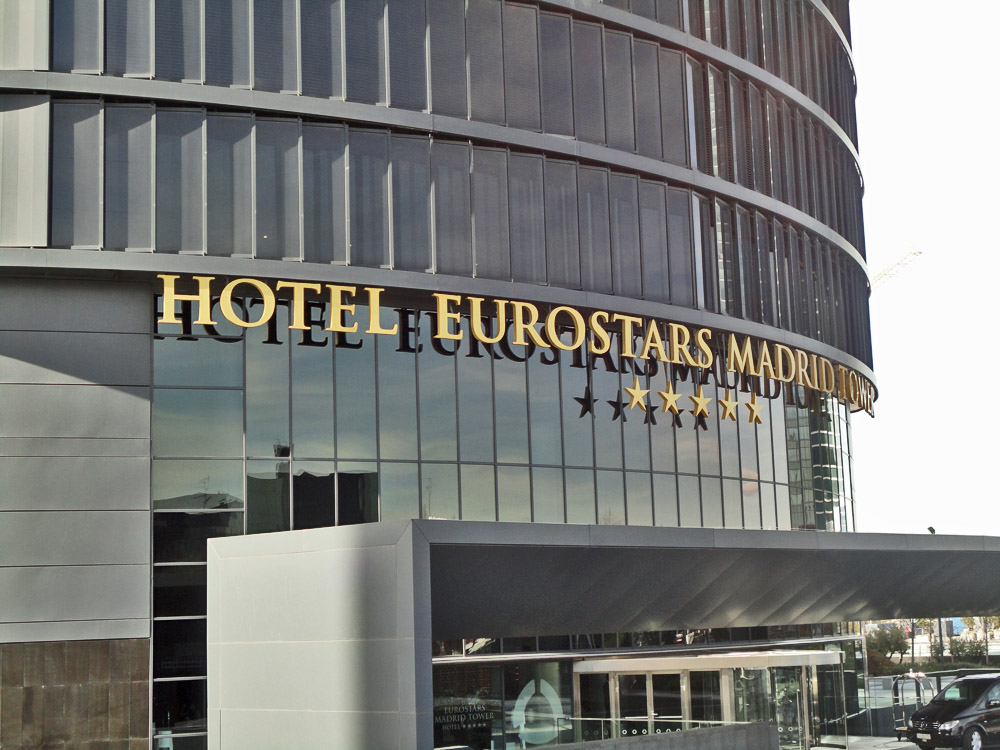
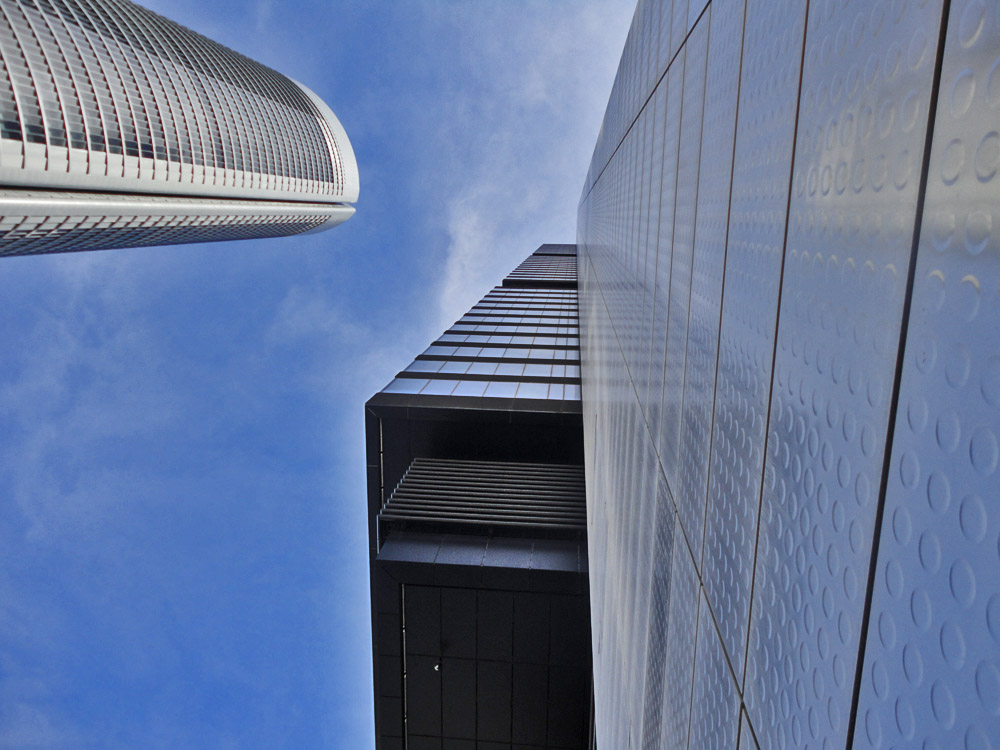
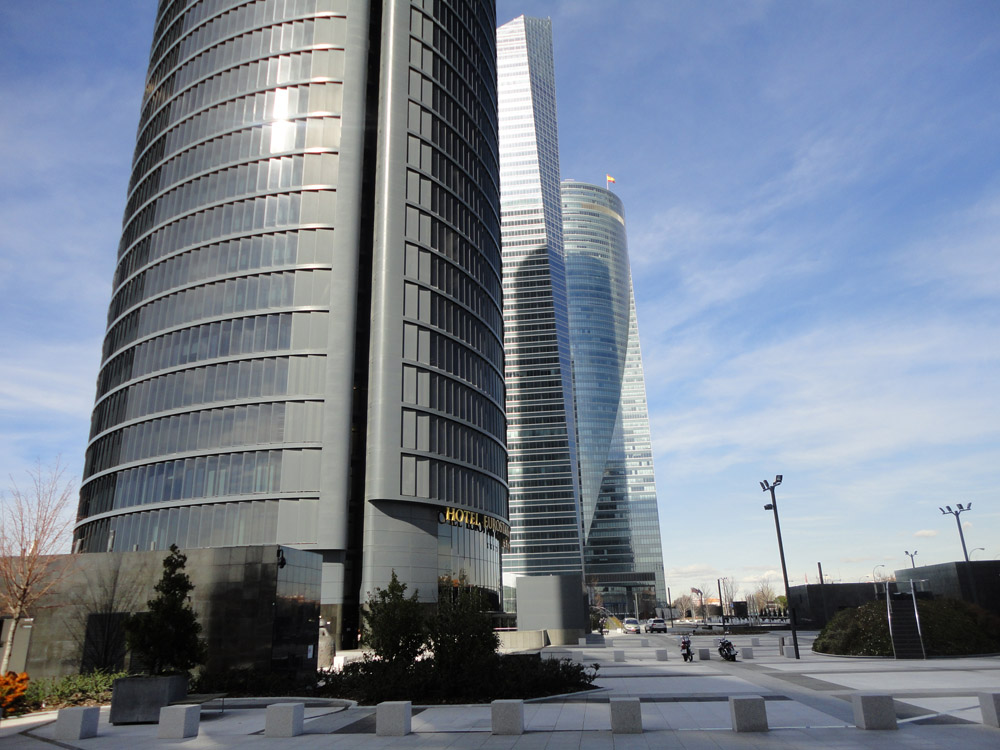
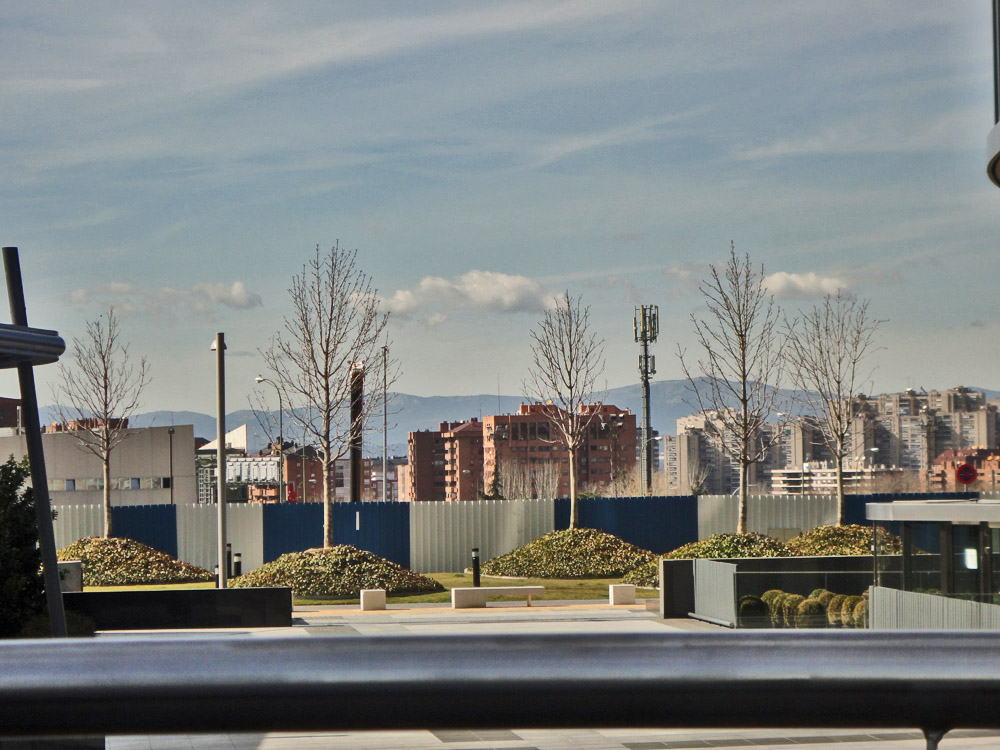
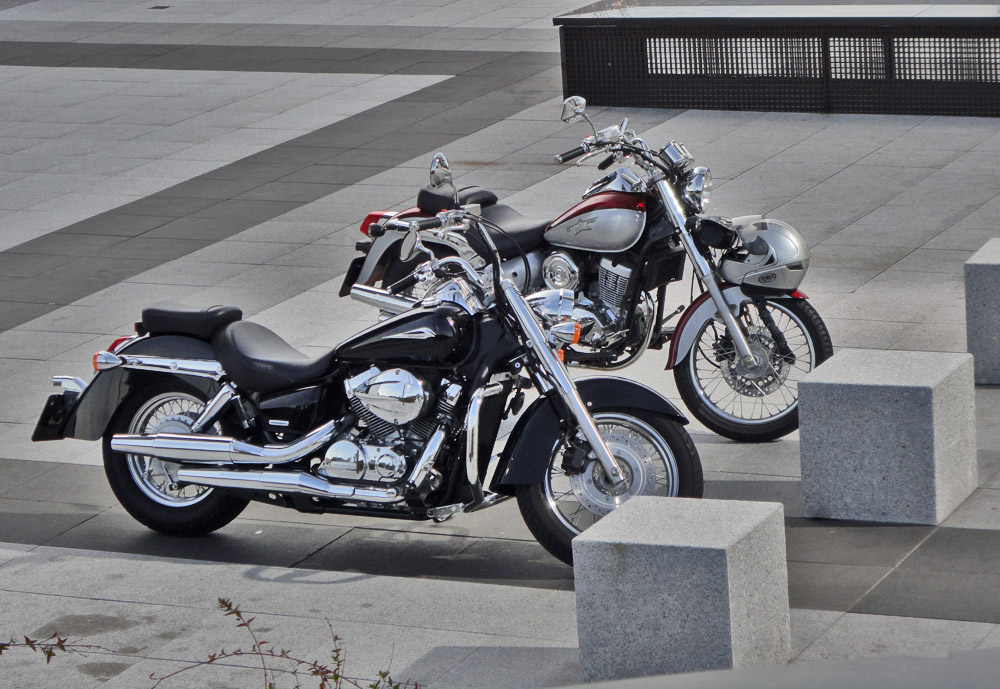
Some of the businessmen working in the towers drive bikes like these.
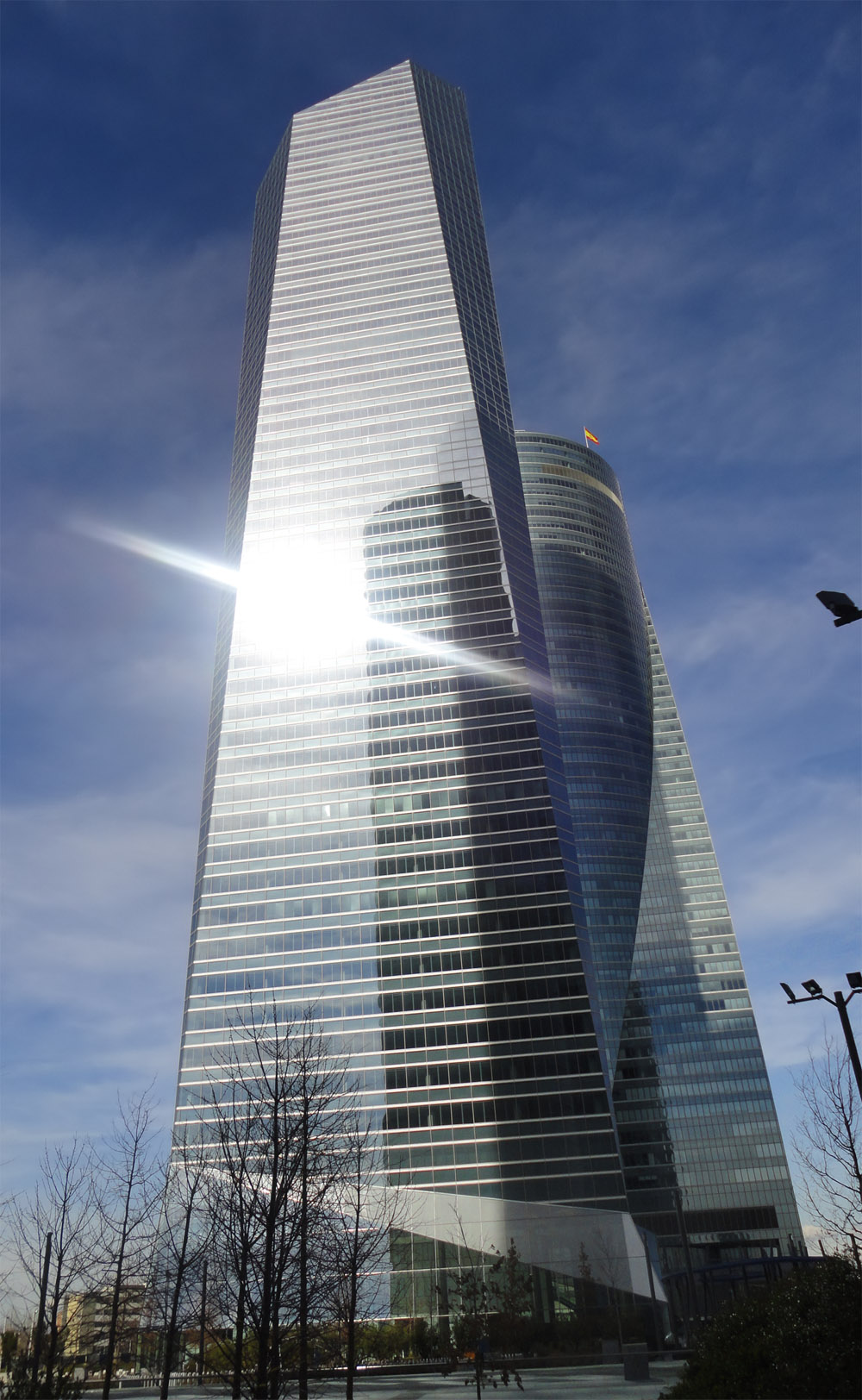
Torre de Cristal. With 249.5 m it is the 2nd tallest building in Spain, and it is less then a meter shorter then Torre Caja Madrid.
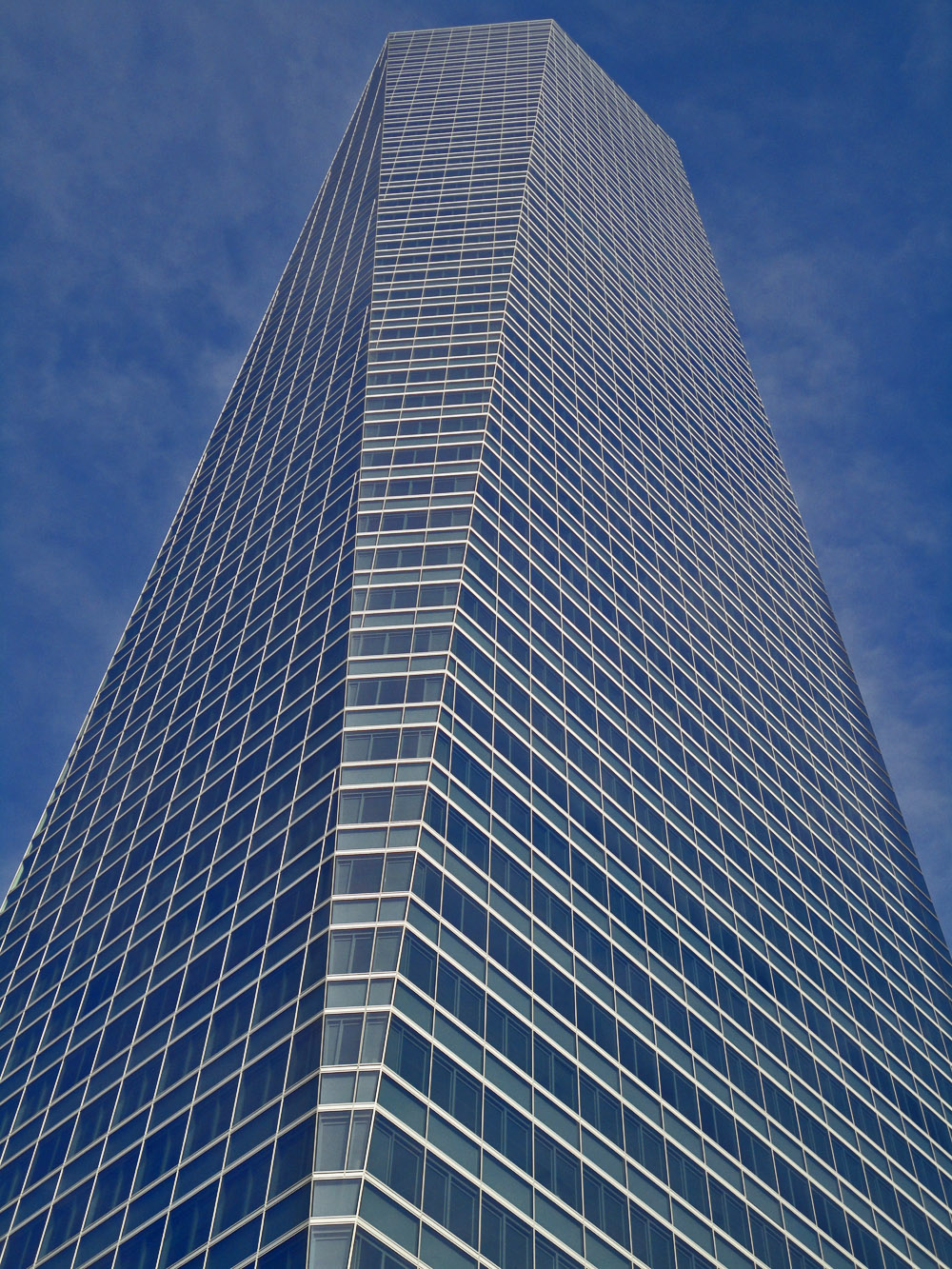
Torre de Cristal has 45 floor and was designed by César Pelli, one of the world's leading architects. It was completed in 2008.
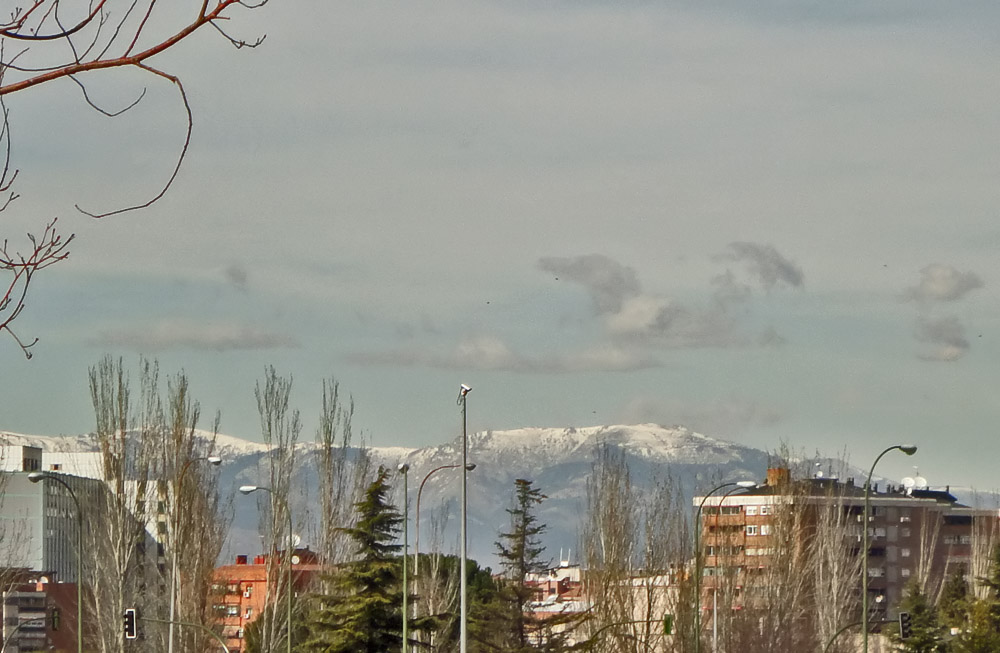
View towards Sierra de Guadarra.
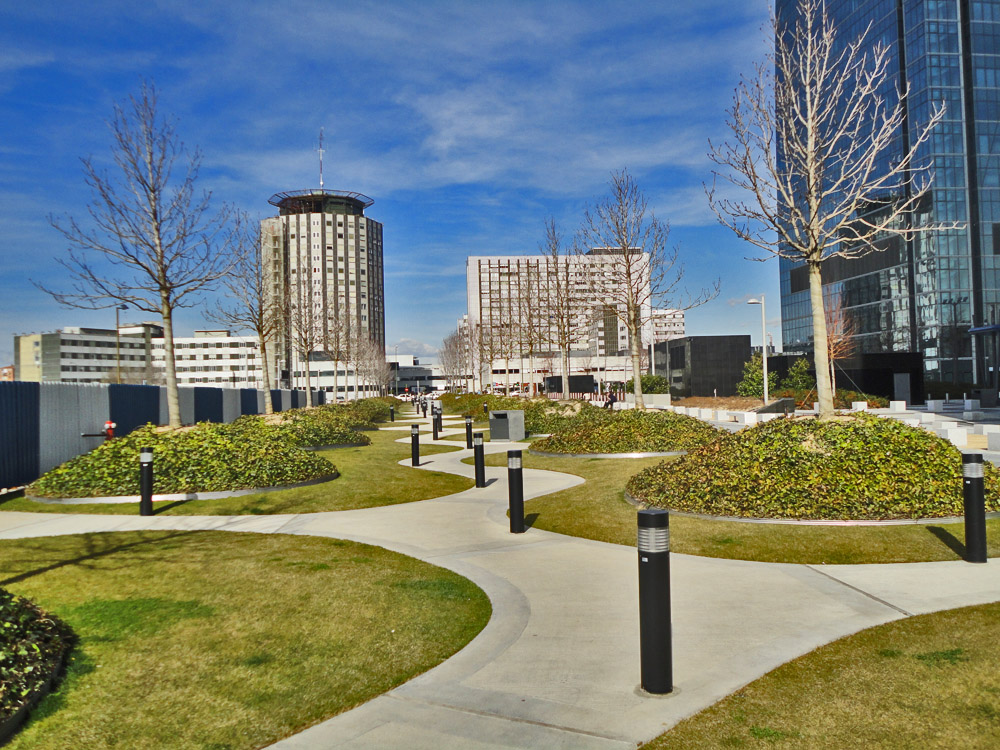
Some of the articial greenery, looking towards the ugly La Paz Hospital. The tower is under renovation, perhaps recladding.
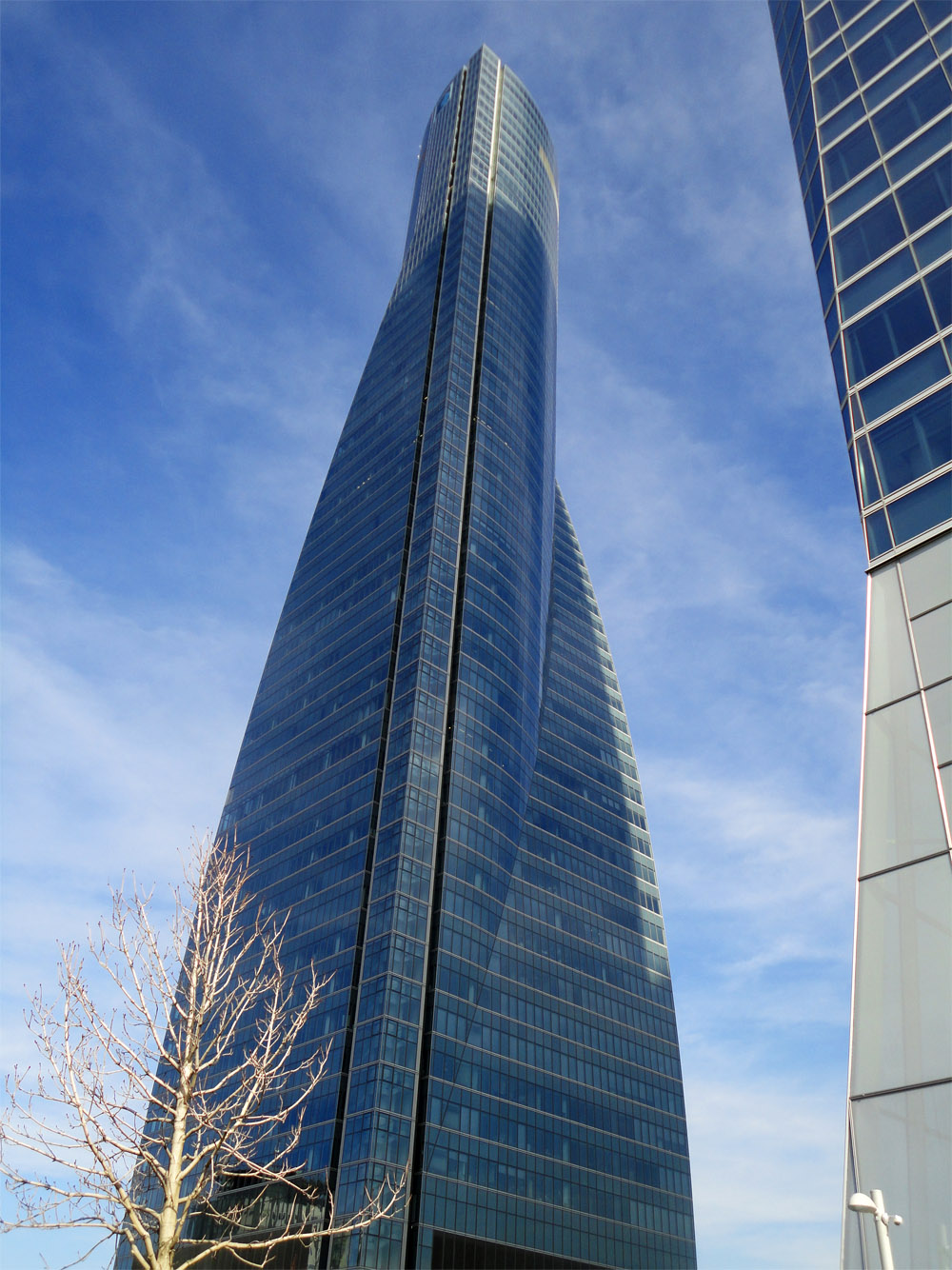
Torre Espacio. With 57 floors it is the tallest building in Spain by number of floors, but the lowest of the 4 towers (236m). It is also the most curvy skyscraper in Madrid.
Architect: Henri N. Cobb. Among the offices are the British embassy. It was the first of the 4 towers to be completed, in 2007.
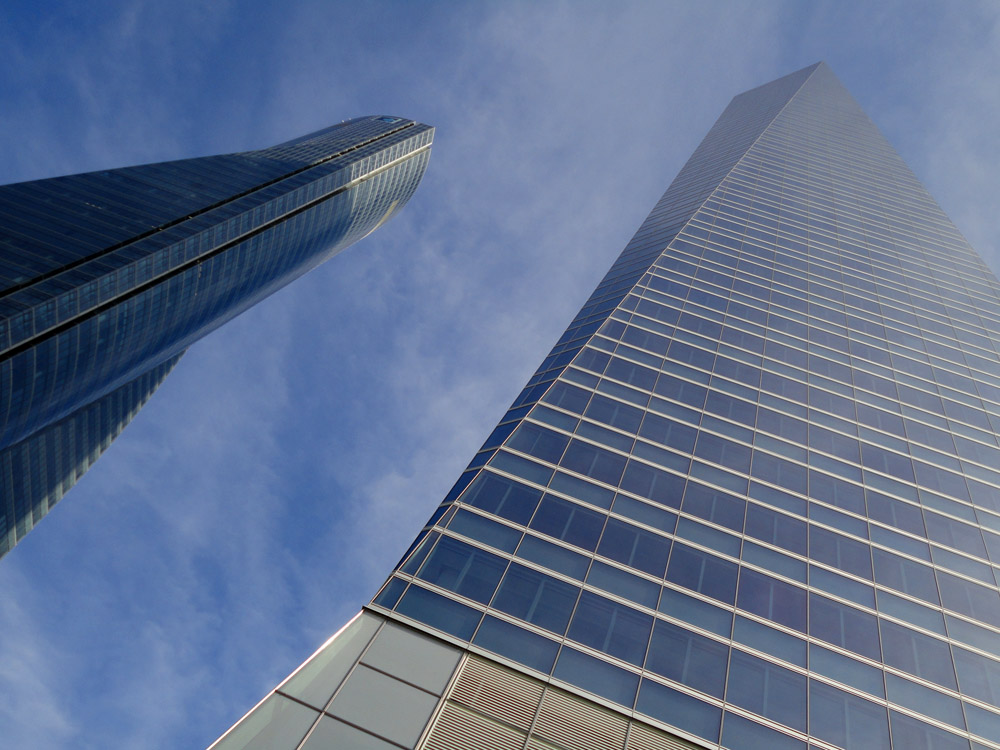

Torre Espacio and Torre de Cristal.
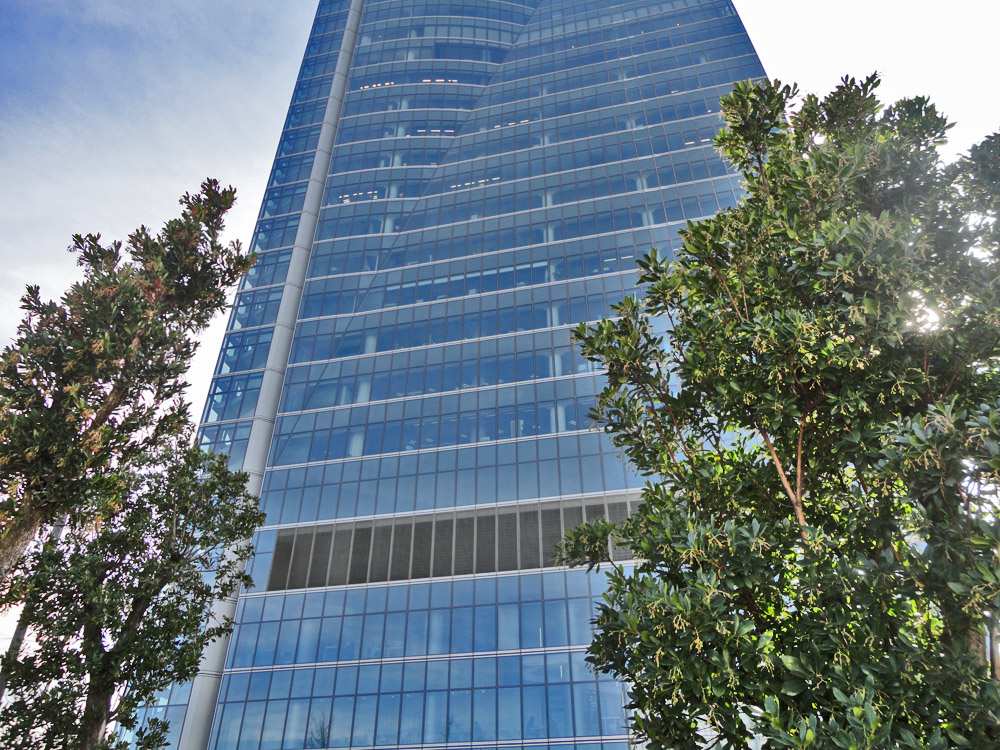
In November 2006, the mayor of Madrid, attended a ceremony with fireworks to celebrate that it had surpassed the height of Benidorm's Gran Hotel Bali, so Madrid
once again has the tallest buildings in Spain.
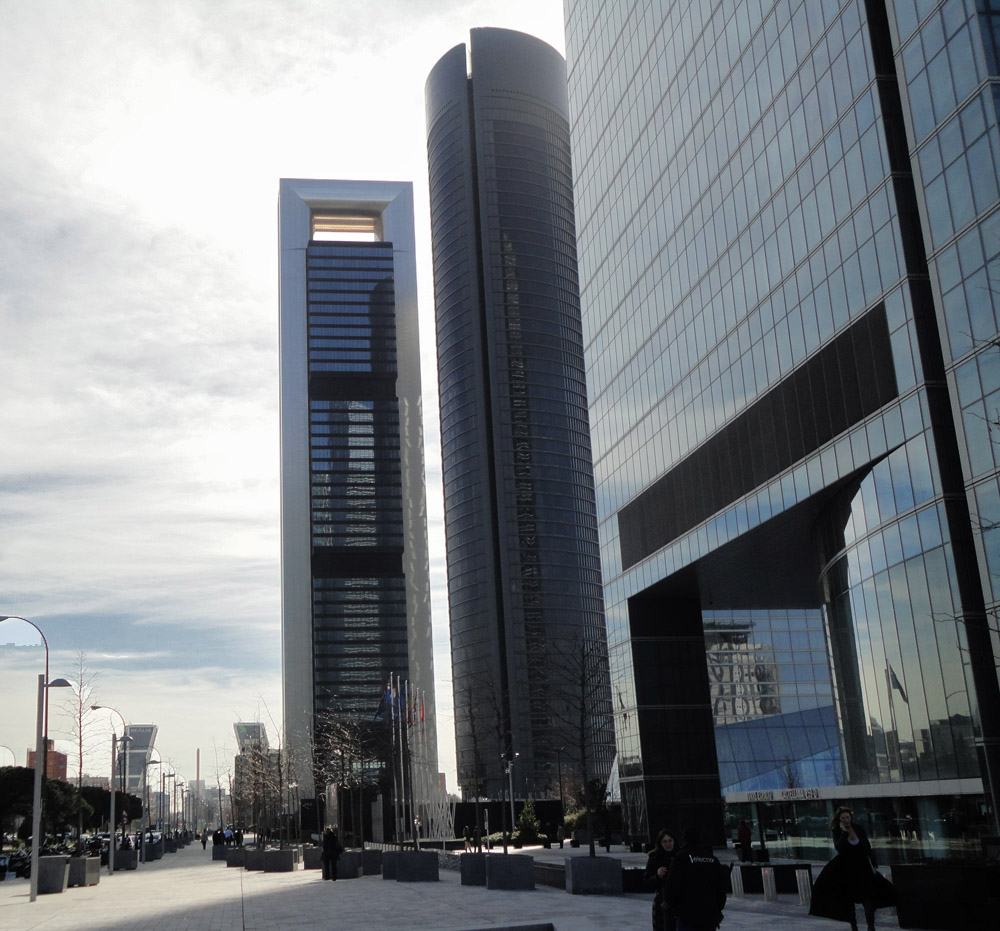
The north end of Cuatro Torres with Torres Kio in the background.
La Latina
La Latina is a small scale, picturesque district, that begins on the south gate to Plaza Mayor. It is the oldest and most cozy part of Madrid. It could be compared to Montmartre in Paris, with the hilly narrow streets, small plazas, open air cafés, pubs, bars and restaurants and charming old buildings. Some beautiful chuches are in the area. It is very crowded and has a lot of entertainment. The Toledo Gate is also here.
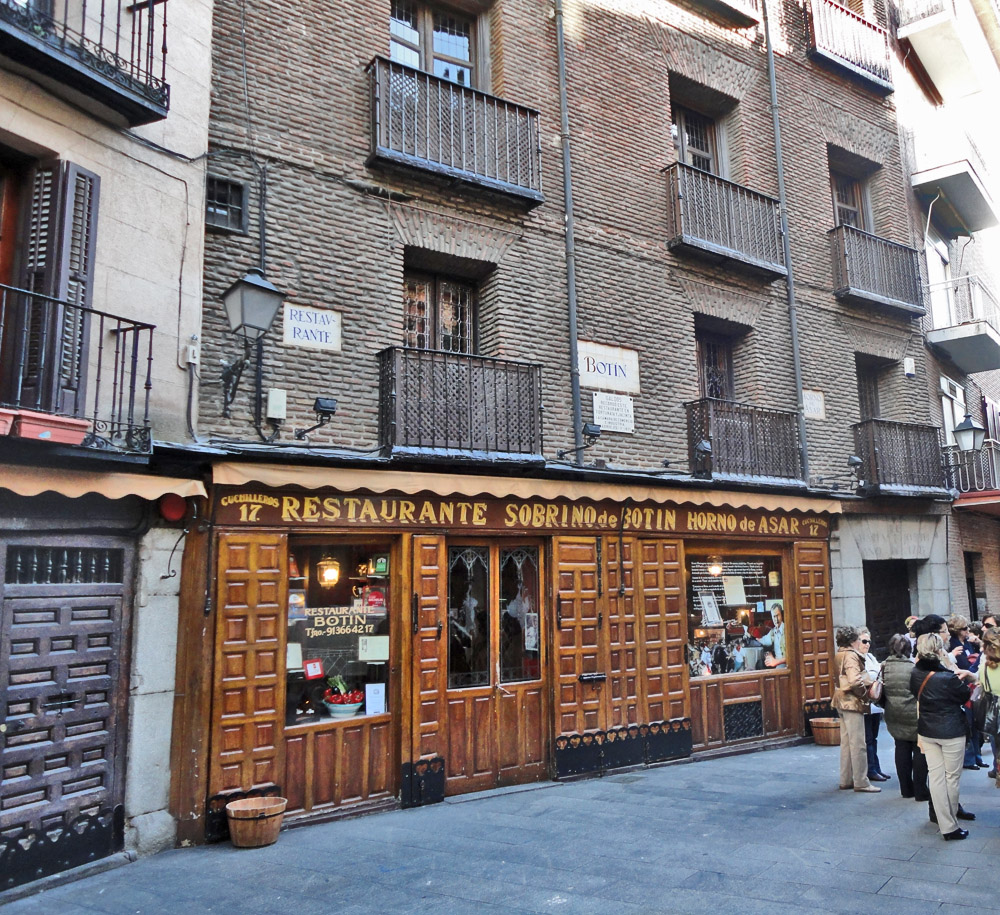
Botín, the world's oldest restaurant. Famous guests are Hemingway, the Spanish king and some presidents.
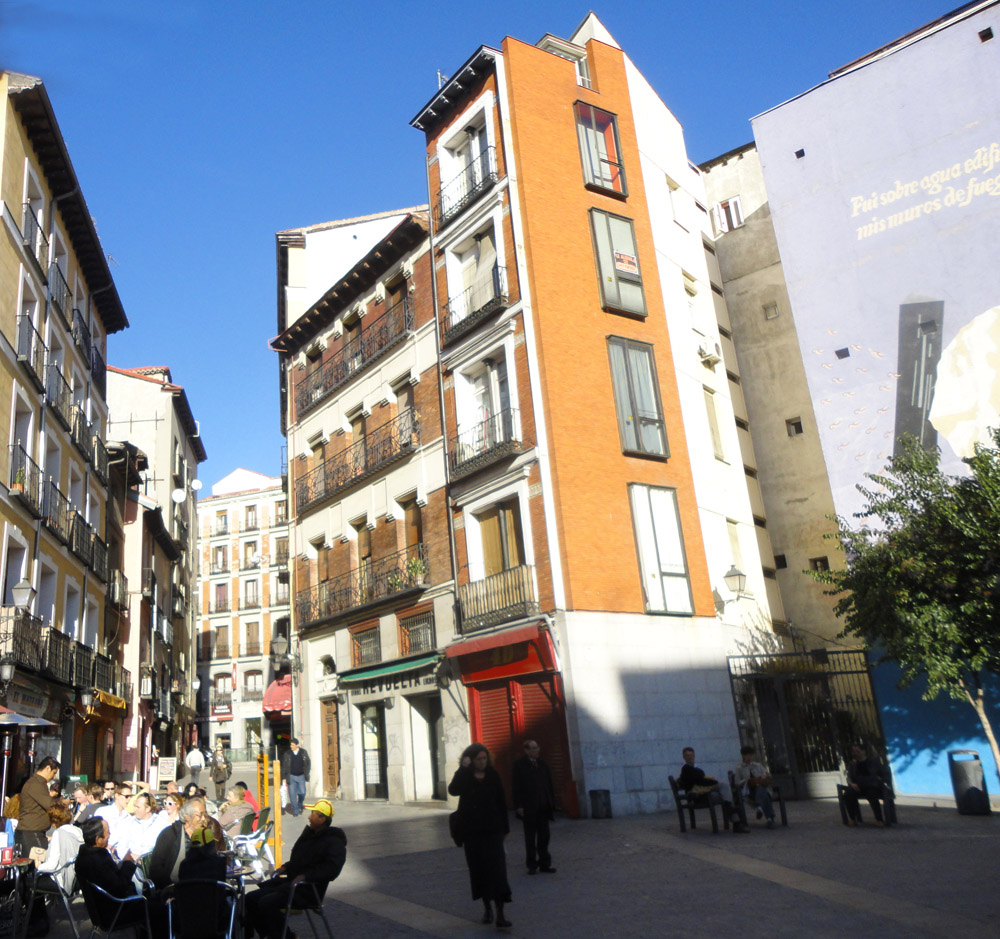
Plaza de Puerta Cerrada, a small plaza just south of Plaza Mayor. We sat for a while on this open air café.
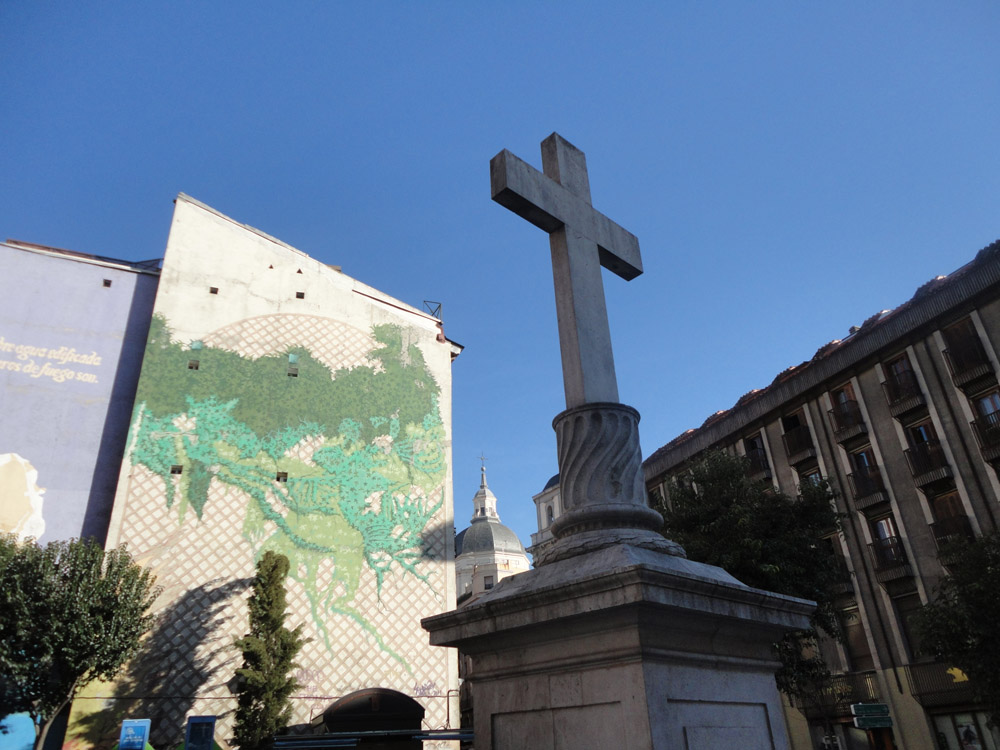
Plaza de Puerta Cerrada. A bit strange with this giant cross in the middle of the square.
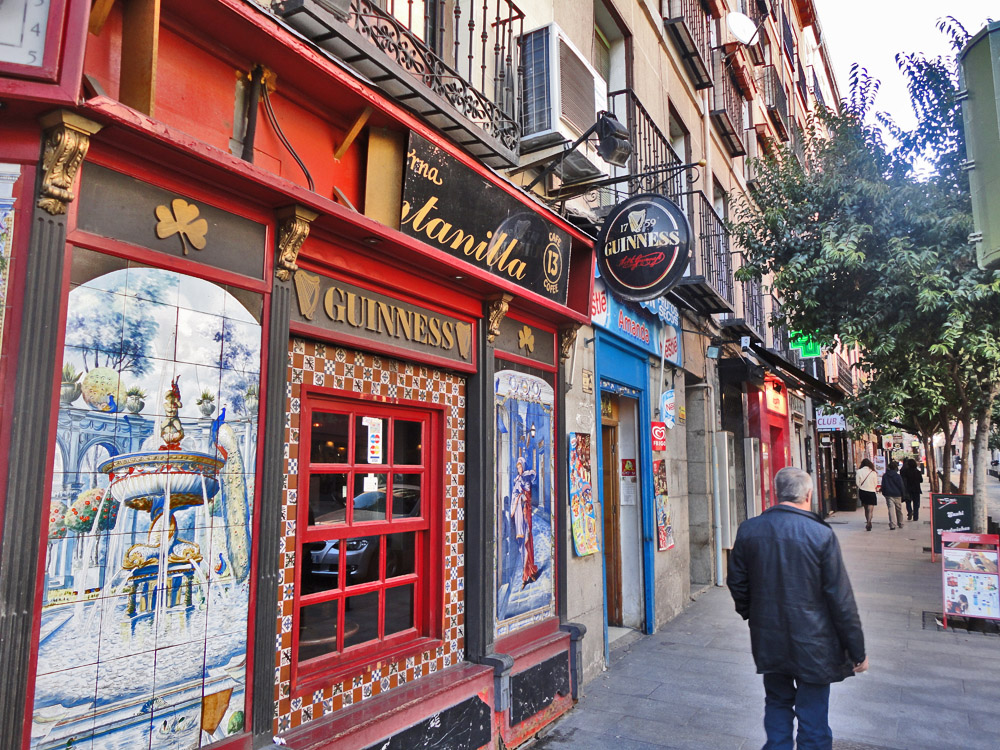
A nice street with pubs just south of Plaza Mayor. Looks a bit English.
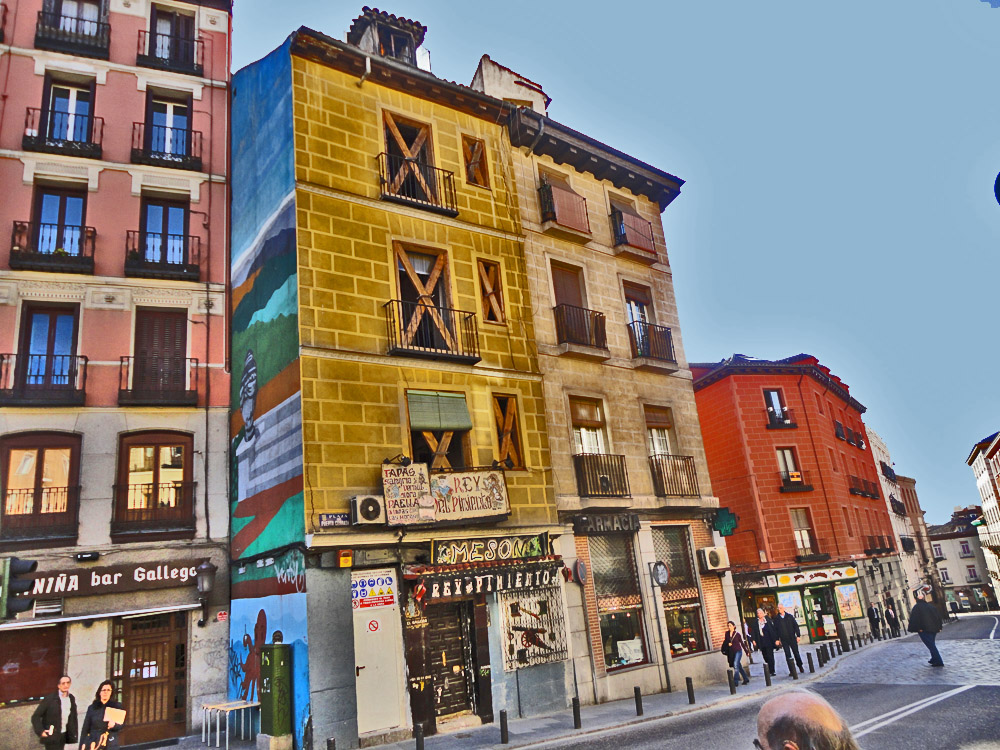
The artistic, Montmartre like feeling of La Latina.
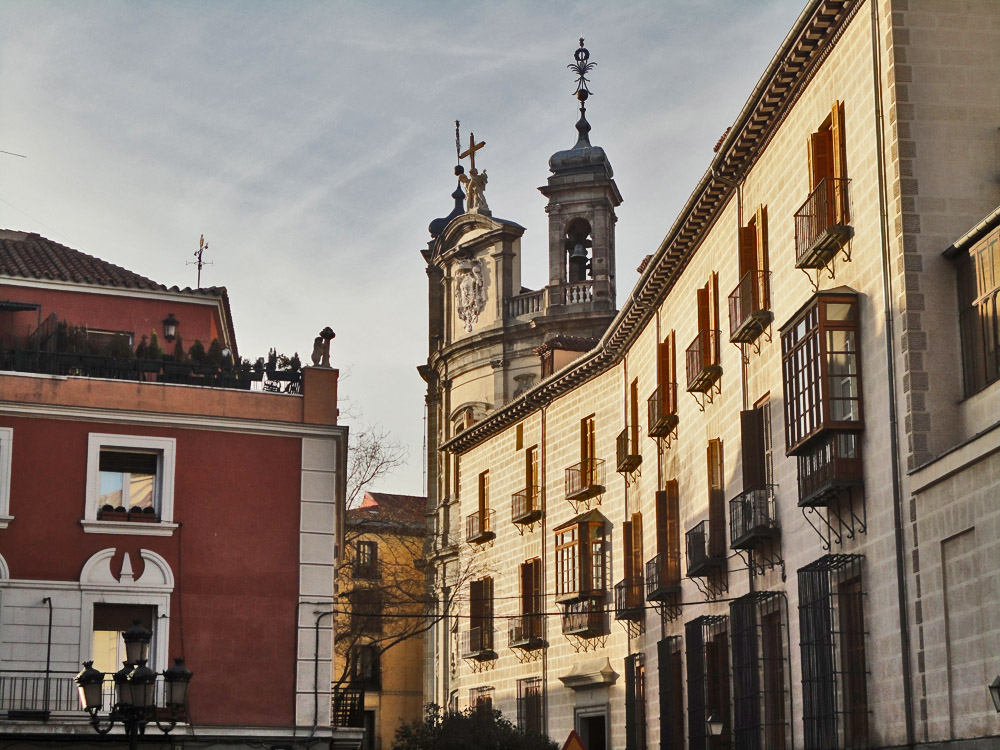
San Miguel, one of the many churches in La Latina.
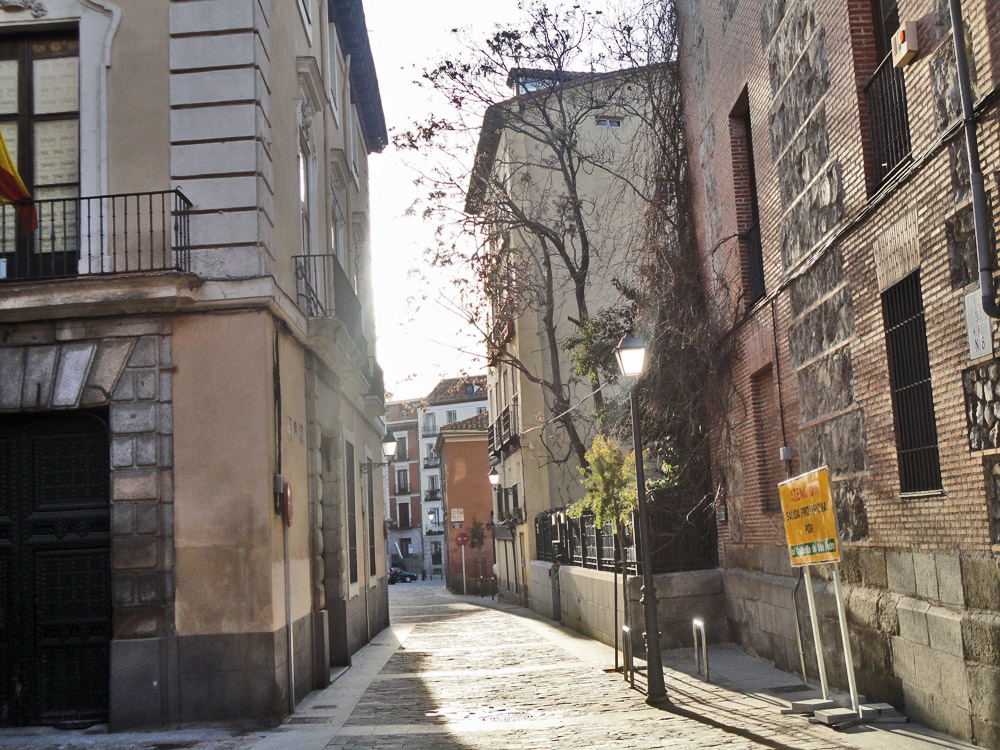
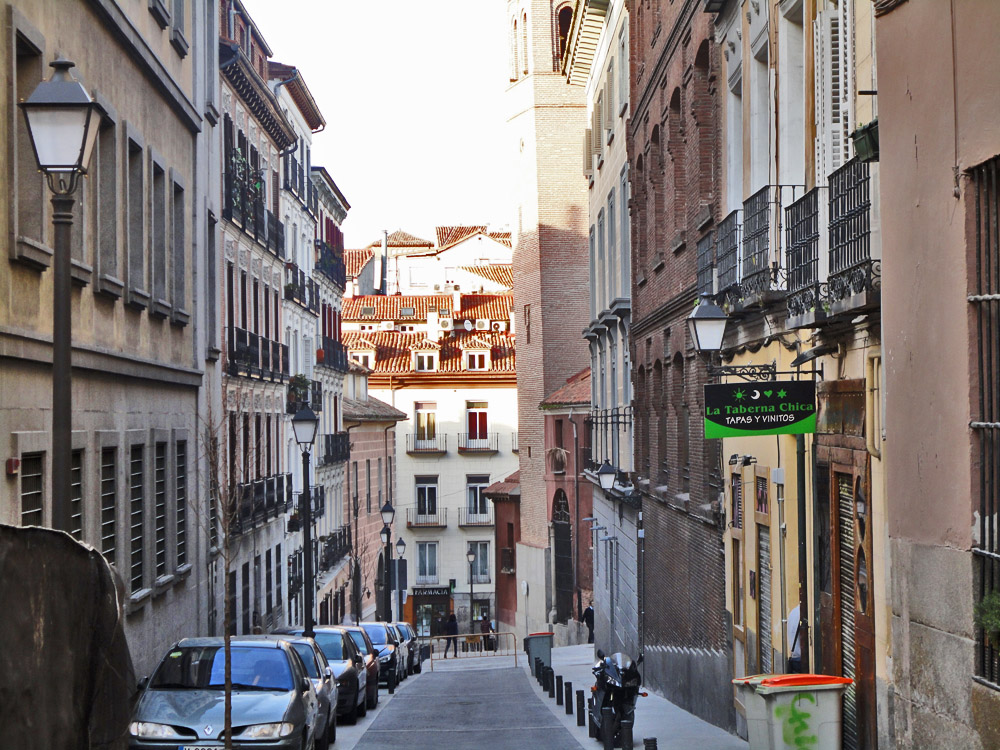
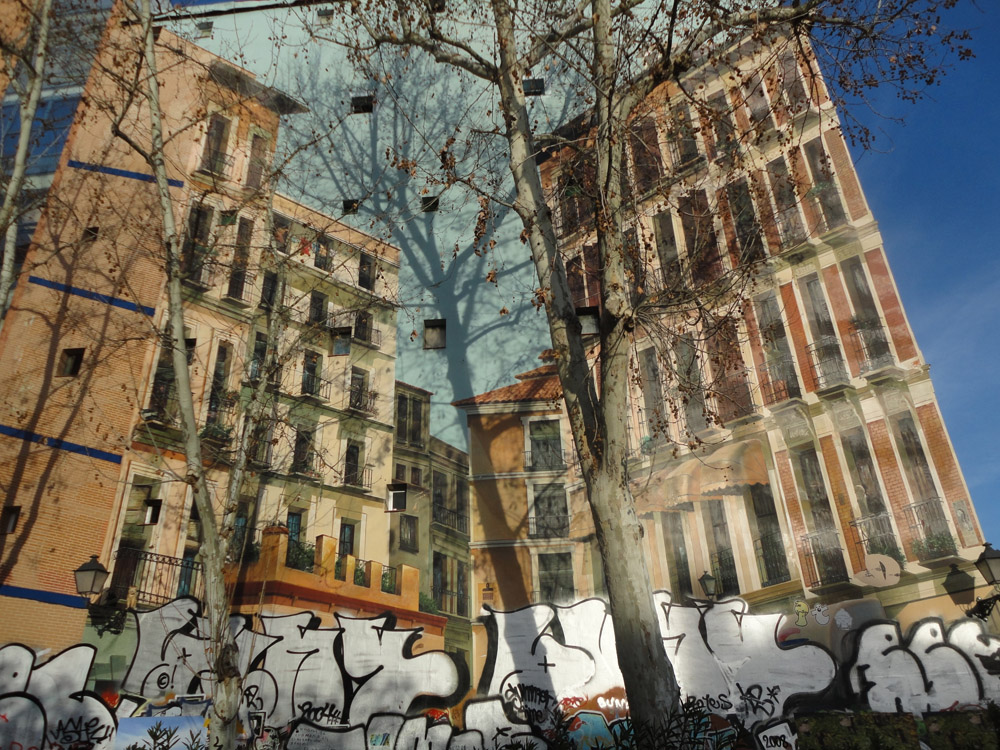
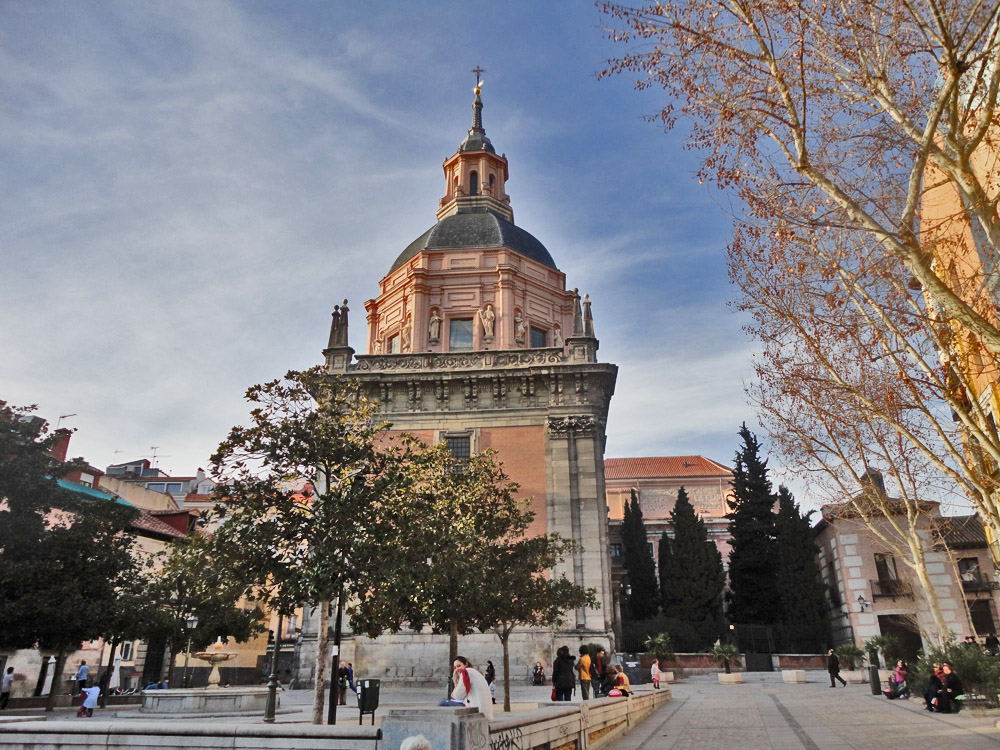
Iglesia San Pedro Capilla del Obispo. A beautiful church at Plaza de Puerta de Moros.
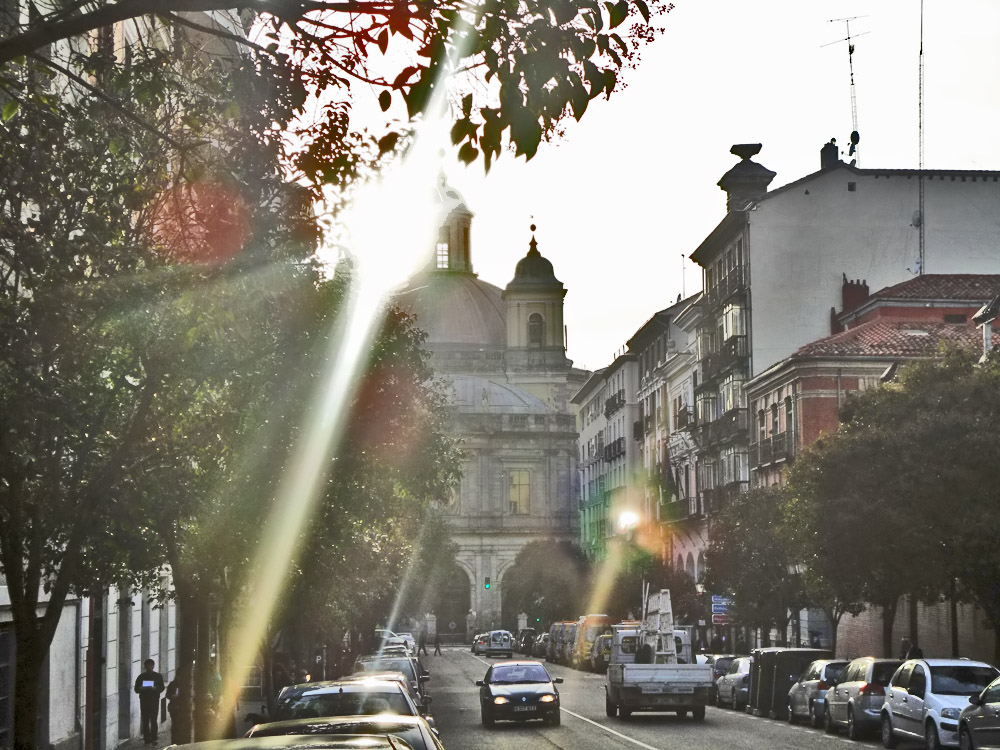
San Francisco el Grande. A large church a few blocks south of the palace, here seen from Plaza de Puerta de Moros.
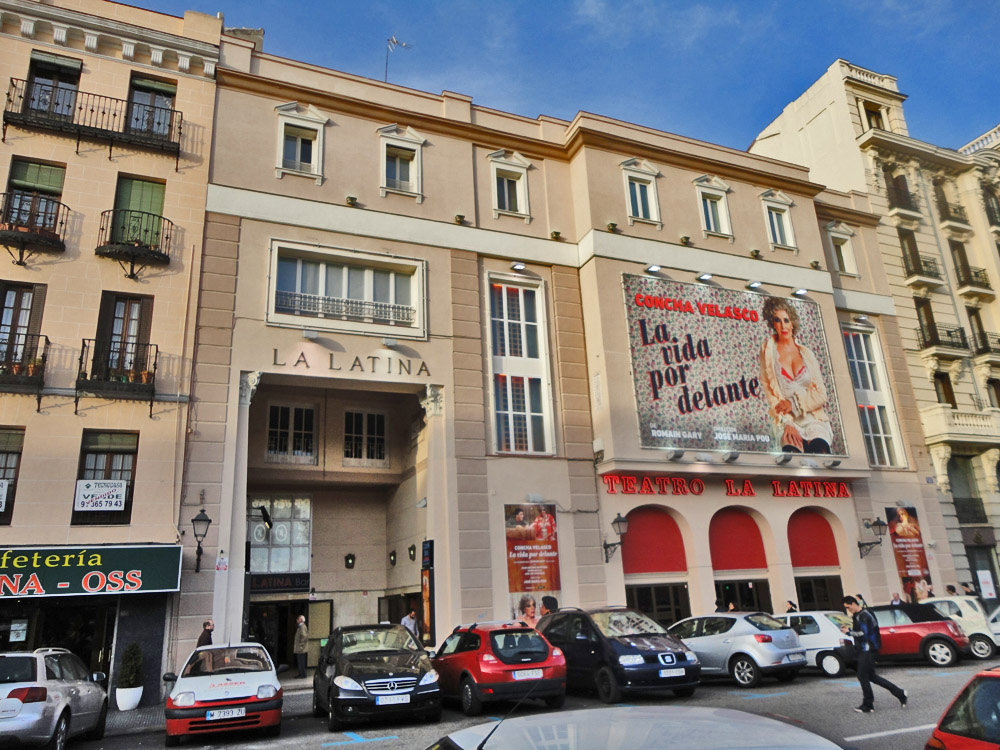
Teatro La Latina.
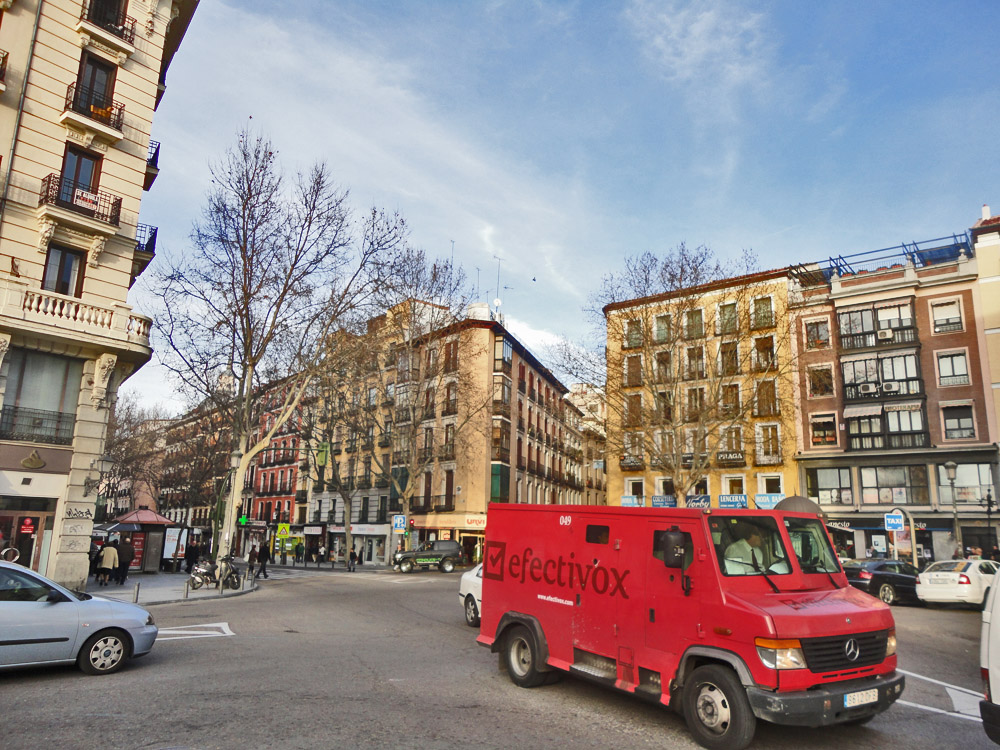
Calle de Toledo, the main street of La Latina.
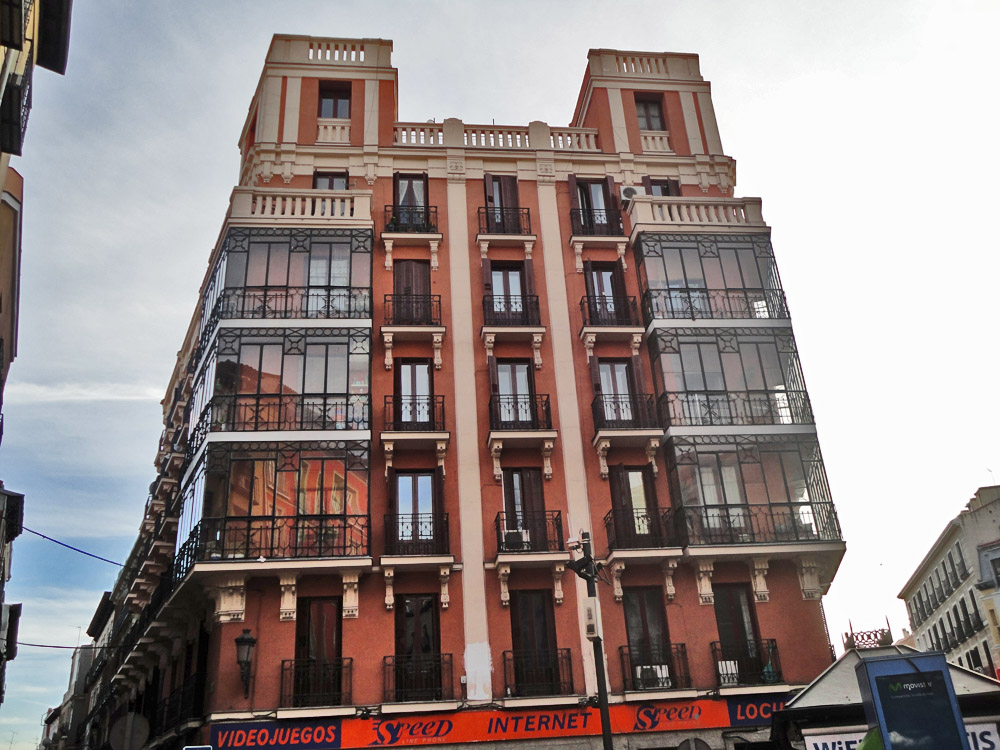
Nice building in typical Spanish style at Calle de Toledo.
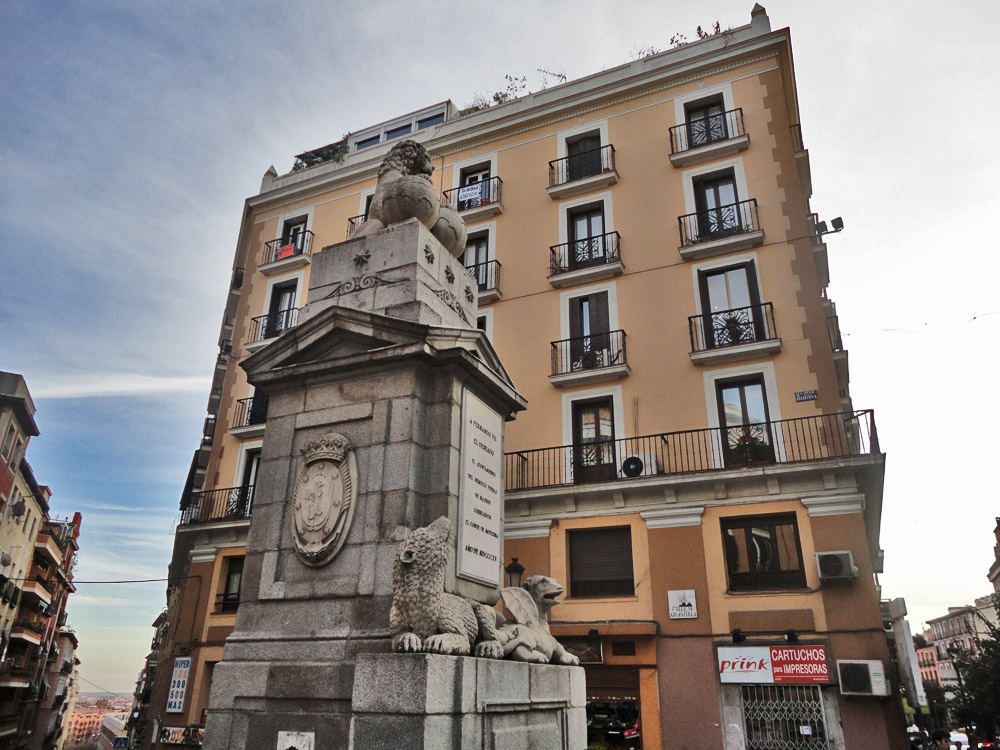
Fernando VII monument. Note the view from the hill to the left.
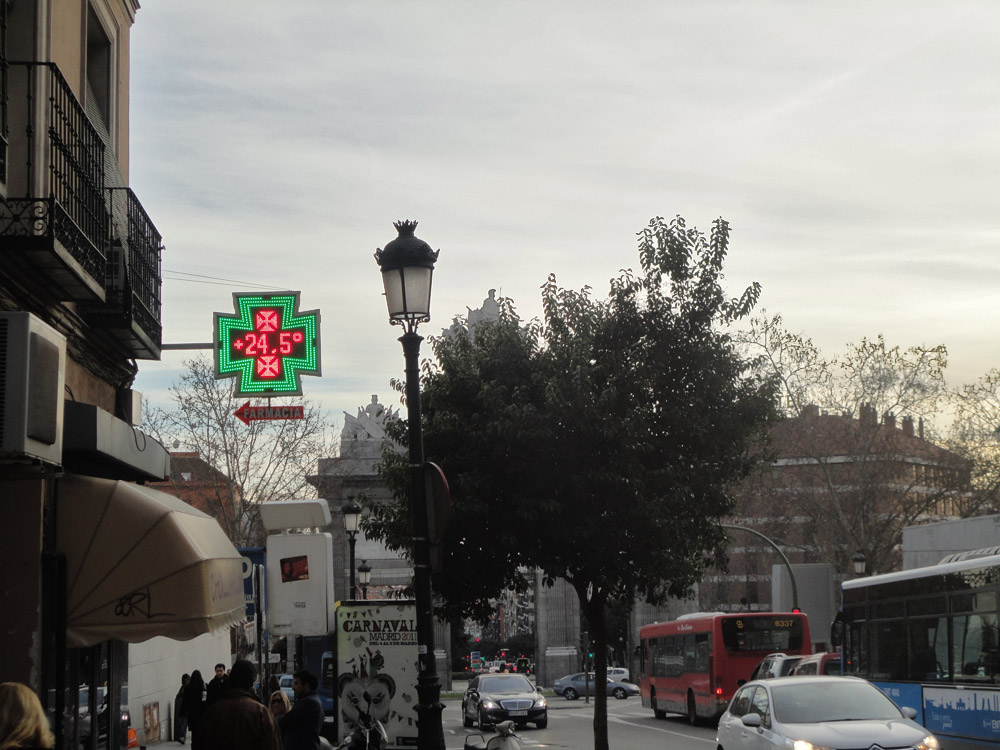
I don't believe the pharmacy sign that says "24,5" degrees, cause at this moment it felt more like at most 15 degrees.
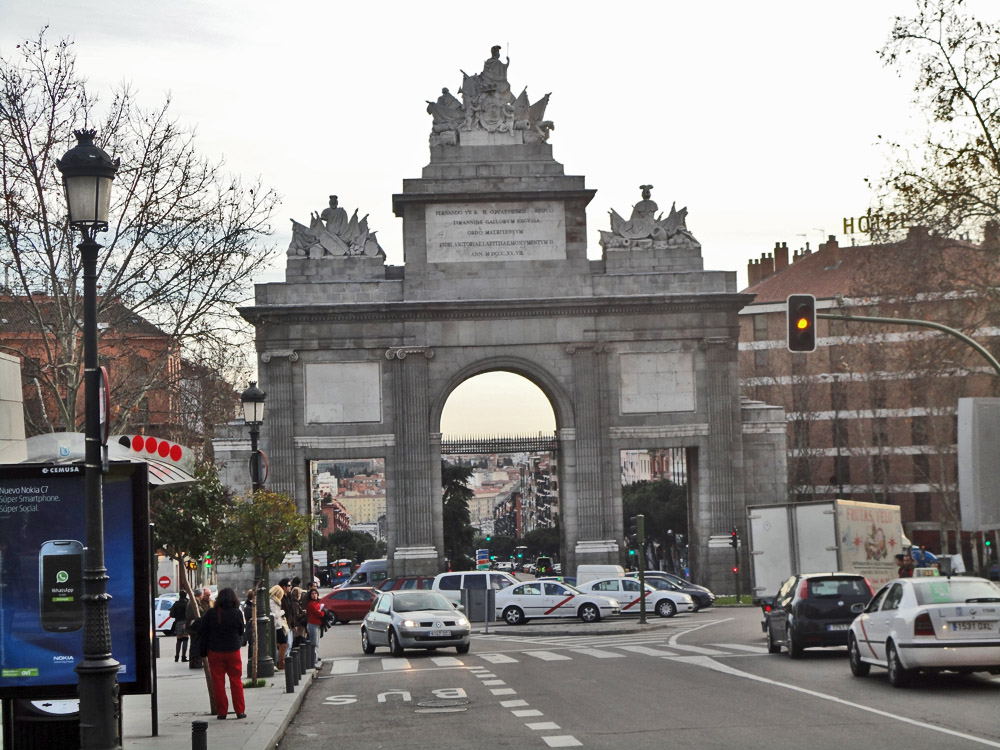
Puerta de Toledo, the gate of Toledo. Completed in 1827 and located at a trafficated circle in La Latina. One of 4 "arch of triumphs" in Madrid.
Lavapiés
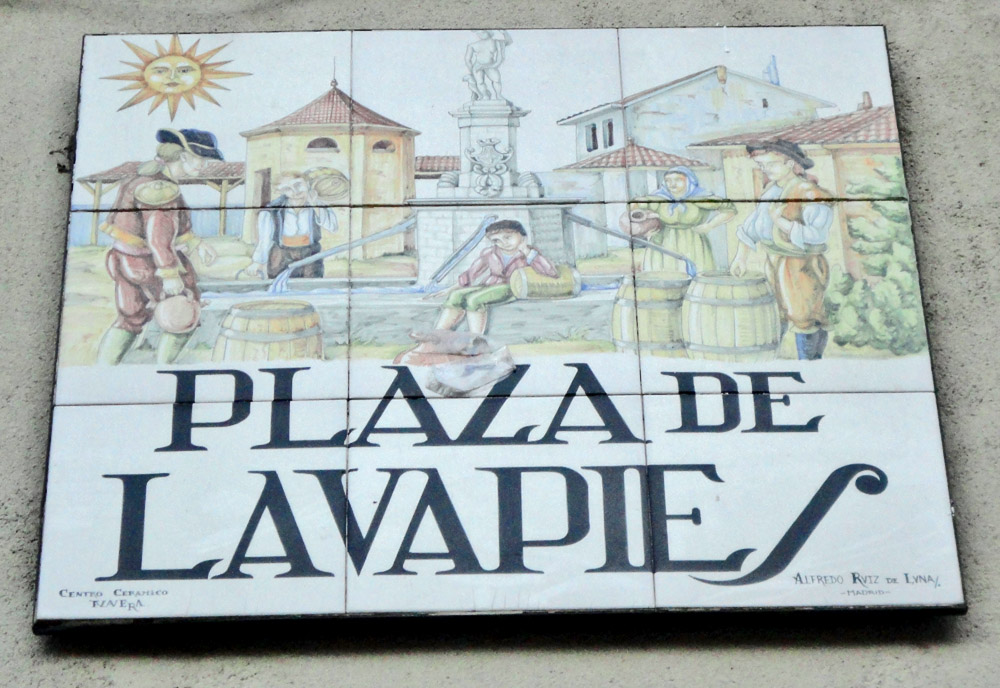
Below and above: Plaza Lavapiés, the heart of Lavapies.

I took the metro to Lavapiés, a small central district just a few blocks south of my hostel near Plaza del Santa Ana, planning to walk the beautiful hilly street up at sunset.
But I decided to take the metro instead since there were some gangs and obscure types in the surroundings. I didn't want to take a chance my last day.
Lavapiés is a small multi cultural area and is surely nice if you know it, but it just didn't feel safe compared to the other areas in Madrid I visited, at least not on this evening.
Plaza Santa Ana and the quarters around
Plaza de Santa Ana is one of the nicest squares in Madrid with the landmark Hotel Reina Victoria, the playground and open air restaurants. After dark some of the buildings exteriors shines in neon. The smaller Plaza del Angel lies just next to it. Cañizares is the small street were my hostel was, close to these 2 squares. Calle las Huertas is a nice, narrow parallel street to Calle de Atocha, but it begins at Plaza de Santa Ana, so it fits in this section. It is crowded with people to 4 o'clock summertime, it was a bit less crowded during our visit in February.
This area has the largest number of tapas bars in Madrid. We talked a lot about what tapas really is and came to the conclusion that it can be everything that is eatable, but it must be little and served to a drink.
Plaza del Angel:
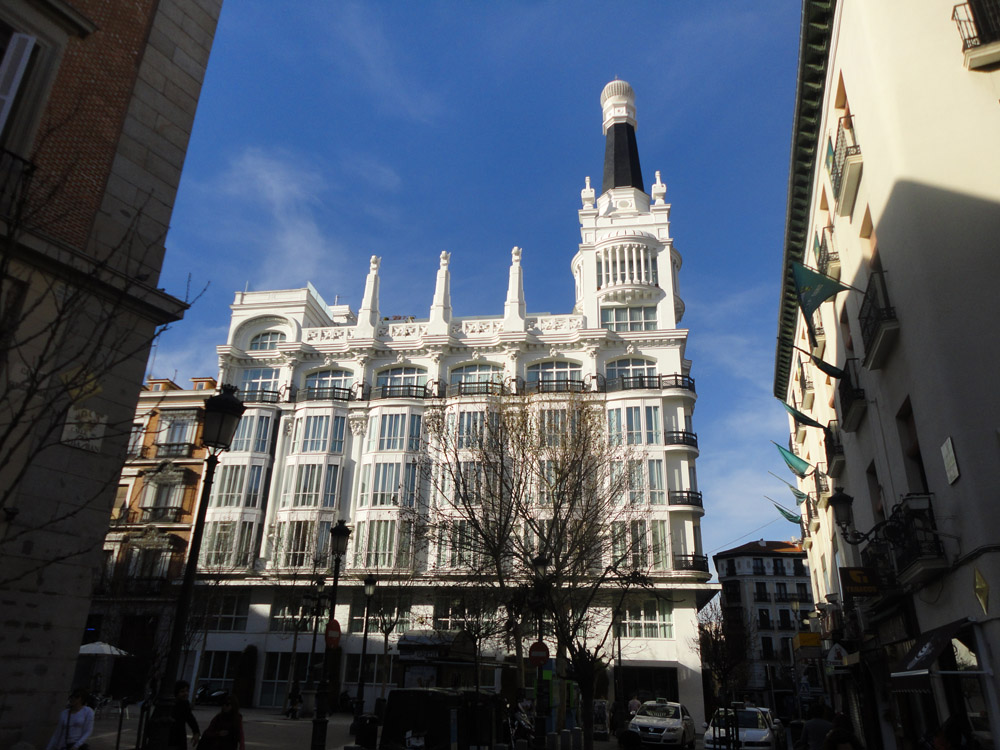
Hotel ME Madrid Reina Victoria, is a luxury hotel and the beautiful landmark of Plaza del Angel and Plaza Santa Ana.
Plaza de Santa Ana:
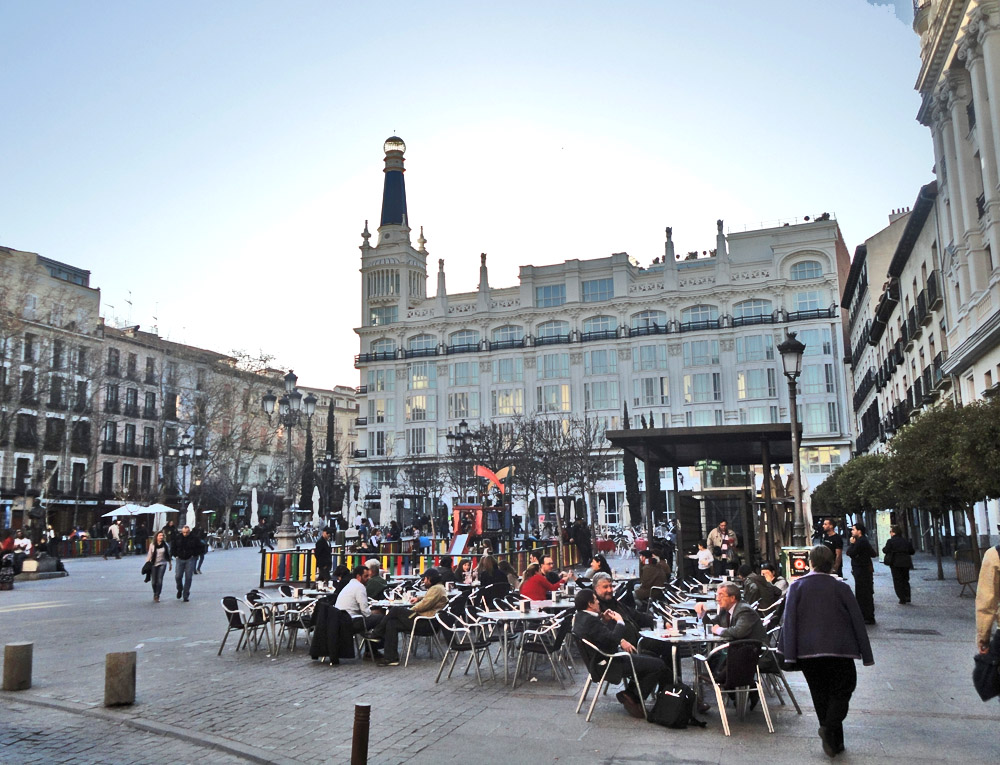
Plaza de Santa Ana is known for being the heart of literary Madrid, hence the large number of cafés and restaurant. It is close to Puerta del Sol.

Reina Victoria was built in 1920 and renovated in 2006. It has 192 rooms.
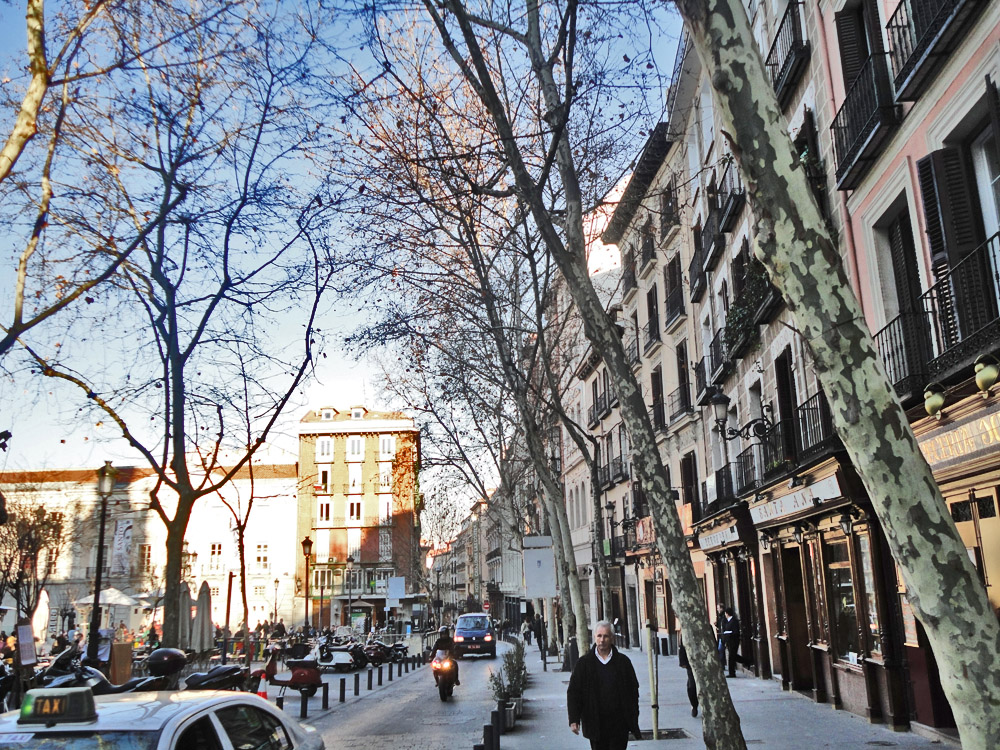


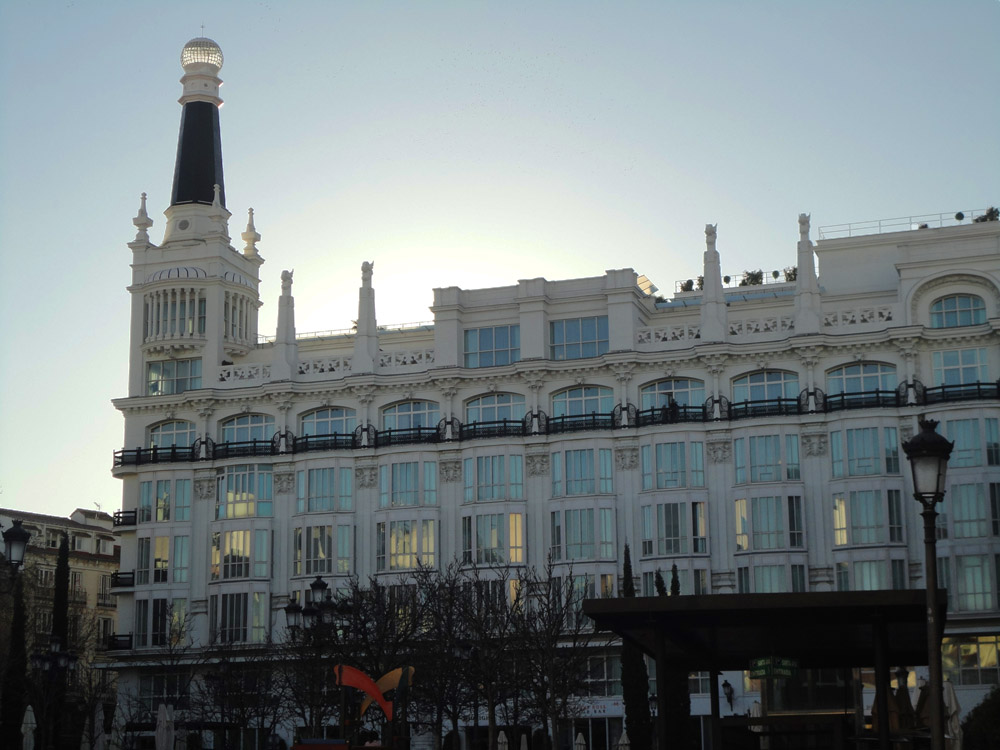
There is a nightclub on the rooftop of the gorgeous Reina Victoria building.
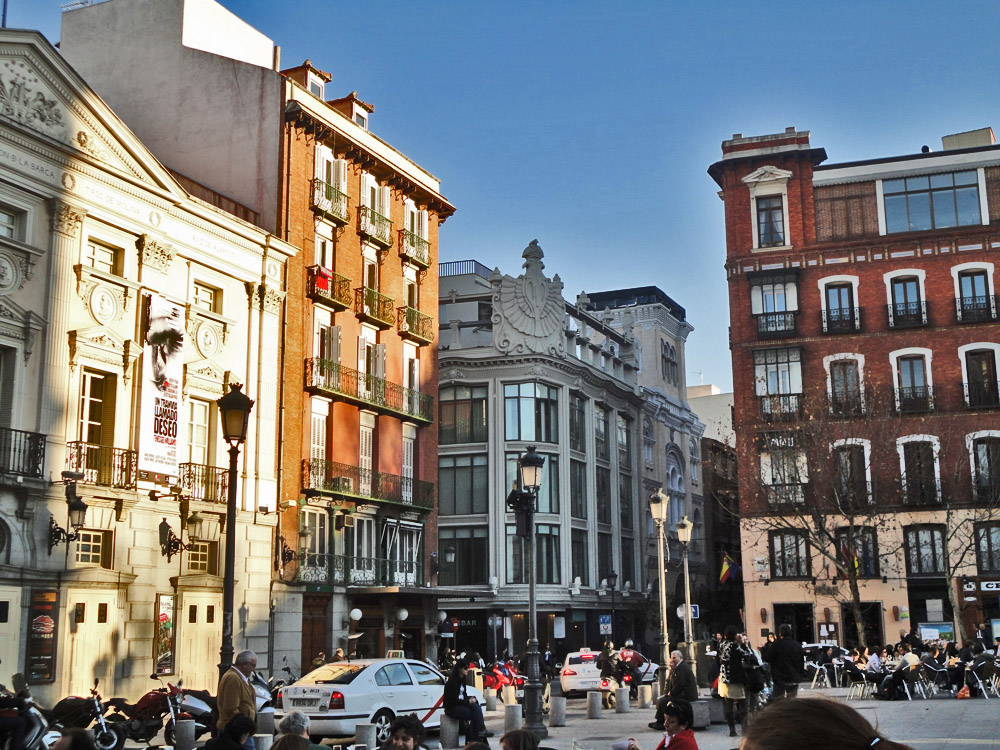
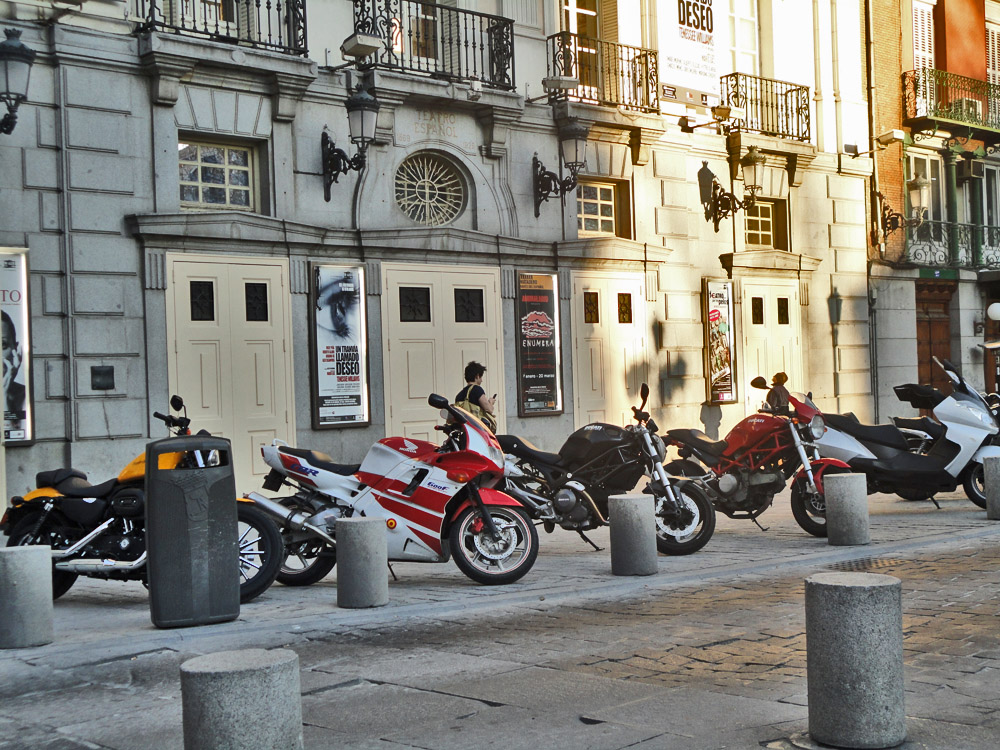
Motorcycles at Plaza de Santa Ana.

Sangria, a classic Spanish drink!
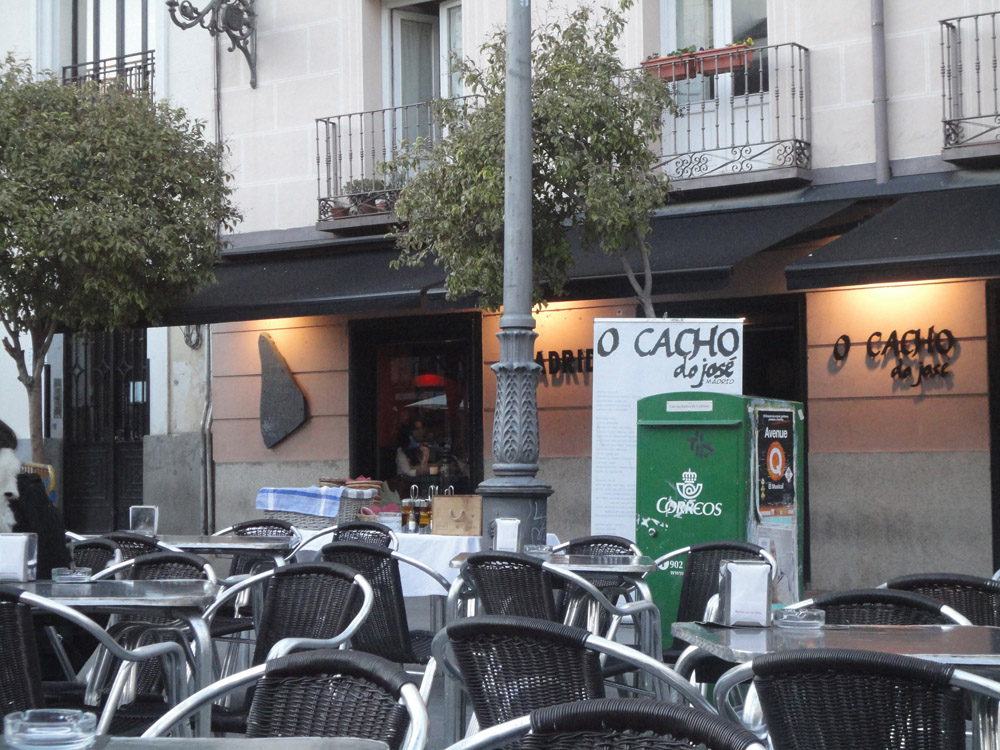
Served at O Cacho do josé. Looks a bit empty, but that because people sat in the sun and this part was shady.

Hotel Reina Victoria looks fabulous nighttime.

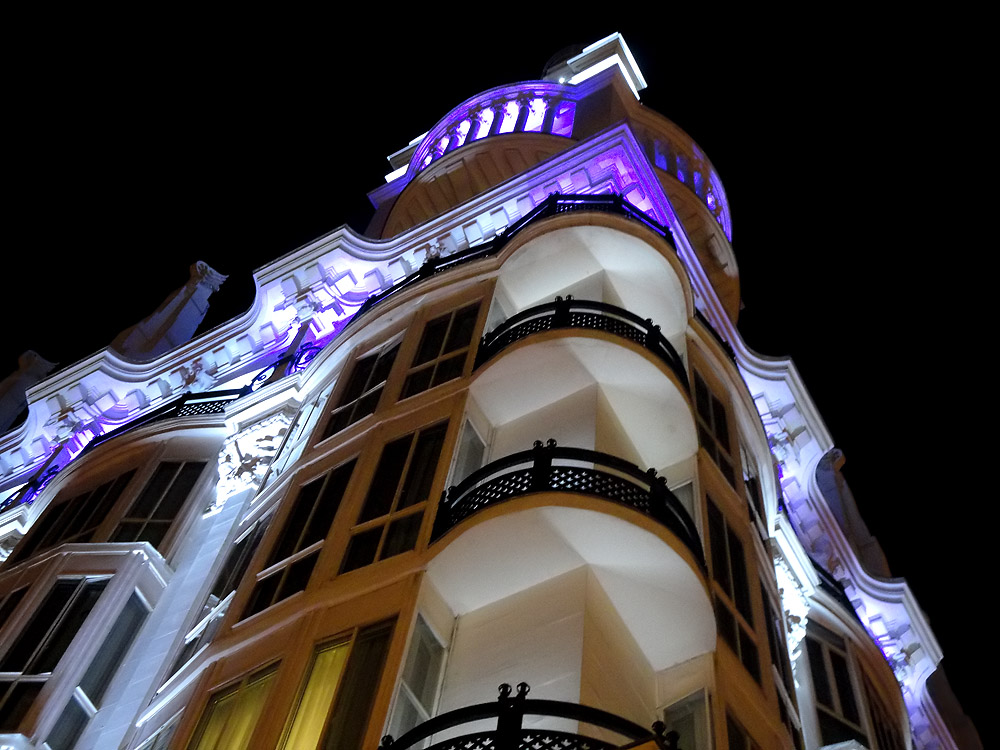
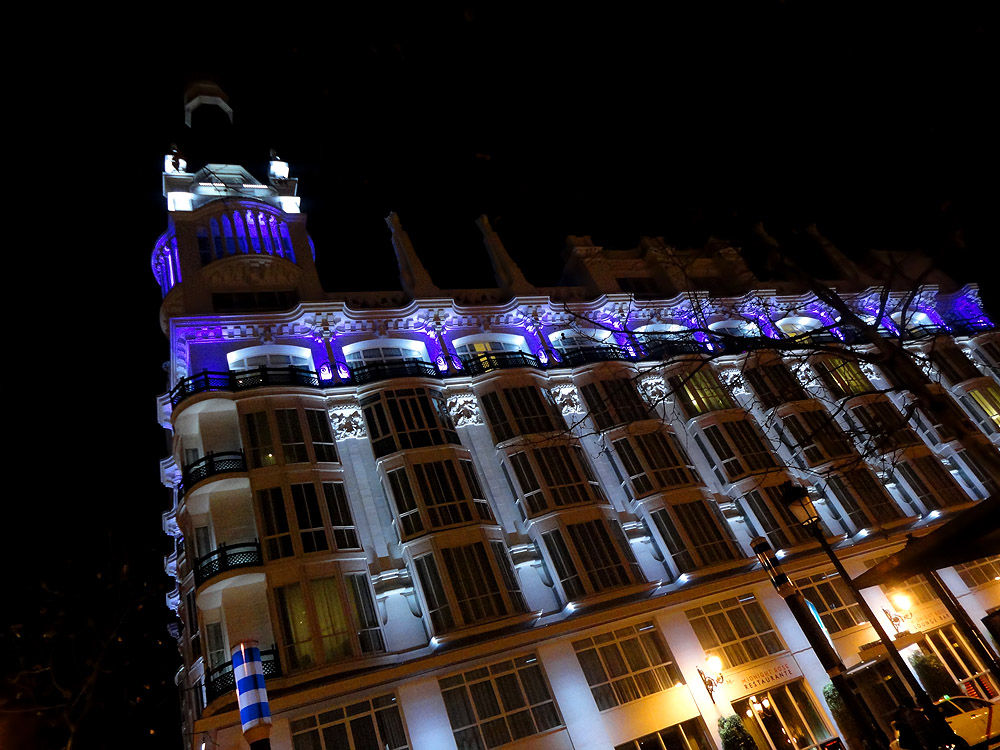
Reina Victoria has a very nice light scheme after dark.
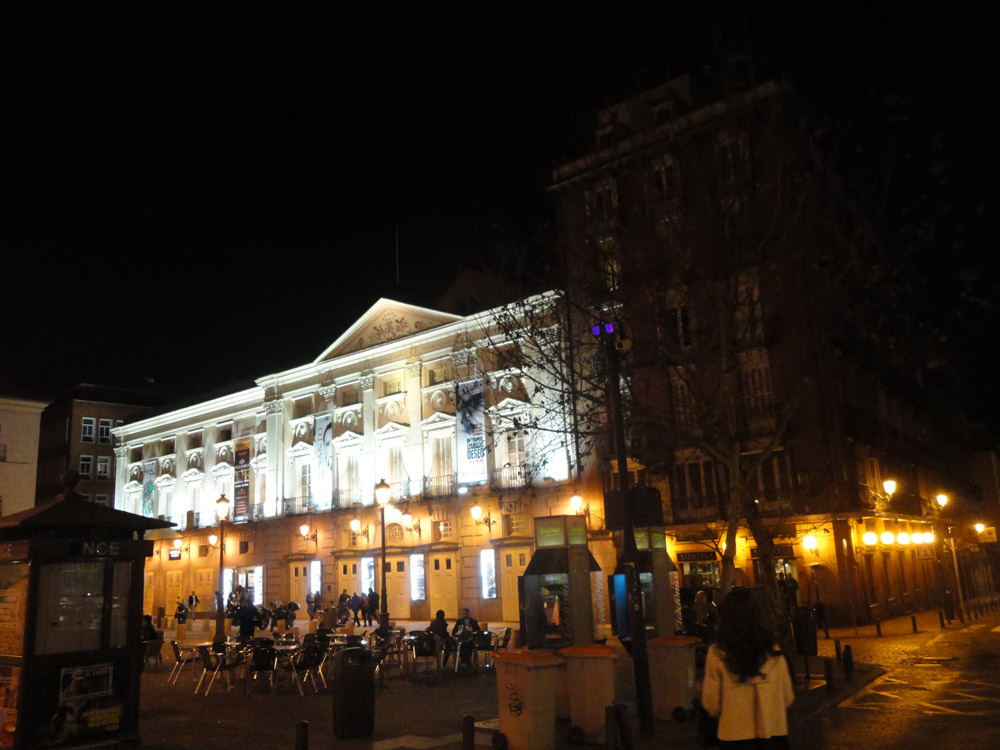

Teatro Español (Spanish Theater). It was built in 1804 after the previous building burned down. In 1975 it was damaged by another large fire, and was repaired.
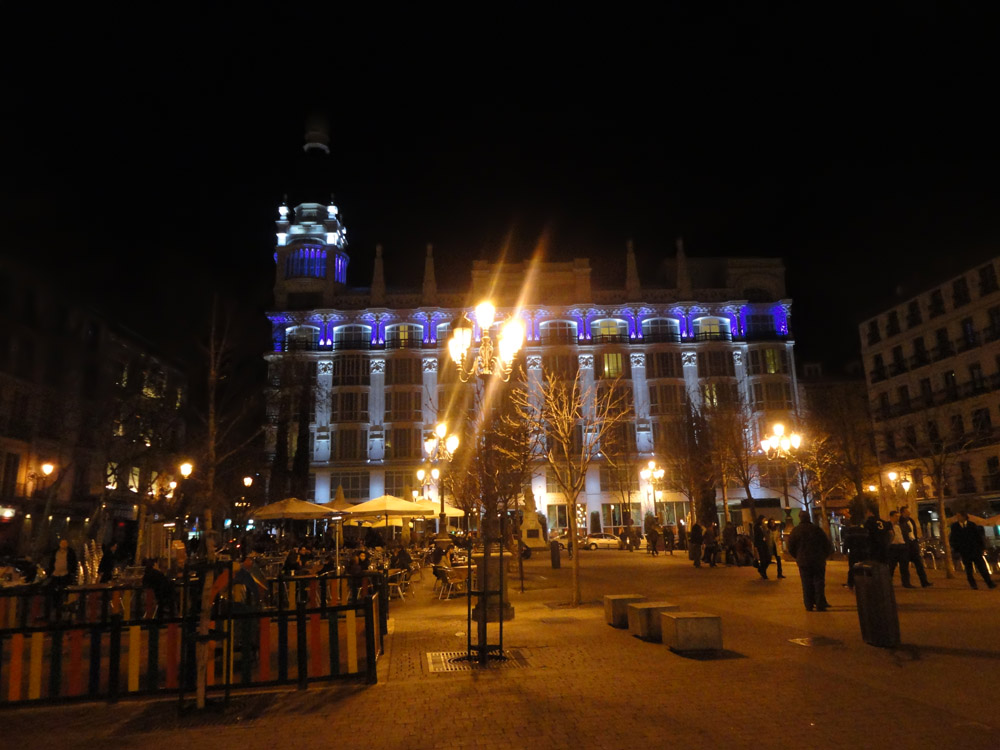
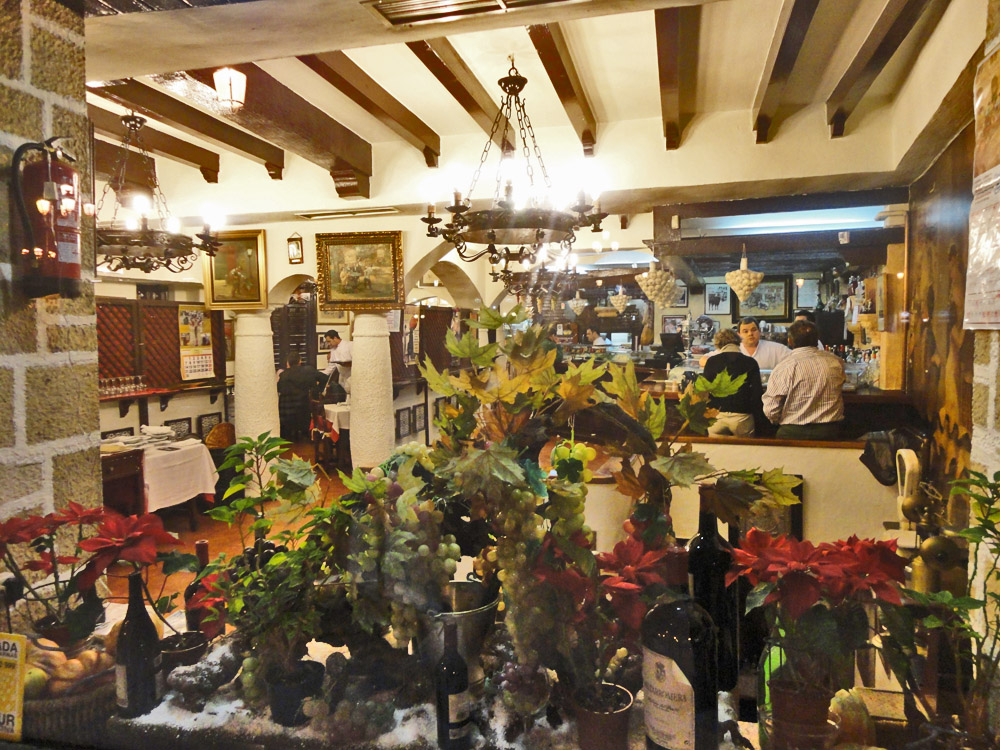
A nice restaurant at Plaza de Santa Ana. In Madrid, the Spanish culture is thrieving with its classical interior.
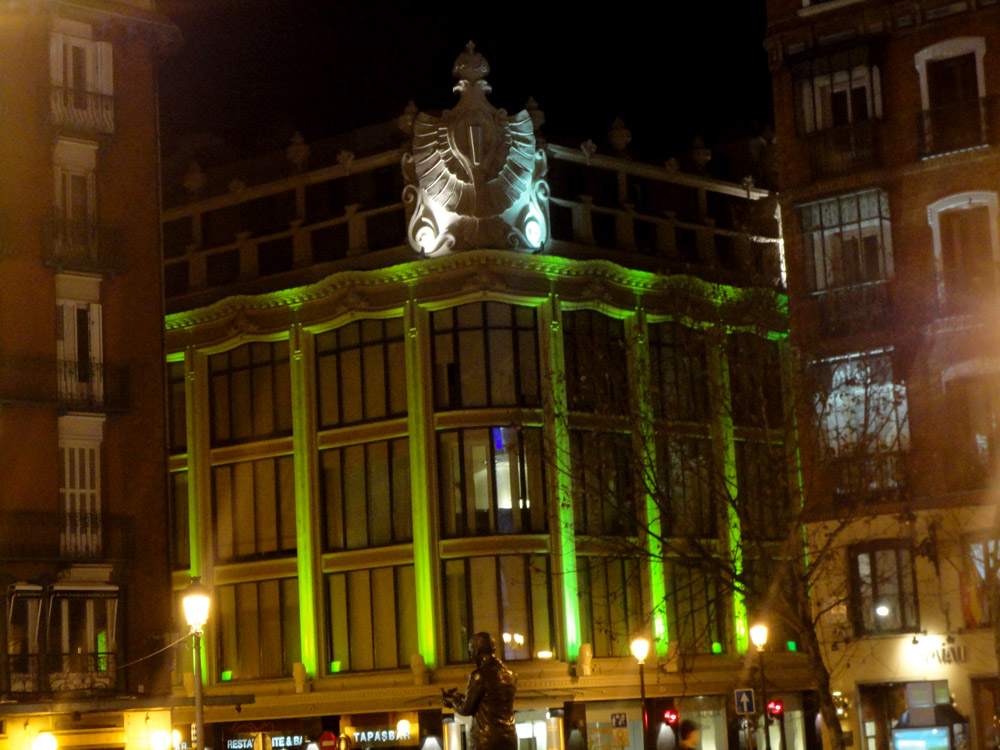
Hotel Alicia, a building with changing neon lights, from green to yellow to violet.

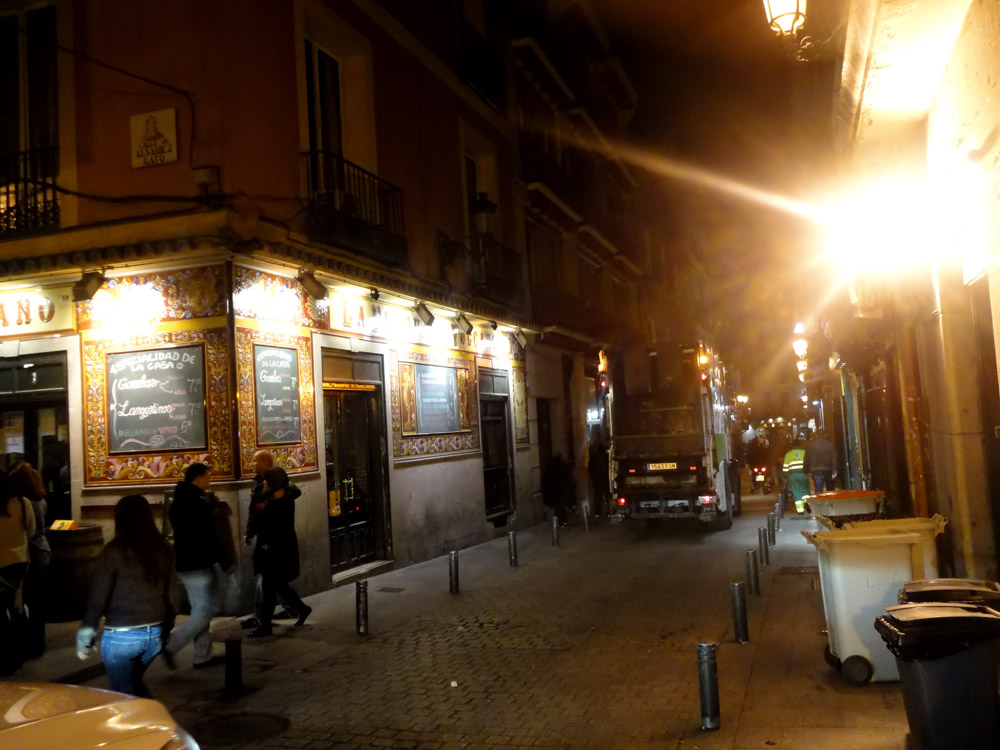
Calle de Nuñez de Arce. In Spain Garbage truck are in operation late evenings, several days a week.
Calle las Huertas
Las Huertas is a very nice, narrow street, parallel to Calle de Atocha. It begins at the beautiful Plaza del Angel and ends at Plaza Plateria Martinez in front of the Prado Museum.
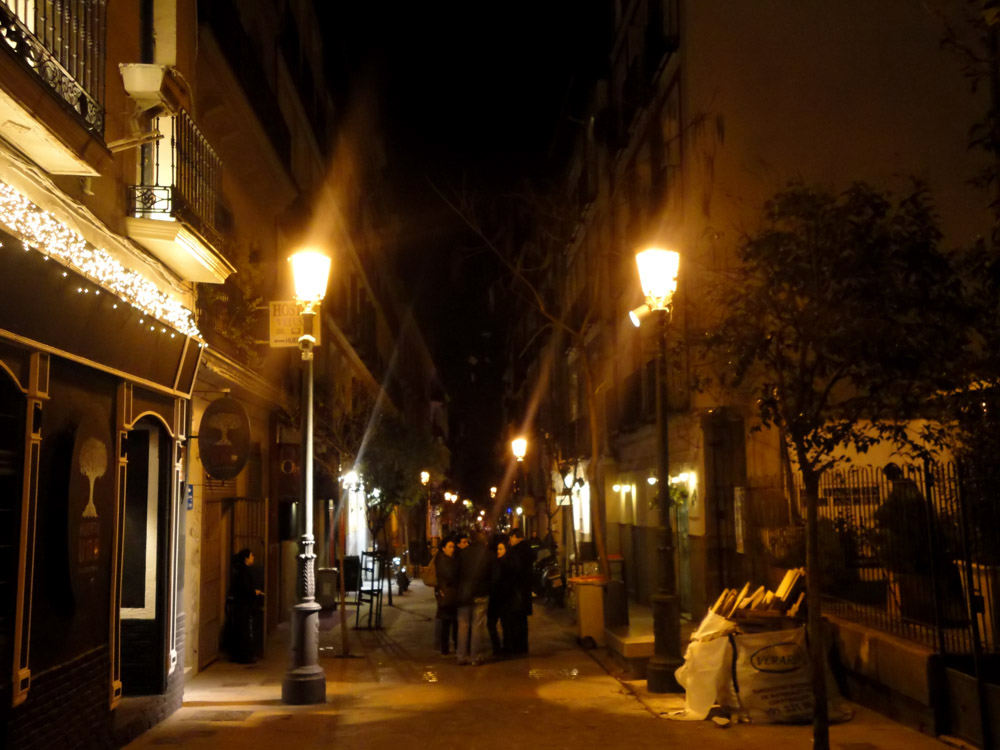
Huertas is one of Madrid's nicest streets with its old fashioned lights and trees.
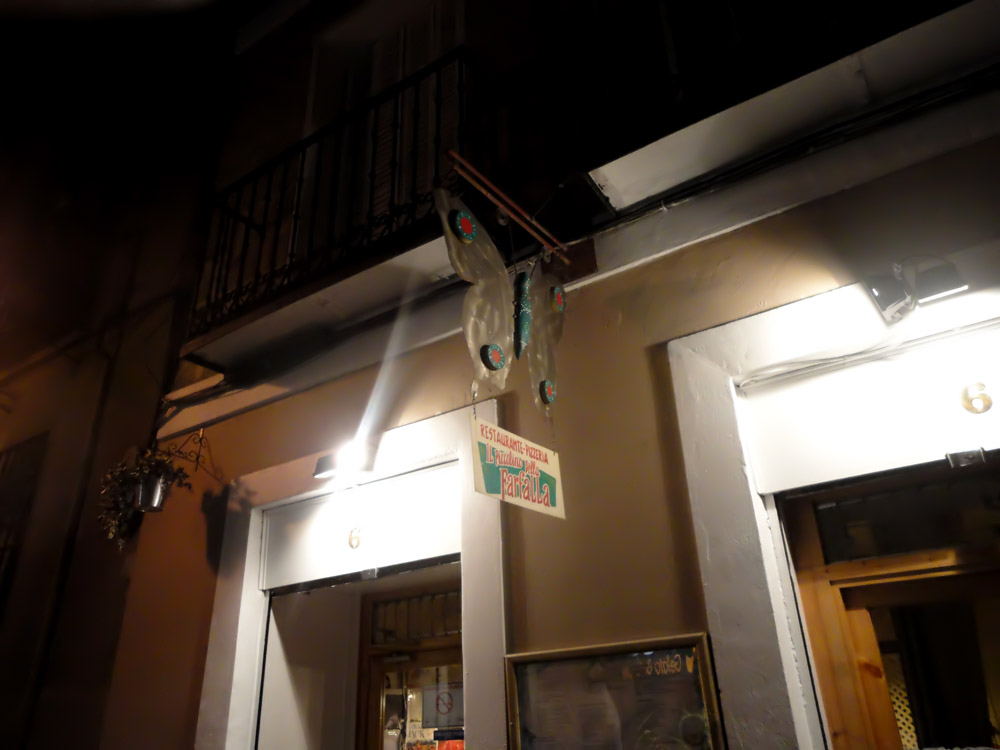
Il Piccolino della Farfalla. A small restaurant at Huertas, the name means something with the butterfly. A cozy place were we ordered steak with potatoes.
Cañizares and Cat's Hostel
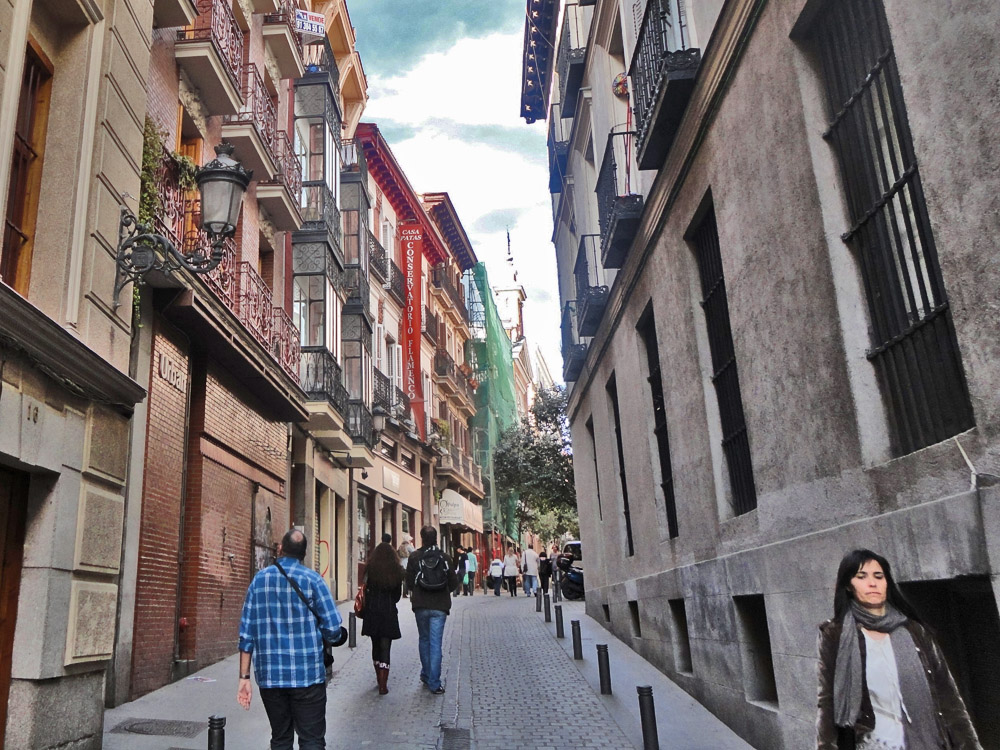
Cañizares a small side street to Calle de Atocha, close to Plaza Santa Ana. Cat's Hostel, a place were I stayed for the last half of the trip, is the building behind the green scaffolds, next to a small church.
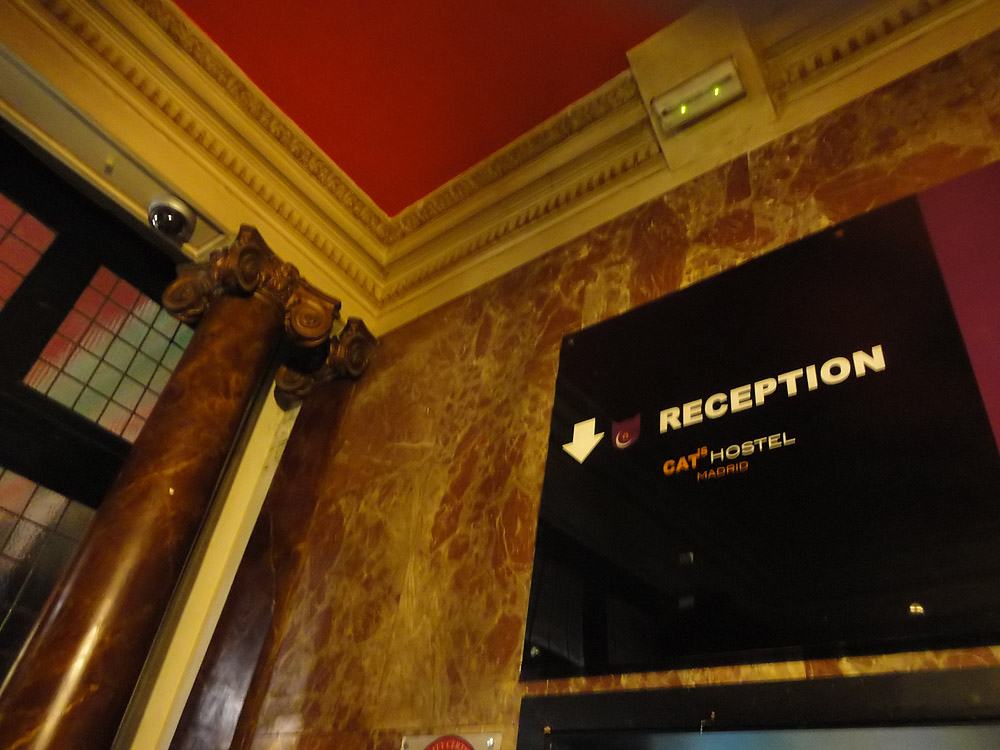
I took this picture while checking in at Cat's Hostel at . I couldn't afford to stay longer at the 4 star Mercure, since my girlfriend had to go home. But it was ok for being a hostel, the building is a protected historical landmark, since it is located in a former moorish palace.
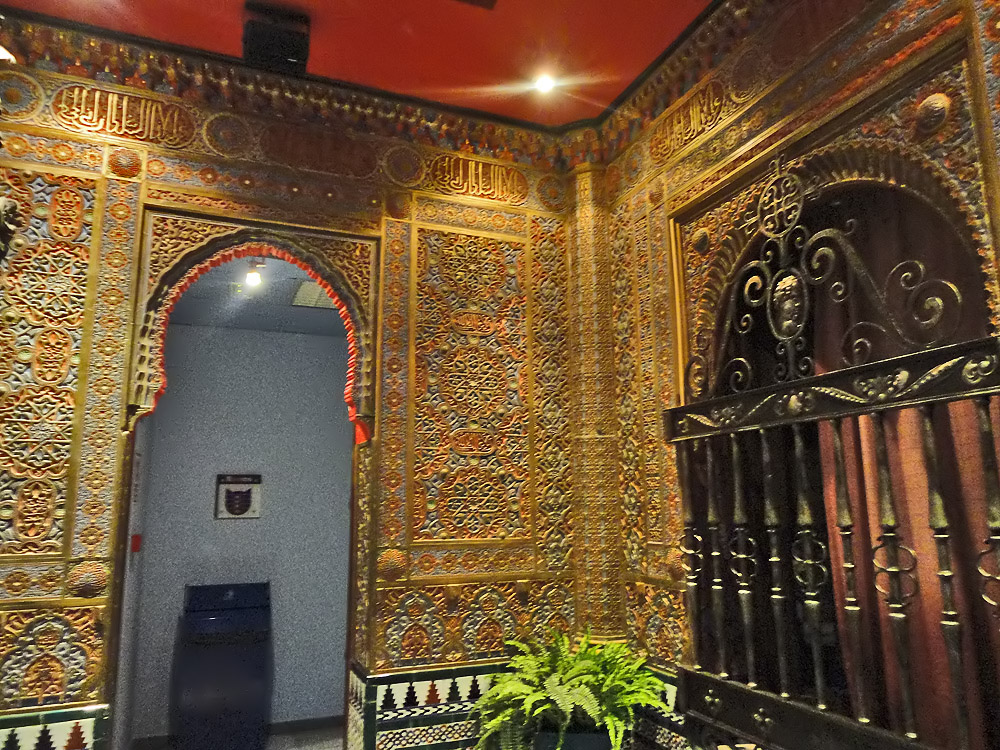
The moorish architecture is visible everywhere, truly unique. I meat people mostly form Brazil and Mexico, but also France and Peru. Most of the staff were friendly.
Overall a nice stay!
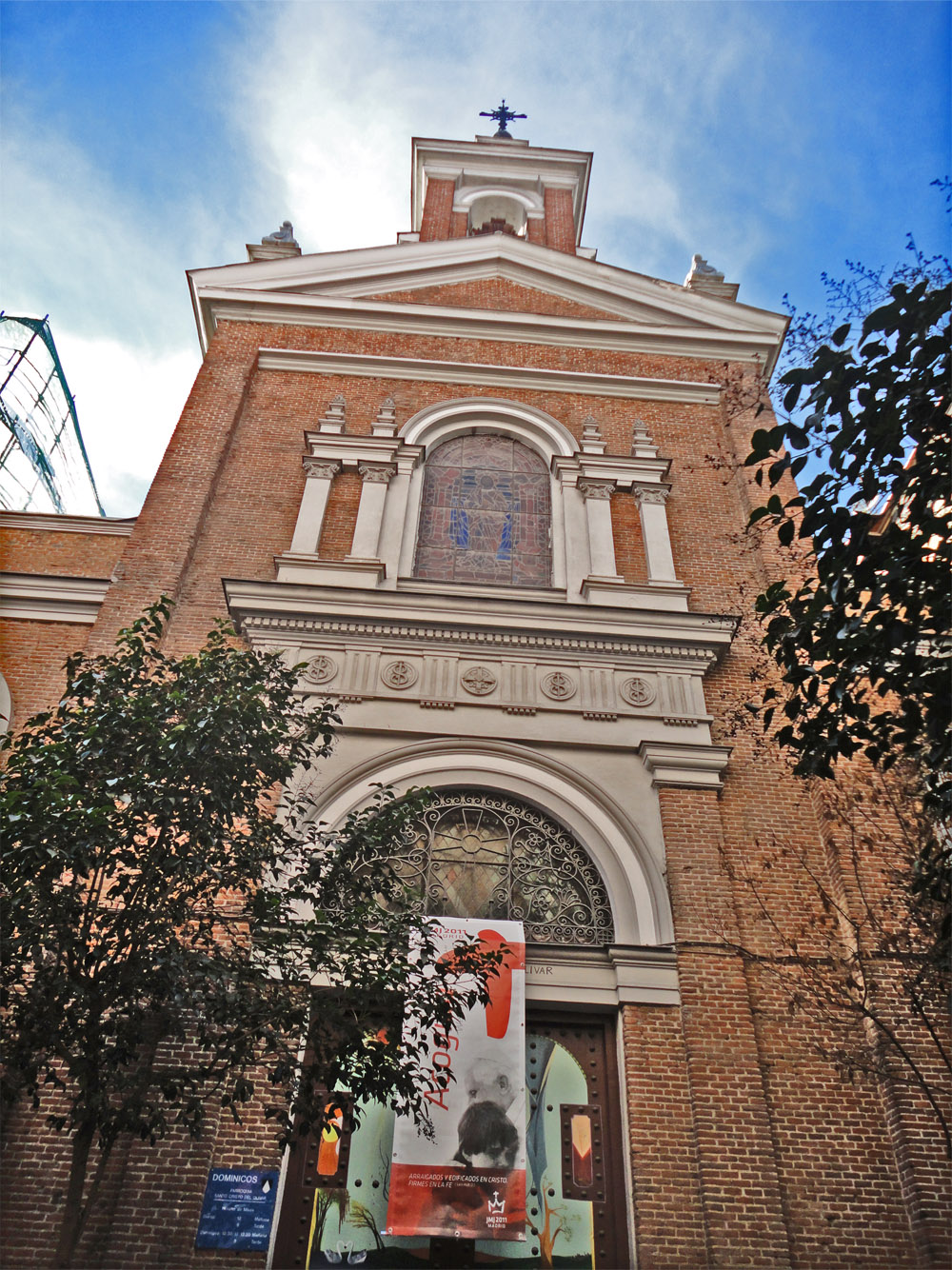
The small church at Cañizares, next to the hotel.
AZCA Business Area
- Bernabéu Stadium, Hospital de Maudes and Paseo de Castellana
AZCA, sometimes called "Madrid's Manhattan", is a business district situated a couple of blocks North of the city center, along Paseo de Castellana, the road that continues through the Kio Towers and then passes the 4 towers of Cuatro Torres, just next to the huge Santiago Bernabéu Stadium. Since it was built in the 70s, the designs of the towers are a bit more traditional and boxy, and also lower, then Cuatro Torres.
But still it is the area with the largest number of skyscrapers concentrated and it looks beautiful in a special way. The area is dominated by the famous Torre Picasso, Madrid's tallest building before Cuatro Torres were built. The area was pretty empty during my visit, except for a few skateboarding youngsters, since I was there on a Sunday. The area has much greenery as a contrast to the concrete towers, especially on Plaza Picasso, the cubistic square that is the heart of the district. In the last part of this page you can read about Hospital de Maudes, a beautiful hidden architectural gem.
AZCA is the short form for the Spanish words meaning "Mixed Association for Compensation of the A Block of the Commercial Area of the Avenue of Paseo de la Castellana". The original conception dates back from 1946, but nothing happend for decades. In the 1970s, the construction finally begun.
2 large disasters have been taking place in the area: In February 2005 the 106m tall Windsor Tower was destroyed by a fire, but a replacing tower is under construction (you can read more about it further below). In 2002 a car bomb damaged Torre Europa and 16 persons.

AZCA district skyline.
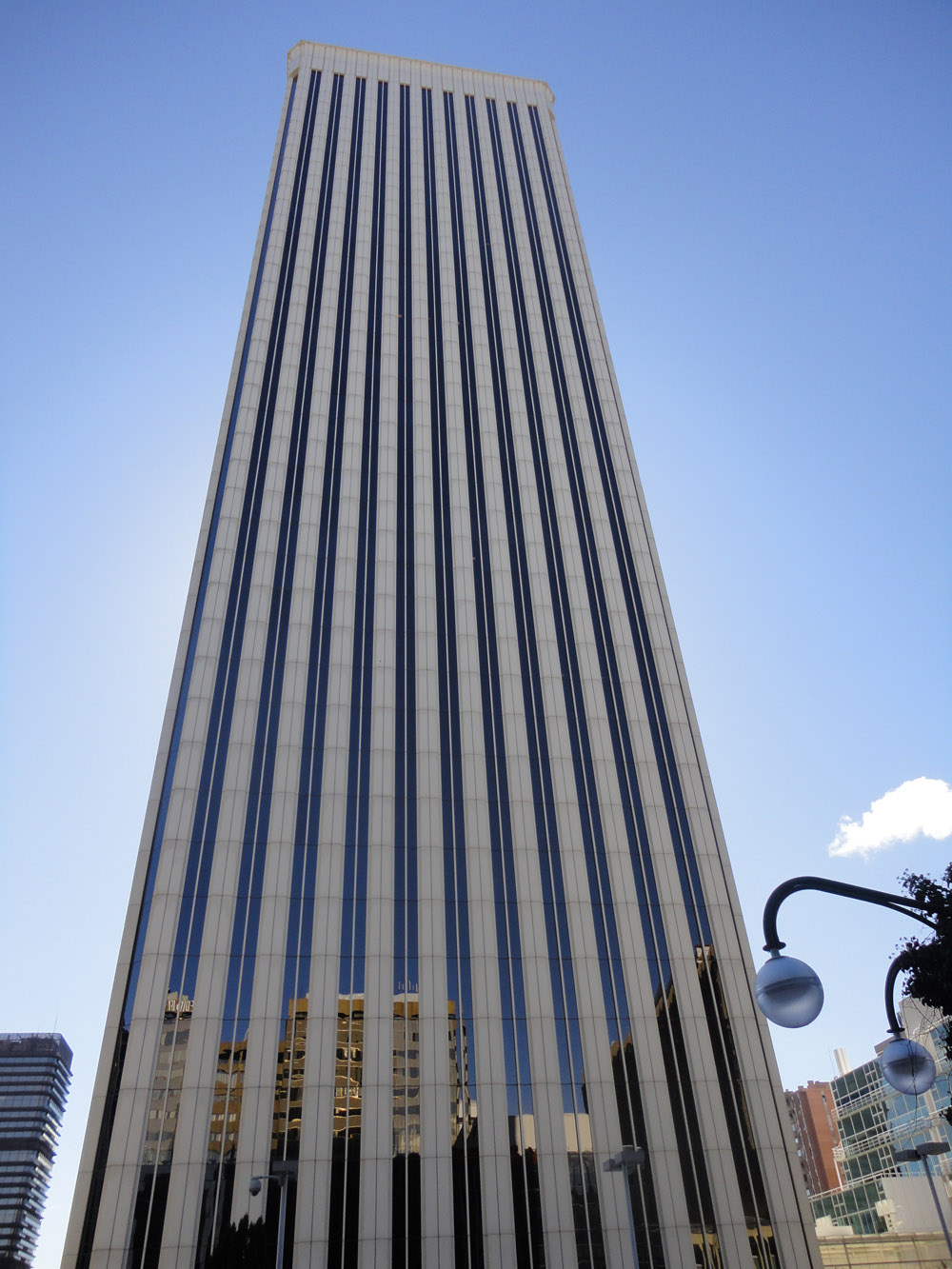
Torre Picasso is the tallest, most beautiful and most famous skyscraper in the AZCA district. With a height of 157m it is currently the 5th tallest Madrid building, but it was the tallest when it was completed in 1989 and held the title as Spain's tallest building until it was overshadowed by Gran Hotel Bali in Benidorm in 2002, and in 2008 by the 4 skyscrapers forming Cuatro Towers further North.
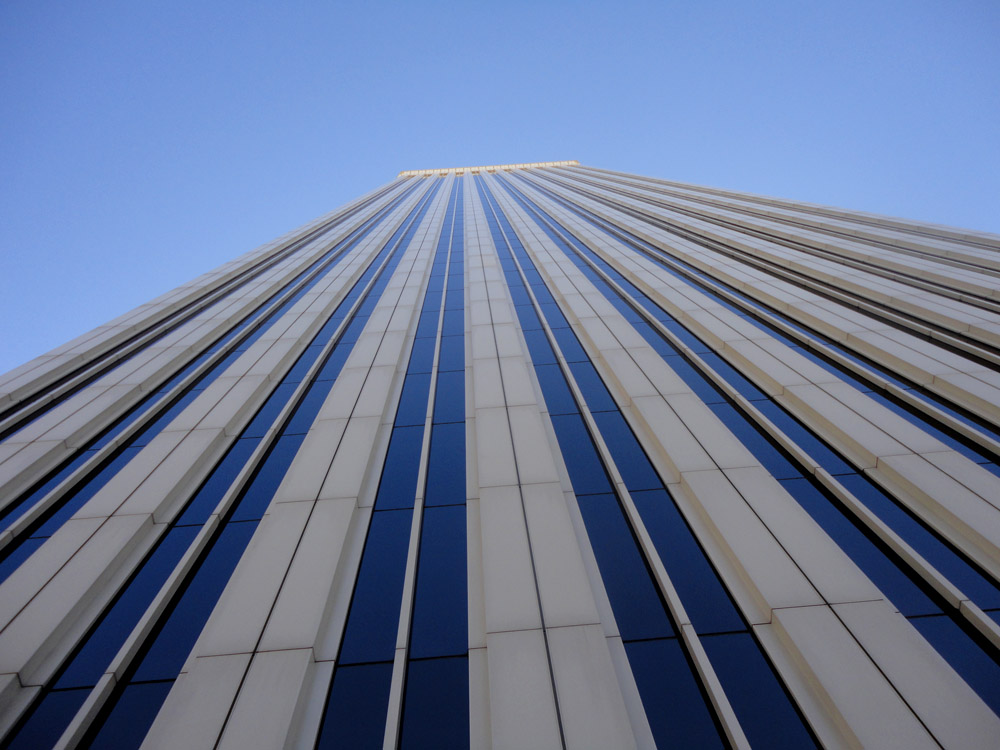
Torre Picasso was designed by Minoru Yamasaki, who also designed the now destroyed WTC in New York. From beneath you can clearly see it resembles WTC.
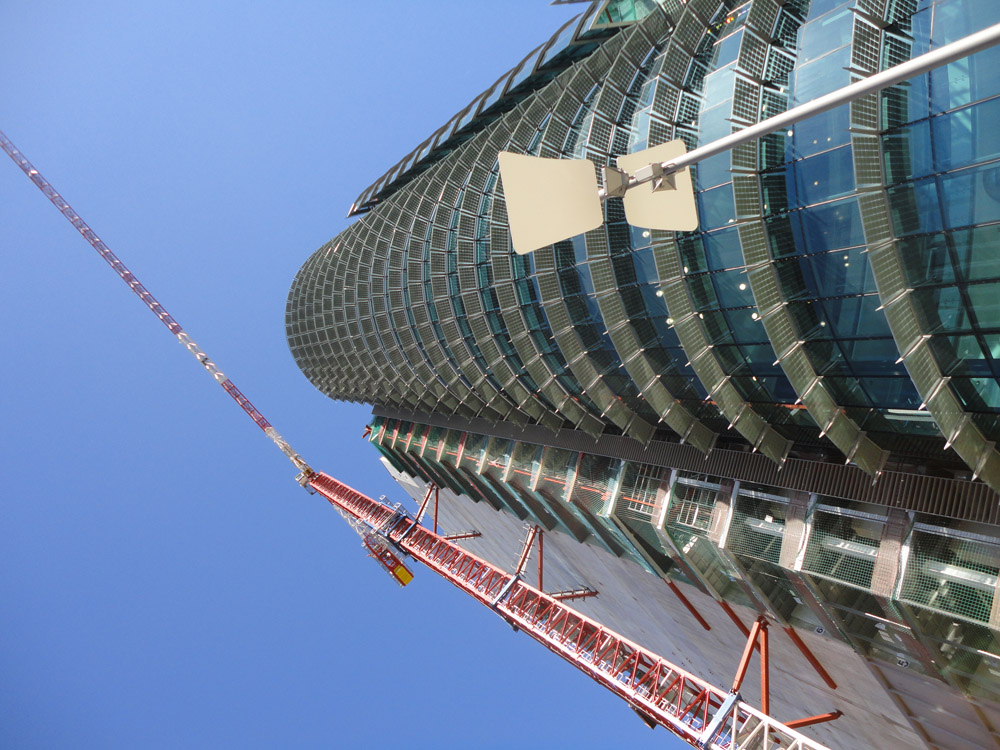
Nueva Edifico Windsor, New Windsor Tower. This circular green glass skyscraper will replace the destroyed Windsor Tower, that was a more boxy tower with a golden glass exterior. It will be just 94 m tall, 10m lower then the original, and have 21 floors.
In February 2005 the 106m tall the old Windsor Tower from 1979 was destroyed by a fire, one of the worst fires in Madrid. Because of the damage it had to
be torn down. Fortunately noone died, since the building was closed, because of renovation works. It was initially thought that the cause of the fire was an electrical fault, but evidence from video tapes show that it could have been an arson.

A large brande of the department store El Corte Inglés is just next to the new Windsor Tower that is under construction (2011).
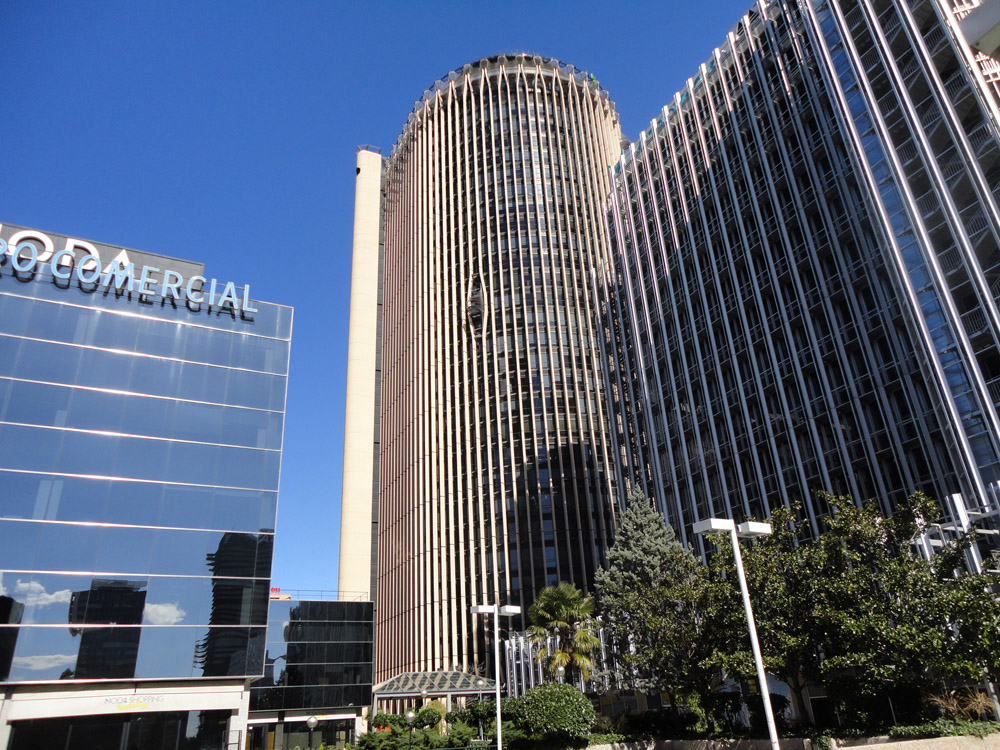
Torre Europa has 30 stories and is 121m tall. The round glass structure with external concrete columns was built between 1975 and 1985. On May 1, 2002 a car bomb with explosives was set off in front of the Torre Europa, injuring 16 people and damaging the exterior.
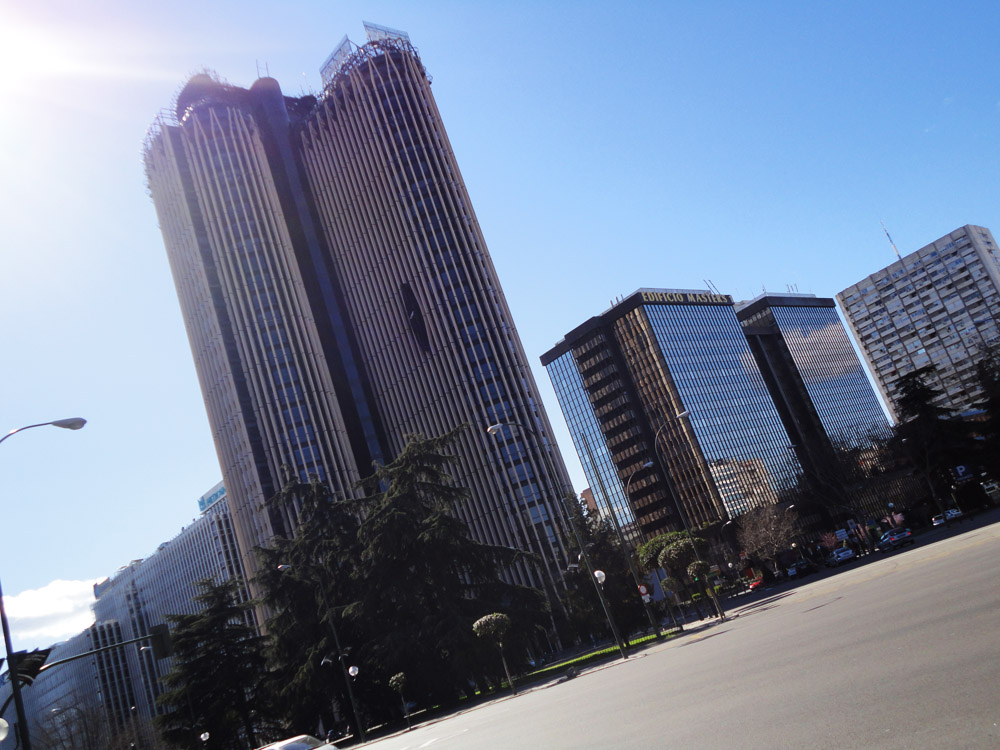
Torre Europa and Edificio Masters, seen from the North end of the district.
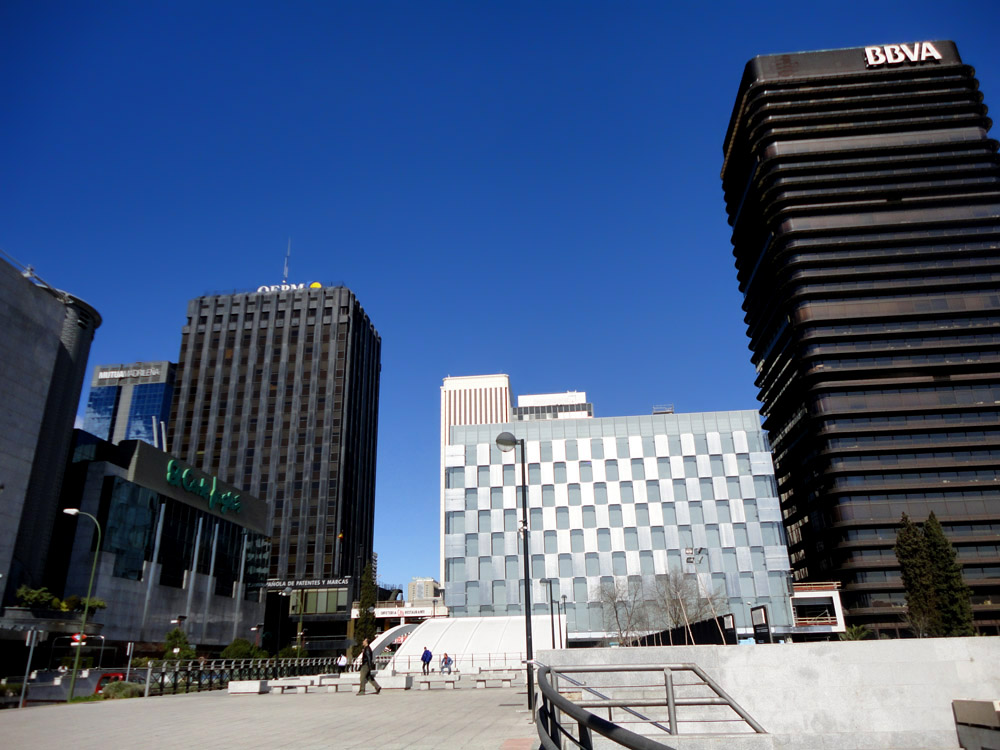
El Corte Inglés and the rust-colored Torre de Bilbao, or BBVA building (right). BBVA stands for Banco Bilbao Vizcaya Argentaria. It was built in 1980 and designed by the Spanish architect Francisco Javier Saenz de Oiza.
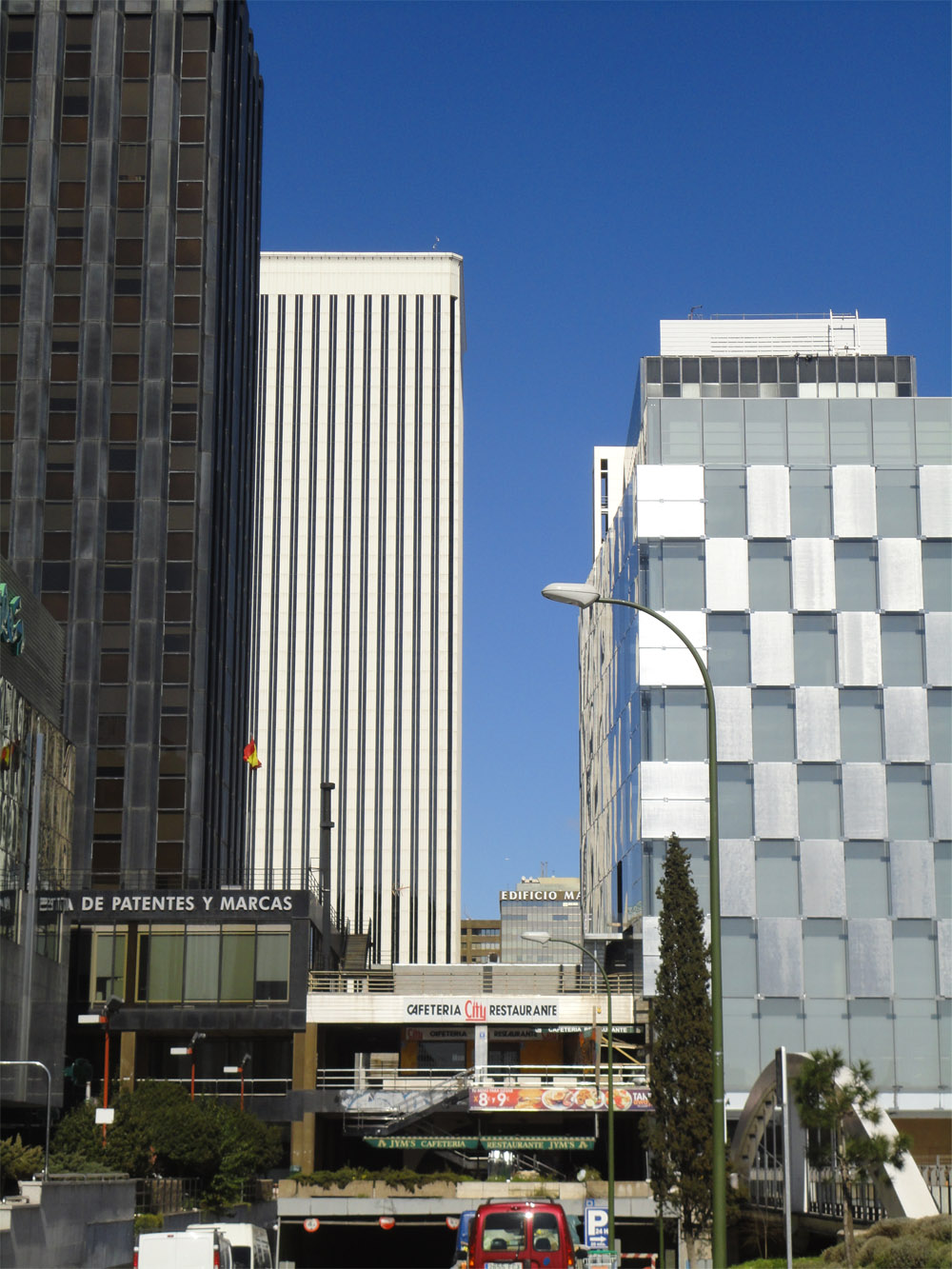
Manhattan looking view with Torre Picasso in the back.
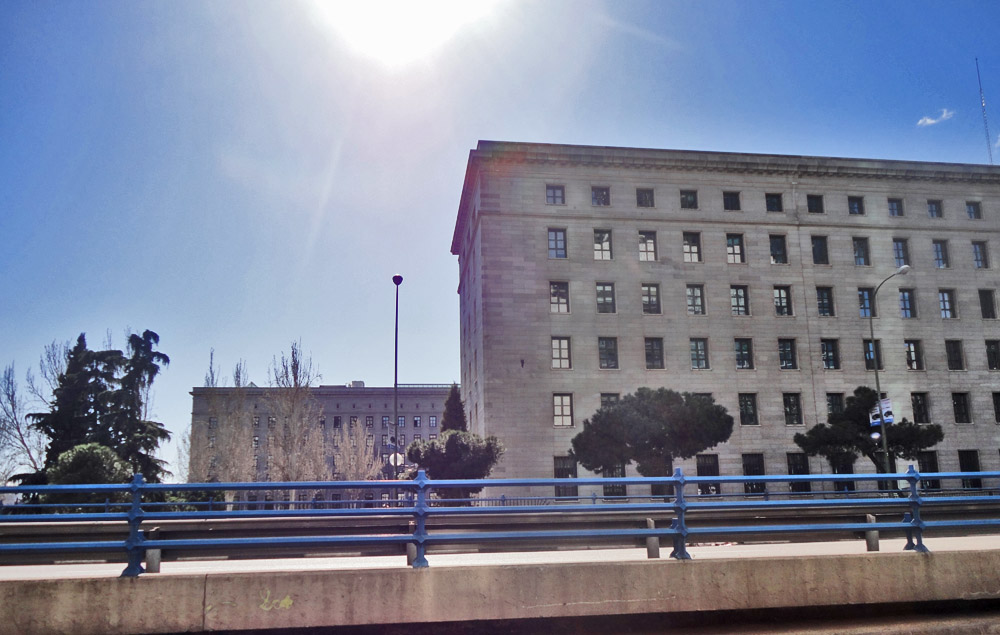
Nuevos Ministerios. A large ministerial complex.
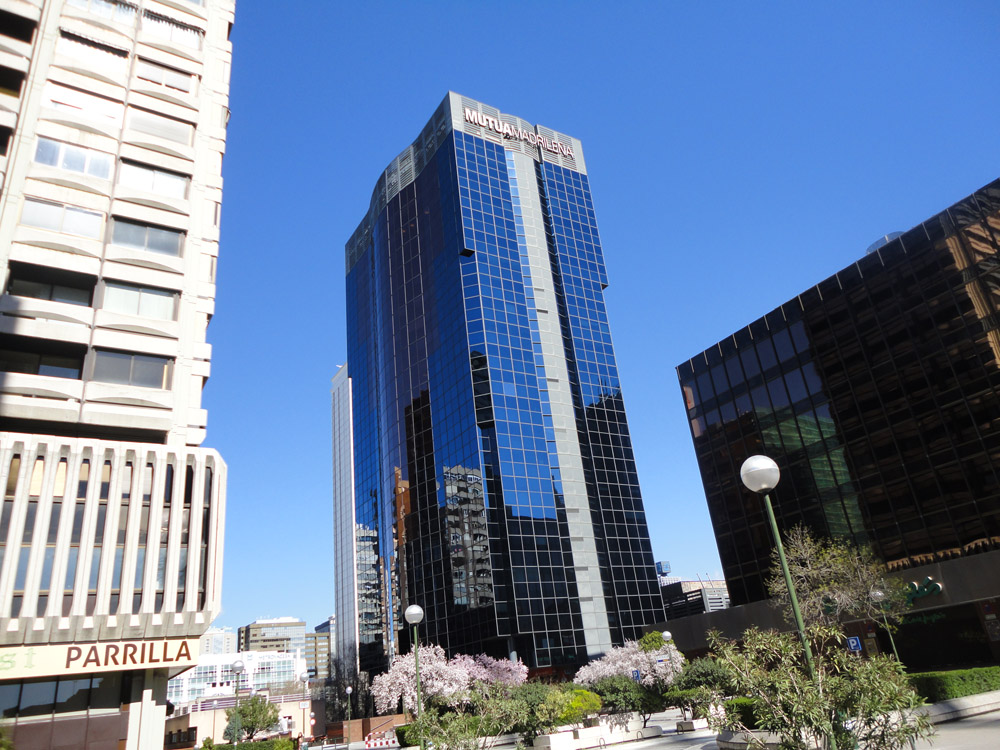
Torre Mahou. A postmodern 29-storey highrise from 1989. It stands 105m tall and has a curvy blue glass exterior.
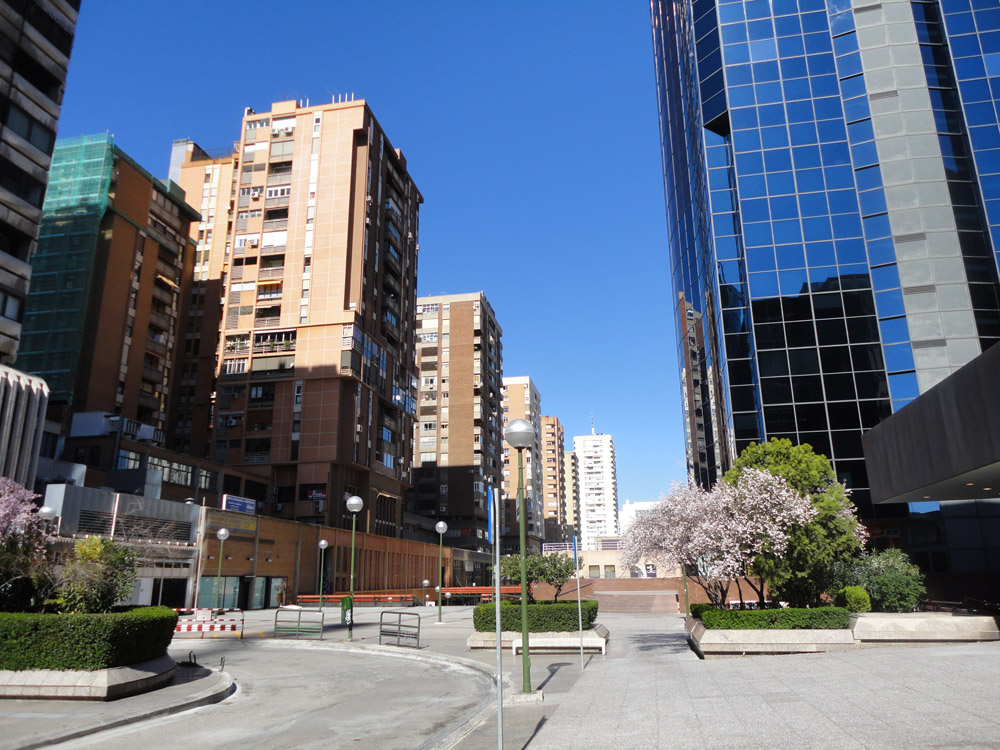

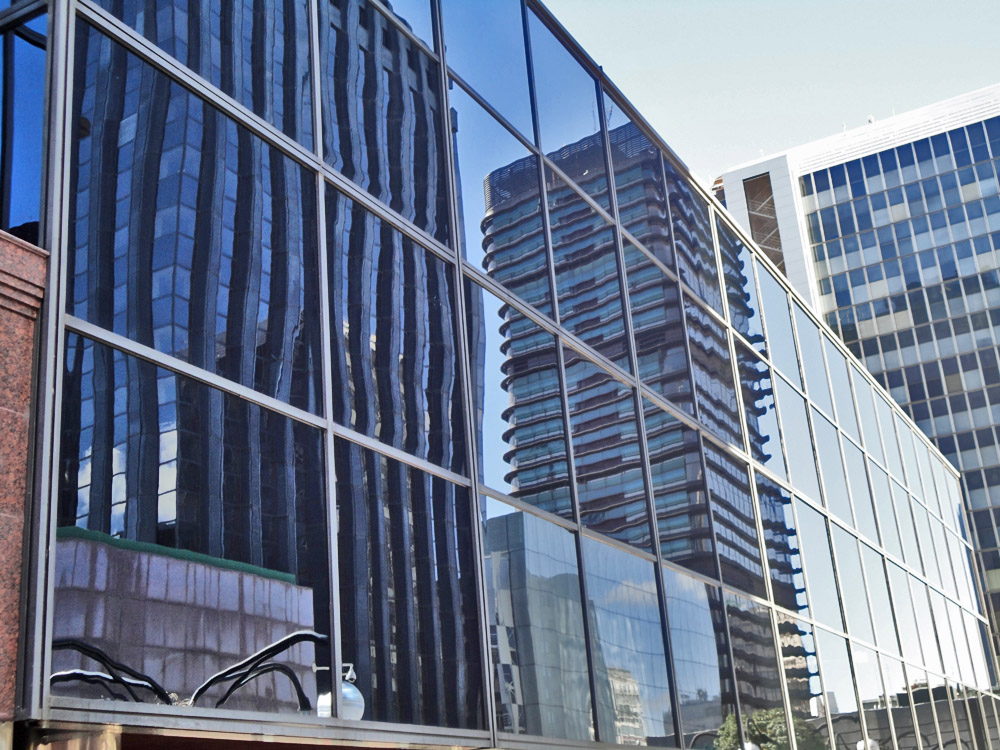
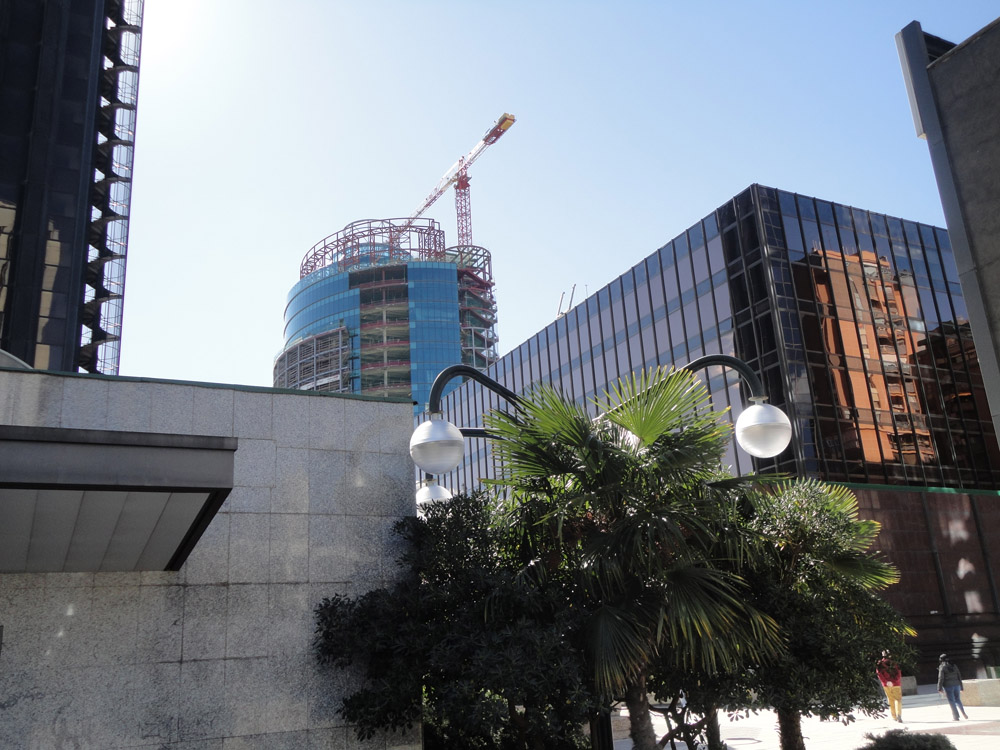
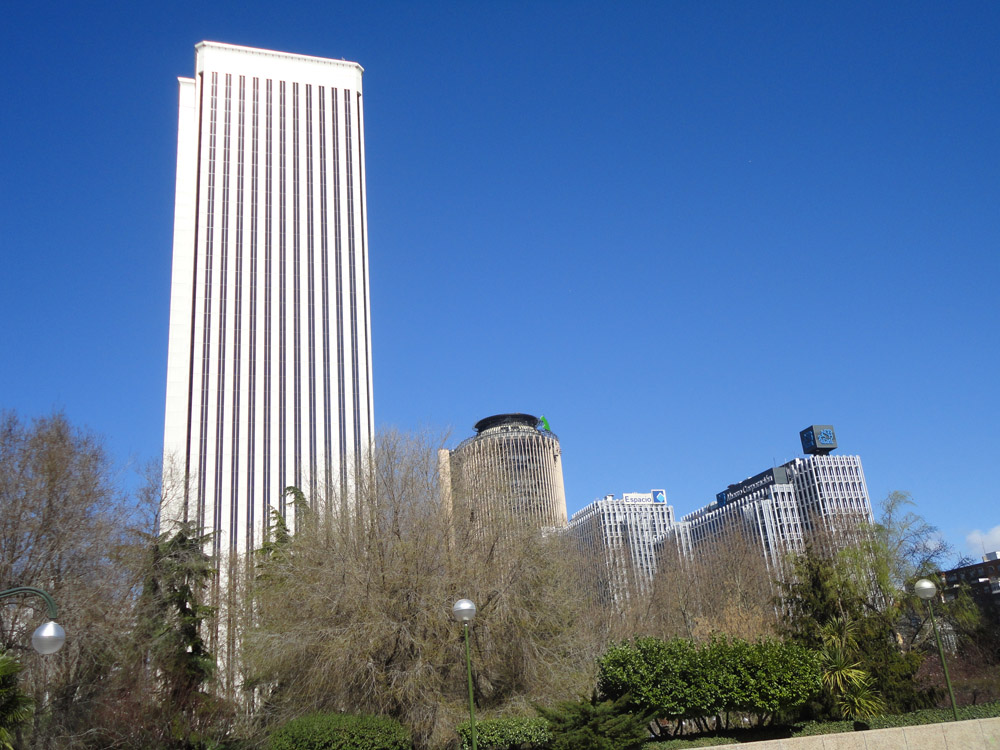
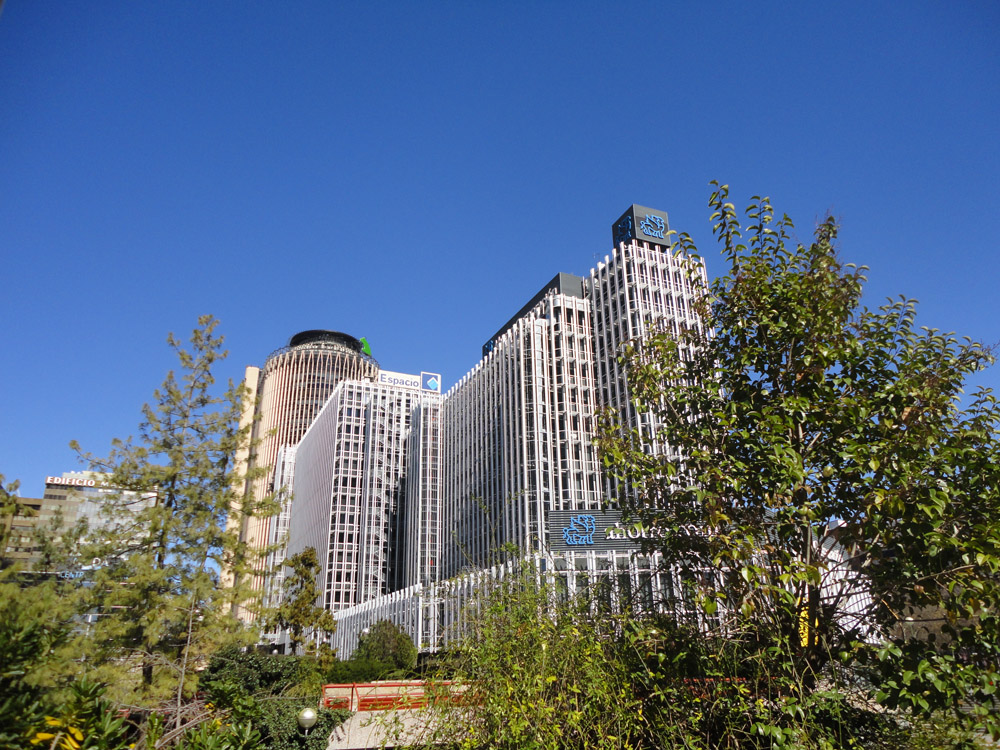
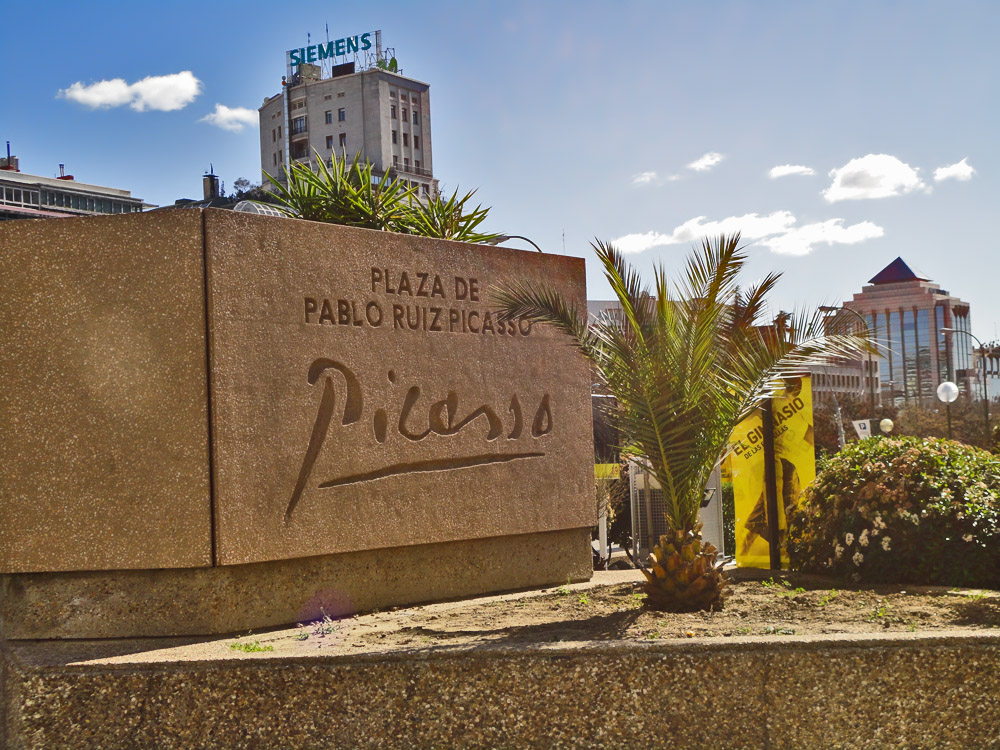
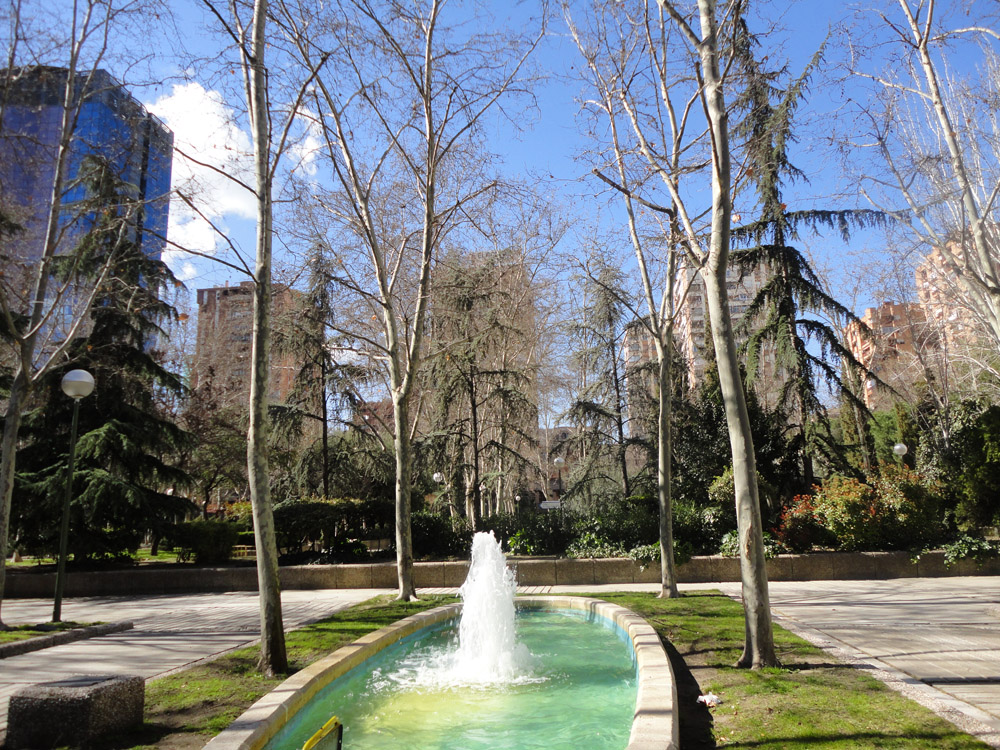
Plaza de Picasso.
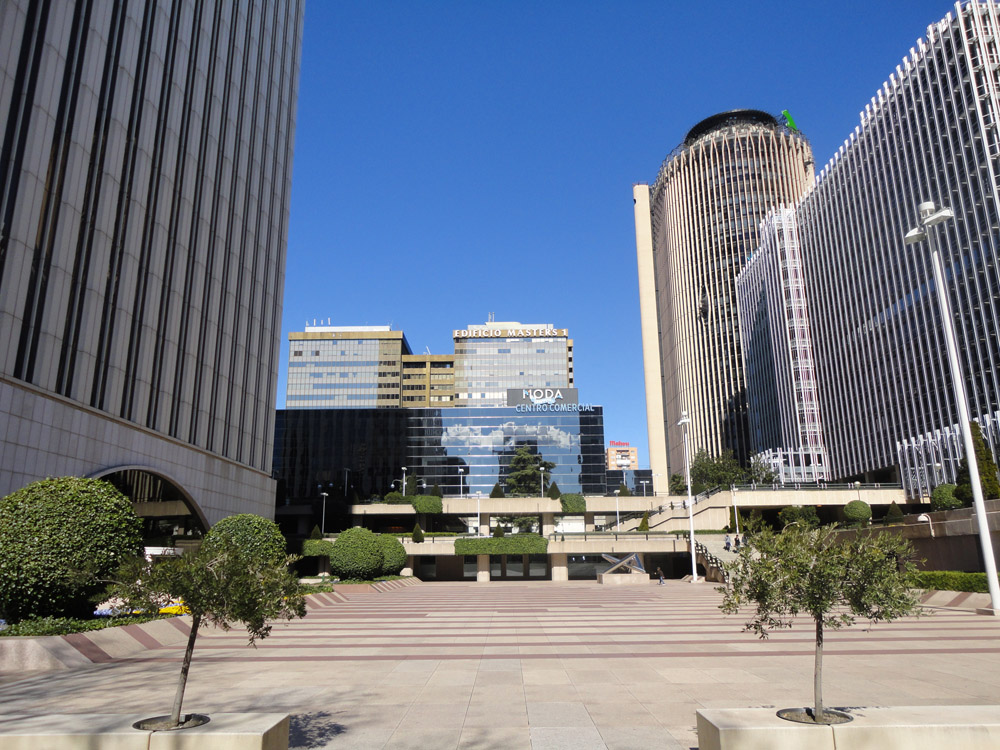
Plaza Picasso, the modern cubistic square named after Picasso, the father of cubism, is the heart of the AZCA district.
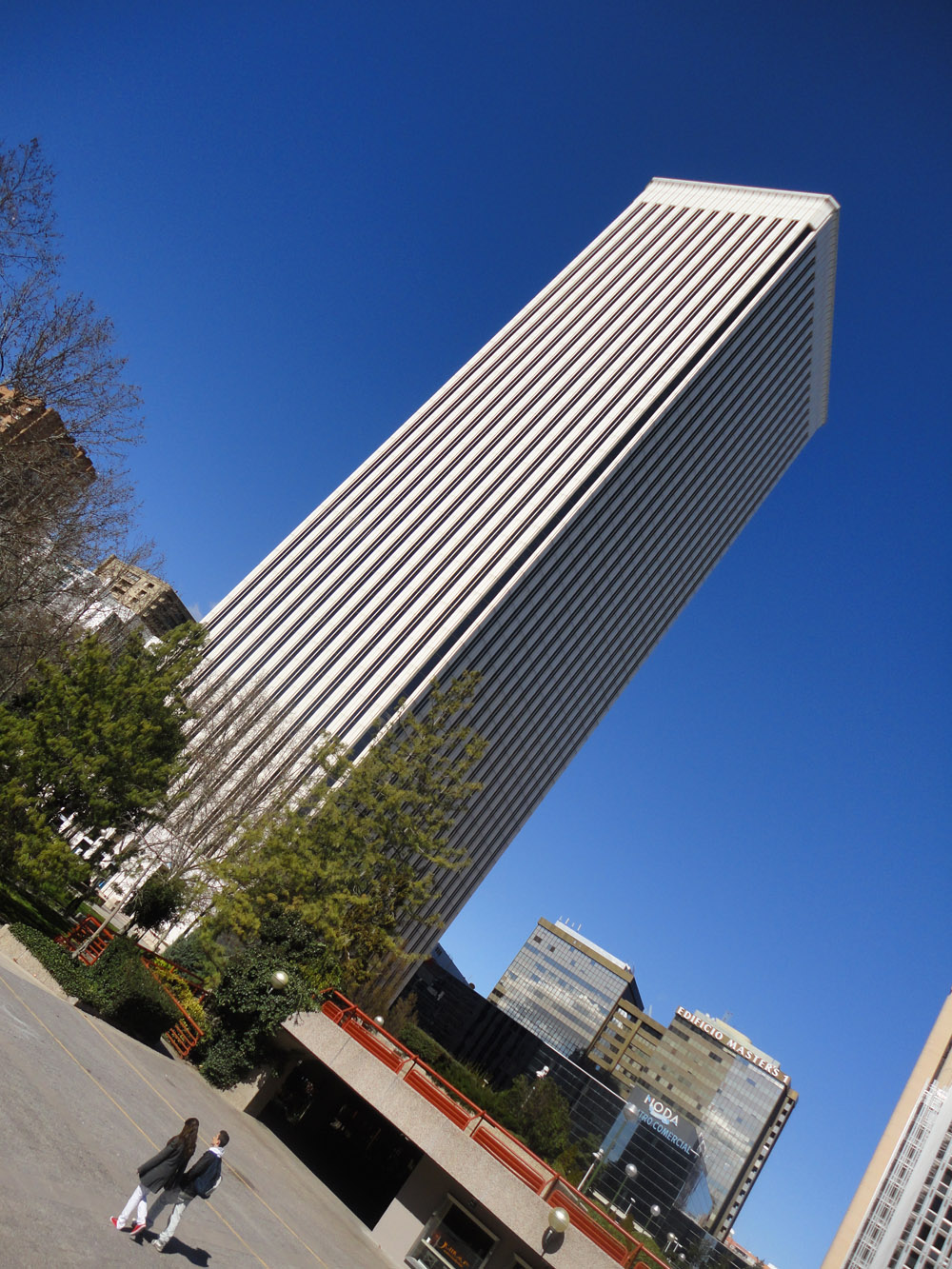
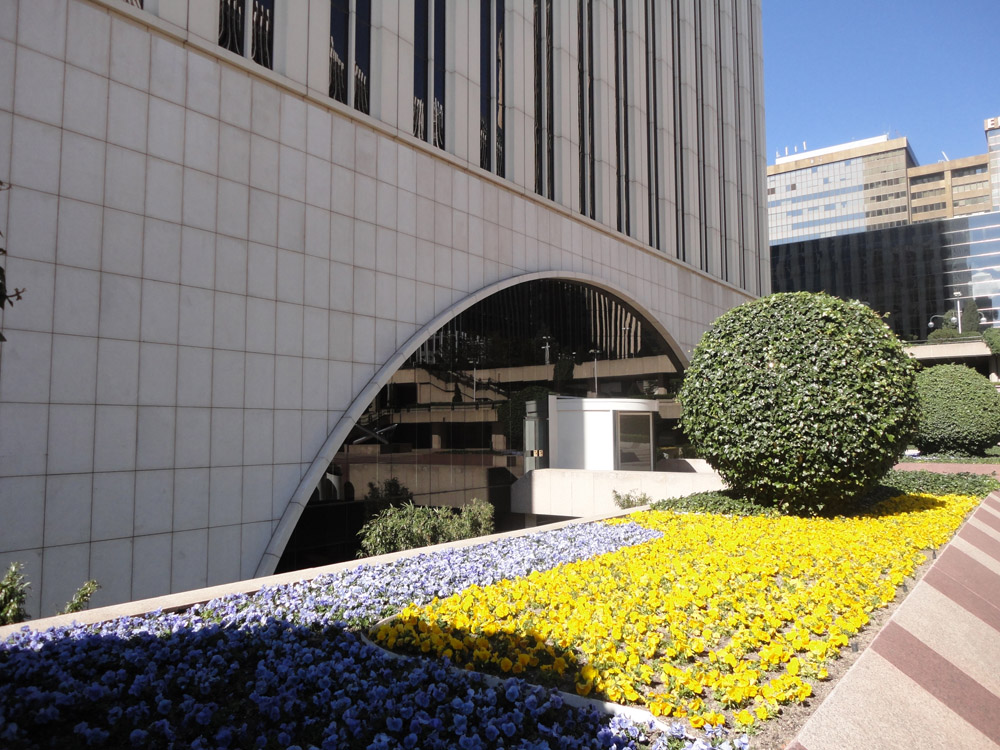
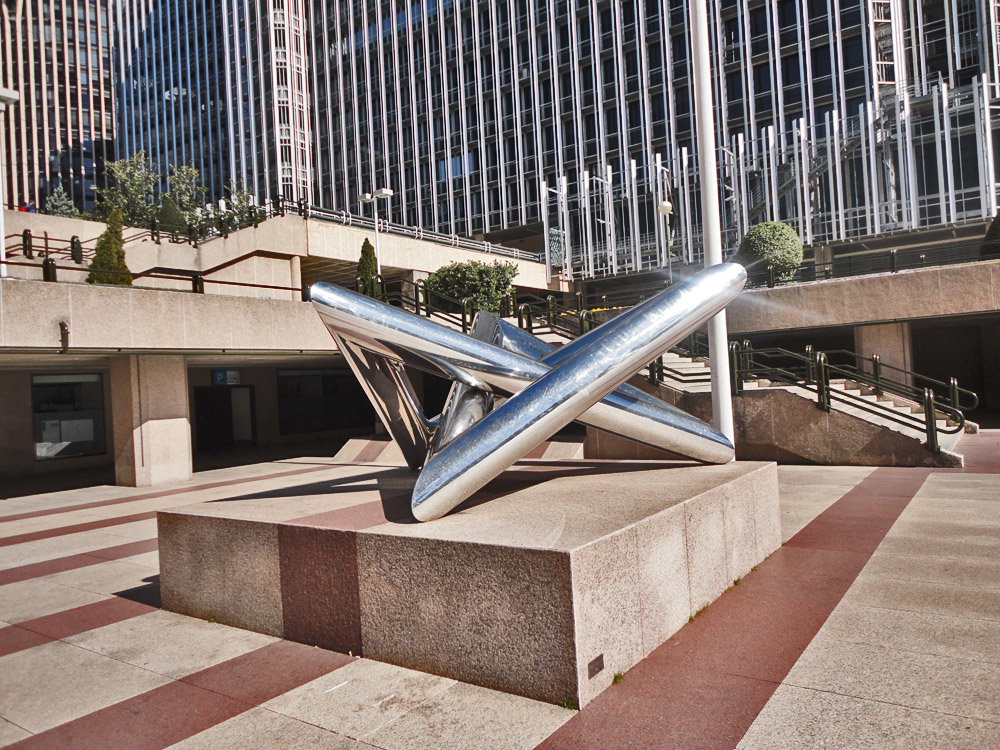
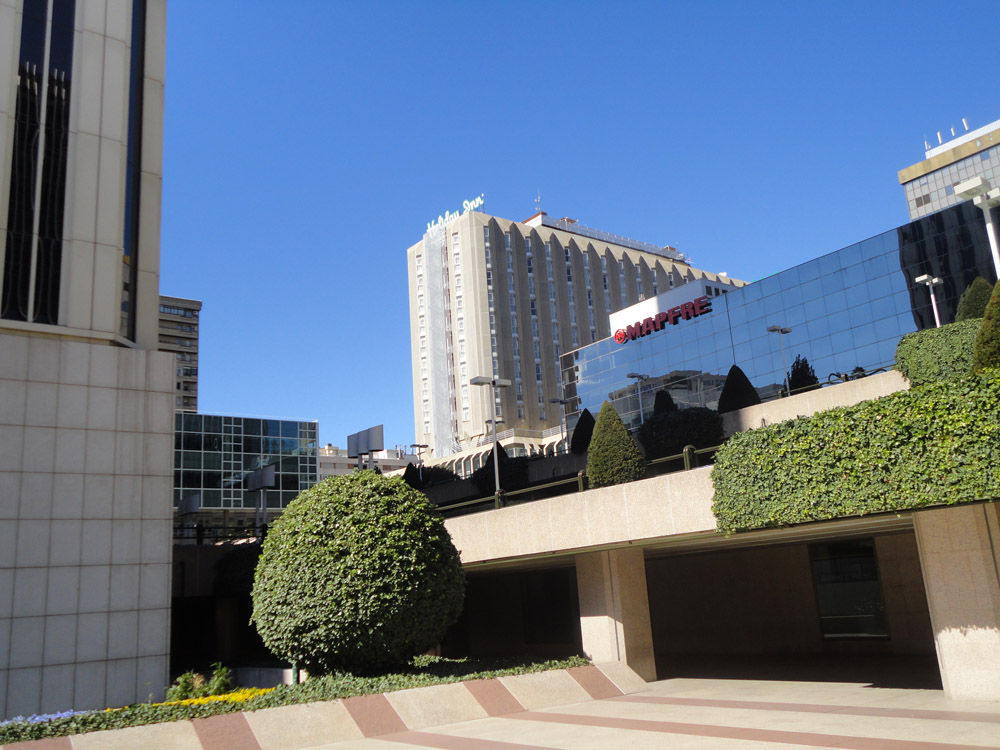
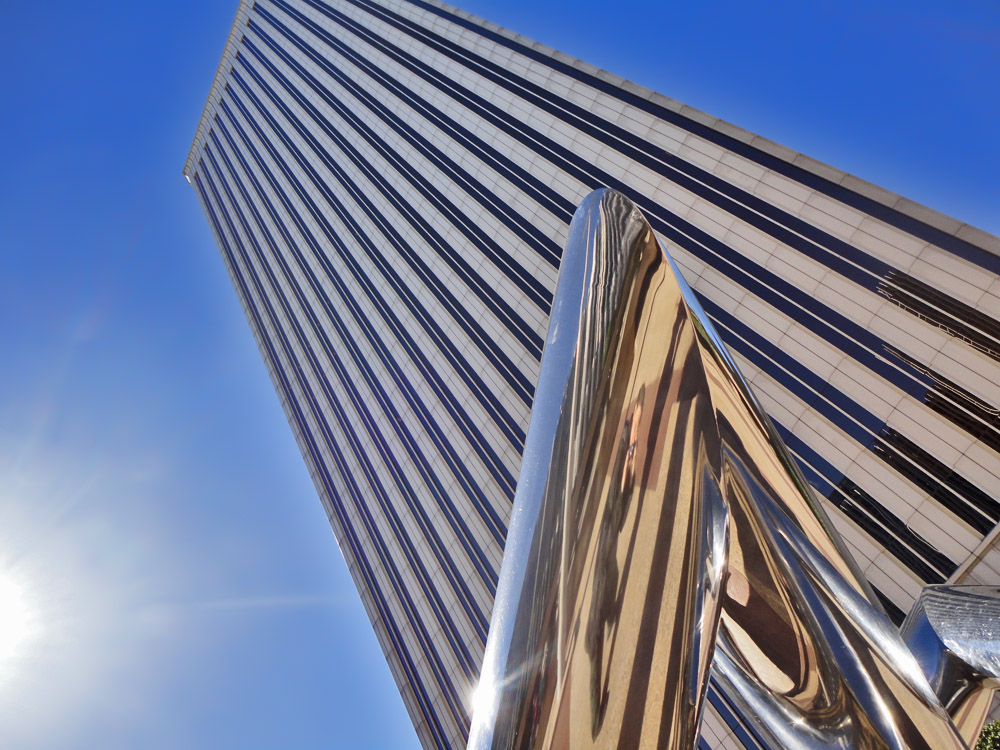
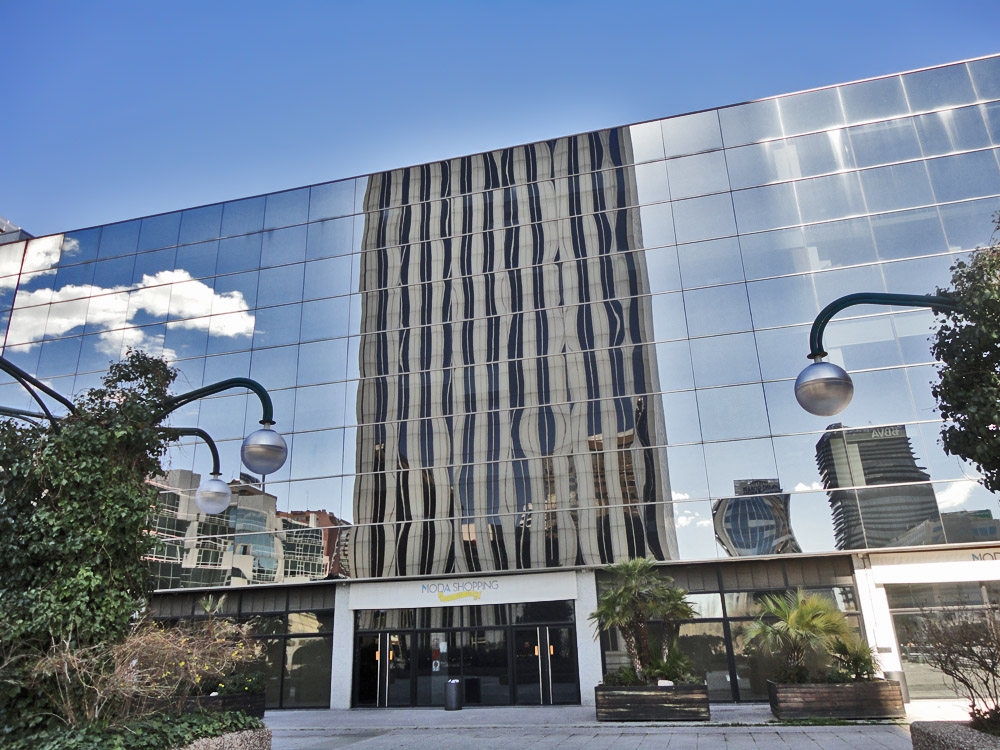
AZCA:s skyline from Plaza de Picasso.
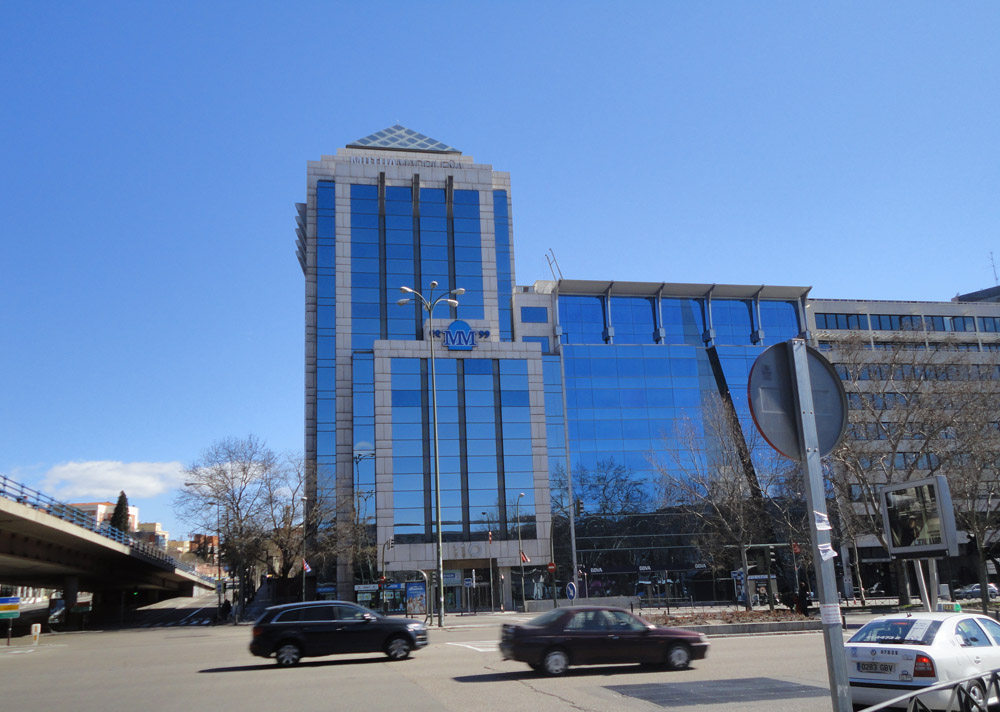
Edificio Longview, a 13-storey postmodern office building just across Paseo de la Castellana from AZCA.

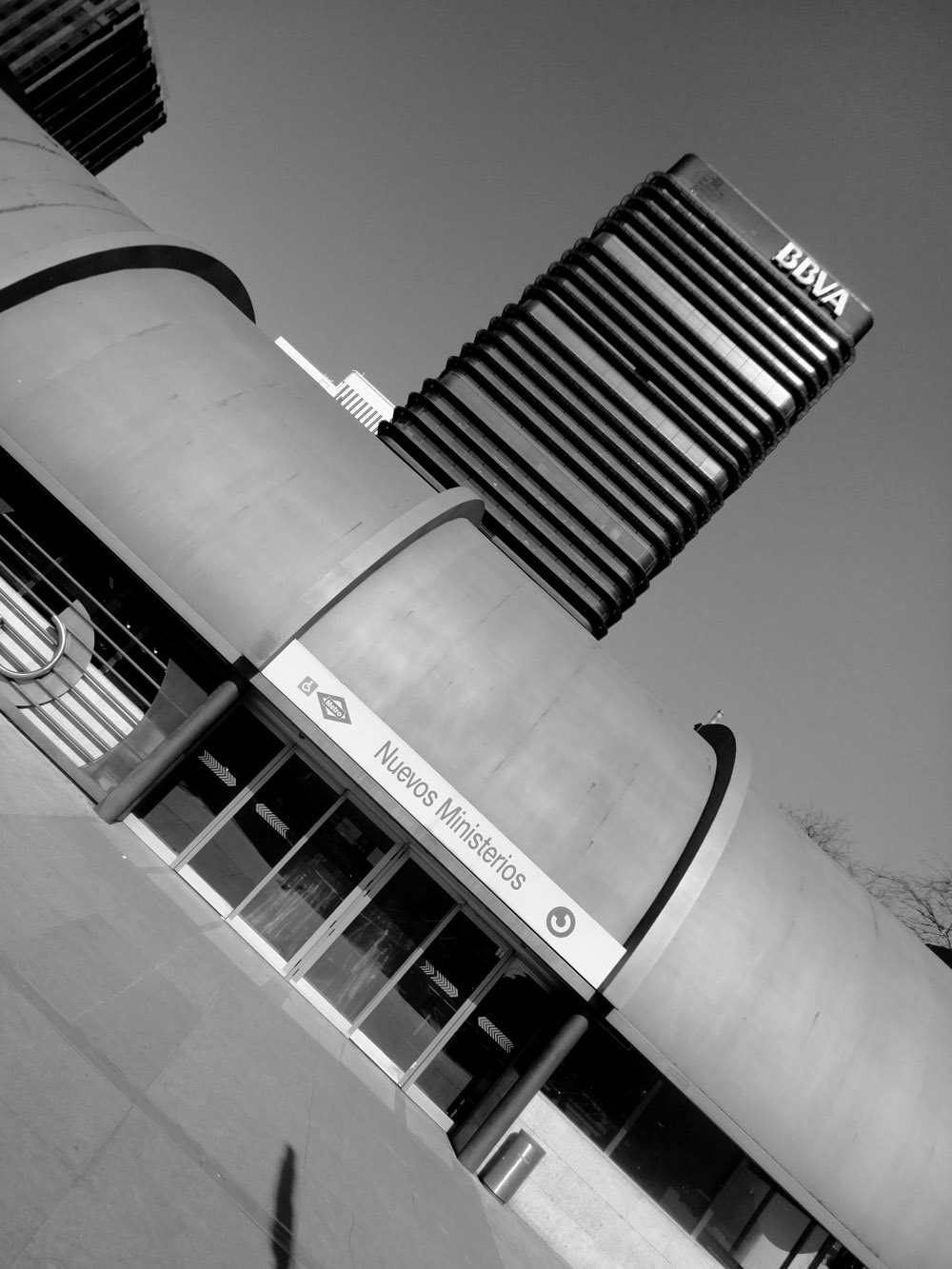
The large metro hub Nuevos Ministerios is where I finally get off, after passing it several times to change trains. Torre de Bilbao pops up beneath.
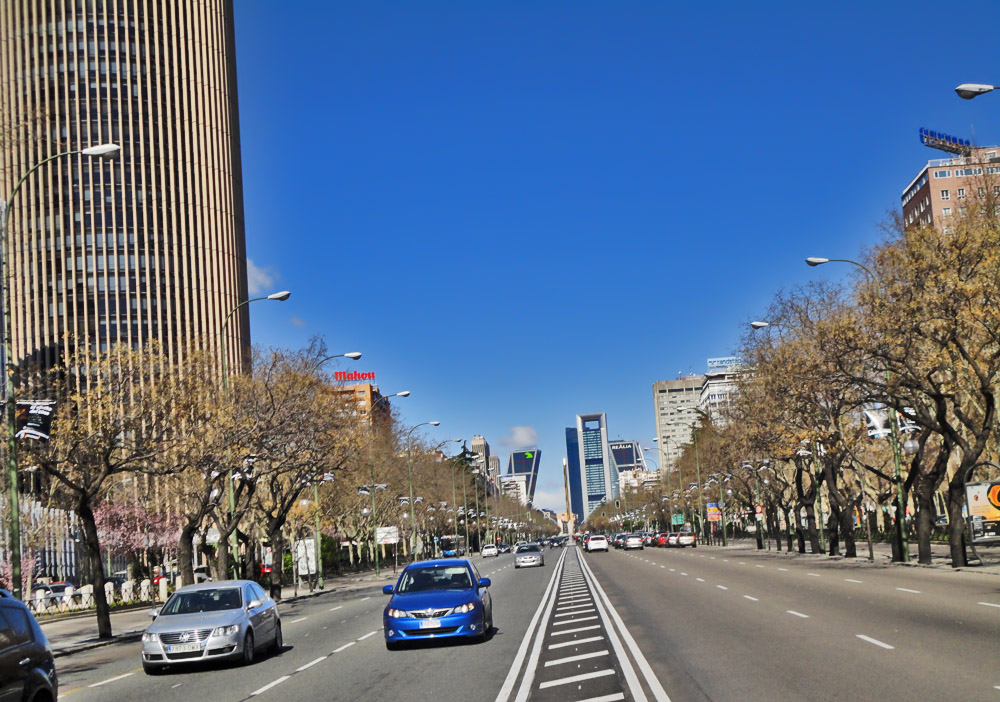
Paseo de la Castellana towards Torres Kio and Cuatro Torres. Torre Europa to the left.
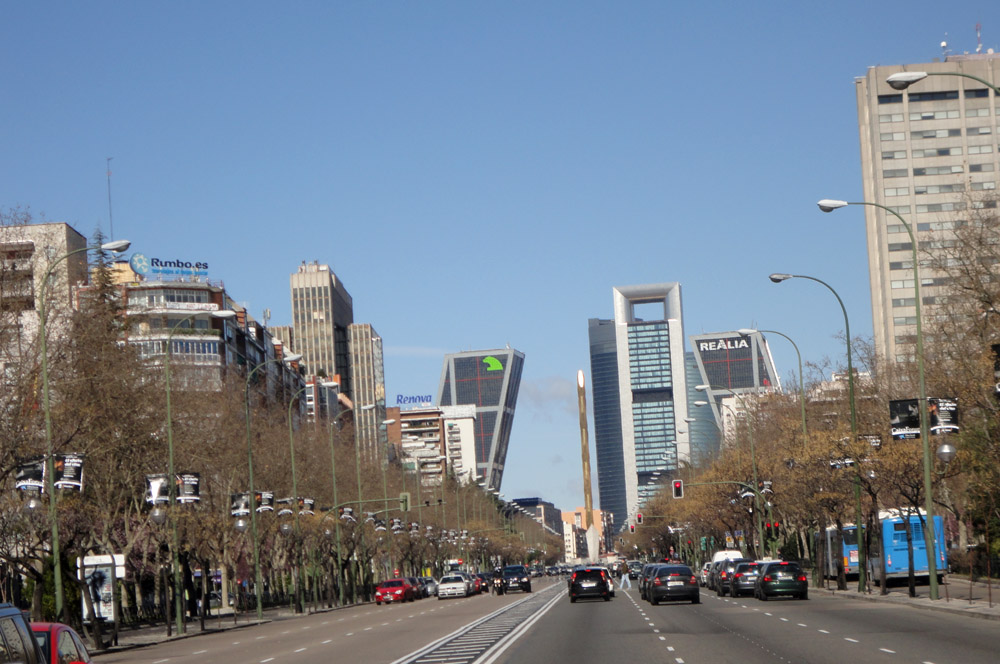
Paseo de la Castellana towards Torres Kio and Cuatro Torres.
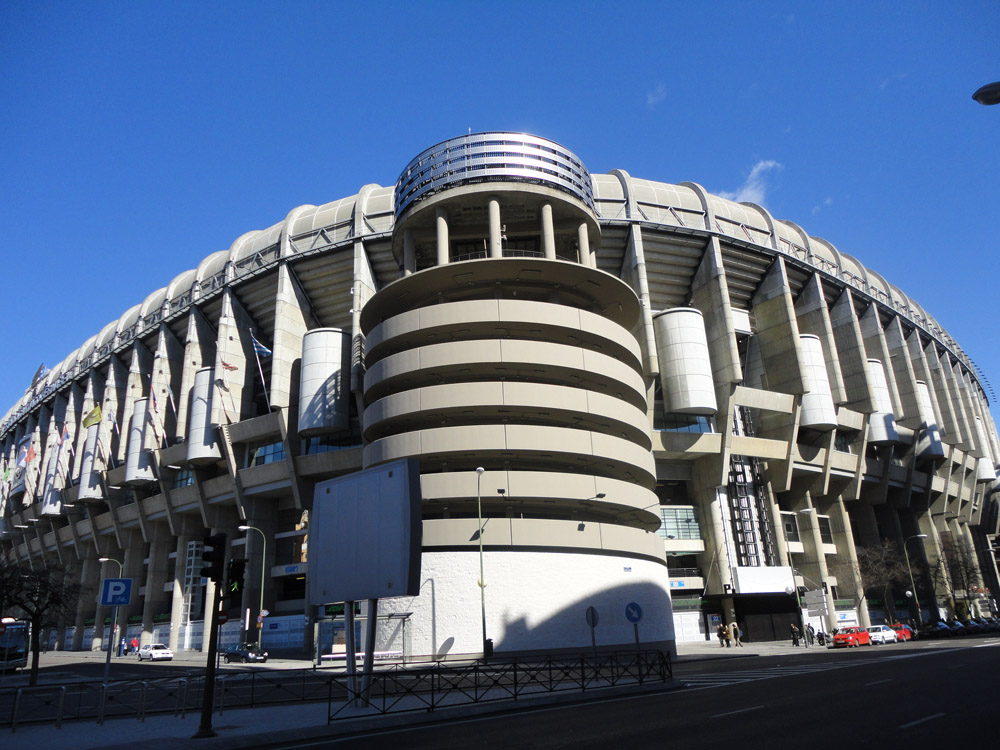
Estadio Santiago Bernabéu, or Bernabéu Stadium. It was inaugurated in 1947 and is the home of one of the world's most famous football teams, Real Madrid.
It has a capacity of 80 354 visitors, all seated. There are plans to reconstruct the stadium, a competition will be held with architects like IM Pei and Calatrava.

Real Madrid's logo on Santiago Bernabéu Stadium. The latest large events taking place on Bernabéu are UEFA Champions League Final in 2010 and the World Cup in 1982.
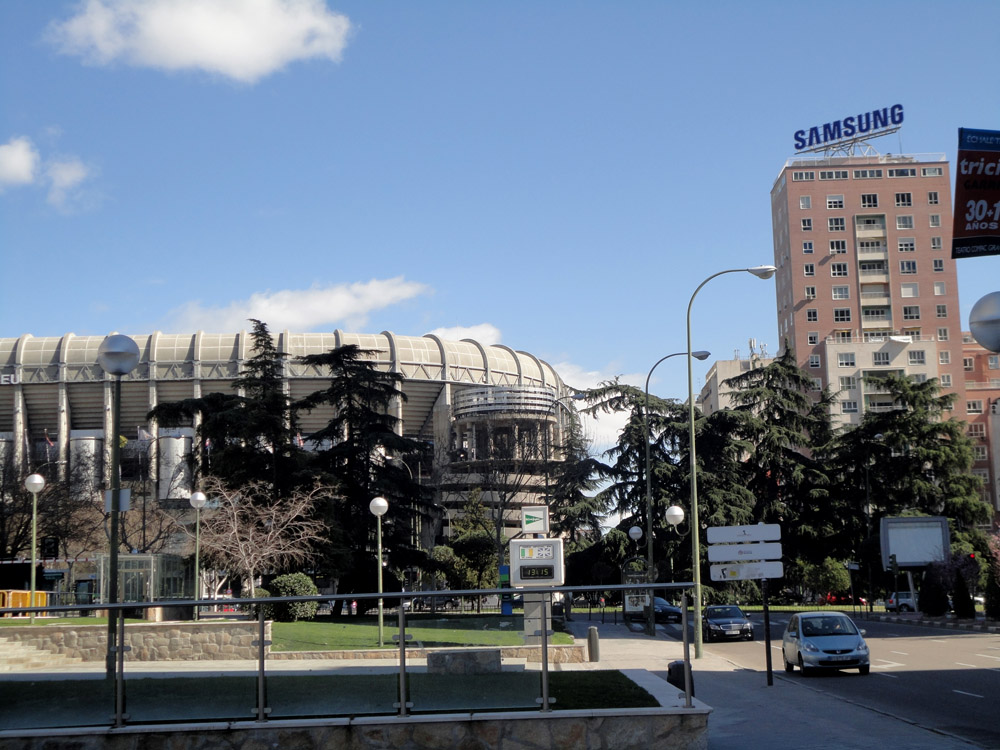
Plaza de Lima with Bernabéu Stadium and Torre de Lima.
Hospital de Maudes and the blocks just North of AZCA:
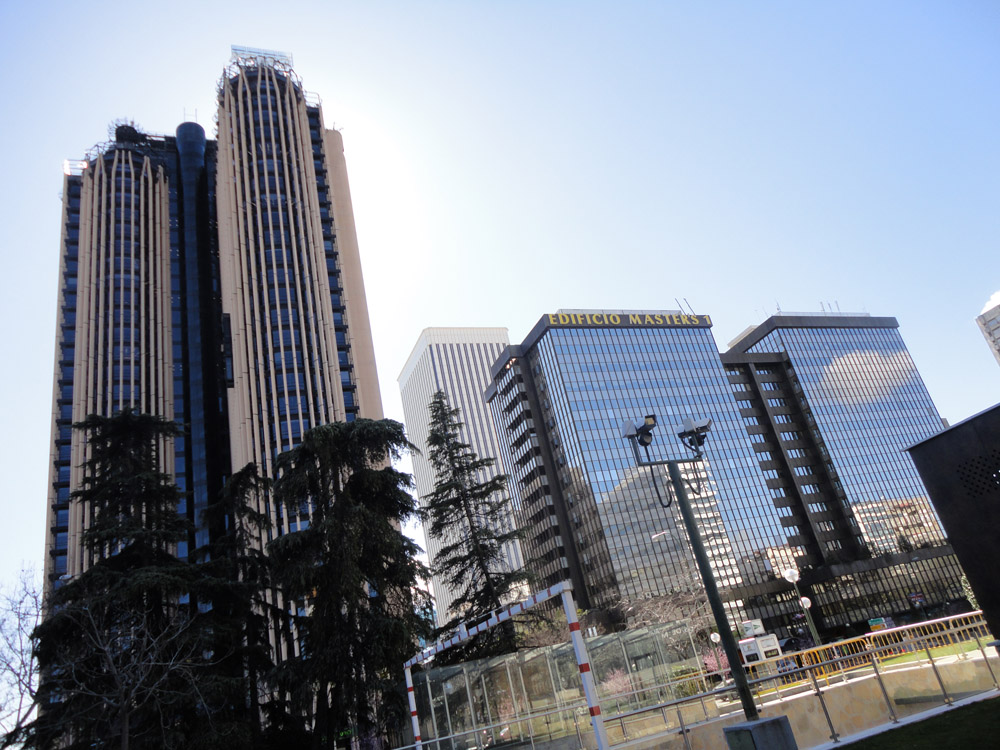

Palacio de Congresos de Madrid, the Congress Hall of Madrid, decorated by Miró.. On the gable is Sala de Exposiciones de Joan Miro.
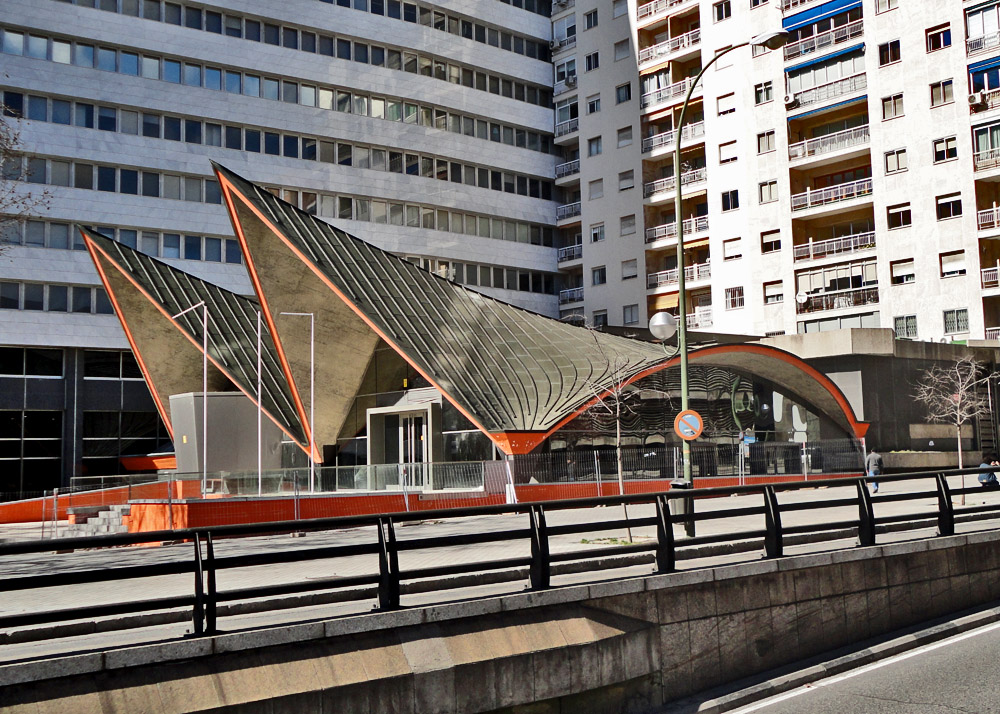
A futuristic pavilion. Anyone knows what it is?
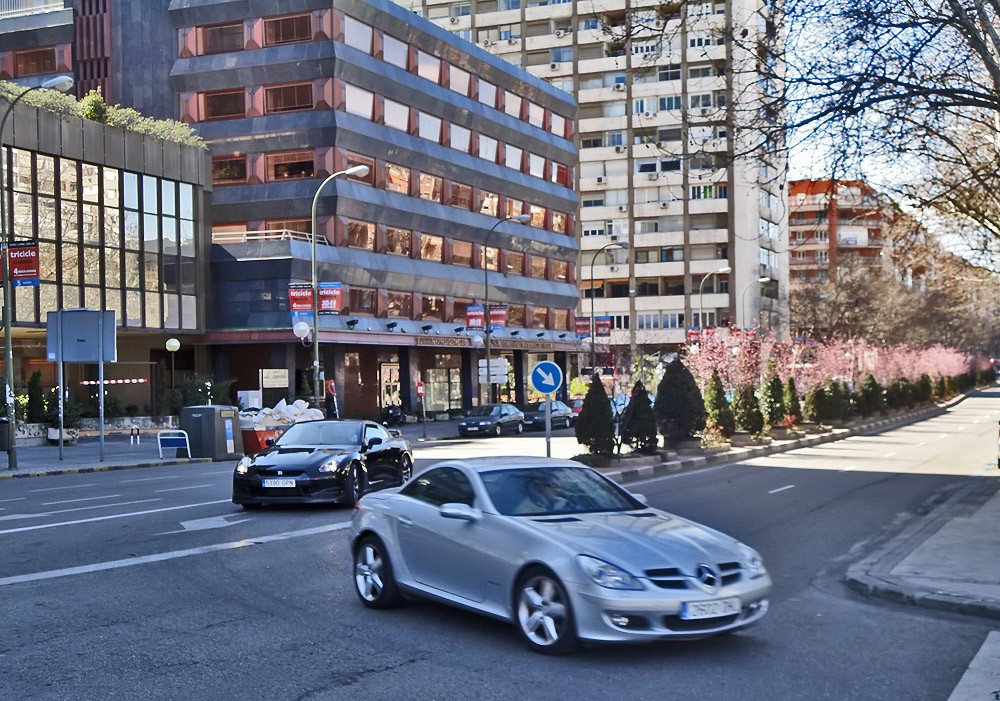
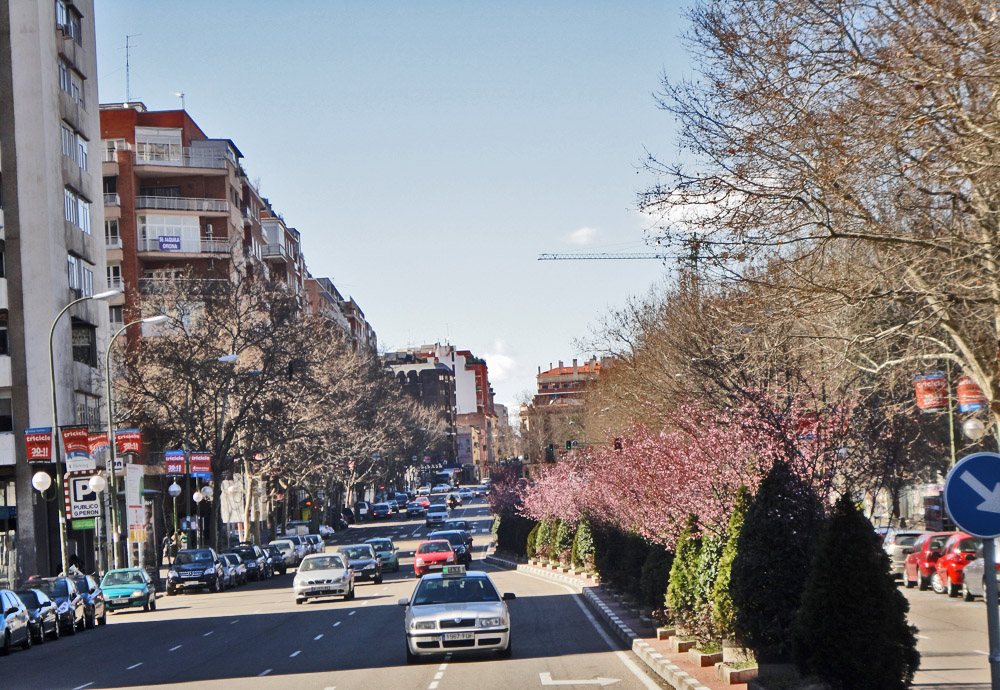
Avenida del General Perón is on the North side of AZCA.

The cherry trees blossoms already in February, a contrast to the grey concrete buildings.
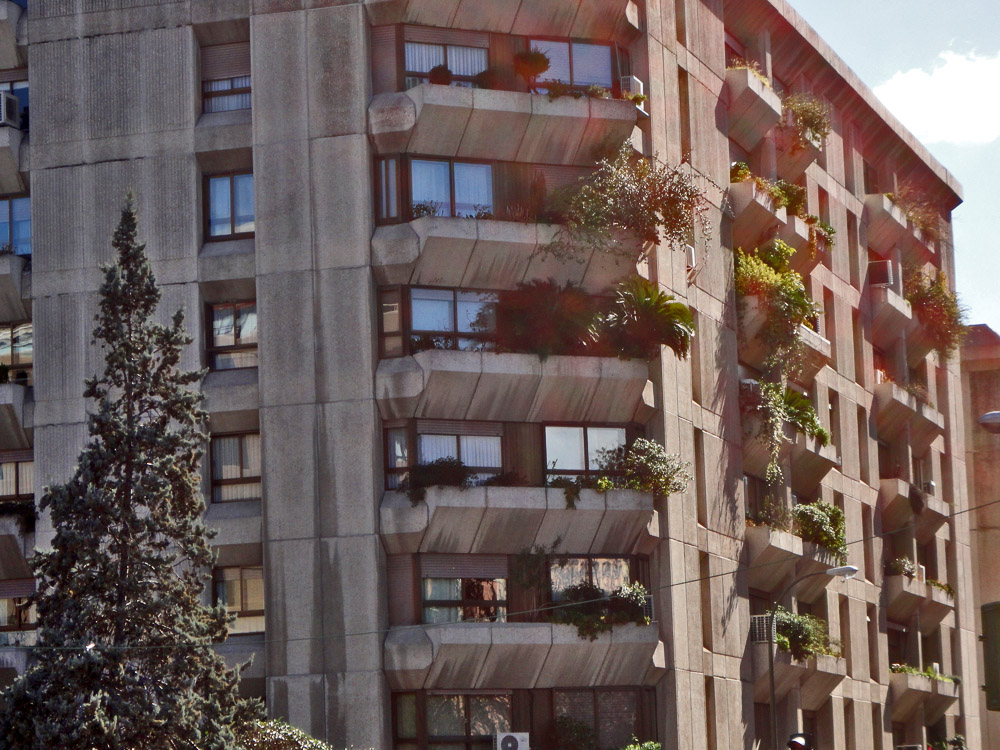
Private balconies with palms, an unusual sight for a Swede.
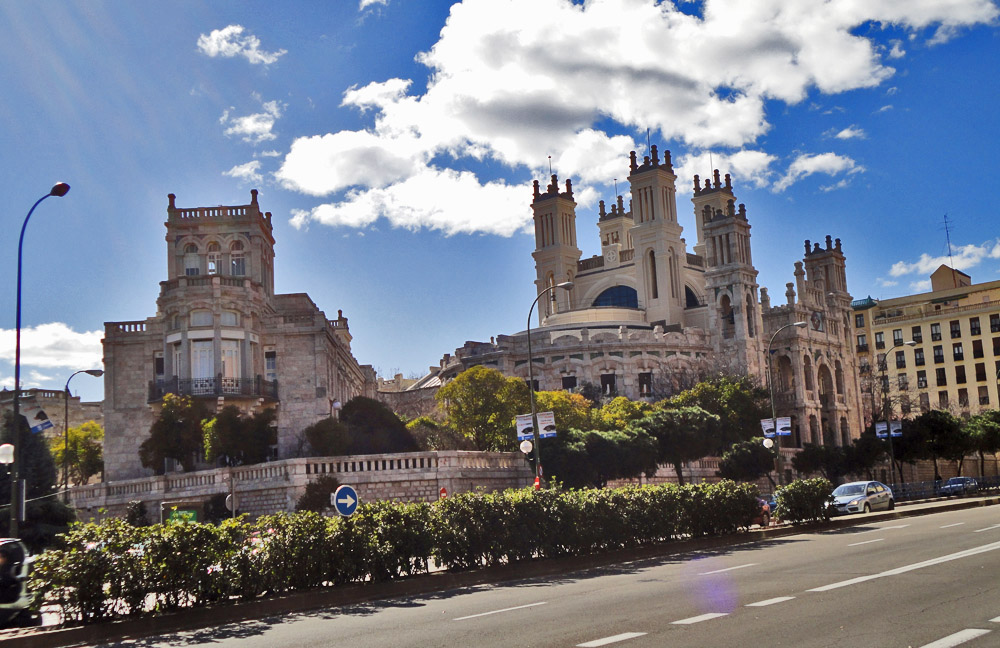
Hospital de Maudes. A beautiful hidden gem on the south side of Calle de Raimundo Fernendes Villaverde, 3 blocks west of AZCA.
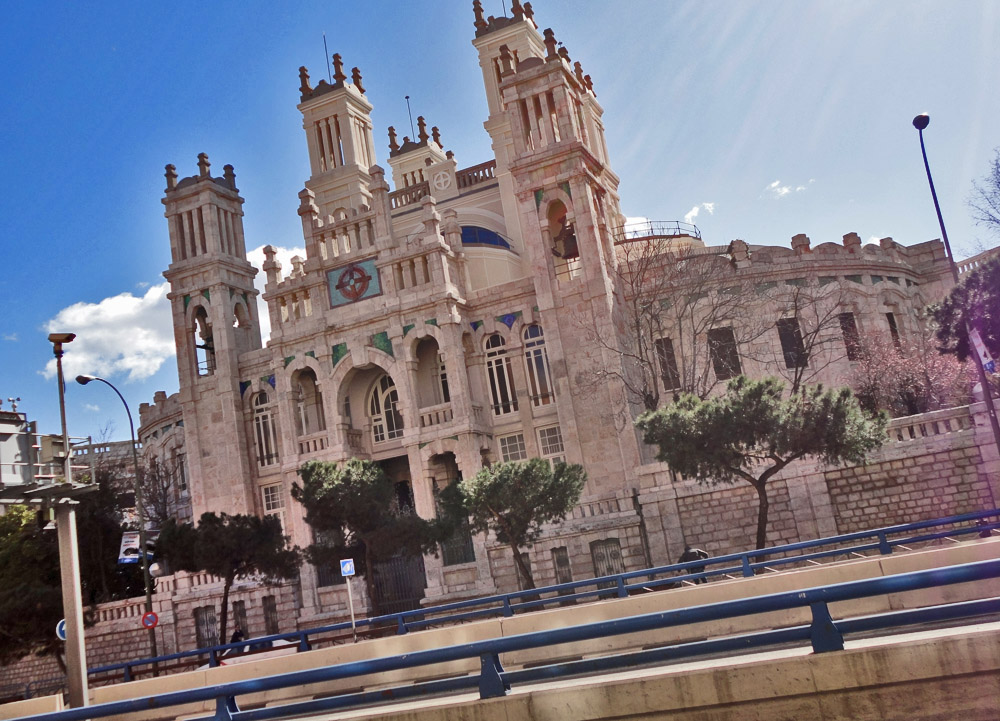
Hospital de Maudes from 1916 is rarely mentioned in the guide books, may be because it is a bit far from downtown. It is currently housing the ministry for public works, planning and infrastructre.
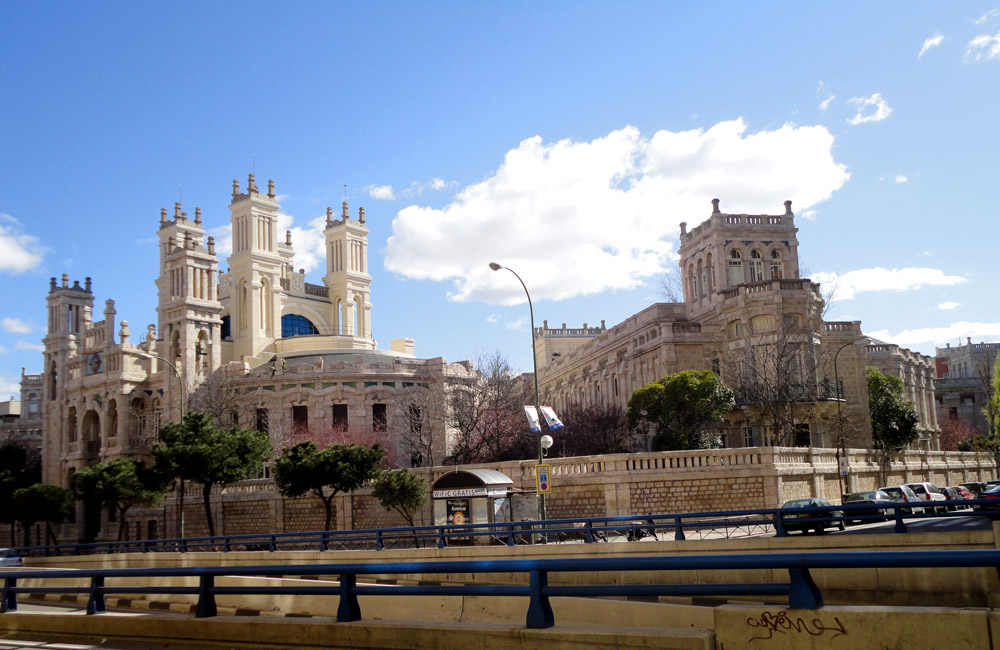
The official name is El Hospital de Jornaleros de San Francisco de Paula. The architect was Antionio Palacios.
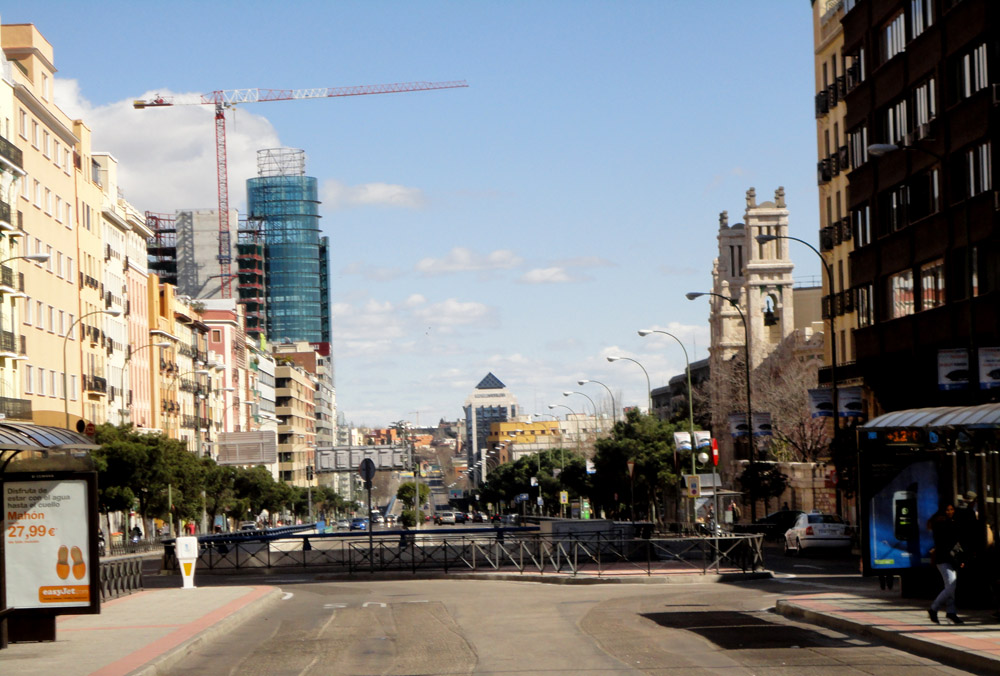
Calle de Raimundo Fernendes Villaverde towards New Tower Windsor and Edifico Longview. To the right is Hospital de Maudes.
Parque del Retiro and Jardín Botánico
Park Retiro, or Parque del Buen Retiro, is the large park in the east end of the city center and its green lung. It first it was a royal park, and then only open for the noble until the 19th century. Statues, sculptures, trees growing from the water, a transparant glass palace, a palace dedicated to Velázquez, theaters and a lake filled with pedal boats in front of the large Alfonso XII monument. A lot of beautiful spruces, palms, other trees and flowers can be seen, very different from the vegetation i Scandinavia that we used with. It was partly green, despite we visited in February. The Botanical Garden, Jardin Botánico, is just next to the park.
Parque del Retiro, the main gate:
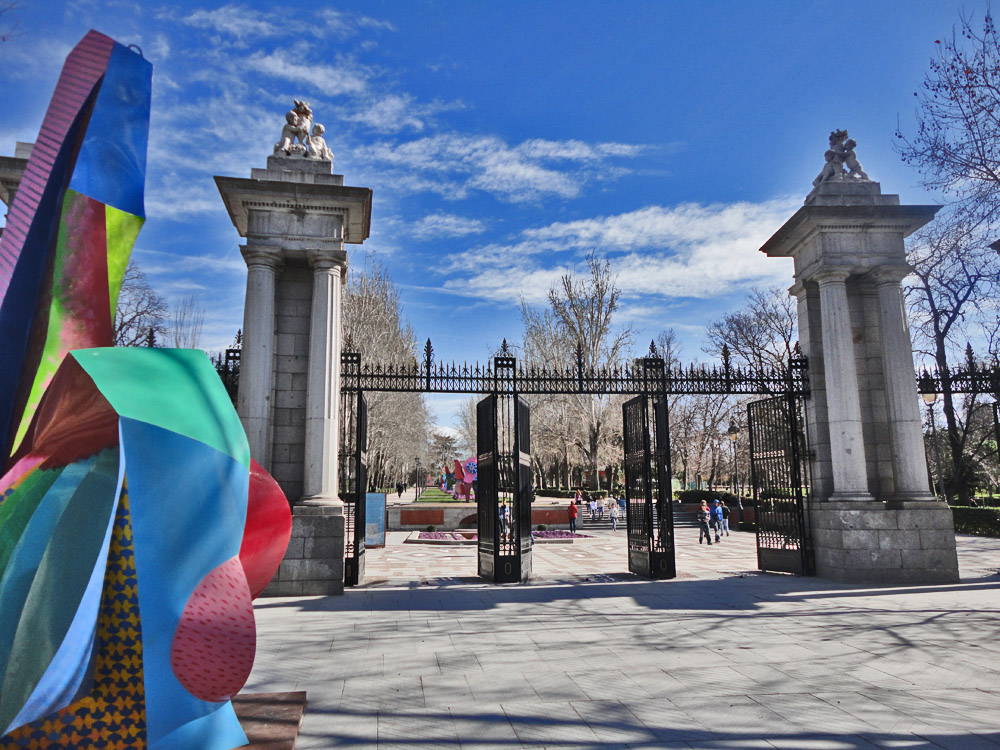
Puerta de la Independencia, the northwest gate to Retiro park. It was originally meant to be placed at a palace dedicated to Fernando VII:s wife.

During our visit in February 2011, there was a temporary exhibition with not so beautiful sculptures, meant to symbolize Alhambra and its meeting of cultures. What is the point of using these strong, childish colors?

A fountain near the entrance.
Alfonso XII Monument:
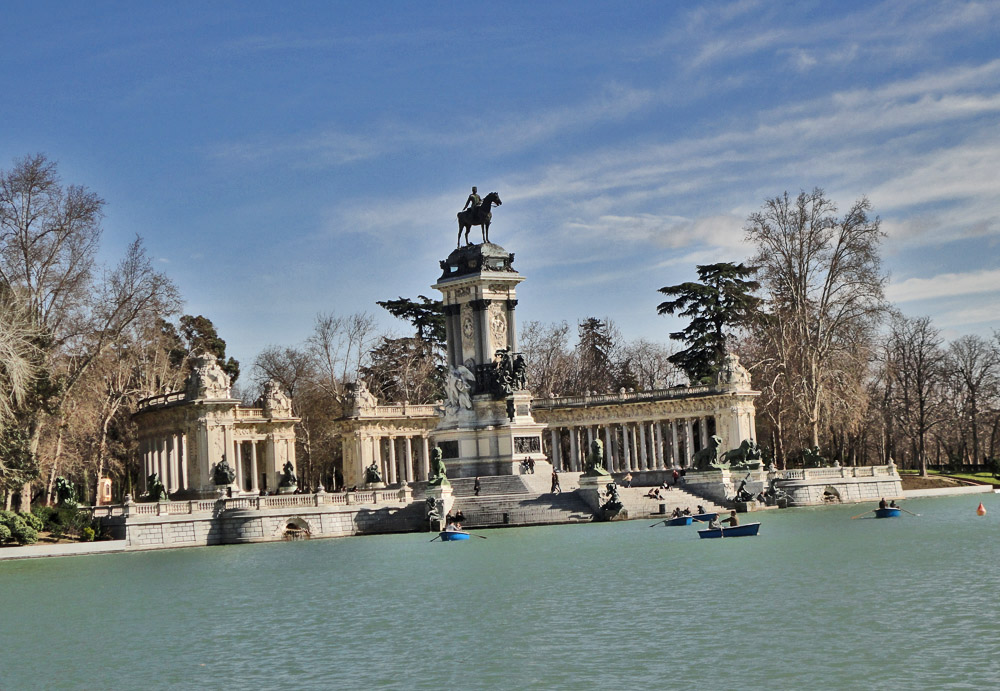
Alfonso XII Monument, or Glorietta. A beautiful monument by the lake, Estanque, where people were driving around in blue pedal boats this beautiful but windy Saturday in February.

The monument was completed in 1922 as a tribute to King Alfronso XII. People are relaxing at the colonnade.
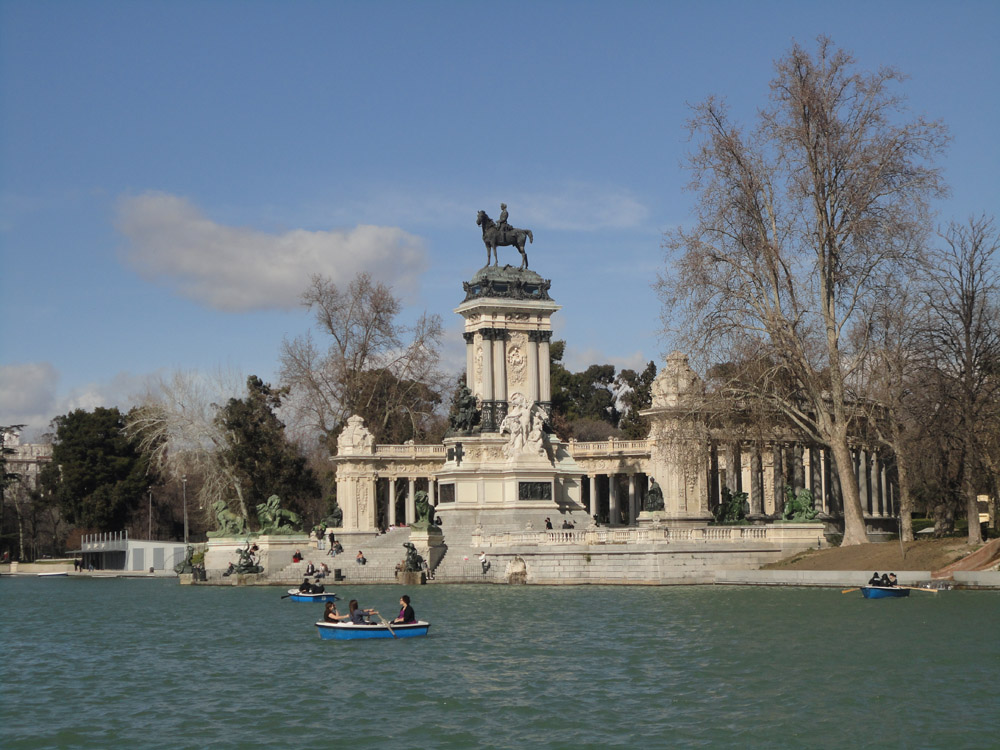


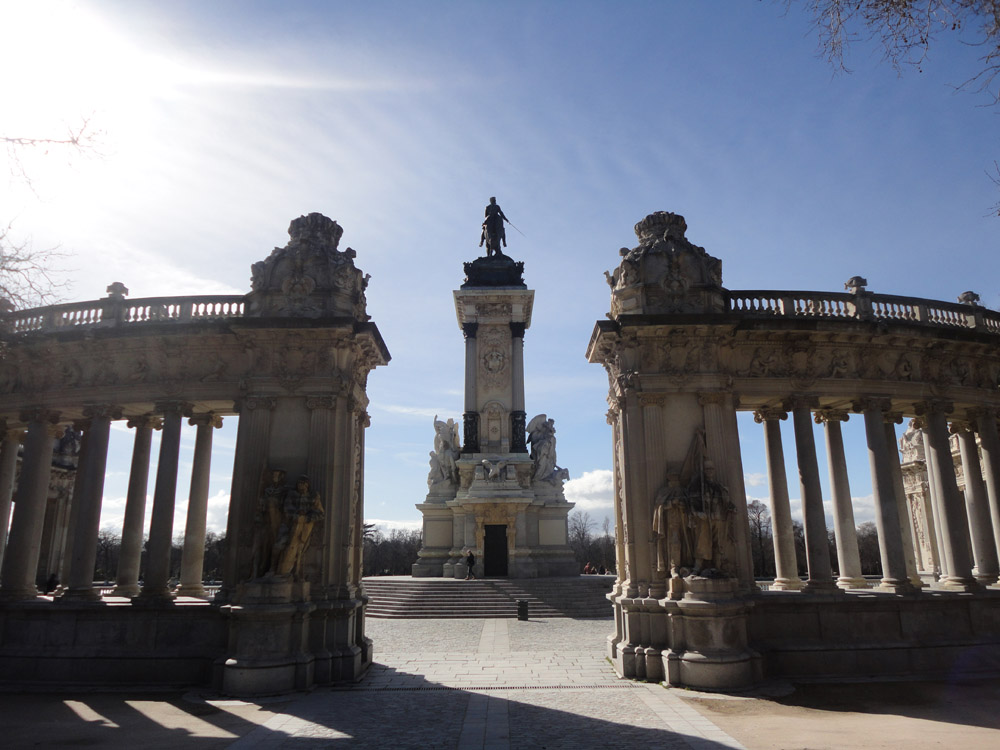




Mariano Benlliure designed the statue of the king on his horse.

Fuente de la Alcachofa, the "Artichoke Fountain", was drawn by Ventura Rodriguez. Its granite was taken from Sierra de Guadarrama and the stone from Colmenar.

This monument resembles Egypt with its sfinxes.
Palacio del Cristal:

Palacio de Cristal, modelled after London's Crystal Palace that doesn't exist anymore. Drawn in a shape of a Greek cross by Ricardo Velázquez Bosco.

It is possible to look right through the palace.


At the time for our visit, there was a sculpture made of laundry baskets, resembling crystal. Crazy but nice!

At the time for our visit, there was a sculpture made of laundry baskets, resembling crystal. Crazy but nice!

A rainbow in the flushing fountain.

These trees are standing in the water! This is the second lake.
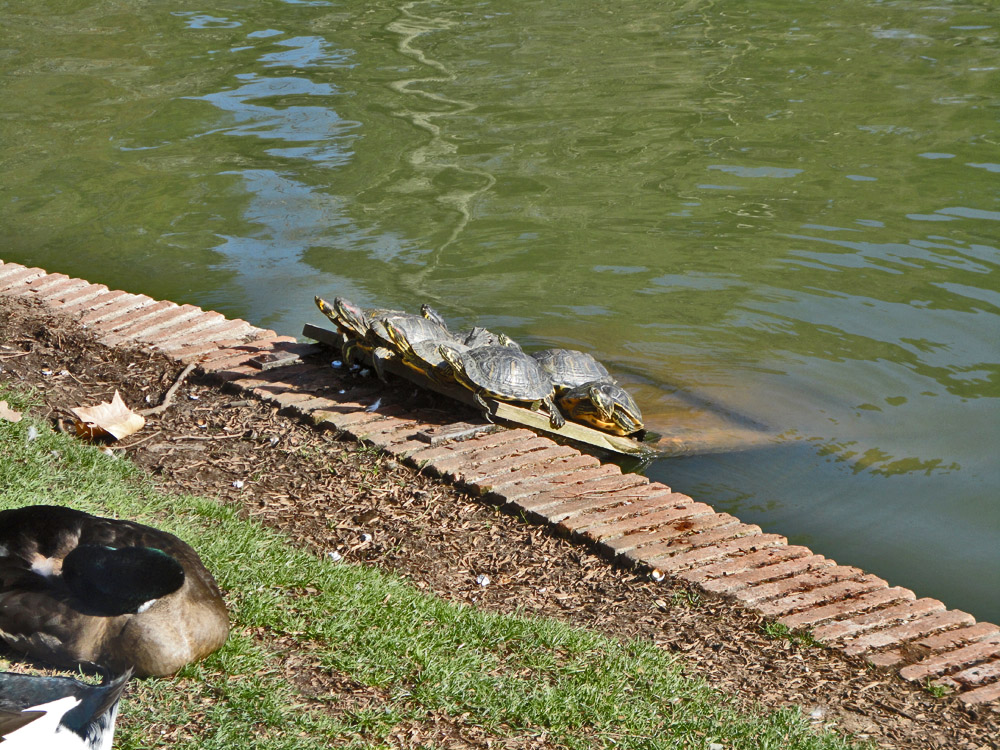

Palacio de Velázquez:

Palacio de Velázquez. Retiro's exhibiton hall, created by Ricardo Velázquez Bosco.

The Lucifer sculptures at the entrance of Palacio de Velázquez.

The south part of the park:



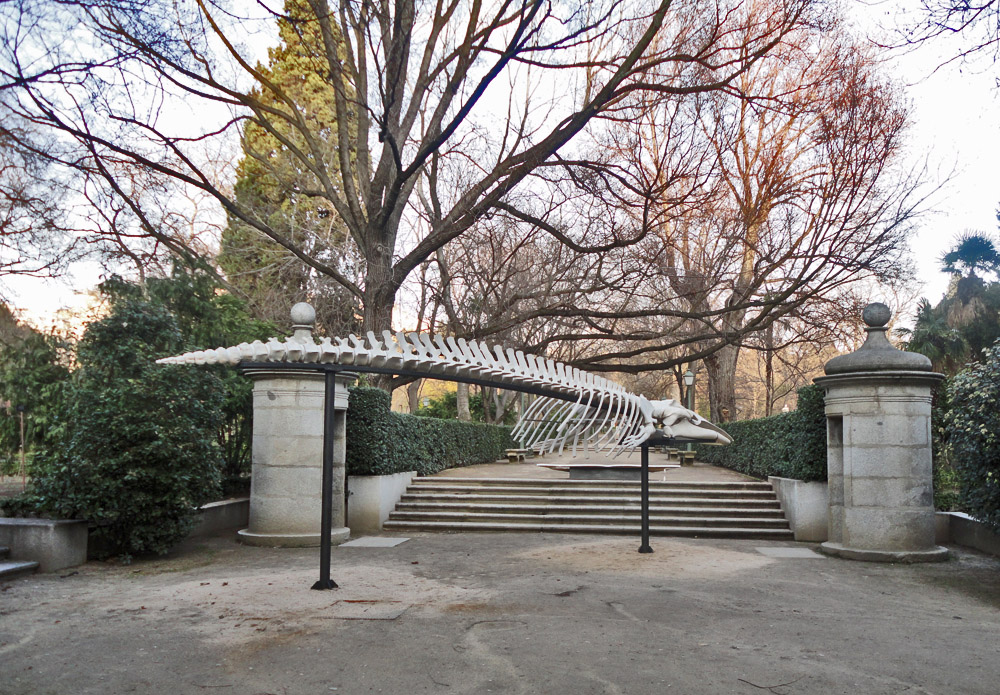
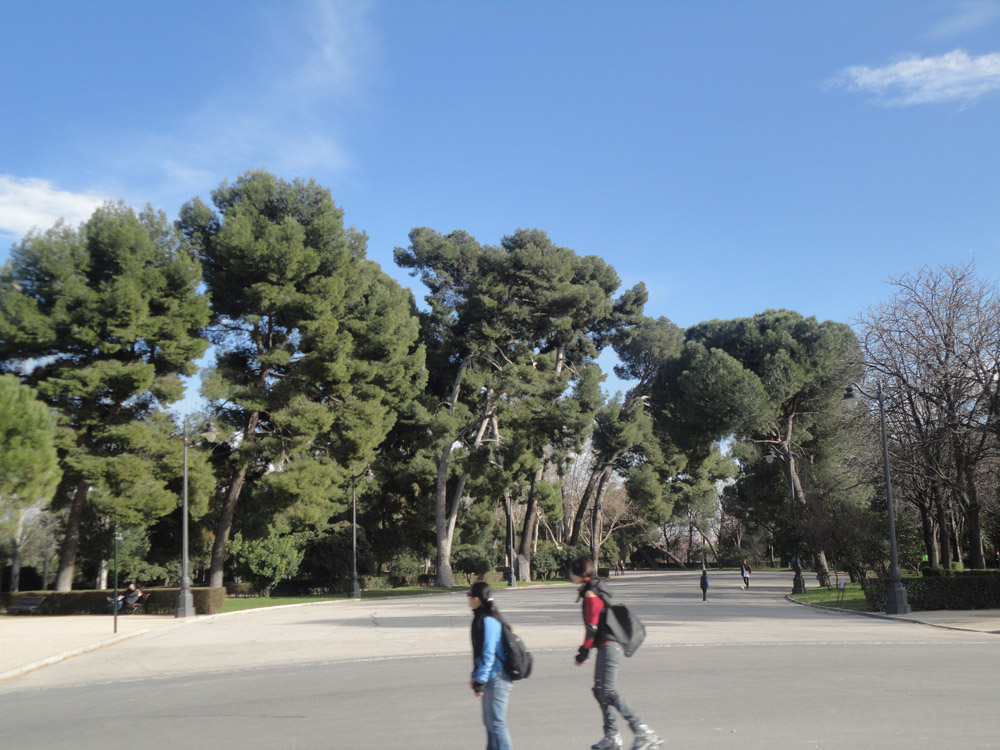
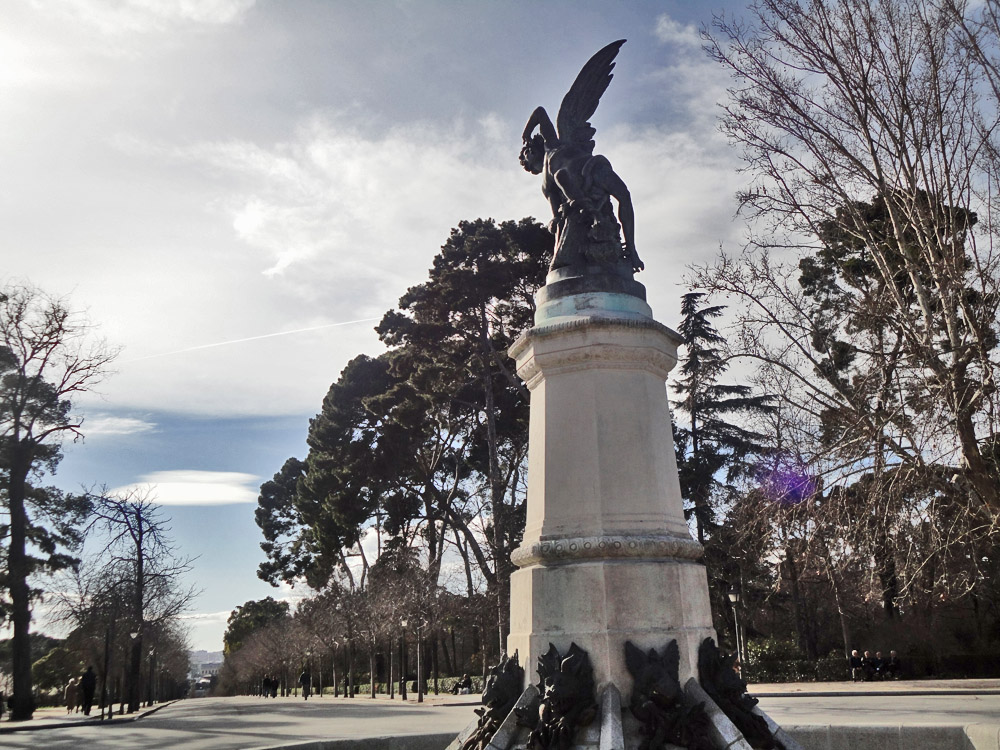
El Angel Caido. Probably the world's only monument dedicated to Lucifer.

It was designed by Ricardo Bellver and was unveiled in 1878.
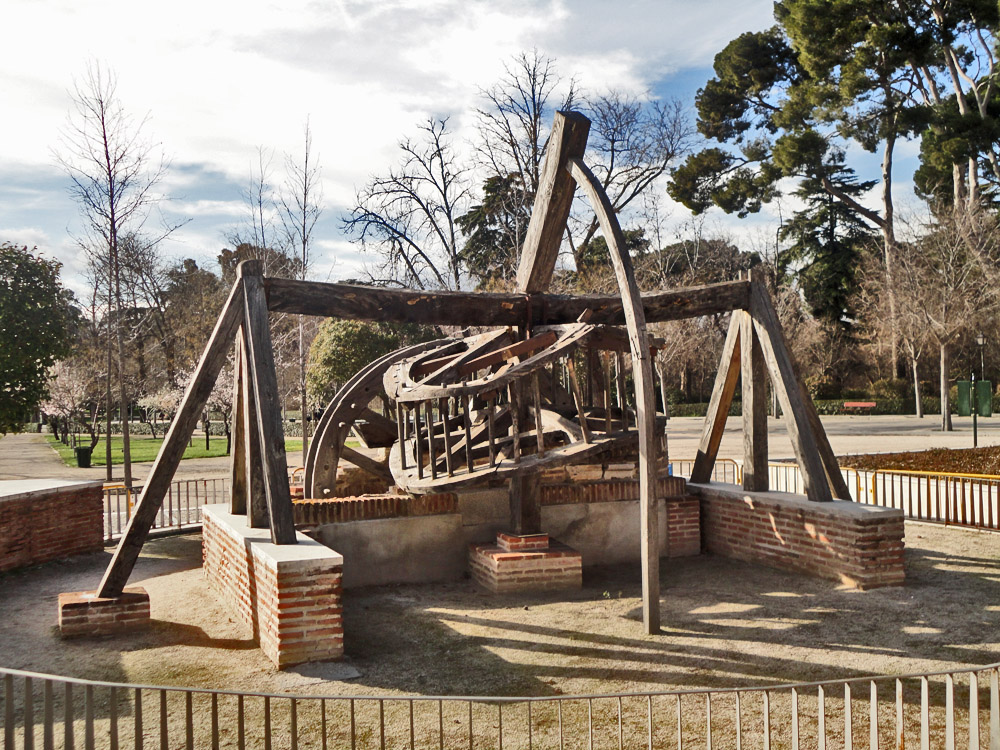
An unusual playground.

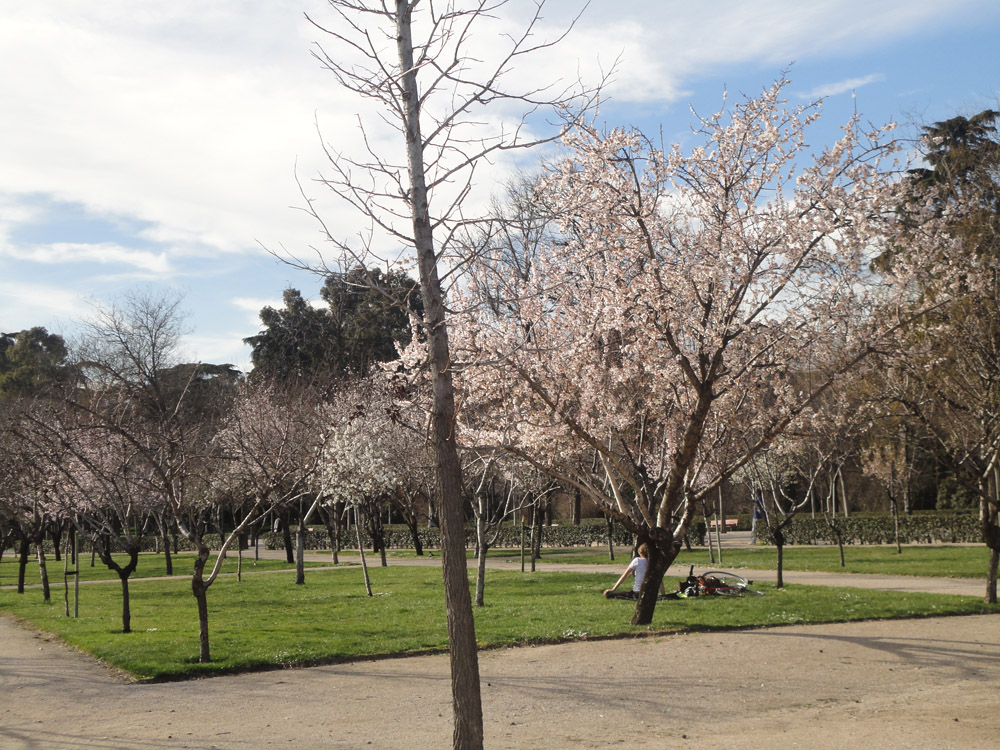
The cherry trees blossom. In February Madrid is like Swedish summer!

Paseo del Duque, leading to the southwest gate.
Around Retiro:

Calle de Alfonso XII.

Calle Claudio Moyano is a hilly promenade that leads down to Plaza del Emperador Carlos V. The right side is filled with small book shops.

Part of Ministerio de Agricultura.

The book shops at Calle Claudio Moyano.

The symbol of Madrid, El Orso y Madrileno, can be seen on every drain. The symbol is also a sculpture on Puerta del Sol.
Real Jardín Botánico:
Jardín Botánico, Madrid's Royal Botanical Gardens, are situated just next to Parque del Retiro and Prado Museum. We had to stress through it to beacuse we had a daytrip to Segovia on our schedule the same day, something we regret since we missed the Segovia trip, because we got the wrong information about the train - both at the hotel and at the station! So it would have been much better to relax in the botanical gardens all the day.
It was inaugurated in 1781. The 3 terraces are according to Juan de Villanueva's drawings. There are many statues of royalties, and the Swedish botanist Carl von Linné.

The gate to Real Jardín Botánico. You have to pay a small entrance fee.
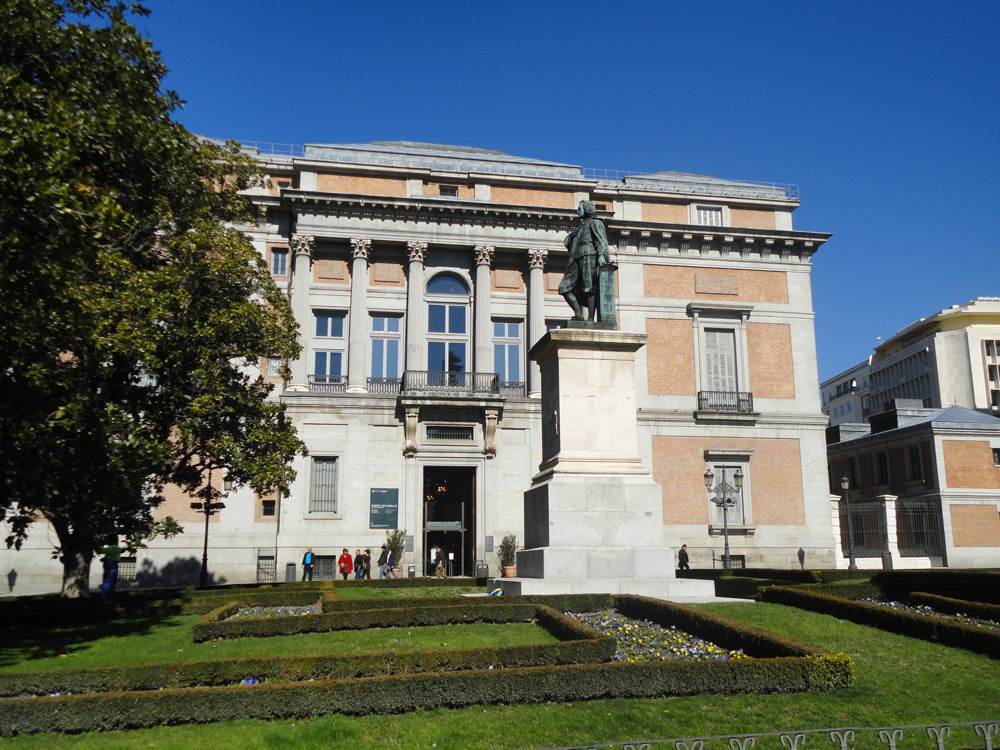
Museo del Prado seen from the entrance to the gardens.

Carlos III statue.

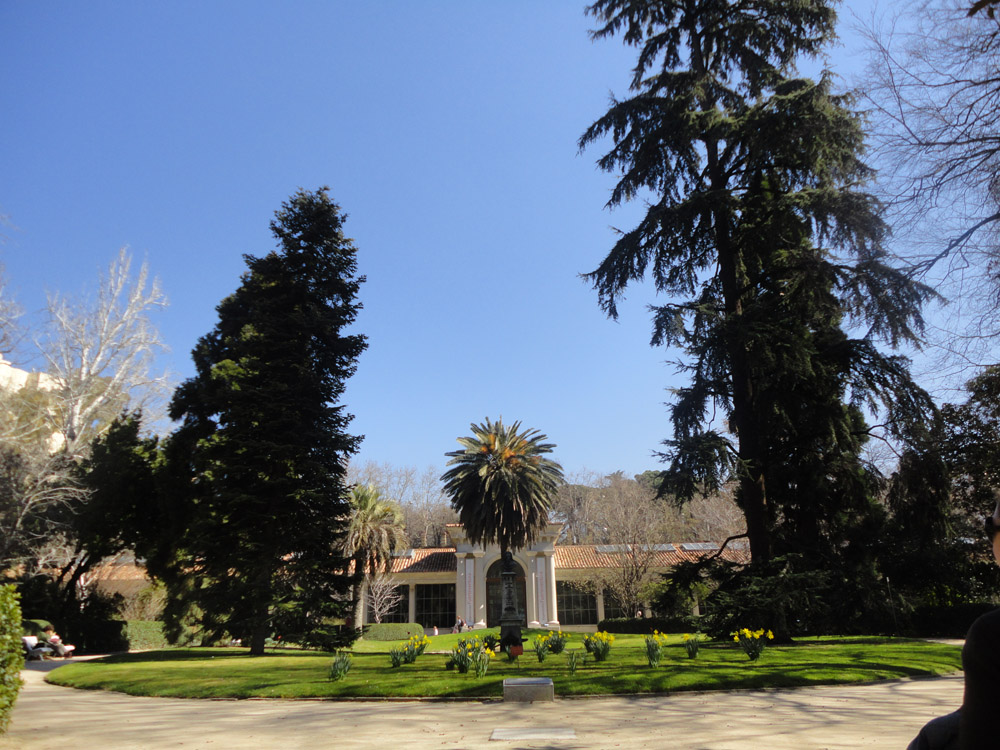
The pavilion.


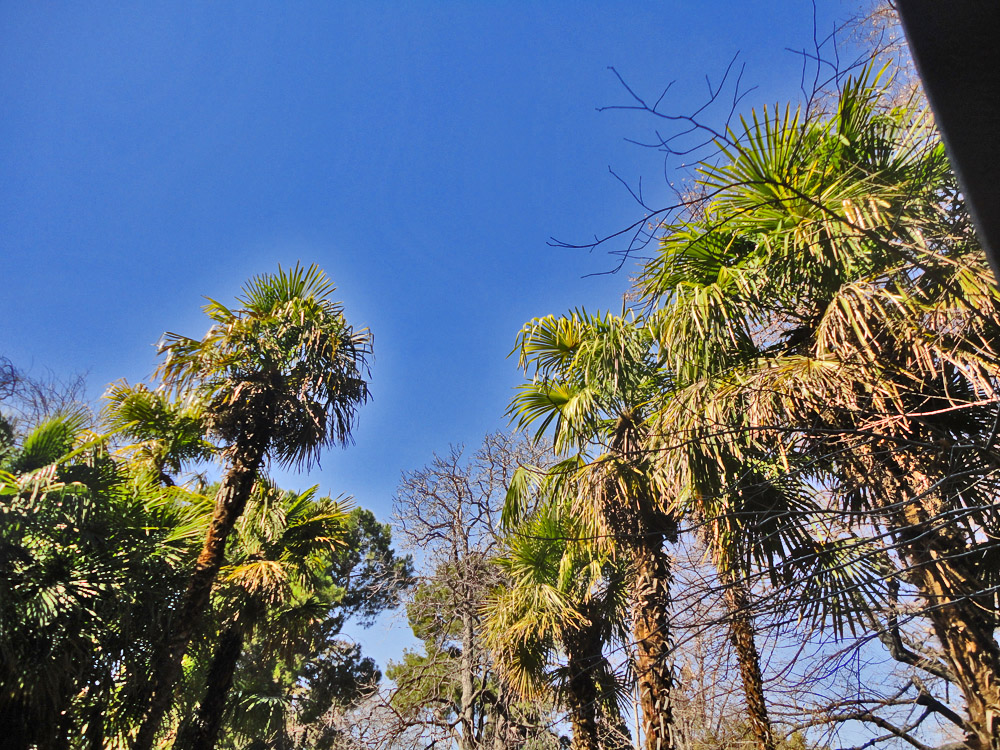

Some of the palms.


The Royal Botanical Garden is a very nice place to relax.
PALACIO
-Palacio Real, Almudena Cathedral, Plaza de Oriente, Plaza de Isabel II, Campo del Mori, Jardines de Sabartani
This part is about the Palacio district, where the Royal Palace, Palacio Real, lies. Almudena Cathedral, Campo del Moro, Plaza Oriente, Plaza Isabel II and Principe Pio are also in the surroundings. Palacio is one of the nicest areas in Madrid, relaxed and small scale with mostly pedestrian streets. It is just a short walk from Plaza de Espana, Plaza Mayor and Puerta del Sol. Palacio Real, the largest palace in Europe of its kind, was built for the Habsburg family.
Palacio Real:

Palacio Real, The Royal Palace, is the largest palace of its kind in Europe. It was built for the Austrian Habsburg family as a replacement for their old castle, that burnt
down. It was drawn by G.B. Sacchetti, with inspiration from Bernini's drawings of The Louvre in Paris. It was built between 1738 and 1764 and contains 2000 rooms,
but only 50 are open to public.

Half of the halls are open to public, but I never visited due to extremely long queues.

The palace might be impressive, but the current Spanish king prefers to live in Palacio de Zarzuela outside the city. Perhaps because of privacy issues.

Метки:
madrid
spain
capital
Barajas Terminal 4, were we arrived, were designed by the famous architects Richard Rogers and Antonio Lamela (but for a long time I thought Calatrava was the architect).
It opened in 2006.
Terminal 4 has glass walls that makes light slip in to create a stressful atmosphere. The structure has elements featuring a colour scheme including all the shades of the rainbow.
The rainbow colour scheme changing from green to yellow.
Terminal 4 from the plane:
The luggage hall:
Waiting for the metro to the city center.
Plaza de España
Our hotel, Mercure, was located close to Plaza de España, the northernmost of Madrid's famous and historic large squares, and my favourite of them. It borders Parque del Oeste and is the west end of Gran Via. At Plaza de Espana you can find Madrid's 2 oldest skyscrapers (that are the tallest in the city center), trees, fountains, sculptures and a famous monument to Cervantes, the author of Don Quijote. As our hotel was close to Plaza de Espana, we visited and passed by the square a lot of times. In the evenings, especially Fridays, young people start to party and picnic on the square already in the early evening. Palacio Real is only a short walk from Plaza de España. Busy roads and a highway tunnel is next to the plaza, but it is still a relaxing place.
Torre de Madrid, the Cervantes monument and Edificio España.
The monument to Miguel de Cervantes Saavedra, the author of Don Quijote.
Fuente del Nacimiento del Agua, the fountain right in front of Calle de Princesa, the northern extension of Gran Via.
Torre de Madrid and Edificio España, 2 of Madrid's oldest but most prominent skyscrapers. Very few of Madrid's skyscrapers are in the city center. The 2 buildings were constructed by the project developer Metropolitana and the Otamendi brothers designed them. After their completion in the 1950s, the plaza became a popular
meeting place.
Torre de Madrid. Built in 1957 and 142 m tall it is the tallest building in the city center. Tallest building in Madrid when completed. Still the tallest in the city center.
Cleaning the windows of this early modernist skyscraper!
Edificio España. A 117m tall hotel from 1925. It was completed in 1953. It was Madrid's tallest building until 1957 when it was surpassed by Torre de Madrid (see above).
Edificio España is designed in a Spanish Revival style with classical elements. The hotel is Crowne Plaza.
The statue of Cervantes. It was built in 1925, but was not completed until 1957.
Cervantes on his horse. Hordes of tourists want to be photographed there.
Palacio Real seen from Plaza de Espana. More of that later.
A church with an unusual architecture. Anyone knows the name?
2 old timer Seat, a very rare sight in Madrid, that is mostly trafficated by new cars. Note that both have punctures!
And some of our hotel, Mercure at Plaza de Espana:
The view from the room.
Mercure Hotel Madrid Plaza de Espana is the full name of the 4 star hotel where me and my girlfriend stayed. It has nice interior and friendly staff, but is a bit worn.
It has only 97 rooms, so it is not very big, but it has about 5 floors.
Gran Via
Gran Via is the most famous street in Madrid and passes from the west to the east end of the city center. It begins at Plaza de Espana, passes Plaza del Callao and ends where it meets Calle de Alcala, where the famous Metropolis building is, close to Plaza de Cibeles. Puerta del Sol and Plaza Mayor are just a couple of blocks south of Gran Via. A lot of hotels, exclusive stores, department stores and restaurants are located along the street. Some of the most impressive exteriors in Spain can be found here, as well as expensive stores, but it has some kind of worn charm with all the beggars and poor people along the streets, so be careful at night! But the architecture is fascinating, it is a true pleasure to study all the palace like highrises from the early 20th century with all the decorations. Gran Via resembles New York's Broadway, as well as London's Oxford Street, but has an identity of its own..
History: In the middle of the 1800s, it was decided that a new thoroughfare had to be created to connect Calle de Alcalá with Plaza de España. Many old buildings were demolished, but construction of the new buildings didn't start in decades and the media cynically called it "Gran Via", the Great Road. In 1904 it was finally approved and construction could start some years later. The design of the new buildings were for the time very modern, many architectws were inspired by the Chicago school. The whole street was completed in 1929.
A WALK FROM THE EAST TO THE WEST END OF GRAN VIA:
Edificio Metropolis. The crossing Gran Via/Calle Alcalá is the most photographed place in Madrid. The Metropolis building, originally constructed for the insurance company Unión y el Fenix Espa, was built between 1907 and 1911. It was designed by Jules and Raymond Février in a French Beaux-Arts style. Today
Metrópolis Seguros, another insurance company has their headquarters here, hence the name.
The black dome of Metropolis. The original statue was replaced in 1975 by a statue of the winged Godess Victoria, because the original insurance company removed it when Metrópolis took over the building in 1972. The golden garlands shine in the sun.
A bronze miniature of Gran Via just outside Metropolis.
Instituto Cervantes by the architect Antonio Palacios.
Edificio Grassy is the corner building from 1907 in the middle, Edificio Telefonica is to the far right.
Gran Via towards Edificio Telefónica, with Ed. Grassy to the left.
Iglesia de San José.
Banco de España, The National Bank of Spain. Spain's golden reserves are preserved underneath Plaza de Cibeles (to the left). An art collection with famous paintings by Goya and other artists is also inside the building, but to be able to see it you must write a personal letter to the bank first.
Edificio Telefónica was Madrid's first highrise and is today the HQ for Spain's largest phone company. It was drawn in 1929 by the American architect Lewis Weeks and was inspired by the Chicago school.
Ed. Telefónica played a key role during the civil war as an observation tower for the soldiers. Inside is a fine art exhibition including famous painters. Today the clock tower is famous.
Calle de la Montera. This pedestrian street leads towards Puerta del Sol.
Plaza del Callao at Gran Via:
Plaza del Callao with Torre Carrion. This square is the movie center of Madrid, home to 6 cinemas. Callao is a bit like Madrid's answer to New York's Times Square. It also has 2 large department stores.
Torre Carrión (middle), or Edificio Capitol, is the 14-storey art deco landmark of Plaza del Callao. It hosts the Capitol Cinema, a Benetton store and a lot more.
Edificio Allianz is the building with the domed pavilion.
Callao, looking towards H&M and Torre Carrion.
Inside H&M at Gran Via. A lot more upmarket then in Sweden, were it has its originas. This branch's interior looks like a palace.
Cines Callao, a large cinema in an outstanding buildng at Callao.
FNAC, a French department store chain specializing in entertainment (records, book etc) occupies a 12-storey narrow highrise at Plaza del Callao. To the left is one of the largest branches of the department store chain El Corte Ingels.
From Callao, Puerta del Sol is only a few blocks away if you walk on Preciados (right).
Palacio de la Prensa, is the impressive cinema/residential building to the left.
View from El Corte Inglés, Plaza del Callao:
These photos were taken from the café on the top floor of the department store El Corte Inglés branch at Plaza del Callao.
Plaza del Callao with Torre Carrión (left) and Gran Via leading towards Torre de Madrid at Plaza de España. Mountains in the background.
Towards Palacio Real and the mountains of Sierra de Guadarrama.
Looking to the southwest: Almudena Cathedral (right), the national theater and some other churches.
Almudena Cathedral and the National Theater. Commie blocks in the distance.
Looking West towards Plaza de España with its landmark Torre de Madrid...
...and East towards Plaza del Callao.
A statue throughing a building on the street?!
World famous musicals can be seen in the world metropolis Madrid.
Plaza de España. The west end of Gran Via.
Along Paseo del Prado
- Plaza de Cibeles, Plaza de Canovas del Castillo, Plaza Lealtad, Plaza Independencia, Puerta de Alcalá and Museo del Prado
The green boulevard Paseo del Prado borders the East part of Madrid's city center from Parque del Retiro, in a North-South direction. Along the avenue some of the most magnificent, and also most trafficated, plazas of Madrid are located. The most important of them is Plaza de Cibeles were the beautiful City Hall is. And Museo del Prado, one of the world's most famous art museums, is of course located along Museo del Prado, as well as the Botanical Garden. Paseo del Prado begins at Plaza del Emperador Carlos V, where Atocha, Madrid's largest station is, and ends at Plaza de Cibeles, where it changes name to Paseo de Recoletos, and then changes name again to Paseo de la Castellana, and continues to the skyscraper districts in the North. Despite it is very trafficated, Paseo del Prado is a nice place to stroll.
Plaza de Cibeles
Plaza de Cibeles is where both Gran Via and Calle Alcalá ends. It is also the North end of Paseo del Prado, so it is a really busy, but also very beautiful plaza, despite all the traffic. In the middle of the square there is an imposing sculpture with a fountain. The impressive City Hall, or Palacio de Communicationes is also here, just like Banco de Espana, the great national bank, Palacio Linares and Palacio de Buenavista. Edifico Metropolis is just a few blocks from, and is visible from, the plaza. The Alcalá Gate can also be seen.
At one occasion there were a lot of emergency vehicles and police cars. I looked and saw they found the body of a dead person! Fortunately wrapped in some kind of golden material.
Palacio de Communicaciones, the current City Hall of Madrid. This impressive neo Gothic building draws attention like a magnet. Palacio de Communicaciones was built in 1909 and drawn by Antonio Palacios as the main post office of Madrid. It is also called Correos. Note Alcalá Gate to the left.
The interior is also very impressive, ufortunately we missed to go inside. It was a postal museum until 2007, when it became the City Hall, Ayuntamiento de Madrid.
The fountain of Cibeles is drawn by Ventura Rodríguez and is the most famous sculpture. It represents Cibeles, the roman godess of nature in a carriage driven by horses.
Anyone knows the name of this building next to the city hall?
Palacio de Communicaciones (left) and another majestic building, along Calle de Montalbán.
The Metropolis Building and some other landmarks seen from Plaza Cibeles. To the left is Calle Alcalá and to the right is Gran Via.
Banco de Espana, Metropolis and Palacio de Buenavista are some of the famous buildings in this picture. Palacio de Buenavista (righ), is a palace built for the Alba family, but now occupied by the army. The Duches of Alba, rumoured to be one of Goya's lovers, lived here.
The gardens of the Palacio Buenavista.
Alcalá Gate seen from Plaza Cibeles.
Plaza Independencia
Plaza Independencia is a heavy trafficated circlular plaza next to the main gate to Parque del Retiro, close to Plaza Cibeles. It is mostly famous for that the Alcalá Gate is situated in the middle, before all the traffic.
Puerta de Alcalá, or Alcala Gate, is a gate on Plaza Independencia. This neoclassical gate, now a national monument, was designed by the Italian architect Sabatini and completed in 1778.
Plaza de Cánovas del Castillo
This square is very similar to Plaza Cibeles; a plaza with a sculpture fountain (Neptuno) surrounded by trafficated roads and magnificent buildings. 4 of Madrid's most exclusive hotels, Hotel Ritz, Hotel Palace, Hotel del Prado and Villa Real, are situated here. It is just next to the Prado Museum, Museo Thyssen Bornemisza and Plaza Lealtad. The buildings and sculptures at Cánovas del Castillo are illuminated after dark.
Plaza de Cánovas del Castillo is sometimes called just Plaza Neptuno. Here you can see the Palace Hotel from 1913 and the Neptune fountain. Looking West.
Fuente de Neptuno, The Neptune fountain, is in the middle of the square. Looking to the East.
Hotel Ritz, Madrid's oldest luxury hotel.
Museo Thyssen-Bornemisza, Madrid's 3rd largest art museum. Housed in Palacio de Villahermosa.
Congreso de los Diputados, a legislavitve government, has both an old classical (right) and a curvy modern part (left).
Caixa Forum. A modern art museum famous for its rare architecture.
Iglesias de San Jerónimo el Real. This is were the current king, Juan Carlos, were coroned. The royal church is just next to Prado. It was originally built in the 16th
century, but has been changed many times.
Plaza de la Lealtad
Plaza Lealtad is a small square just next to Plaza Cánovas del Castillo, along Paseo del Prado. It is mostly famous for the 2nd of May monument and is also were Madrid's stock exchange and Hotel Ritz is. The plaza has palms greenery.
Bolsa de Madrid, Madrid Stock Exchange, at Plaza Lealtad. This classicist building is the largest and most international of Spain's 4 stock exchanges. It was founded in 1831.
Mto. Dos De Mayo (Monument to the 2nd of May) honors the heroes that died in the revolt towards France in 1808. The remnants of the heroes are buried beneath the obelisque.
Paseo de Recoletos:
Here Paseo de Prado changes name to Paseo de Recoletos and goes North towards Plaza de Colón, seen in the distance.
Museo Thyssen-Bornemisza has art from the 1200s-1900s.
The Juan Valera monument.
[b]Museo del Prado
Prado is one of the world's most famous art museums and Madrid's most visited art museum. It is mostly famous for the royal collections and the many famous paintings by Goya, Velázquez and Rubens. Photographs are not allowed inside, so I don't have a single picture of the interior or any of the famous paintings. Really a shame and very disappointing!
The Velazquez statue in front of Museo del Prado. The earliest collections were added in the 16th -17th centuries.
The Goya statue next to Prado. Goya is somewhat of a national symbol of Spain, and many of his most famous paintings are located inside Prado.
Paseo del Prado opposite the museum.
Night photos from these places will be posted in the end.
These pictures of Madrid will soon be added to my website, World Travel Images:
http://www.worldtravelimages.net/Madrid.html
Plaza de Castilla with Puerta de Europa
Plaza de Castilla is a modern square in Madrid's north outskirts. Puerta de Europa, or Torres Kio, are 2 iconic leaning twin towers, standing on each side of the plaza. They have a height of 114m and 26 floors. They were constructed from 1989 to 1996. The famous architects Philip Johnson and John Burgee designed them.
On the plaza you can also find Calatrava's brand new golden, moving, Obelisco de la Caja, erected in 2010, the José Calvo Sotelo marble monument from 1960 and Cuatro Torres, Madrid's 4 tallest skyscrapers can be see further away to the North. The road that goes right through the towers, towards Cuatro Torres, is the busy and long road Paseo de la Castellana.
The 114m tall Torres Kio and Calatrava's Caja Madrid Obelisk, erected to mark the 300th anniversary of Madrid.
Obelisco de Caja by Santiago Calatrava is sometimes changing shape, something it didn't do during our visit, unfortunately. It was erected as late as in late 2010, so it
was really brand new when this picture was taken. It is 97 m high, originally planned to be 120m, but that was rejected because of underground tunnels.
Torres Kio (Puerta de Europa), the new Obelisco de Caja and the José Calvo Sotelo Monument.
Paseo de la Castellano passing under Plaza de Castilla. You can see Torre Europa and other skyscrapers of the AZCA district to the right.
A water tower (anyone know the name?). There are several kiosks and taxi stands around the square. The area around the plaza is a bit dull.
José Calvo Sotelo was a president that was murdered in 1936.
There are snow on the mountains d, but about 20 degree and sunny in Madrid.
Hotel Castilla Plaza (in the middle) has an exterior that resembles Torres Kio. To the left: Cuatro Torres, the 4 tallest skyscrapers of Madrid.
The lobby of one of the Kio Torres. We asked the lady in the reception if it was possible to get up and see some views, but it wasn't possible.
Kio Towers could be dubbed "The Leaning Towers of Madrid".
Chamartín is a train station close to Plaza de Castilla and Cuatro Torres. The metro of Chamartín is very futuristic.
Cuatro Torres Business Area
Cuatro Torres, 4 Towers, is a new business area that consist of the the 4 tallest, newest and most striking skyscrapers in Spain. The skyscrapers were completed in 2008. The tallest one, Torre Caja Madrid, is 250m tall and the tallest building in Spain. Eurostars Madrid Tower is the tallest hotel in Europe. The district is located in the North end of the city, just next to Paseo de la Castellana, a road that passes by all of Madrid's modern skyscrapers.
Cuatro Torres from the left: Torre Caja Madrid, Eurostars Madrid Tower, Torre Cristal and Torre Espacio. This photo is taken from just outside Chamartín Station.
Torre Caja Madrid, originally Torre Repsol, is the tallest building in Spain since 2008.
Torre Caja Madrid is 250m tall and have 45 floors filled with offices. It was designed by Norman Foster. It is the headquarters of Caja Madrid, the largest bank in Madrid.
The top of Torre Caja Madrid, Spain's tallest building. With a height of 250m it is just 89 cm taller then Torre de Cristal.
The side of Torre Caja Madrid.
Details of Torre Caja Madrid's aluminium facade.
Paseo de la Castellana towards Puerta de Europa and Caja Madrid Obelisc at Plaza de Castilla, and Torre Picasso in AZCA district further beyond, seen from Cuatro Torres.
Hotel Eurostars Madrid Tower, also called Torre Sacyr Vallehermoso, is the tallest hotel in Europe. It is 236m tall, has 52 floors and is the 3rd tallest building in Spain.
Drawn by Rubio and Alvarez Sala.
Some of the businessmen working in the towers drive bikes like these.
Torre de Cristal. With 249.5 m it is the 2nd tallest building in Spain, and it is less then a meter shorter then Torre Caja Madrid.
Torre de Cristal has 45 floor and was designed by César Pelli, one of the world's leading architects. It was completed in 2008.
View towards Sierra de Guadarra.
Some of the articial greenery, looking towards the ugly La Paz Hospital. The tower is under renovation, perhaps recladding.
Torre Espacio. With 57 floors it is the tallest building in Spain by number of floors, but the lowest of the 4 towers (236m). It is also the most curvy skyscraper in Madrid.
Architect: Henri N. Cobb. Among the offices are the British embassy. It was the first of the 4 towers to be completed, in 2007.
Torre Espacio and Torre de Cristal.
In November 2006, the mayor of Madrid, attended a ceremony with fireworks to celebrate that it had surpassed the height of Benidorm's Gran Hotel Bali, so Madrid
once again has the tallest buildings in Spain.
The north end of Cuatro Torres with Torres Kio in the background.
La Latina
La Latina is a small scale, picturesque district, that begins on the south gate to Plaza Mayor. It is the oldest and most cozy part of Madrid. It could be compared to Montmartre in Paris, with the hilly narrow streets, small plazas, open air cafés, pubs, bars and restaurants and charming old buildings. Some beautiful chuches are in the area. It is very crowded and has a lot of entertainment. The Toledo Gate is also here.
Botín, the world's oldest restaurant. Famous guests are Hemingway, the Spanish king and some presidents.
Plaza de Puerta Cerrada, a small plaza just south of Plaza Mayor. We sat for a while on this open air café.
Plaza de Puerta Cerrada. A bit strange with this giant cross in the middle of the square.
A nice street with pubs just south of Plaza Mayor. Looks a bit English.
The artistic, Montmartre like feeling of La Latina.
San Miguel, one of the many churches in La Latina.
Iglesia San Pedro Capilla del Obispo. A beautiful church at Plaza de Puerta de Moros.
San Francisco el Grande. A large church a few blocks south of the palace, here seen from Plaza de Puerta de Moros.
Teatro La Latina.
Calle de Toledo, the main street of La Latina.
Nice building in typical Spanish style at Calle de Toledo.
Fernando VII monument. Note the view from the hill to the left.
I don't believe the pharmacy sign that says "24,5" degrees, cause at this moment it felt more like at most 15 degrees.
Puerta de Toledo, the gate of Toledo. Completed in 1827 and located at a trafficated circle in La Latina. One of 4 "arch of triumphs" in Madrid.
Lavapiés
Below and above: Plaza Lavapiés, the heart of Lavapies.
I took the metro to Lavapiés, a small central district just a few blocks south of my hostel near Plaza del Santa Ana, planning to walk the beautiful hilly street up at sunset.
But I decided to take the metro instead since there were some gangs and obscure types in the surroundings. I didn't want to take a chance my last day.
Lavapiés is a small multi cultural area and is surely nice if you know it, but it just didn't feel safe compared to the other areas in Madrid I visited, at least not on this evening.
Plaza Santa Ana and the quarters around
Plaza de Santa Ana is one of the nicest squares in Madrid with the landmark Hotel Reina Victoria, the playground and open air restaurants. After dark some of the buildings exteriors shines in neon. The smaller Plaza del Angel lies just next to it. Cañizares is the small street were my hostel was, close to these 2 squares. Calle las Huertas is a nice, narrow parallel street to Calle de Atocha, but it begins at Plaza de Santa Ana, so it fits in this section. It is crowded with people to 4 o'clock summertime, it was a bit less crowded during our visit in February.
This area has the largest number of tapas bars in Madrid. We talked a lot about what tapas really is and came to the conclusion that it can be everything that is eatable, but it must be little and served to a drink.
Plaza del Angel:
Hotel ME Madrid Reina Victoria, is a luxury hotel and the beautiful landmark of Plaza del Angel and Plaza Santa Ana.
Plaza de Santa Ana:
Plaza de Santa Ana is known for being the heart of literary Madrid, hence the large number of cafés and restaurant. It is close to Puerta del Sol.
Reina Victoria was built in 1920 and renovated in 2006. It has 192 rooms.
There is a nightclub on the rooftop of the gorgeous Reina Victoria building.
Motorcycles at Plaza de Santa Ana.
Sangria, a classic Spanish drink!
Served at O Cacho do josé. Looks a bit empty, but that because people sat in the sun and this part was shady.
Hotel Reina Victoria looks fabulous nighttime.
Reina Victoria has a very nice light scheme after dark.
Teatro Español (Spanish Theater). It was built in 1804 after the previous building burned down. In 1975 it was damaged by another large fire, and was repaired.
A nice restaurant at Plaza de Santa Ana. In Madrid, the Spanish culture is thrieving with its classical interior.
Hotel Alicia, a building with changing neon lights, from green to yellow to violet.
Calle de Nuñez de Arce. In Spain Garbage truck are in operation late evenings, several days a week.
Calle las Huertas
Las Huertas is a very nice, narrow street, parallel to Calle de Atocha. It begins at the beautiful Plaza del Angel and ends at Plaza Plateria Martinez in front of the Prado Museum.
Huertas is one of Madrid's nicest streets with its old fashioned lights and trees.
Il Piccolino della Farfalla. A small restaurant at Huertas, the name means something with the butterfly. A cozy place were we ordered steak with potatoes.
Cañizares and Cat's Hostel
Cañizares a small side street to Calle de Atocha, close to Plaza Santa Ana. Cat's Hostel, a place were I stayed for the last half of the trip, is the building behind the green scaffolds, next to a small church.
I took this picture while checking in at Cat's Hostel at . I couldn't afford to stay longer at the 4 star Mercure, since my girlfriend had to go home. But it was ok for being a hostel, the building is a protected historical landmark, since it is located in a former moorish palace.
The moorish architecture is visible everywhere, truly unique. I meat people mostly form Brazil and Mexico, but also France and Peru. Most of the staff were friendly.
Overall a nice stay!
The small church at Cañizares, next to the hotel.
AZCA Business Area
- Bernabéu Stadium, Hospital de Maudes and Paseo de Castellana
AZCA, sometimes called "Madrid's Manhattan", is a business district situated a couple of blocks North of the city center, along Paseo de Castellana, the road that continues through the Kio Towers and then passes the 4 towers of Cuatro Torres, just next to the huge Santiago Bernabéu Stadium. Since it was built in the 70s, the designs of the towers are a bit more traditional and boxy, and also lower, then Cuatro Torres.
But still it is the area with the largest number of skyscrapers concentrated and it looks beautiful in a special way. The area is dominated by the famous Torre Picasso, Madrid's tallest building before Cuatro Torres were built. The area was pretty empty during my visit, except for a few skateboarding youngsters, since I was there on a Sunday. The area has much greenery as a contrast to the concrete towers, especially on Plaza Picasso, the cubistic square that is the heart of the district. In the last part of this page you can read about Hospital de Maudes, a beautiful hidden architectural gem.
AZCA is the short form for the Spanish words meaning "Mixed Association for Compensation of the A Block of the Commercial Area of the Avenue of Paseo de la Castellana". The original conception dates back from 1946, but nothing happend for decades. In the 1970s, the construction finally begun.
2 large disasters have been taking place in the area: In February 2005 the 106m tall Windsor Tower was destroyed by a fire, but a replacing tower is under construction (you can read more about it further below). In 2002 a car bomb damaged Torre Europa and 16 persons.
AZCA district skyline.
Torre Picasso is the tallest, most beautiful and most famous skyscraper in the AZCA district. With a height of 157m it is currently the 5th tallest Madrid building, but it was the tallest when it was completed in 1989 and held the title as Spain's tallest building until it was overshadowed by Gran Hotel Bali in Benidorm in 2002, and in 2008 by the 4 skyscrapers forming Cuatro Towers further North.
Torre Picasso was designed by Minoru Yamasaki, who also designed the now destroyed WTC in New York. From beneath you can clearly see it resembles WTC.
Nueva Edifico Windsor, New Windsor Tower. This circular green glass skyscraper will replace the destroyed Windsor Tower, that was a more boxy tower with a golden glass exterior. It will be just 94 m tall, 10m lower then the original, and have 21 floors.
In February 2005 the 106m tall the old Windsor Tower from 1979 was destroyed by a fire, one of the worst fires in Madrid. Because of the damage it had to
be torn down. Fortunately noone died, since the building was closed, because of renovation works. It was initially thought that the cause of the fire was an electrical fault, but evidence from video tapes show that it could have been an arson.
A large brande of the department store El Corte Inglés is just next to the new Windsor Tower that is under construction (2011).
Torre Europa has 30 stories and is 121m tall. The round glass structure with external concrete columns was built between 1975 and 1985. On May 1, 2002 a car bomb with explosives was set off in front of the Torre Europa, injuring 16 people and damaging the exterior.
Torre Europa and Edificio Masters, seen from the North end of the district.
El Corte Inglés and the rust-colored Torre de Bilbao, or BBVA building (right). BBVA stands for Banco Bilbao Vizcaya Argentaria. It was built in 1980 and designed by the Spanish architect Francisco Javier Saenz de Oiza.
Manhattan looking view with Torre Picasso in the back.
Nuevos Ministerios. A large ministerial complex.
Torre Mahou. A postmodern 29-storey highrise from 1989. It stands 105m tall and has a curvy blue glass exterior.
Plaza de Picasso.
Plaza Picasso, the modern cubistic square named after Picasso, the father of cubism, is the heart of the AZCA district.
AZCA:s skyline from Plaza de Picasso.
Edificio Longview, a 13-storey postmodern office building just across Paseo de la Castellana from AZCA.
The large metro hub Nuevos Ministerios is where I finally get off, after passing it several times to change trains. Torre de Bilbao pops up beneath.
Paseo de la Castellana towards Torres Kio and Cuatro Torres. Torre Europa to the left.
Paseo de la Castellana towards Torres Kio and Cuatro Torres.
Estadio Santiago Bernabéu, or Bernabéu Stadium. It was inaugurated in 1947 and is the home of one of the world's most famous football teams, Real Madrid.
It has a capacity of 80 354 visitors, all seated. There are plans to reconstruct the stadium, a competition will be held with architects like IM Pei and Calatrava.
Real Madrid's logo on Santiago Bernabéu Stadium. The latest large events taking place on Bernabéu are UEFA Champions League Final in 2010 and the World Cup in 1982.
Plaza de Lima with Bernabéu Stadium and Torre de Lima.
Hospital de Maudes and the blocks just North of AZCA:
Palacio de Congresos de Madrid, the Congress Hall of Madrid, decorated by Miró.. On the gable is Sala de Exposiciones de Joan Miro.
A futuristic pavilion. Anyone knows what it is?
Avenida del General Perón is on the North side of AZCA.
The cherry trees blossoms already in February, a contrast to the grey concrete buildings.
Private balconies with palms, an unusual sight for a Swede.
Hospital de Maudes. A beautiful hidden gem on the south side of Calle de Raimundo Fernendes Villaverde, 3 blocks west of AZCA.
Hospital de Maudes from 1916 is rarely mentioned in the guide books, may be because it is a bit far from downtown. It is currently housing the ministry for public works, planning and infrastructre.
The official name is El Hospital de Jornaleros de San Francisco de Paula. The architect was Antionio Palacios.
Calle de Raimundo Fernendes Villaverde towards New Tower Windsor and Edifico Longview. To the right is Hospital de Maudes.
Parque del Retiro and Jardín Botánico
Park Retiro, or Parque del Buen Retiro, is the large park in the east end of the city center and its green lung. It first it was a royal park, and then only open for the noble until the 19th century. Statues, sculptures, trees growing from the water, a transparant glass palace, a palace dedicated to Velázquez, theaters and a lake filled with pedal boats in front of the large Alfonso XII monument. A lot of beautiful spruces, palms, other trees and flowers can be seen, very different from the vegetation i Scandinavia that we used with. It was partly green, despite we visited in February. The Botanical Garden, Jardin Botánico, is just next to the park.
Parque del Retiro, the main gate:
Puerta de la Independencia, the northwest gate to Retiro park. It was originally meant to be placed at a palace dedicated to Fernando VII:s wife.
During our visit in February 2011, there was a temporary exhibition with not so beautiful sculptures, meant to symbolize Alhambra and its meeting of cultures. What is the point of using these strong, childish colors?
A fountain near the entrance.
Alfonso XII Monument:
Alfonso XII Monument, or Glorietta. A beautiful monument by the lake, Estanque, where people were driving around in blue pedal boats this beautiful but windy Saturday in February.
The monument was completed in 1922 as a tribute to King Alfronso XII. People are relaxing at the colonnade.
Mariano Benlliure designed the statue of the king on his horse.
Fuente de la Alcachofa, the "Artichoke Fountain", was drawn by Ventura Rodriguez. Its granite was taken from Sierra de Guadarrama and the stone from Colmenar.
This monument resembles Egypt with its sfinxes.
Palacio del Cristal:
Palacio de Cristal, modelled after London's Crystal Palace that doesn't exist anymore. Drawn in a shape of a Greek cross by Ricardo Velázquez Bosco.
It is possible to look right through the palace.
At the time for our visit, there was a sculpture made of laundry baskets, resembling crystal. Crazy but nice!
At the time for our visit, there was a sculpture made of laundry baskets, resembling crystal. Crazy but nice!
A rainbow in the flushing fountain.
These trees are standing in the water! This is the second lake.
Palacio de Velázquez:
Palacio de Velázquez. Retiro's exhibiton hall, created by Ricardo Velázquez Bosco.
The Lucifer sculptures at the entrance of Palacio de Velázquez.
The south part of the park:
El Angel Caido. Probably the world's only monument dedicated to Lucifer.
It was designed by Ricardo Bellver and was unveiled in 1878.
An unusual playground.
The cherry trees blossom. In February Madrid is like Swedish summer!
Paseo del Duque, leading to the southwest gate.
Around Retiro:
Calle de Alfonso XII.
Calle Claudio Moyano is a hilly promenade that leads down to Plaza del Emperador Carlos V. The right side is filled with small book shops.
Part of Ministerio de Agricultura.
The book shops at Calle Claudio Moyano.
The symbol of Madrid, El Orso y Madrileno, can be seen on every drain. The symbol is also a sculpture on Puerta del Sol.
Real Jardín Botánico:
Jardín Botánico, Madrid's Royal Botanical Gardens, are situated just next to Parque del Retiro and Prado Museum. We had to stress through it to beacuse we had a daytrip to Segovia on our schedule the same day, something we regret since we missed the Segovia trip, because we got the wrong information about the train - both at the hotel and at the station! So it would have been much better to relax in the botanical gardens all the day.
It was inaugurated in 1781. The 3 terraces are according to Juan de Villanueva's drawings. There are many statues of royalties, and the Swedish botanist Carl von Linné.
The gate to Real Jardín Botánico. You have to pay a small entrance fee.
Museo del Prado seen from the entrance to the gardens.
Carlos III statue.
The pavilion.
Some of the palms.
The Royal Botanical Garden is a very nice place to relax.
PALACIO
-Palacio Real, Almudena Cathedral, Plaza de Oriente, Plaza de Isabel II, Campo del Mori, Jardines de Sabartani
This part is about the Palacio district, where the Royal Palace, Palacio Real, lies. Almudena Cathedral, Campo del Moro, Plaza Oriente, Plaza Isabel II and Principe Pio are also in the surroundings. Palacio is one of the nicest areas in Madrid, relaxed and small scale with mostly pedestrian streets. It is just a short walk from Plaza de Espana, Plaza Mayor and Puerta del Sol. Palacio Real, the largest palace in Europe of its kind, was built for the Habsburg family.
Palacio Real:
Palacio Real, The Royal Palace, is the largest palace of its kind in Europe. It was built for the Austrian Habsburg family as a replacement for their old castle, that burnt
down. It was drawn by G.B. Sacchetti, with inspiration from Bernini's drawings of The Louvre in Paris. It was built between 1738 and 1764 and contains 2000 rooms,
but only 50 are open to public.
Half of the halls are open to public, but I never visited due to extremely long queues.
The palace might be impressive, but the current Spanish king prefers to live in Palacio de Zarzuela outside the city. Perhaps because of privacy issues.
Процитировано 1 раз
| Комментировать | « Пред. запись — К дневнику — След. запись » | Страницы: [1] [Новые] |















